-lw-scaled.png.png)
- Inspiration
- What To Do With All Your Stuff When You Travel: The Ultimate Guide To Pre-Trip Decluttering
- The Best Travel Insurance Providers For Backpackers, Nomads & Adventurers in 2020
- The Ultimate Guide To Housesitting For Beginners: Get Free Accommodation Anywhere In The World
- The 15 Best Carry-On Backpacks For Travel in 2021 (Complete Buyer's Guide)
- The 11 Best Anti-Theft Backpacks For Travel in 2020 (Complete Buyer's Guide)
13 Essential Tips For Preventing Room Theft While Travelling
- 84 Essential Travel Safety Tips You Have To Know For 2021
- 50 Powerful Travel Photography Tips To Dramatically Improve Your images
- The 18 Best Travel Cameras in 2021: Complete Buyer's Guide
- 19 Underexploited Ways To Deal With A Slow Wifi Connection When Travelling
- The 7 Best Travel Laptops in 2021 (Complete Buyer's Guide))
- How To Back Up Your Photos And Videos When Travelling - A Definitive Guide
- Travels in Sri Lanka
- Travels in Burma
- The Best Travel Jobs
- 27 Packing Hacks & Tips For Minimalist Travel

Heavenly Dzükou Valley: The Complete Guide To Visiting Nagaland's Hidden Paradise
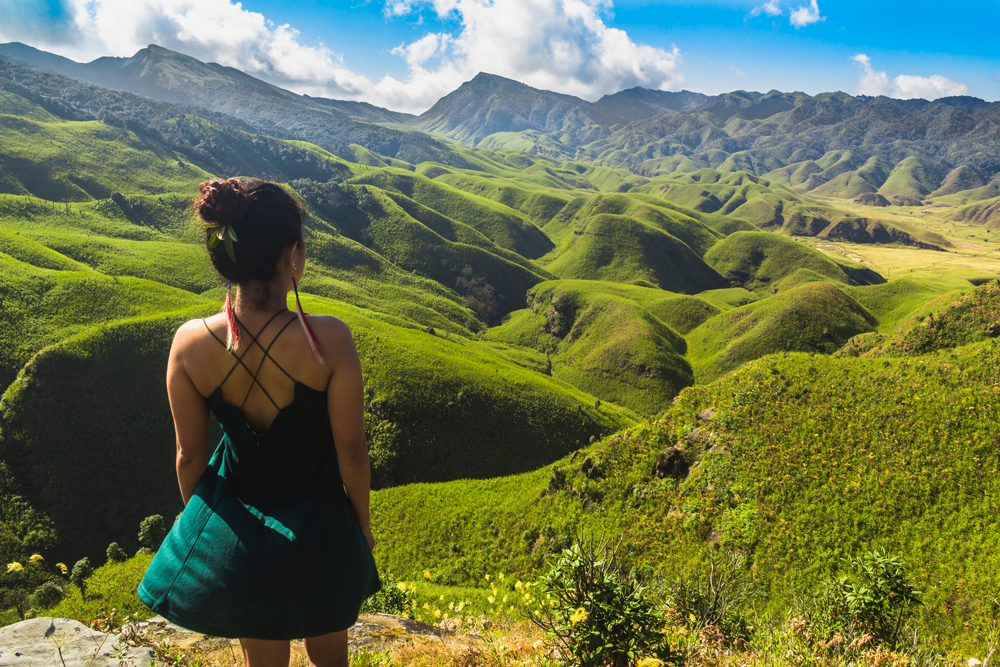
The Dzükou valley, spanning the Nagaland - Manipur interstate boundary in northeast India, is a hidden paradise here on planet Earth. You can think of it as the Shangri-La of the northeast.
The valley is a breathtakingly beautiful, picture-postcard masterpiece of nature’s handiwork that more rightfully belongs in a fairytale book or fantasy novel than in this earthly realm.
Stretching as far as the eye can see in all directions, the Dzükou valley boasts an astonishing, undulating treeless sweep of knolls, hillocks, verdant glens, river-cut ravines, meandering rivulets and deep-reaching caves, all just begging to be explored.
The valley's picturesqueness largely derives from its interesting topography, which has been sculpted over millennia by the geological processes of weathering and erosion, and fully unveiled thanks to the almost complete absence of tree cover.
The convoluted folds, ripples and contours of the valley are a marvel to witness and few travellers will have ever observed anything like it before.
In addition to the jaw-dropping scenery, the other major drawcard the valley holds is its stunning exhibition of wildflowers of varying hues, a display that reaches its peak in the first two weeks of July.
Hence the Dzükou valley has also been dubbed “the valley of flowers”.
We recently visited the Dzükou valley during the month of December, in the midst of the winter season. Our brief but beautiful experience there left us feeling deeply moved and inspired.
If you happen to already be travelling in Nagaland, we would strongly counsel you not to miss out on the Dzükou valley, even if its remoteness and inaccessibility does present some logistical challenges in getting there. It is one of the most sublime destinations in the northeast Indian state of Nagaland and indeed, in the entire Indian subcontinent.

The Dzükou valley lies between 25°31’0” N and 25°35’0”N latitude and 94°3'0"E to 94°5'0"E longitude, straddling the Nagaland-Manipur border in the southernmost reaches of Nagaland’s Kohima district, though the majority the valley lies on the Manipur side of the border.
The valley covers an area of about 27 sq. km and sits at an average elevation of about 2,452 m above sea level, which contributes to its isolation and helps to keep it secluded from the world of mere mortals down in the lower-lying hill areas below.
The highest peak in the Dzükou valley area is Mt. Iso (Mt. Tenipu) at 2994 m, which is also the highest peak in Manipur.
As the crow flies the valley lies about 14 km SSW of the central ground in Kohima, but the actual distance that must be travelled by road and then subsequently on foot to reach the valley is much greater than that.
Important background info
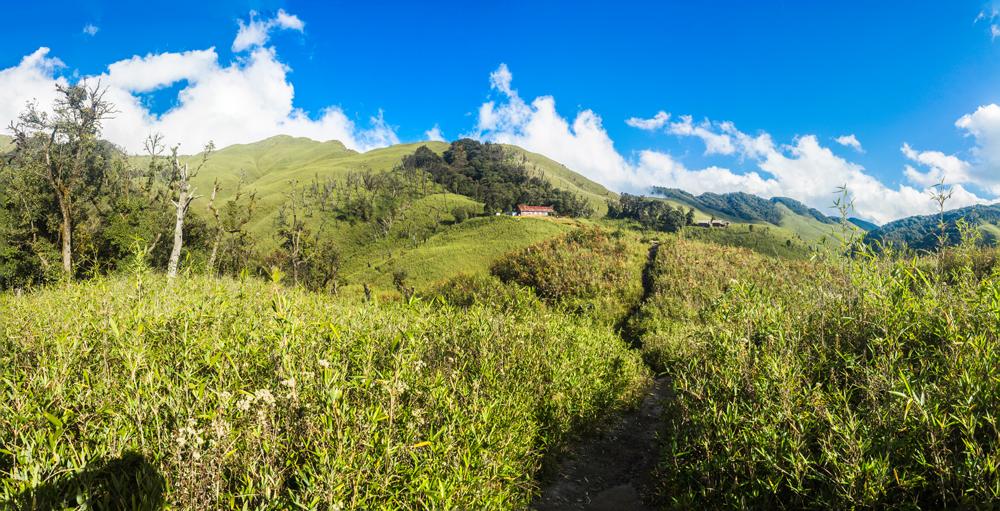
JOIN OUR LIST
Get free exclusive travel tips delivered straight to your inbox.

Reminiscence of the past year:
While trekking through the Dzukou Valley, I did miss my Triund peak trek almost one year ago, especially because I did it with Parina, and some close friends. I feel treks are more enjoyable in a group rather than alone. And in a group, it’s safer as well. But doing it alone definitely was more adventurous, and satisfying.
Dzukou Valley at the heart of Nagaland
Geography and location:.
Sitting in the foothills of eastern Himalayas in the state of Nagaland, Dzukou valley is the crown jewel of north east India. Standing at ~8000 ft (2438 mts), Dzukou valley is s ituated beside the Japfu peak on the border between Nagaland and Manipur. However, being close to Kohima, the state capital of Nagaland, more tourists trek the valley from Nagaland side rather than Manipur side.
Dzukou Valley is an absolute delight, a treat to the eyes and soul. Its rolling hills, emerald green gentle slopes, and evergreen forests made me remember Coorg and Ooty in south India . For a good part of the year, the valley fills with the famous Dzukou lilies and a large number of other varieties of orchids. This prompts people to call it the Valley of flowers of north east India.

Growing popularity in recent times:
Hornbill festival:.
A festival of festivals that brings together all the various ethnic groups of Nagaland on one platform, Hornbill festival showcases the cultural richness of Nagaland. Started in the year 2000 by the government of Nagaland, it’s held between 1-10 December every year at Kisama village, 16 kms away from Kohima.
The festival celebrates everything that is great about Naga culture- its traditional food, dance, sports, crafts, etc. If one wants to know Nagaland up-close, no need to see any further. It has established itself as one of India’s go-to festivals. I hope to make it to the festival this time in December.
My Dzukou Valley Trek Schedule
After spending 3 days in Manipur enjoying the festival of colours- Holi there, and experiencing their unique culture, I headed for Nagaland. I had planned for 4 days in Nagaland. Though Dzukou Valley was in my scheme of things, I wasn’t sure if I could pull this trek off alone. So, the schedule, to start with, was flexible. But after talking to a few locals around on the first day itself, I convinced myself that I should at least give it a try. So, the schedule became like this:
- Arrival; Day-1: Reach Dimapur from Imphal; explore Dimapur a bit, and move to Kohima; explore local Kohima in the evening
- Day-2: Visit a few places in Kohima, and trek to the Dzukou Valley
- Day-3: Trek back from Dzukou Valley to Kohima; explore local markets in the evening
- Departure; Day-4: From Kohima to Dimapur; Dimapur to Guwahati, and onward to Delhi
Day-1: Imphal- Dimapur- Kohima
The flight from Imphal got delayed a bit, and I landed at Dimapur airport at around 1 PM. Nobody asked me to check my Inner Line Permit (ILP) to enter Nagaland (though I had it). I had earmarked a few spots in Dimapur to pay a quick visit. But after talking to a few locals at the airport, I decided to visit only the (Dimasa) Kachari Rajbari ruins.
Kachari Rajbari Ruins
Around 10th century AD, there was a Kachari civilization around Dimapur of which little history exists. However, the mushroom shaped domed pillars (8-10 ft each) and the gateway still stand testimony to a glorious past. An English lieutenant- Grange discovered it in 1840, and brought it to public knowledge.
I looked at them in bewilderment, and imagined that whoever built these things in that era, must be of superior creativity and imagination. However, the purpose of the structures are still mysterious. It’s a small green campus; takes only about 15-20 minutes to walk around.

Driving up the hills to Kohima:
The auto rickshaw driver became an instant friend; I don’t know what clicked with him. He helped me find the right shared taxi near Dimapur railway station. In the taxi, I met Somnath, a Marketing Manager (from West Bengal) of a mobile accessories company who was travelling for work.
The shared taxi dropped us at Kohima ISBT, only 2-3 kms away from the city around 5 PM (drive time: 2 hrs). It was weird! They have this rule that taxis of one region in Nagaland are not allowed to ply in another region! (If you have any idea about why is it so, please let me know in the comments section). So, we had to take another shared taxi from the ISBT to the main city.
First view of Kohima:
Aesong, a fellow traveller from Kohima suggested us a nice hotel (East Gate hotel) near the Kohima war memorial. Somnath suggested that we should share a room to save some money, and I saw no reason not to agree. It’s always good to meet new people while travelling. It gives new perspectives of places, people and their culture.
While reaching the city, I couldn’t catch a good view of the city, but from the balcony, night view of Kohima was quite amazing, similar to that of Shimla and Gangtok.

Day-2: Kohima- Dzukou Valley
I decided to visit the Kohima War Cemetery and the Kohima Cathedral Church before proceeding towards Dzukou Valley trek. The hotel I was staying was at a walkable distance from the War Cemetery, which wouldn’t take more than 30 minutes to explore. And the Cathedral was near the Network Travels AOC bus stand from where I was supposed to board a shared taxi to Viswema, the starting point of the trek. So, it was also doable.
Kohima War Cemetery
In March 1944, at the height of World War-II, if the Allied/ Commonwealth armed forces hadn’t fought valiantly in Kohima and Imphal, parts of India would have fallen to Japan. However, the small contingent held their ground suffering heavy casualties, and succeeded in forcing the Japanese forces to retreat. Britain regards this battle so highly that British National Army Museum has voted the battle of Imphal and Kohima as the greatest in their history.
The Commonwealth War Graves Commission established and manages this cemetery meant to pay homage to the brave 2337 brave soldiers who laid down their lives for freedom.

Back to hotel and off to the trek:
The lady at the reception helped me with a taxi with a friendly driver. He took me to the cathedral first, and then dropped me at the Network Travels AOC bus stop.
Kohima Cathedral Church
Christianity is the predominant religion in Nagaland; as much as 88% of population are Christians. Of this 88%, 75% are Baptists, and 13% are Catholics and other denominations. This makes Nagaland the most Baptist state in the whole world!
The evening I reached Kohima, standing in the balcony of my hotel room, I could see all the cross signs in neon red light over the churches dazzling in the night skyline across the hill slopes of Kohima. However, the most recognizable landmark church in all of Kohima is a catholic church- Mary Help of Christians Cathedral, or more popular as Kohima Cathedral Church. Built in typical Naga architecture, it was consecrated in 1991.

When I reached the cathedral, it was closed for renovation. So, I walked around the church, and took some pictures of the impressive building. Besides, it offers a splendid view of Kohima city from its backside.

Viswema village: Onward to Dzukou Valley
The shared taxi from Kohima to Viswema took 30 minutes to fill enough passengers (7 of them) to start. So, at last, I was on my way to the Dzukou valley at around 9:30 AM. It took about 45 minutes to cover the distance of 24 kms to Viswema. Though the road was mostly good, some patches were bad and dusty.
Viswema is larger than a village, but not big enough for a town. I had my breakfast (puri- sabzi) in a small eatery, and packed some chocolates, eggs, peanuts, biscuits and water for the trek.
Approach to the Dzukou Valley Trek
There are basically two approaches to the Dzukou valley trek; one via Zakhama village, the other via Viswema village. Both the routes end at the same guesthouse for overnight stay. Beyond that point, there is the open valley that one may choose to hike and explore the next day.
Let me explain each of these approaches for convenience of a first timer.
Approach-1: Zakhama village
- Reach Zakhama, ~14 kms away from Kohima by shared taxi: 30 minutes
- Motorable road of 2-3 kms to the trek starting point (may hike or take a taxi; optional): 1 hr
- Difficult section of 5-6 kms with steep slopes (30 to 60 degrees): 4-5 hrs
- 1.5 kms of plateau; easy hiking/ walking: 30 minutes
- Total trekking time (excluding motorable road): ~6 hrs to reach the end point of the trek where there is a small guesthouse to spend the night.
Approach-2: Viswema village
Some of the trekkers begin trekking from Viswema village itself. But majority of trekkers actually go a little far by a taxi or truck to a point where there is no motorable road, and start trekking from there.
- Reach Viswema, ~23 kms away from Kohima by shared taxi: 45 minutes
- Motorable road of 8-9 kms to the trek starting point (may hike or take a taxi; optional): 4 hrs walk
- Difficult section of 1.5 kms with steep slopes (30 to 60 degrees): 1.5 hrs
- The beautiful view of the Dzukou valley starts at the end of this difficult section
- Then cross 4-5 kms of plateau of easy hiking/ walking: 2 hrs
- Total trekking time (excluding motorable road): 3.5 hrs to reach the guesthouse.
My recommendation:
Viswema route is definitely better of the two approaches, unless one is especially fond of trekking in difficult terrain. It takes less time than the Zakhama route. But more importantly, the last plateau section of 4-5 kms actually runs among the hills through the Dzukou Valley, and is a hike with gorgeous sight.
The only problem is that the motorable road till the starting point of the trek is too long to walk; so, one has to take a taxi. The taxi costs Rs.1500/ one way, which is a bit too much if you are alone. To solve this problem, either you go in a group, or wait at Viswema village for a group who you can join. If you don’t find a taxi, just wait for a while, or ask the nearby shopkeepers.
There is an approach from Manipur side, from the Senapati district (Isii mount). However, I have not been from that side; so, not much idea.
The ascent: Winning over the fear of unknown

As I was alone, I had to hire a small truck myself (for Rs.1500) to reach the starting point of the trek. On the way, there was an entry point to the Dzukou valley where I had to pay a nominal fee.
The entire route was extremely bumpy; actually the worst road one can imagine. I was sitting on the front cabin of the truck; but my head banged against the roof several times, and my back was hurting like hell!
The trek begins:
It was around 11.45 AM, my ordeal was over, and I started my trek up the hill inside the forest . I knew that the difficult section was only 1.5 kms, but I wasn’t sure of how much time the whole trek would take to reach the guesthouse.
However, the bigger question (say fear) was that whether I would be able to find my way through the forest to the end point alone. If I wouldn’t be able to complete the trek during daylight, it would mean spending the night in the jungle! A truly horrifying prospect.
The steep slope:
In the beginning of the trek, the slope was gentle; but just for the first 10-15 minutes. Thereafter, the slope increased suddenly and drastically. At some points, the slope was more than 50 degrees. For a little more than 1 km, I kept hiking the steep slope with some difficulty. The two water bottles I carried, were helpful.
First view of Dzukou valley:
It took me an hour and fifteen minutes to cross the difficult section, where there was a small rest shed (reached there by 1 PM). That vantage point offers a panoramic view of the whole mountain range that I had been trekking. I took a longish rest there and started walking again lest I might not reach the guesthouse before evening. (Note: After this point, take the road to the right, not the left one).
And just when I turned around to the other side, voila! There in front of me was the open expanse of the gorgeous Dzukou Valley! Wow! What a sight that was! Extraordinarily beautiful rolling hills running into each other to form a V-shaped valley. Verdant grass land on the surface of the mountains. The dominating flora included (among other trees) Rhododendrons and Bamboo shrubs. My favorite Rhododendron flowers had just started blooming, but I was just about 15 days too early.

Losing way briefly:
While I was trekking in the difficult section, I kept coming across trekkers who were on their way back. But beyond the rest shed, I suddenly stopped seeing anyone for the next 4-5 kms till the guesthouse! I was all alone, and very apprehensive that I might miss a turn, and go in a completely wrong route to get lost in the open valley.
This was going on in my mind when I actually came to a dead end near a dry water stream at the intersection of two hills (picture below). I felt a chill run down my spine. Did I just lose my way? Yes, but fortunately, by just a hundred meters. So, I walked back and guessed the right route again, and kept hiking. I was just hoping to see someone from the other side; but there was none to be seen!

All alone, but the nature as company
I was all alone, but had the nature as company. I kept the faith, and kept walking among the bamboo shrubs. After about another two kilometers, I had the first view of the guesthouse over a far away hill. This soothed my nerves a bit, but I was still not 100% confident. Because I wasn’t sure whether the road actually connected to that hill.
Winning over my inner fears:
The valley was so beautiful it felt very friendly. Attending to my inner fears, I continued talking to the bamboo shrubs and the rolling hills. I felt like taking a picture at every turn. At one point, the view of large number of dead (burnt) black trees over a hill was so fascinating!
As I kept walking, the guesthouse got hidden from my sight at times, and again came back into the view. Maybe when I was some 500 meters away, I felt confident that I was on the right path. It was such a relief! At last, I reached the guesthouse by 3:15 PM.
But why was I all alone?

Watching the sunset over Dzukou Valley
After checking in at the guesthouse, I immediately ordered some maggie (the only thing that they have) to satisfy my hunger. I had it with the eggs that I carried from Viswema. Once I regained my strength, I decided to trek again across to another hilltop where there was a helipad for some reason. That proved to be a great decision. From the guesthouse side, it was difficult to get any good pictures of the valley below the setting sun. However, from the helipad side, the hills behind the guesthouse looked stunningly beautiful.
Surreal view!
Lush green, rounded as if a fine landscape architect had curated the valley like a garden. Sunset is the golden hour for photography; and it didn’t disappoint at all. The sun setting behind the valley in the west, and the hills on the opposite side in the east, both looked pristine.
I sat there speechless marveling the glory of nature. Didn’t really had the urge to move from there. But I had to reach the guesthouse before it was dark. Needless to say that there was no electricity up there.

Spending the night in Dzukou Valley
The guest house:.
It was a very basic guesthouse; to be honest, not a guesthouse actually. It was basically four walls and a roof with a floor beneath. That’s it! A dormitory without a bed! They offered a thin sheet to sleep on (for Rs.50), and a blanket (for Rs.250). There were a few private rooms as well, available on first-come-first-serve basis. They had small tents on offer too. Though there were a few toilets, they were not clean. They had kept some unclean drums near a stream in which they filled stream water for drinking purpose.

A sleepless cold night:
Expectedly, it was pitch dark up there. Chatting with fellow trekkers helped pass time though. Dinner (rice-dal-potato fry) was ready by 7:30 PM, and it was not bad. After dinner, it was time for more chatting. One Bengali trekker couple showed us videos from their trekking in Meghalaya. And two siblings from Italy- Flora and Vasco shared their experience of traveling across the globe.
When it was time to sleep, the noise made by a group of young guys at the bonfire outside made things difficult. However, the main problem was the cold. I realized late in the night that one blanket was not enough. But it was too late by then. I couldn’t sleep properly due to the cold (temperature must be in single digit). Vasco later told me that there were rats moving over his body!
Made some new friends:
I met Flora and Vasco just when I reached the guesthouse late in the afternoon, and instantly made a connect. There are certain people who you like the moment you speak to them. Vasco is an art restorer, and Flora, a film maker. They are travellers based out of Corsica in France, a beautiful place itself. But they are originally from Tuscany region in Italy, my favorite part of Italy. (I still cannot forget my experience of Florence ) . They have been long time travellers; I was quite amazed that Flora has already travelled all the continents!
I found Vasco and Flora to be very modern, liberal and humble people. Travel makes people more inclusive and liberal. During the time that we spent that evening, and the next day, I certainly felt friends with them.

Day-3: Dzukou Valley to Kohima
The descent:.
Morning view of the Dzukou valley from the guesthouse was far better. Took some more pictures, walked around the hill, and was mentally ready to say buy to Dzukou Valley. Some people went down the hill deep into the valley to explore a bit more, especially till a point where a white cross is seen from the top.
Descents are generally not that exciting as ascents. But having a young group of trekkers from IIT Guwahati, Flora and Vasco for company made the descent enjoyable. We all started together around 8:30 AM. Football dominated the discussions on the way back, especially because the young ones were footballers. We took a longish pit stop at the rest shed just at the beginning of the steep section. However, of course, while descending it was not so difficult; just being careful was enough.
Reaching Kohima:
I, Vasco and Flora joined the young group in their taxi to Kohima. We had lunch at a modest restaurant in Kohima, and went to the lodge (Morung) where they were putting up. I found it really nice, and booked a room for the night while they proceeded to Dimapur and to Arunachal from there.

Morung Lodge, a lovely homestay
I am glad that I got to live in the most popular lodge in Kohima. While visiting Kohima I had not done any research on accommodation options. But later when I watched some videos on YouTube, I found Morung Lodge everywhere! Turns out that it’s on the Lonely Planet as well.
Aesthetics:
The rooms were comfortable, and everything in the house was curated aesthetically with passion. The view of Kohima city ( with colourful houses stacked up on hill slopes ) from the lodge was amazing. In fact, it was interesting to note that the city is spread out in such a way that one can have the view of the city from anywhere.
For some reason, the caretaker of the lodge was not available for the evening, but Khriebu ensured that I had a good dinner at her restaurant- Morung Kitchen, again very neatly curated. As there was no other guest there for the night, I had the whole lodge to myself. I felt like I had a home in Kohima!
Morung, the social institution:
‘ Morung ‘ in Nagaland represents a key social institution, a center of cultural gathering, especially for men. Once upon a time, it used to be a center Naga elders taught their youth about their dialect, crafts, life skills, folk music and songs, etc. However, this institution has fallen into oblivion over time. To know more, click here .
The name perhaps has been chosen figuratively than anything else, because the lodge is open to women as much as men. In fact, it was started by a woman entrepreneur, and now run by another.

Khriebu, the dynamic entrepreneur:
I met Khriebu, the young dynamic entrepreneur managing the property. She is a sweet lady and a thorough professional. Her father was a Nagaland Civil Servant-promoted-IAS, mother a government servant, sister a reputed designer in Delhi. She used to live in Delhi for a long time. But went back to her roots some time back, and now running this lodge, and a restaurant quite successfully. Follow her on her Instagram page: @khriebu
For booking, write to them at: [email protected].

Kohima local market
After taking some rest in the afternoon, I went out to have a walk around the local market. It was fascinating to see street vendors selling unusual (for me) vegetable varieties like bitter bean, chayote (a type of squash) and snails, frogs and insects. I also found a large number of sellers from Bihar, not only street vendors, but also having other retail stores.
Unlike rest of India, but like in other states of north east India, it was a pleasant sight to see women dominate the market places. Both as sellers and buyers. Why is it so? Is it more because of socio-cultural reasons or because they are more educated? Any idea? Do share, if you know.

Day-4: Kohima- Dimapur- Guwahati- Delhi
When I told Khriebu that I was travelling to Dimapur airport next morning, she said that she was also travelling there, and offered me a seat in her car. Next morning, she along with her nephew and mother arrived around 9 AM and we were off to Dimapur. She and her mom were travelling to Guwahati for some family get-together, and her cousin was coming to drop them off. It was nice to meet her family; very sweet people.
On the way, at Pherima, they stopped for lunch and I had some tea. We reached Dimapur airport by 11.15 AM. We were travelling to Guwahati by the same flight. The shortest flight I had ever had- just 25 minutes! Within 15 minutes of the flight taking off from Dimapur, the pilot announced of landing!
Time to say bye!
I said bye to Khriebu and her mom at Guwahati airport to see them soon, maybe this year again with Parina, for the Hornbill festival in December. That was a formal bye to Nagaland, actually. Quite an amazing trip, an adventurous, exciting, and unforgettable one.

The flight from Guwahati to Delhi was not at all pleasant. Owing to traffic congestion at Delhi airport, the flight couldn’t land, and had to fly to Jaipur for refueling at midnight. By the time it landed again in Delhi, it was past 1 AM, after six hours of taking off from Guwahati!
Dzukou Valley Trek: Important Tips
Best time to visit:.
- For a pleasant enjoyable weather: March- May
- For flowers and greenest of green valley: Rhododendrons in April-May; Dzukou lilies in June- September
- However, monsoon months of June- Sep would be difficult to trek
- Winter months of November to February are not too bad too
How to reach Kohima:
Basically, one should reach Kohima a day before starting the Dzukou Valley trek.
- By flight: Nearest airport to Kohima is Dimapur, 70 kms away; from there take a shared taxi to Kohima
- By train: Again, the nearest railway station is Dimapur; take a shared taxi from there to reach Kohima
Where to stay:
There are limited options in budget category. Some options I know:
Morung lodge | East Gate hotel | Alder retreat | Circuit House | Akim homestays | Hotel Ariel | Native Stories (Zakhama)
How to approach the Dzukou valley trek:
Please see a special section on the approaches to Dzukou Valley trek above.
What/ where to eat (in Kohima):
- On the trek, there is only one option: the guesthouse up there. They have maggie for snacks, and basic rice- dal- potato for dinner. Carry some eggs, dry fruit, bread, etc, if you can.
- In Kohima: Amaris | D Cafe | Yaotsu’s pure veg | Jat restaurant | Cafe Aurora | Mhachaki | Morung Kitchen
- Though non-vegetarian food is more popular, one can find vegetarian restaurants easily
- Nagaland is a dry state (no alcohols)

Things to do in Kohima:
- Pay homage to the brave soldiers at Kohima War Cemetery
- Experience Naga culture at Kisama heritage village (enjoy Hornbill festival in December)
- Visit Kohima Cathedra Church for a spiritual experience
- Observe the local food preferences of Naga people at Kohima local market
- Day trip to Khonoma village, or/and Dzuleke village (on the same route)
Some helpful tips for Dzukou Valley Trek:
- One needs Inner Line Permit to enter Nagaland; click here to check out their website
- Difficulty level: partly moderate, partly easy
- Start the trek as early as possible in the day
- It’s better to trek from Viswema village side
- Take a shared taxi from Viswema to the starting point of the trek
- Mobile network will be fine till Viswema; after that there is no network in the valley
- Keep enough water, dry snacks and first aid with you
- Wear comfortable shoes; high quality trekking shoes are not needed
- Having a torch for the night is important
- A cap, and sunscreen lotions are helpful, if you are sensitive to sunburn
- On reaching the guesthouse at the end of the trek, take two blankets for the night
Areas of improvement
Plastic pollution:.
Dzukou valley is a no-plastic zone since 2019. However, it’s sad that it’s far from the truth. There is no effort from anyone to keep the beautiful valley plastic free. Everywhere, literally everywhere there is plastic litters- from the forested trek to the green valley, even at the guesthouse.

The whole place (guesthouse area) was littered with plastic bottles, polythene bags and wrappers. One can expect them to impose some restrictions, or put up some posters for awareness of tourists about environment, at least.
A better guesthouse:
Nice guys that they are, the caretakers of the guesthouse are not trained enough. They don’t maintain anything! Neither basic hygiene, nor drinking water. It becomes cold at night; they can put up some beds and charge a bit more; nobody will complain, surely. While we were trying to sleep, these guys came in the dormitory, and started playing loud music on their phones! That was so insensitive!
It’s run by a local youth club. Though it’s understandable that maintaining logistics for the tourists at a high altitude is a difficult task, they could do a lot better, if they wanted. One doesn’t expect great food up there; food was okay, in any case. However, t he altitude and distance are not that difficult to have at least water bottles or some light snacks there.
Concluding Remarks

Wanting for more!
The four days spent in Nagaland has made me wanting for more. I explored a modern north Indian state capital, went on a solo trek to the Dzukou Valley, and came across some wonderful people. However, four days were never going to be enough for experiencing the Naga culture. I would love to come back this year itself in December during the Hornbill festival, and then will explore iconic Naga villages like Khonoma, Dzuleke and Mon. North Nagaland is also quite beautiful; would love to explore places like Wokha, Doyang river, Mokokchung, etc.
With growing popularity of the Hornbill festival, tourism is getting streamlined gradually. However, even now, there are lack of good budget accommodation options beyond Dimapur. At the same time, there is a need for maintaining a balance between tourism and commercialization. Too much tourism may not be good for the region’s environment.
Need for collaboration between government and civil society
With a bit of care and effort, Dzukou Valley trek can be so much more enjoyable. Even more important is the sustainable tourism. The plastic pollution can easily be controlled by a simple regulation, implemented strictly at the entry gate to the Dzukou Valley. Sustainable tourism can never be the last priority.
I think a collaboration between the government (Forest department and Tourism department) and local NGOs can go a long way in keeping the valley green and clean. The NGOs can help local youth come up with better facilities and better management of the guesthouse for a fee. Even better if one can come up with a community-led tourism model.
Have you been to the Dzukou Valley or Nagaland? Please share your experience with us.
24 Responses
Jayvanti Einjen
V.nice information for visit Dzukou valley and pics are very nice
stampedmoments
Thank you so much, as always 🙂
Amazing. Never seen such a detailed breakdown of the trip. This helps a lot. Thank you!
Thanks a lot Nirbhay, for reading and sharing your lovely feedback. Keep connected.
Soumen Chatterjee
It’s just a an amazing blog I must say. Though I have visited Nagaland quite a lot of time but only on official tour , but through your blog I understand there are lot of things that can be explored. 1st is the Dzukou Valley which I understand is an absolute delight, a treat to the eyes and soul. Its rolling hills, emerald green gentle slopes, and evergreen forest. For a good part of the year, the valley fills with the famous Dzukou lilies and a large number of other varieties of orchids. This prompts people to call it the Valley of flowers of north east India. Trecking must have been a great experience. Kohima war cremetory also just wonderful to know about. Kachari Rajbari Ruins , Kohima war cemetery and the kohima cathedral Church have a lot of information which I gained while reading it. Dzukou Valley! looked extraordinarily beautiful rolling hills running into each other to form a V-shaped valley. Verdant grass land on the surface of the mountains. The dominating flora included (among other trees) Rhododendrons and Bamboo shrubs. It’s just Waooo!!!. The sunrise and sunset must have been thrilling. Most importantly u made friends at the guest house which is really awesome to make friends during the trip. Next was Morung, the social institution: ‘Morung‘ in Nagaland represents a key social institution, a center of cultural gathering, especially for men. Once upon a time, it used to be a center Naga elders taught their youth about their dialect, crafts, life skills, folk music and songs, etc. I hope u loved the Naga food and it’s delicious I must say I had a lot of it and I loved their non veg dishes. Overall I loved the experience and reading the blog was just thrilling.
Yes, Soumen, it was indeed a unique and wonderful experience. Doing it alone made it even more exciting! Thanks for reading in detail; keep it up!
It was interesting to read. I couldn’t stop reading until the very end. The Dzukou valley, Kachari ruins, the war cemetery, all are amazing, The travel itself appears to be terrifying. But truly, trips like these will provide something extra that you will remember forever. Of course, the trips will provide new connections, good people, lovely and comfortable stays, and so on. I enjoy reading.
Hi Sajith! Indeed, it was a bit difficult trekking alone, but more exciting for the same reason! Nagaland, and entire north east is largely unexplored; so, one feels like really discovering places. Thanks for the feedback 🙂
Kelly | Poky Little Wanderer
Those hills are just so beautiful! What a lovely adventure to have, and it sounds like you found a lot of wonderful new friends to share it with despite going by yourself!
Yes, Kelly, gorgeous landscape, and lovely new friends! Great trip, indeed. Thanks a lot for your feedback. Let’s keep connected.
I’ve never heard of Dzukou Valley or Nagaland so your post was very informative. Sounds like an amazing experience and lots of great ideas for sustainable tourism.
Hey! Good to hear from you. Glad that you liked it. Thanks a lot.
Falguni Trivedi
So detailed and covered almost all the small things too… Too good… Thanks for sharing
That has been the effort. Glad that it seems useful to you. Thanks a lot for reading, and sharing your feedback.
Shrusti Mohanty
Definitely saving this one, Nagaland has been on my list for a while now. Thank you for such detailed information!
Hey Shrusti! Good to hear from you again. Glad that you liked. Thanks for connecting.
The picture with rolling hills lead me to read. The blog gives the thrills and chills of the adventure behind the beautiful picture.
Thanks a lot, Pinkoo for your lovely feedback. Yeah it’s a unique landscape and an amazing experience to have. Please keep connected for more.
Shishir Mondal
Thanks for sharing necessary information, I am planning to trek Dzukou valley by April ’24.
Hi Shishir! Glad that you found it useful. Have a great trip!
Sauvhik Paul
Thanks for the info, would u mind if u tell us the entire cost of the trip from Dimapur, like the hotel and stuff
Sure. Please write to us: [email protected]
Sarita Hevia Iphone
Incredible experience!!! Stunning views, amazing trekkings, fantastic culture Congratulations for your trip and thanks for share it
Yes, that’s true. It was such a wonderful experience! Cherished memories forever. Thanks for the feedback.
Leave a Reply Cancel reply
Your email address will not be published. Required fields are marked *
Save my name, email, and website in this browser for the next time I comment.
This site uses Akismet to reduce spam. Learn how your comment data is processed .
UNCONVENTIONAL AND VIVID
LEARNING FROM THE WORLD
Dzukou Valley – A Complete Trekking Guide and its Ecosystem
by upsy · Published August 3, 2019 · Updated August 3, 2019
The undulating rolling hills of Dzukou Valley, sprinkled with colorful blooms, stretched with carpet of wild dwarf bamboo exemplify the best craftsmanship of nature. As the dawn swayed by, the silent murmurs of gentle breeze wrapped me in its invisible armor, the sky slowly turned into cobalt blue pushing away the clouds and the sun illuminated the valley in spectacular hues of green and golden.
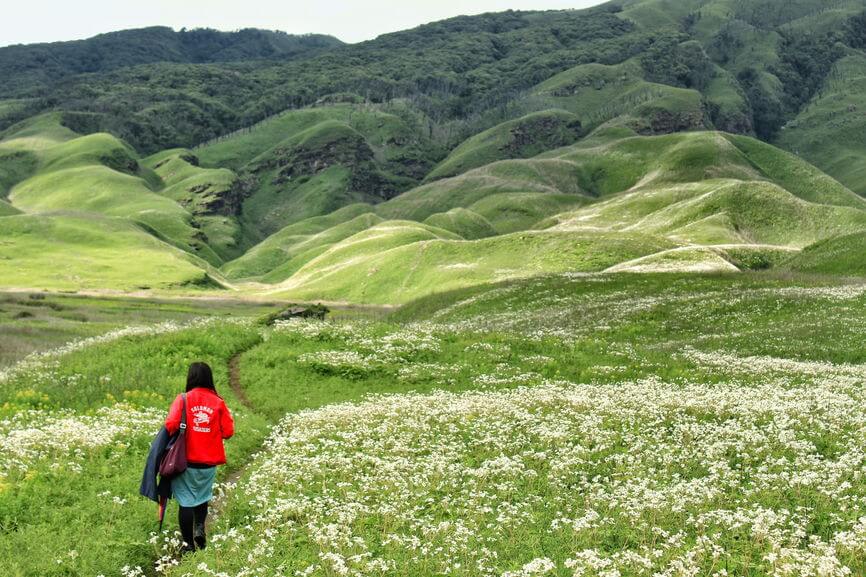
The burnt trees peppered through the valley, reminiscence of two huge forest fires, adds an esoteric element to the expansive vistas. In the misty and sloppy arms of monsoons, the rare Dzukou Lily ( Lilium Chitrangadae) makes it unparalleled appearance.
PIN THE POST FOR LATER
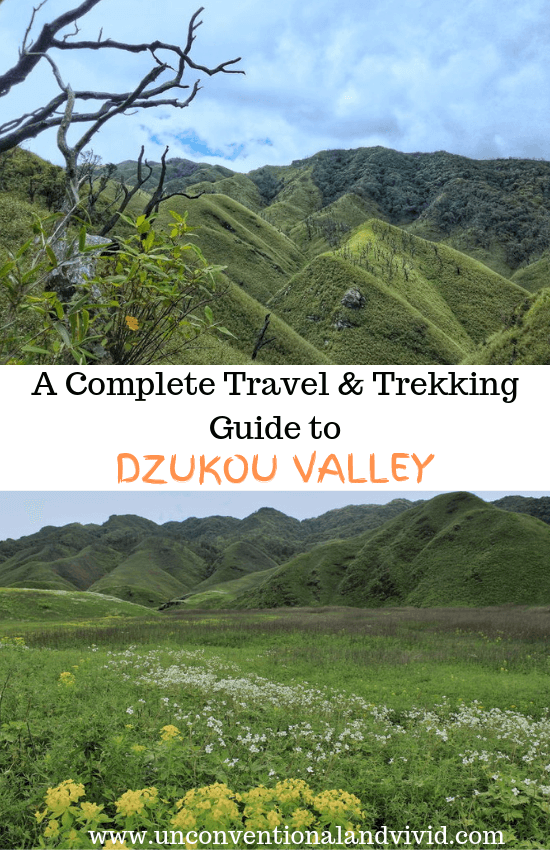
Table of Contents
Dzukou Valley – Where is it located?
At an altitude of 2,452 meters above sea level, the mesmerizing masterpiece of nature spans across the states of Nagaland and Manipur. The picturesque valley peeps above the clouds and open into velvety green treeless knolls, spread as far as eyes can take you. The summers paint a different picture with the valley blooming with colorful flowers but winters turn the valley into a frosty canvas without flowers. The timeless erosion and weathering of the rocks led to the formation of perfectly molded sweeps of hillocks and gave it its distinctive contours.
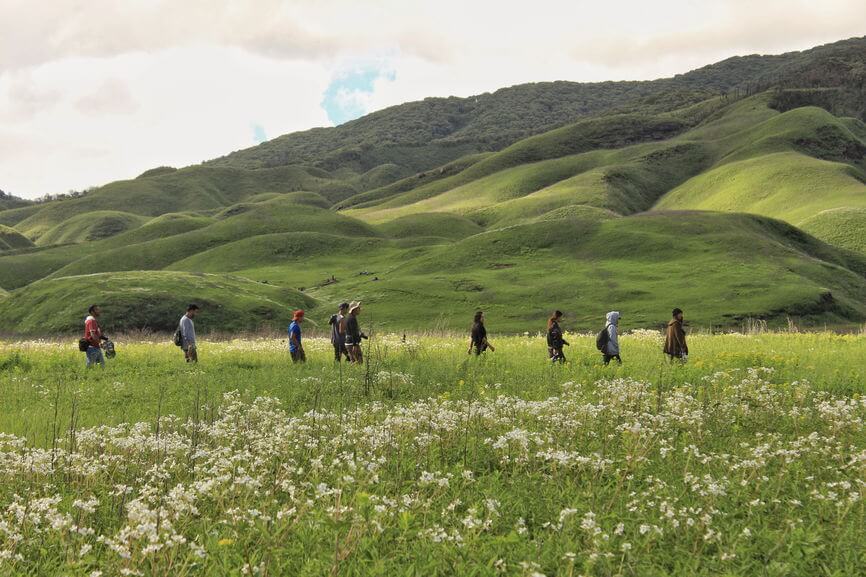
According to Angami dialect, the meaning of “Dzu – ko” means “soulless” and “dull” and this translates into this because of the rough weather conditions unfavorable for harvesting crops. According to legends, ancestors of Angami Tribe tried to establish a new village and settlement in the Dzukou Valley but failed due to the unfavorable weather condition that did not support farming and agriculture. It was considered to be not fit for habitation as it was too cold, nothing edible could grow and lacked trees. There are many myths and legends associated with the valley like existence of a white elephant, healing properties of the river and a place where the dead rest before departing.
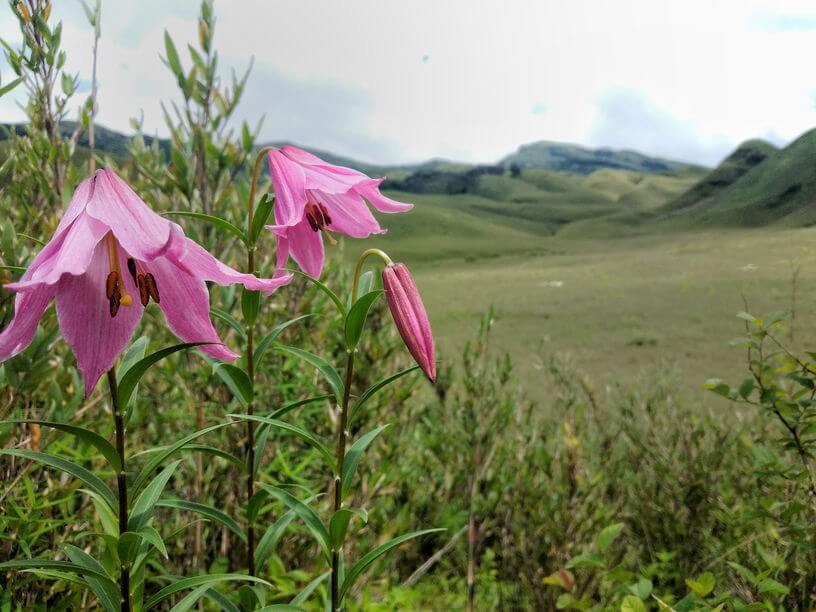
Ecosystem of Dzukou Valley
The ecosystem of the Dzukou Valley favors the growth of the rare Dzukou Lily ( Lilium Chitrangadae) from April to August. The endemic flower is a distant cousin of the lighter pinkish shade Shirui Lily ( Lilium Mackliniae ), a rare species of the Shirui Hills of Manipur. The Dzukou Lily was first identified in 1991 by Late Dr. Hijam Bikramjit, Life Sciences Department, Manipur University on his trek to Dzukou Valley with Manipur Cultural Integration Conference Team. Apart from the endemic variety of lily, many other flowers like Euphorbia sikkimensis , Ranunculus species, Aconitum species etc. adorn the valley in vivid bloom.
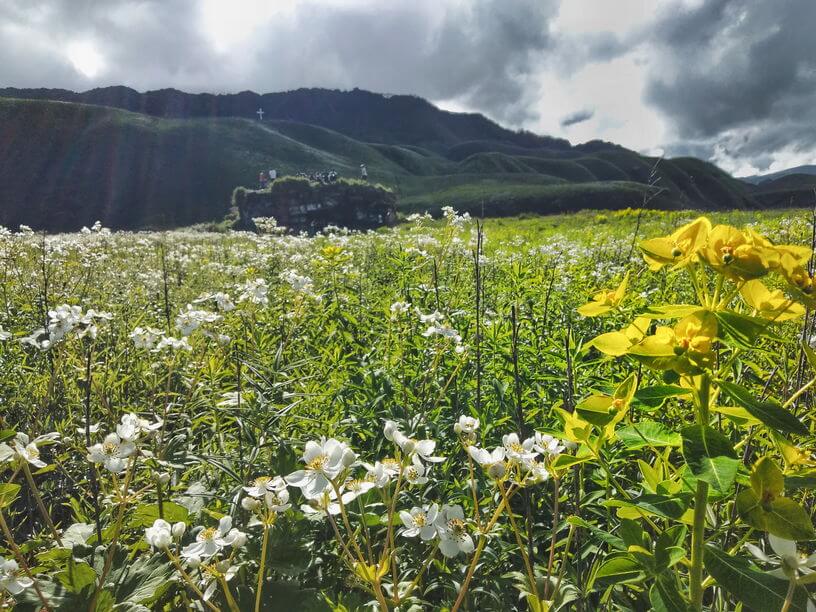
The seasonal flowers bloom during the monsoons and dot the valley in different colors spread across the carpet of dwarf bamboo. The bamboo plants dominate the valley and are known to have suppressed the growth of many other plant species. The endangered Blyth’s Tragopan, also the state bird of Nagaland, is known to silently habitat the woods beyond the valley. The ecosystem of the valley has drastically changed over the years caused by two wildfires in 2012 and 2015.
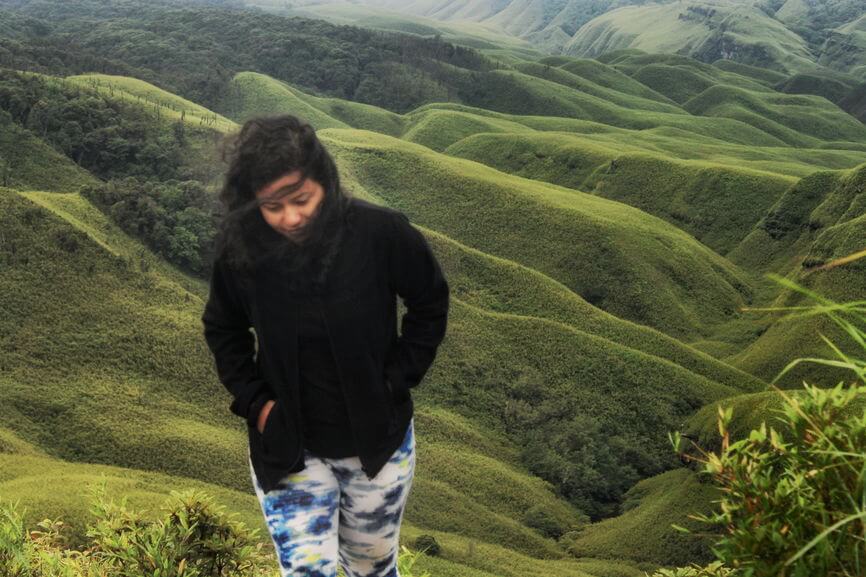
Management of the Valley by SAYO
SAYO stands for Southern Angami Youth Organization, currently managing Dzukou Valley and the guesthouse around the base. Right from providing meals to helping groups find a space for cooking to renting camping essentials, they care of everything. SAYO also banned camping in the valley which is a great move to preserve the essence of the valley.
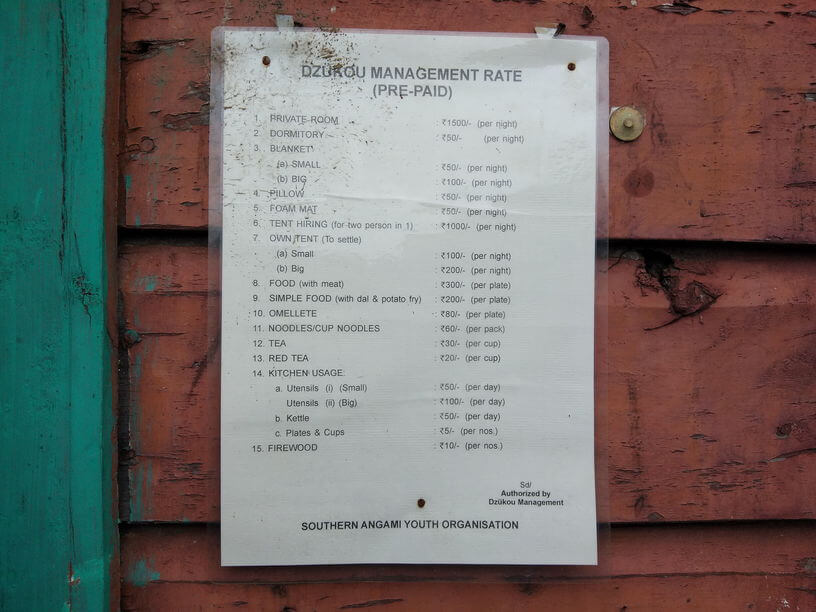
Recently, SAYO also declared the valley as no-plastic zone in a bid to preserve and protect the environment, still fighting with the menace existing plastic has already created. As stated by Mr. Zakieleto Tsukru, President of SAYO, the two major Southern Dzukou entry points, Visvema and Zakhama, will be monitored for implementation of plastic ban. The rates for entry to the valley, renting of things like blankets, mattress, utensils etc., firewood, food, camping, accommodation etc. is all decided and fixed by SAYO.
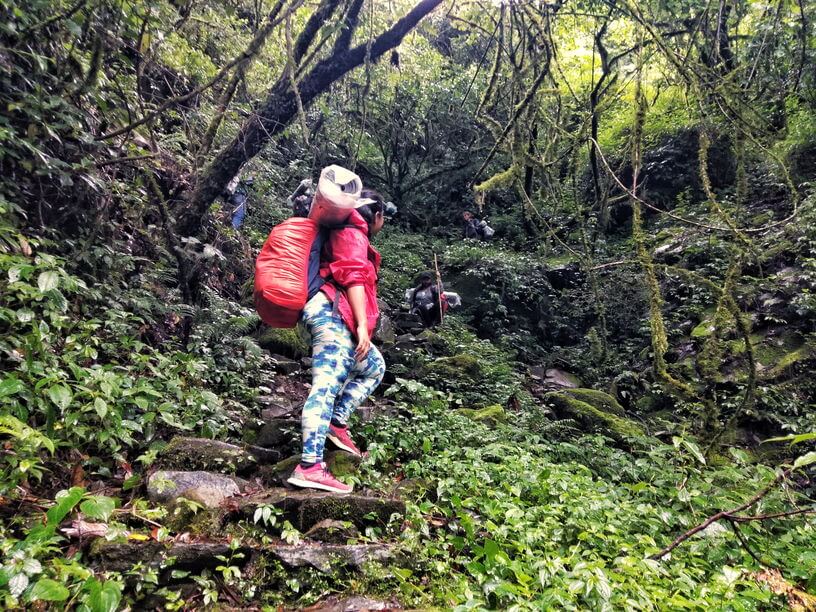
Exploring –Things to Do in Dzukou Valley
The immaculate valley is laid in contours of treeless gentle mounds covered in dwarf grasses, some places dotted with burnt trees standing as reminder of the devastating wildfire. The candy clouds float below the valley at the break of dawn, slowly clearing to make way for the rays of sun, casting a golden hue on the valley.
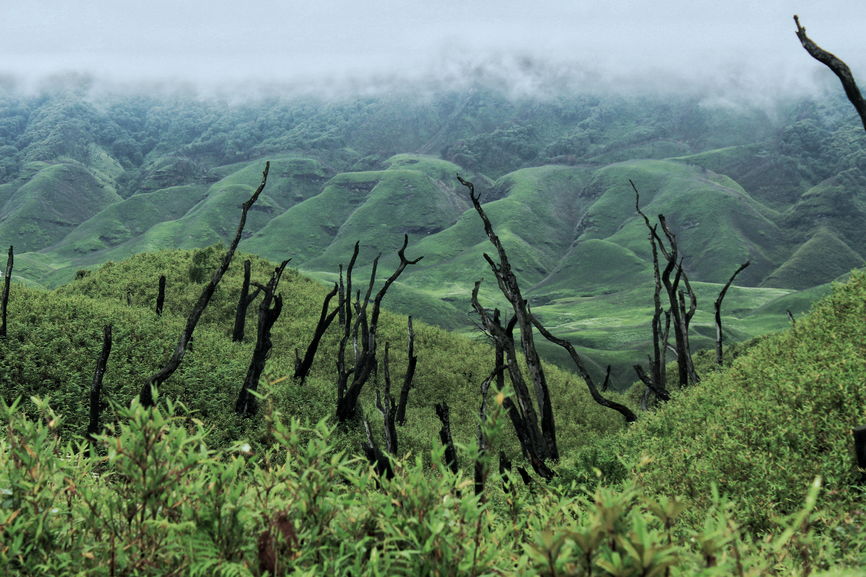
On a perfect sunny day, the valley shines in different shades of green overlooked by the clear blue skies. The winding rivulet flow through the valley with crystal clear water snaking along, perennial waterfalls are tucked in forbidden corners, deep cut ravines and caves, all are perfectly sculpted by nature.
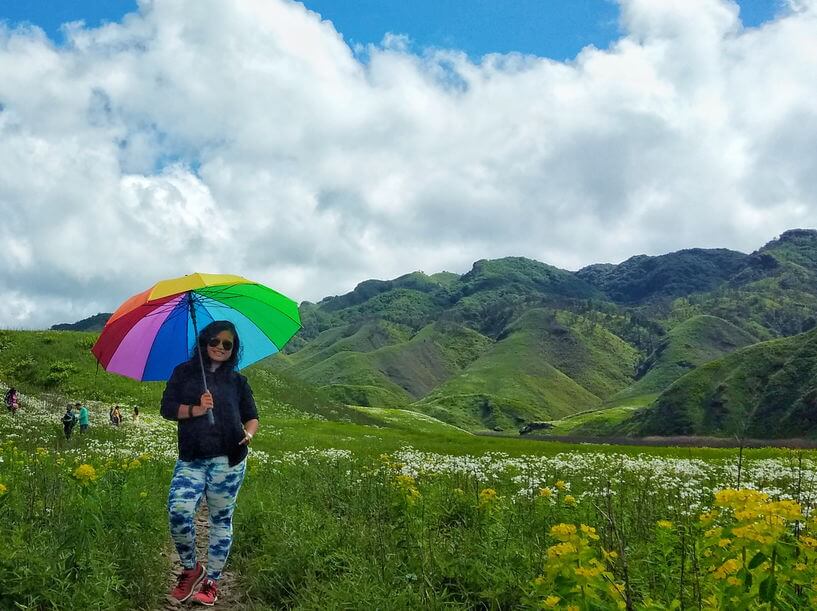
Trek to Bottom of the Valley
The spectacular vista of the valley from the guesthouse located on top of the valley is magical but a trek down the valley open into more spectra of nature. As you climb down, witness the colorful valley sprinkled in flowers, spot the rare Dzukou valley and make all the way up to the huge cross, transcending the flat terrains. The flat land of the valley is surrounded 360° by the rolling hills.
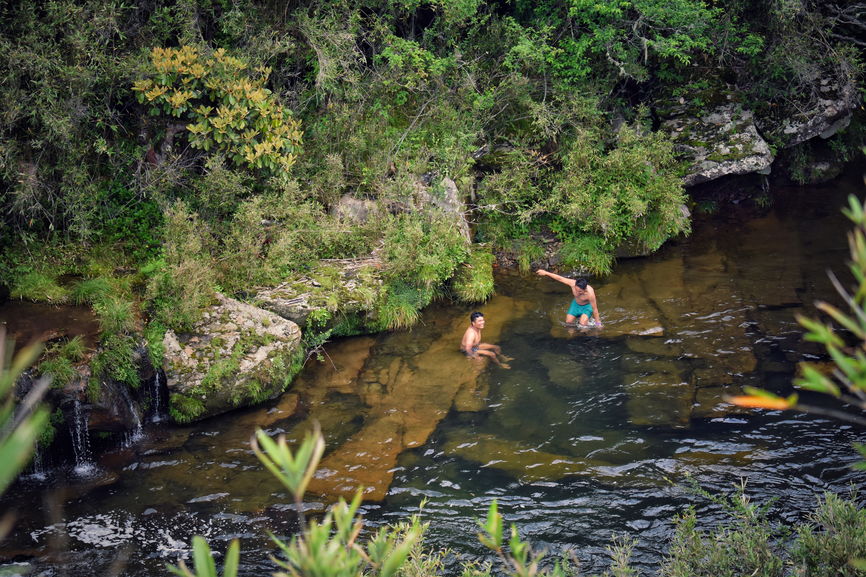
Take a dip in the crystal clear rivulet
The crystal clear rivulet meanders through the valley and becomes shallow towards the centre. It gently flows through rock formations and crevasses tucked in the valley shaping into natural pools. As they run across the valley, the stream takes many forms starting from rivulet to waterfall to water pools. Take a dip and refresh your journey in the valley.
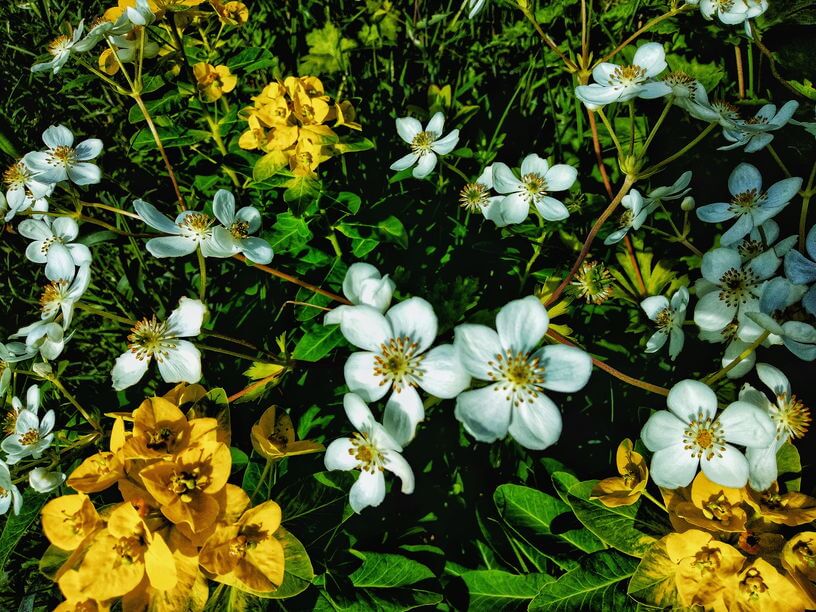
Enjoy the colorful riot of flowers
To witness the valley in full bloom, make sure you visit between the months of May to August, June being the best. Dzukou Valley stands remarkably vivid with blooms in white and yellow, occasionally dotted with blue flowers. The rare Dzukou lily makes its appearance across the valley in sparse location painting the green canvas with sprinkle of pink. With such gorgeous blooms, it is rightly named as “Valley of Flowers in Northeast”.
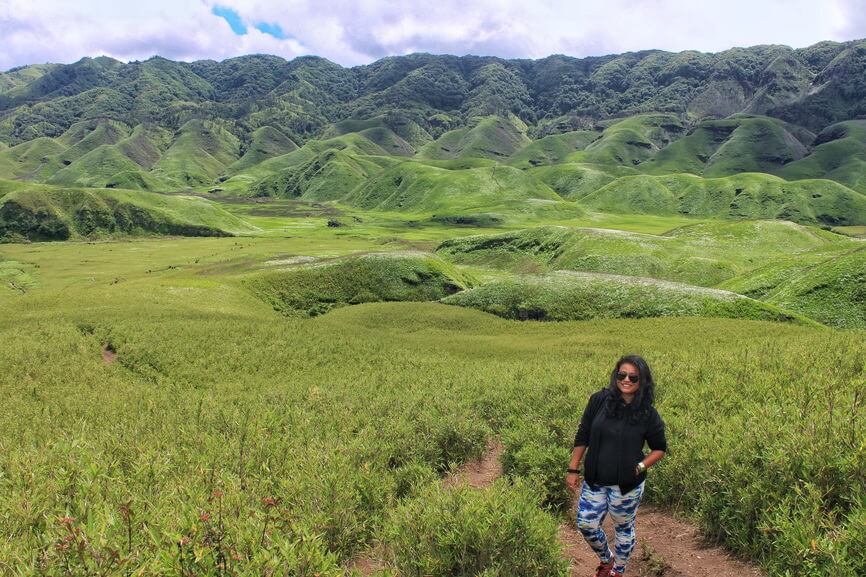
Explore the century old caves
The age old caves sheltered a lot of trekkers and explorers back in days when the valley was a remote dream, a celestial hidden existence. The years of weathering formed these caves and are pretty interesting phenomenon to explore. Some caves are small and right in middle of the bottom of the valley and some are tucked secretly in the lap of the woodlands.
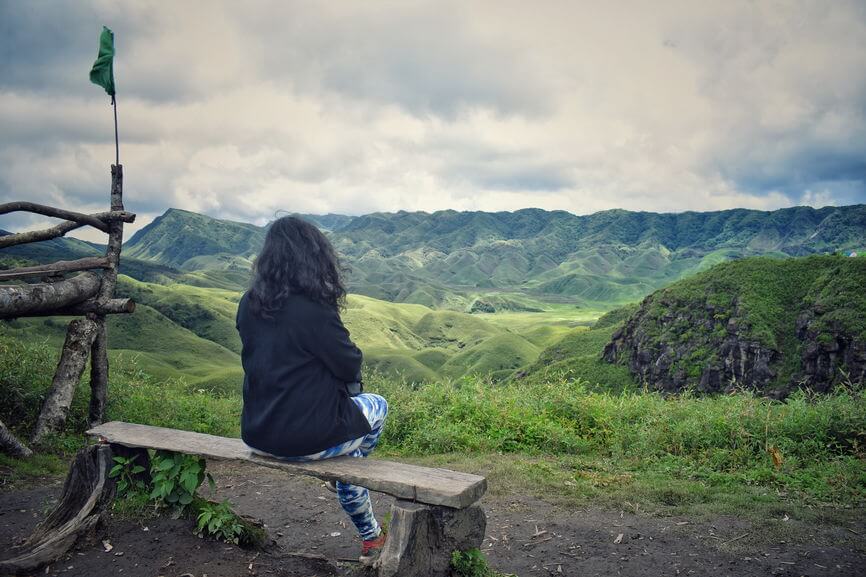
Soak into the celestial beauty of the valley
One of the best things you can do in Dzukou Valley is absolutely do nothing and surrender to the beauty of the moment. Sit and admire the valley, rejoice the air around, live in the moment and get surprised again and again witnessing the round hillocks. From the guesthouse, get a spectacular view of the valley while sipping a cup of coffee or tea.
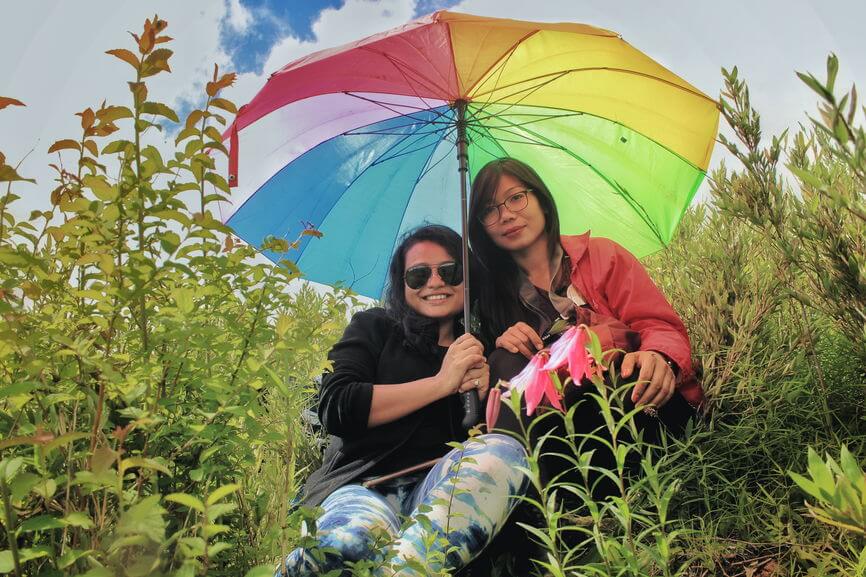
How to reach Dzukou Valley?
Since Dzukou Valley is spanned along Nagaland and Manipur, it can be attempted from either ways but Manipur trail is not marked, quite a strenuous one and needs expertise in mountaineering. Dzukou Valley from Nagaland can be attempted from Southern or Western Dzukou Valley side. The Southern Dzukou Valley trail starts from Zakhama and Visvema Village and for western, it starts from Khonoma Village.
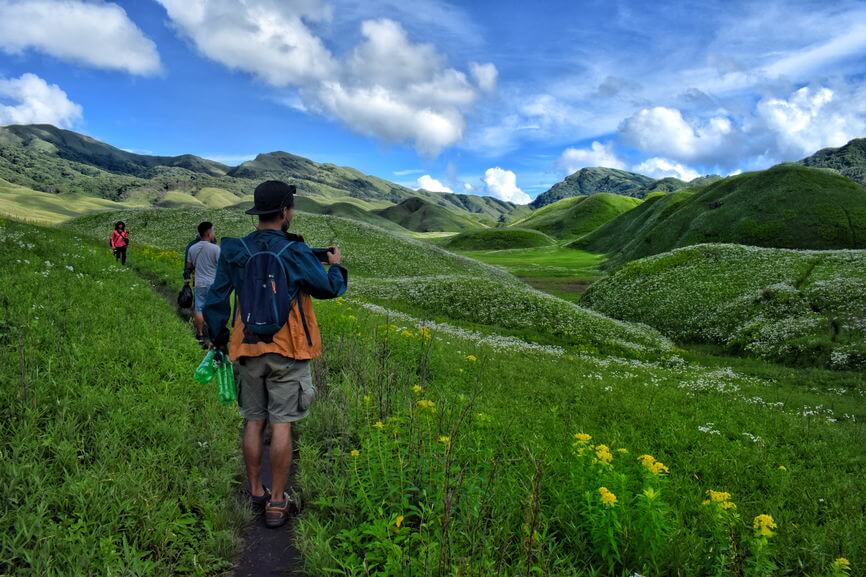
The Southern route is the easiest and maximum attempted with Visvema trail being easiest, more convenient and easily accessible. If you intent to visit Dzukou Valley via Zakhama, be prepared for steep climb of around 4 to 5 hours and 1 or 2 hours of flat land walk. It is not advisable to take Zakhama route during monsoons. Read more about trekking to Dzukou Valley via Zakhama .
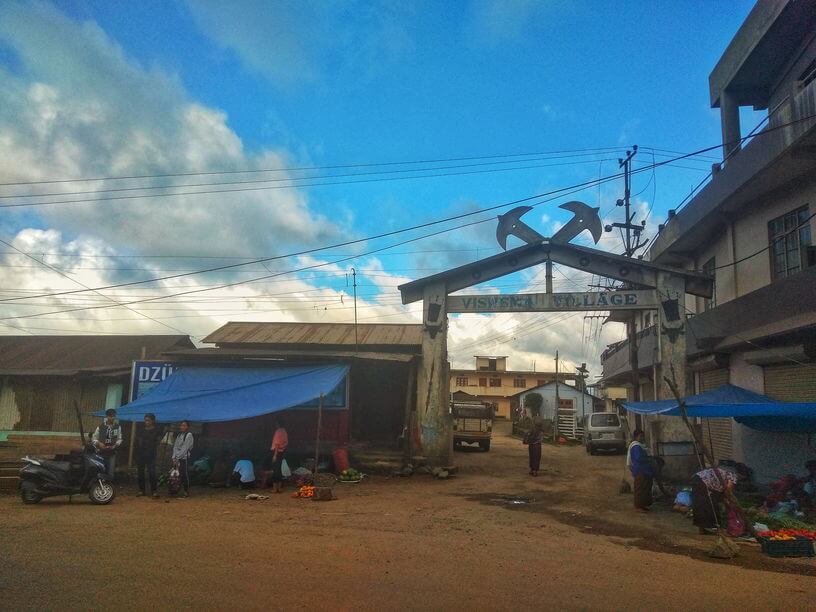
Visvema Route
The Visvema village is the most common base for Southern Dzukou Valley. It is mandatory since June, 2019 to register your name before starting the trek in the registration office. The office is located on left side of the main road, opposite to base of Visvema trail, as you drive from Kohima. The Visvema route of Dzukou Valley goes up towards right from the main road and is motorable till 5 to 7 kms (roads are in very bad condition), beyond which the actual trekking starts on foot. Here are the ways you can reach the base of the Visvema Trail
- If you are planning to do it on your own and in budget, take a shared cab from BOC counter in Kohima and get down at Visvema village. You can either chose to walk all the way up through the motorable road or hitch a ride.
- Second and expensive option is if you have a group of friends; hire a cab that will drop you till the end of the motorable road in Visvema. The same cab will also come and pick you up after you climb down but the both side fare is around Rs 5000/-.
- The last option is join a travel company like Sangai Moonlight Camping where everything is arranged by them as part of the package.
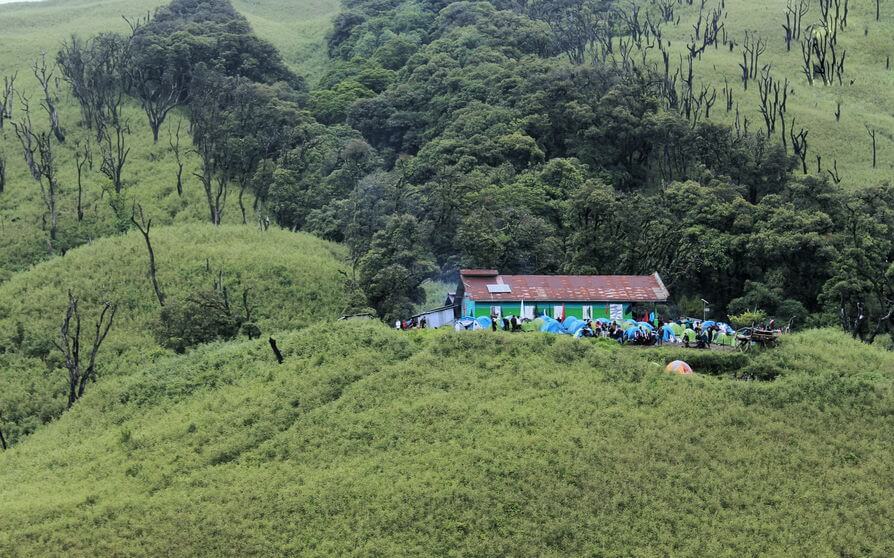
Accommodation – Where to Stay in Dzukou?
Depending on the availability, there are private rooms with very basic amenities at an exorbitant price of Rs 1500/-. However, it is limited to only few rooms and is give first come first basis. Next option is inside the guesthouse that doubles up as dormitory, the foam mattress and blanket can be rented from the management. Also, one can use their own sleeping bag. The last option is camping in tents in designated area. Camping at the base of the valley is not permitted and there is a nominal fee for camping space.
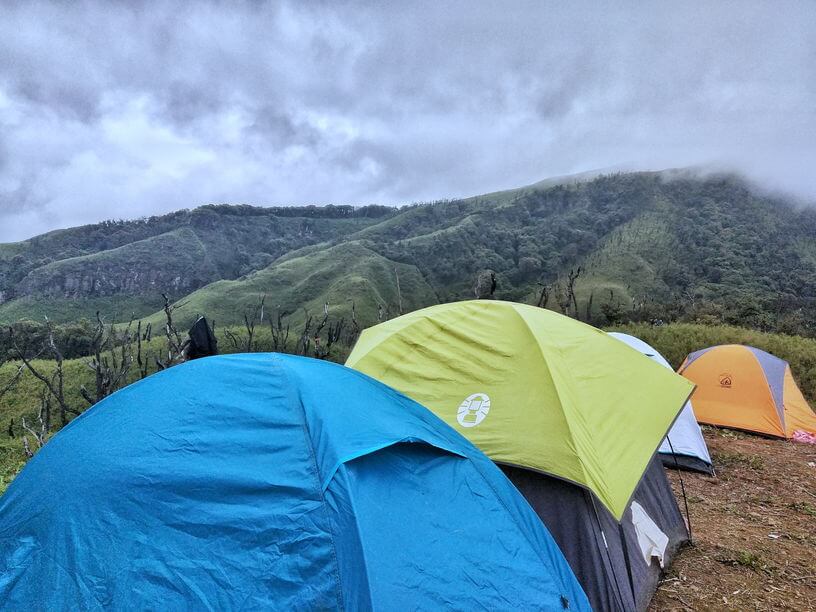
Best time to Visit Dzukou
- April – August – This is the best time if you wish to witness the valley sprinkled with colorful flower blooms. Also, this is the time when the rare Dzukou Valley blooms and lightens up the masterpiece of nature.
- September – November – The valley starts to lose the flowers but it is still green and comparatively dry.
- December – March – The winters cast a different charm as the frost wraps the valley in white during the wee hours of the morning.
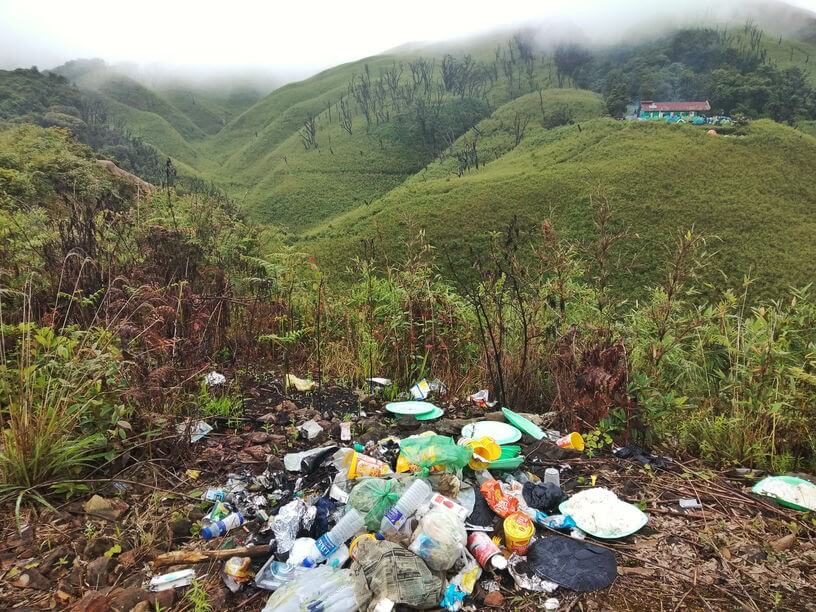
Impact of Over-tourism in the Valley
Awe-inspiring, spectacular and an absolute delight for our ravenous soul – Dzukou Valley bestow to the searching eyes an unconventional paradise, away from the chaos of the morning horns and incessant noise. It stands there silently welcoming every tourist, every bucket list tickers and one picture for social media fanatics. But, the burden of unchecked tourism and camping, the plastics left behind by people and the tons of food waste – The valley is slowly drowning with the eco-system being heavily compromised.
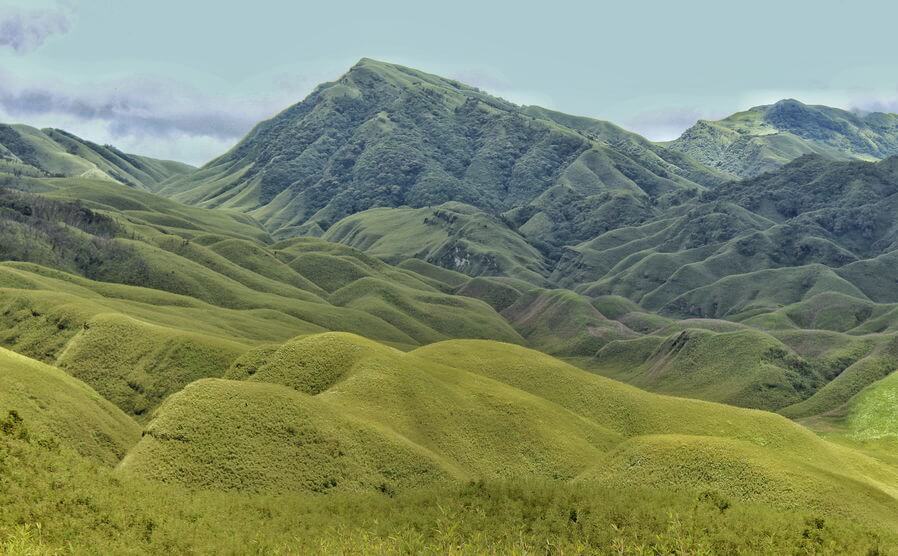
This was my second time in Dzukou Valley while the first was in 2016; it was and still is pristine except, the base of the valley is now hoarded with hundreds of campers. Loud music blares through the speakers suppressing the sound of the gurgling stream. Billow of smoke penetrates mercilessly in the atmosphere from bonfires, introducing pollution in the valley that once breathed in peace and pure air. Oh! The plastic waste buried under the ground, on the surface, in the valley, and around the camping area in the base is getting alarmingly high despite Dzukou Valley declared as plastic free zone.
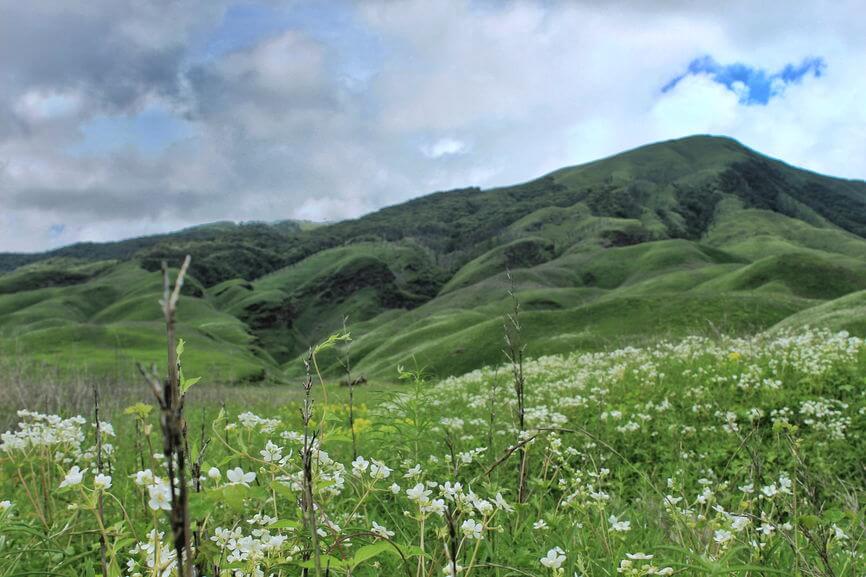
The eco-system has undergone a lot of changes for the valley is not ready to carry the burden of so many people. This year the flowering season arrived a month earlier which might be due to fluctuation in climatic change or shift in the ecosystem. With the increasing food waste dumping out in the open, there is high chance of increasing pest manifestation and introduction of invasive species posing threat for the native fauna. Looking at the bigger picture, if tourism is not checked, the beauty of the valley might become history impacting the wide expanse of flora and fauna.
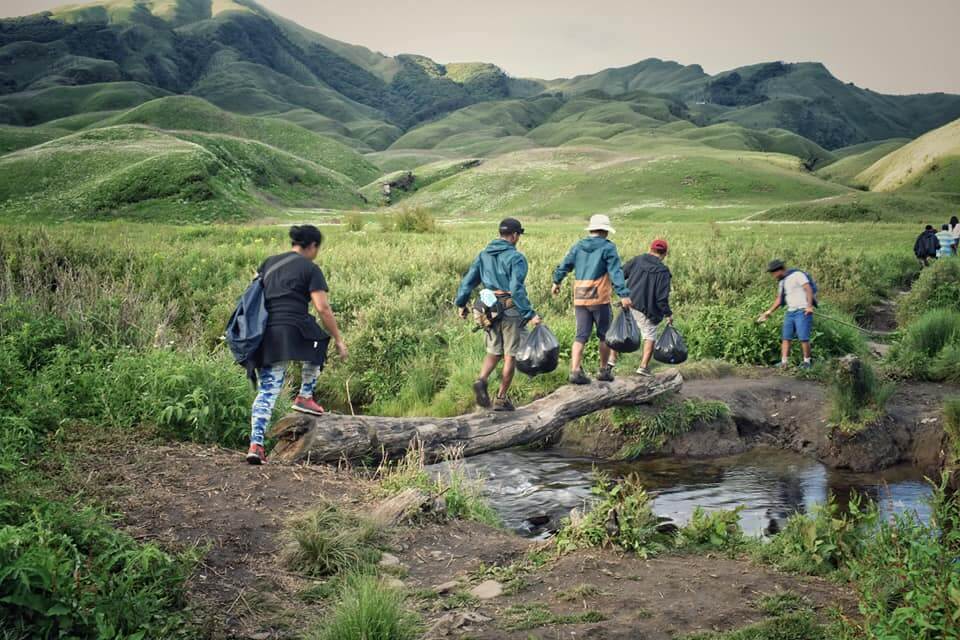
How to maintain the Eco-system of Dzukou Valley?
The picturesque valley is at the peak of its tourism and likely to increase over the coming years. Meanwhile, the viral pictures double up as an opportunity for a lot of people to pocket in money without contributing to the well being of the valley. Few years back, there was not a single tour company organizing trips but with a span of 2 years, the solitude of the desolate valley changed into easily accessible chaos. But, it is never too late and here is what we can do to help the valley revive
CLEAN UP DRIVE WITH TEAM OF SANGAI MOONLIGHT CAMPING
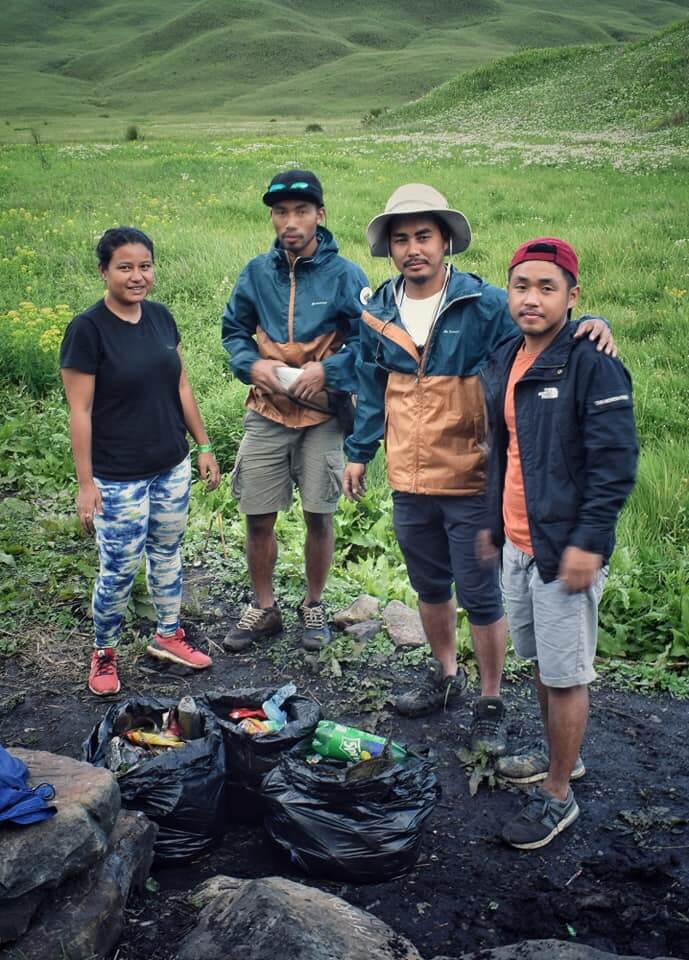
- The management (S.A.Y.O) and Nagaland Tourism must put a capping at number of visitors allowed per day. The restriction will make Dzukou Valley exclusive and will reduce burden on the valley.
- The camping must be allowed only in designated area (which is implied already) and it must be made mandatory for the campers to clean up their area before leaving.
- The travel organizers or tour groups must limit the number of tourists with them. The tour organizers must play their part in organizing clean drive.
- The kitchen space used by campers and tour organizers must be cleaned after use and all the waste material should be compulsorily taken back.
- The food wastage must be minimized and the waste dumping must be done in a pit or closed system to avoid pests and invasive species from posing threat.
- Although Dzukou Valley is declared plastic free zone but the copious amount of plastic everywhere is disturbing. The plastic usage must be better managed; trekkers and tour organizers must be prohibited from carrying plastic.
- Bonfires must be limited so that minimum smoke penetrates into the environment. The smoke and ash increases the pollution and hazardous to health.
- Allow one day every day to heal by prohibiting visitors and closing the entry to the valley. This will give the valley some rest it deserves.
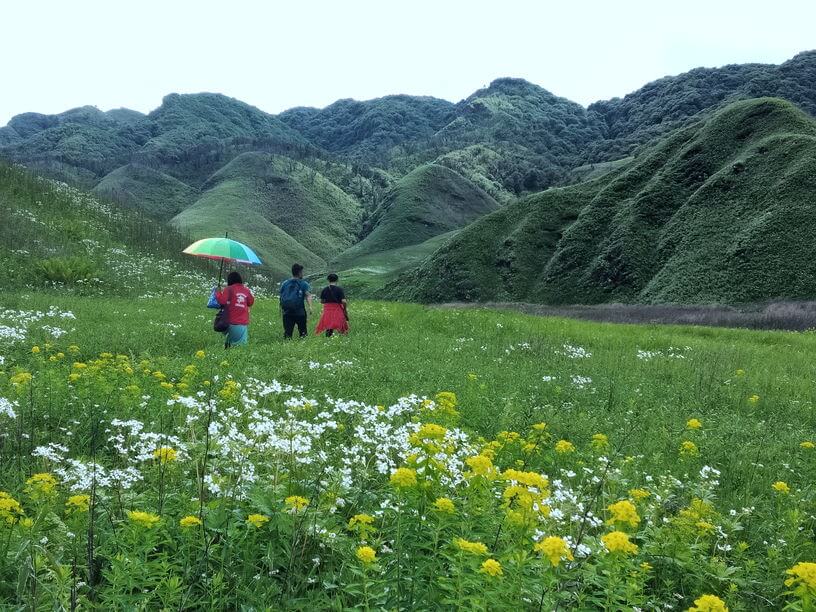
Explore Dzukou Valley with Sangai Moonlight Camping
Sangai Moonlight Camping is a household name in travel and tourism in Manipur with their eco-tourism initiatives and constant war against plastic. I have stayed at their gorgeous Loktak Aquamarine Homestay on Loktak Lake and visited the very remote Kwatha Village along Indo-Myanmar border. My experience with them even this time was great for all the right reasons:-

- Organizing a clean-up drive and continuing their war against plastic. We managed to collect a lot of thrash and buried plastic from the valley.
- Never failed to greet anyone with a smile despite being tired with all the cooking, cleaning and camping set up.
- The team single handedly prepared meals – lunch and dinner for all their guests, irrespective of the smoke burning the eyes in the kitchen area.
- Once the camping was over, the team ensured that the camping area and kitchen was neat and clean, all the waste was collected and brought back.
- You get professional photographs clicked by them and once the trip is over, they send the pictures after editing.
- The team walked us into hidden corners of the valley and into secret ravines tucked in the woodlands.
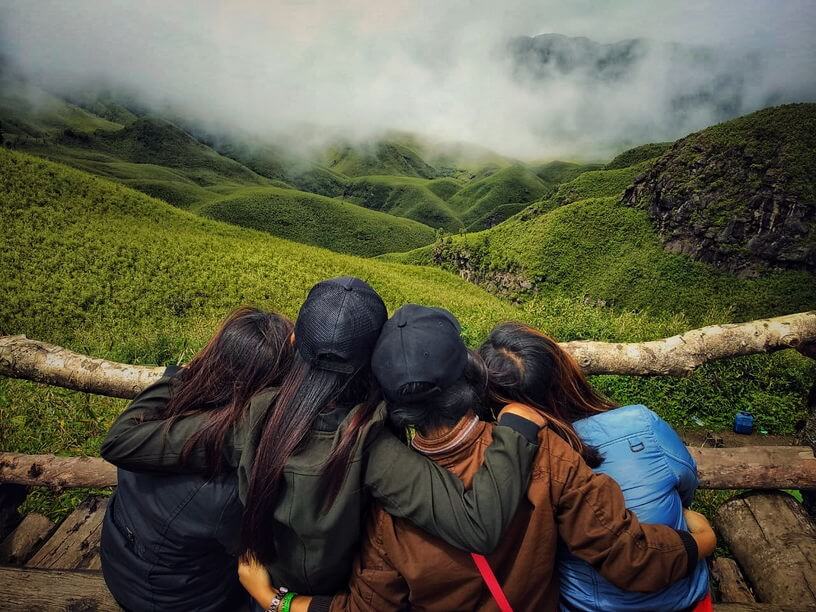
In short, I had an amazing time with the team. It was fun spending time in kitchen, helping them in the chores and listening to Manipuri music. However, due to the experiential tourism initiative and prominent presence in Manipur, the trekking groups with Sangai Moonlight Camping are huge and at times it becomes chaotic with so many people around. So, if you don’t prefer such huge groups, you may contact them directly and they will help you organized a customized trek to Dzukou valley alone or with limited people. You can reach them at – 08014921286 (Ashok Sapamcha).
IF YOU LOVED THE BLOG, PIN THE POST TO READ LATER
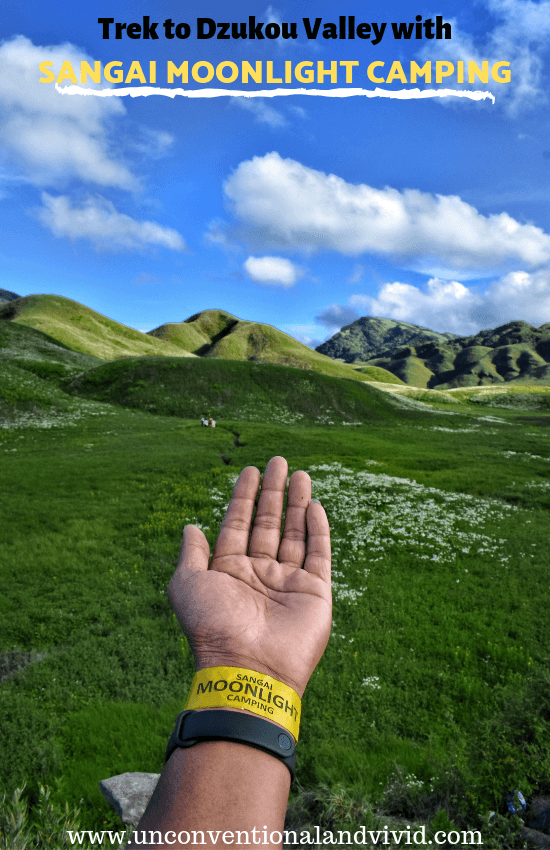
Share on Social Media:

- Share on Tumblr
Tags: Accommodation in Dzukou Valley Dzukou Valley Dzukou valley trek how to reach dzukou valley Offbeat places in Nagaland
You may also like...
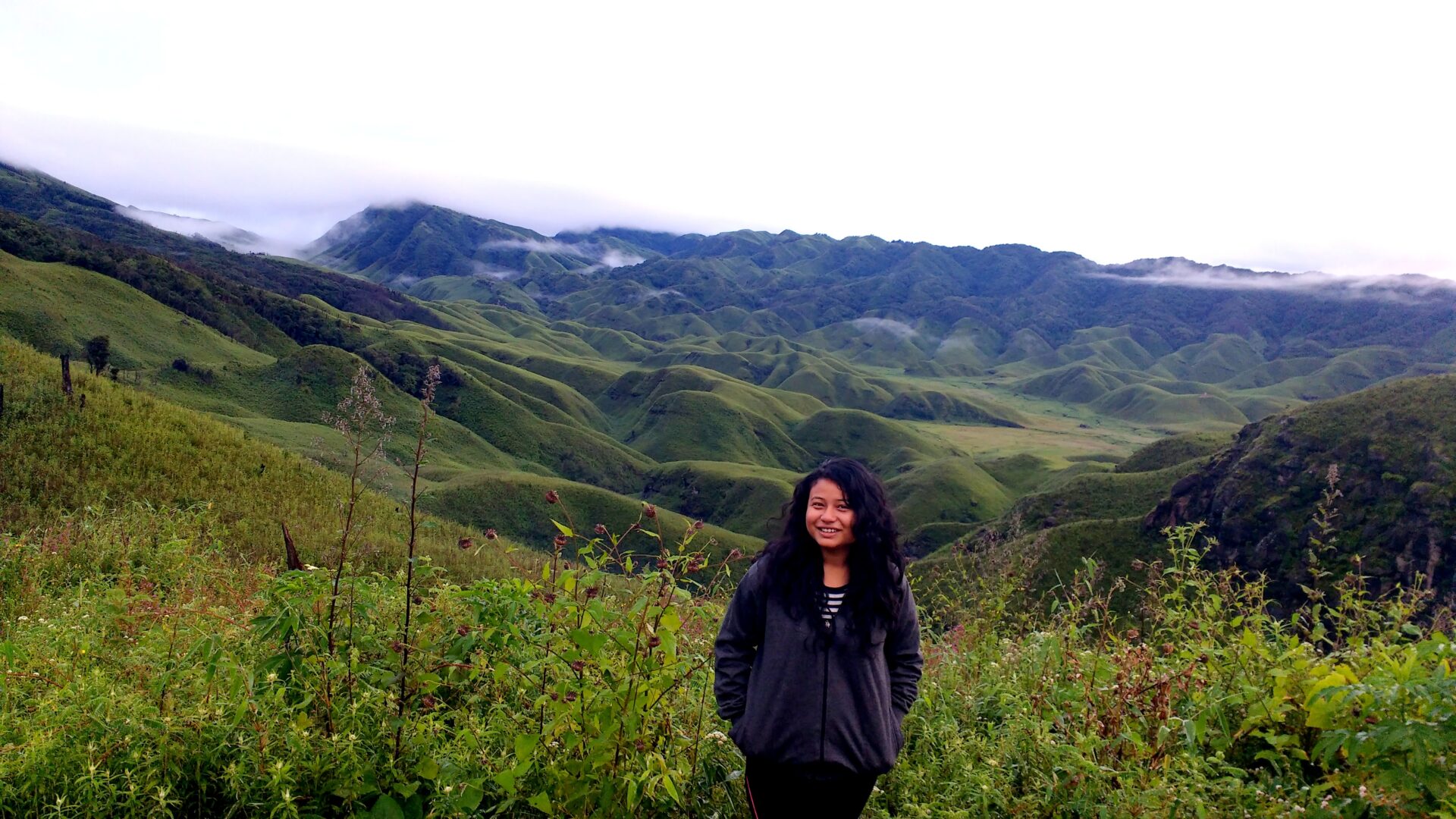
OFFBEAT TERRAINS OF DZUKOU VALLEY, NAGALAND
August 16, 2016
by upsy · Published August 16, 2016 · Last modified March 29, 2018
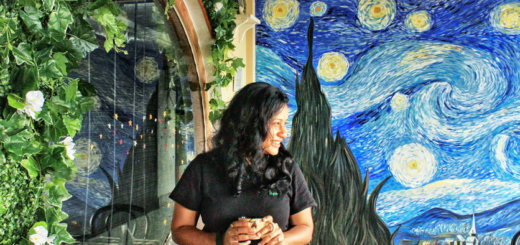
A Comprehensive Kohima Travel Guide
August 16, 2019
by upsy · Published August 16, 2019
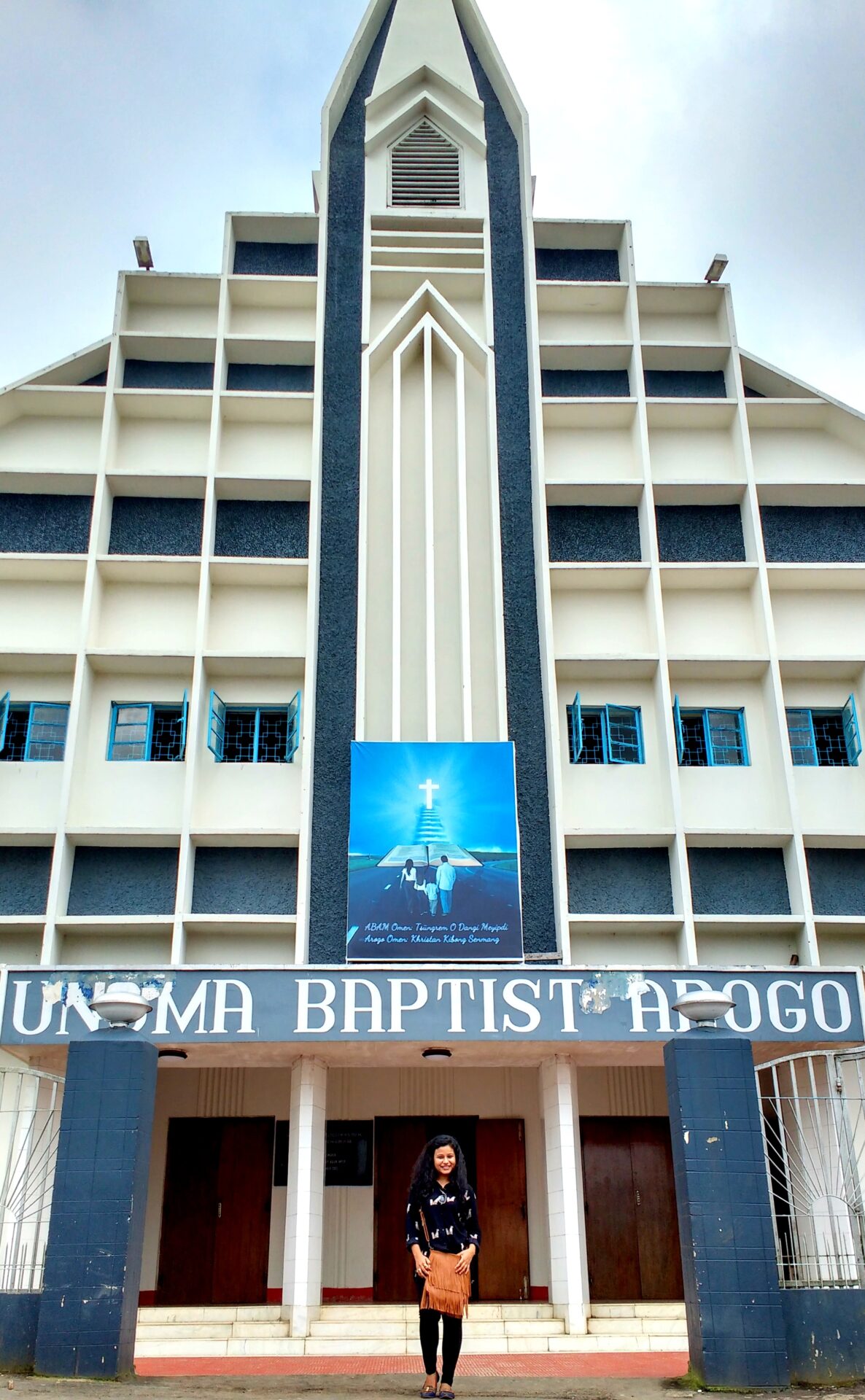
SHORT, CHERISHED TRIP TO UNGMA VILLAGE, NAGALAND
September 25, 2016
by upsy · Published September 25, 2016 · Last modified January 18, 2017
2 Responses
- Pingbacks 2
[…] Read the complete blog on Dzukou Valley […]
[…] rolling hills sprinkled with yellow and white blooms stretched along with the stunning vistas of DzukouValley is occasionally dotted with pink Dzukou lilies. As the sun cast its first rays, the valley change […]
Leave a Reply Cancel reply

I am Upasana Kakati. I am an avid traveler, teacher, travel blogger and dreamer. I love uncovering hidden gems and exploring places that offer cultural and perspective per se. I am from North East India and currently making my way to offbeat destinations in North-East and rest of the country. I started this travel blog to pursue my passion for writing, keep the side hustle on and share my travel experiences. As of now I do not have any plans to quit my job to travel full time because I love financial security to a point. But, no one knows what tomorrow has in store.
Never miss a travel story – Subscribe
Email address:
Leave this field empty if you’re human:
Follow on Facebook
Listed 40 times as Top Travel Blog Of India!

Dzukou Valley trek in Nagaland: Complete Guide
Last Updated on January 28, 2022 by asoulwindow
Table of Contents
About Dzukou valley
Dzukou valley, is an easy level trek near Kisama and Kohima, the venue for annual Hornbill Festival of Nagaland. Dzukou valley is known for the unusual shapes of its verdant hills, surreal sunsets and the rare Dzukou valley lily.
Located near Kohima and Kisama, people can trek to Dzukou valley from both Nagaland and the neighbouring North East Indian state Manipur. This must-see place is just a quick weekend destination from Kohima.
Here is the most comprehensive travel guide to Dzukou valley trek on internet.
Nomenclature of Dzukou valley
Dzukou valley is also spelt as Dzükou Valley or Dzüko Valley. It is interesting to note that the word Dzüko is not really a happy and positive word. Dzüko is a word derived from Viswema dialect of one of the major tribes of Nagaland called as Angami tribe .
I was surprised to know that the literal meaning of Dzüko is ‘dull and soulless. Others say that ‘Dzu-kou’ in Angami/Mao language stands for cold waters. It indicates at the icy cold water that flows in Dzüko valley.
In the Mao language of Manipur, the word Dziikou also stands for ‘Dream like’ thanks to the mystical charm of this offbeat place. As per the legends in Mao, it is said that when lovers visit the Dziikou Valley, the night turns like a day and the moonlights shines as if it is sun!
As per the local folklore, in old times, the ancestors of Viswema wanted to build a new village in Dzüko. However, they found the climate and weather of Dzüko unfit for farming and harvesting crops. This is why the ancestors labelled Dzüko as ‘A beautiful but dull and soulless valley.’
Why is Dzukou Valley famous?
So, why do tourists visit Dzukou Valley in Nagaland? There are many reasons to why the Dzukou Valley is so famous around the world. Many Indians and foreigners head to the annual Hornbill Festival every year in Kisama near Kohima. Most of them also club the Dzukou Valley trek, which is located nearby.
The proximity of Dzukou Valley from Kisama, the venue of Hornbill Festival has continued to its popularity over the years. Also, the beautiful landscapes of the hills of the Dzukou Valley have added to its fame over the years. The shapes of the hills at Dzukou Valley are very unusual. People come from near and far just to sock in the breath-taking views of the Dzukou Valley.
Despite its soaring popularity, the Dzukou valley is still one of the best offbeat places to visit in Nagaland and North East India. This is so because even now the number of people who trek to Dzukou valley are very small.
Needless to say, the Dzukou Valley trek is the most famous trek throughout the North East India . I have done other treks in North East India such as Bat Cave Trek and Odi Pudo trek in Basar in Arunachal Pradesh . They were all easy one-day treks .
Dzükou valley trek: My Experience
I finally made it to Dzouko valley trek. It’s just a 3 hour long easy trek from Visvema village. I, however freaked out at the narrow path in the Dzukou valley. It lasted for 1.5 to 2 hours.
I found the dome shaped meadows of Dzouko valley breathtakingly beautiful. I kept staring at the verdant knolls and the iconic rolling hills, losing any sense of time. The sunset at Dzükou was also one of the most amazing ones I have seen.
I did the famous Dzükou valley trek with my co traveller Amit Chandana from Delhi. We had just met in the Hornbill festival, became good friends and the next thing we know is that we travelled together for many days in Kohima, Loktak Lake and Imphal in Manipur and the special Moreh and Tamu border between India and Myanmar .
I and Amit began our journey from Kisama, outside the venue of Hornbill festival. We negotiated with a driver at the taxi stand. He dropped us at the Viswema village, the starting point of the Dzükou valley trek. But we insisted that he drop us even further as we had got late already.
The poor young man had recently lured into being converted to Christianity from Hinduism . The shrewd Christian missionaries are found in plenty in North east India. I saw many similar Christian missionaries in Uganda and Africa as well whose sole agenda is to convert people to Christianity and give them ridiculous names such as Tom, Dick and harry, eh!
Our ‘Harry’ already seemed frustrated and we added fuel to his woes by making him drive on the rocky patches leading up to the actual start of the Dzükou valley trek.
Soul Window Tip
The driver kept complaining but it was a good idea that we stood our ground and drove over this rocky patch. This part which must have been some 8-9 kilometres didn’t offer much of a view and saved us from unnecessary extra trekking.
It was not even the actual trek. It can take you upto 3 hours to negotiate this gradual incline. You must therefore avoid walking here and save energy for the actual Dzukou Valley trek.
Start of Dzukou Valley Trek
We finally arrived at a flat ground. There were some houses and other cars parked there. We confirmed the route of Dzükou valley trek from the ladies drying the red hot Bhoot Jholokia chillies. The driver ran away as soon as we turned towards the Dzükou valley trek route.
It was end of autumn and beginning of winter, so our path was laden with golden brown dry leaves.
As we navigated our way through Dzuköu Valley, the mere sight of the wooden huts made me excited! When I finally had my first bird’s eye view of Dzukou Valley, I was stunned at its unusual beauty!
Dzukou valley Height or Altitude
The altitude of Dzukou valley is not much.The total height of Dzukou valley above sea level is merely 2,462 meters or 8077 feet which is same as the height of Lukla , the base village of Everest Base Camp Trek or Lohajung, the base village of Roopkund trek in Uttarakhand in North India.
Just to give you a perspective, the height of Lukla is 9383 feet or 2860 meter and the height of Lohajung is 7545 feet or 2300 meters. I have fond memories of these treks as well.
Dzukou valley difficulty level
I had checked out from my tent in Kisama. Before we left Kisama for Viswema, I had dropped my huge bag-pack in the tent of Amit in Kisama which turned out to be a good decision because the first 1 hour of the trek is a tiring steep climb through dense forests. This rock patch was around 1 kilometre long.
Though, the climb on the rough stone steps is very steep, it is still an easy one. It reminded me of the tougher endless stairs I climbed in Ulleri during the Poonhill Trek in Nepal in the Annapoorna Range in the Great Himalayas .
Arriving at Flat Ground
When we reached the top of the ascent of Dzuköu Valley, we were greeted with sweeping bird’s eye views of the valley and mountains in distance. It was our first beautiful panoramic view since the climb started. I was impressed to see how green the place was even in winter.
The tall mountains in far distance made for a dramatic setting! The final destination of Dzukou valley trek is located at a distance of just 4-5 kilometres from here.
Narrow passage
From here it is just a 2 hour walk of easy trek to the final destination of Dzukou valley trek . It was a relatively very easytrek.I, however was not very comfortable with the narrow passages.After having done high altitude treks like Roopkund trek and Dodital-Darwa Pass trek in Uttarakhand and Everest Base Camp trek in Nepal , I have developed this phobia of heights, especially when the path is narrow.
My co trekker Amit Chandana whom I met for the first time in Hornbill festival gave me good company. He sincerely waited for me as I navigated through the treacherous patches on trek.
As for the technical difficulty, I feel that you do not need to have a prior trekking experience to be able to complete the Dzukou valley trek successfully. Anyone with a moderate fitness level can do the Dzukou valley trek easily.
There was just a small rock patch which one needs to cross cautiously. One mistake and you can fall straight into the seemingly harmless valley. Amit helped me cross it. It reminded me of a similar patch I saw during the famous Bhimashankar Monsoon Trek in Maharashtra and Gokarna Beach Trek in Karnataka .
Route of Dzukou valley trek
The entire route of Dzukou valley trek is well marked. We did the trek on our own and didn’t really need a guide. We saw many people from different states of India and European nations such as Netherlands , doing the Dzukou valley trek on their own.
There is just one place which might confuse you on which trek route to take, just follow the path where most people are going and you will be sorted. This place comes when you reach the top after ascending the stairs. You can reach Dzuköu Valley from both Nagaland as well as its neighbouring Indian state Manipur.
There are three main routes of Dzukou valley Trek
Viswema Route
I took the popular Viswema route! It took me 3 longs and was a very easy well marked route. The signboard of ‘Dzuköu Valley’ throughout this route further helped us. It is the most popular route.
Jakhama Route
Though Jakhama route is shorter it is not very popular because it is very steep and the path is confusing. It is also considered to be a difficult route. Jakhama is also spelt as Zakhama. Be warned that the ascent on this route is difficult and tiresome. It is not very popular but still some trekkers prefer this alternative route. Jakhama is 20 kilometres away from Kohima.
Manipur route
The other route of Dzukou valley starts from the Mount Issi at Senapati district in the neighbouring state of Manipur. It is the least popular route. The amenities on the Manipur side are not proper. The trekking route from Manipur is also strenuous. Manipur Mountaineering and Trekking Association or the MMTA often takes the 5-hour long trek from the Senapati route.
Soul Window Travel Tips
Many trekkers also start with the Viswema route and conclude it with the Jakhama route. This not only gives an idea of the alternate views but also rewards the trekkers with different views of the Dzukou Valley.
Views during the Dzukou valley trek
I trekked to Dzukou valley in the winter months. It was lush greenery no matter which location I turned to. The way to the final spot in Dzukou valley trek is equally beautiful.I avoided looking down immediately fearing vertigo so I admired the mountains far in distance. Despite the Hornbill festival, we didn’t quite meet many people on the way perhaps because we started late for the trek.
The unique trees of Dzuköu Valley are its hallmark. The stunning landscape of Dzuköu Valley impressed me even before we had reached its final stop.
How long Dzukou valley trek takes
The Dzukou valley trek took me just around 3 hours to complete, despite my slow pace and camera breaks. Out of these 3 hours, the first 1 hour is the toughest because it is a steep climb. The next 2 hours are a breeze in case you are not bothered by the narrow pathways. To summarise, Dzukou valley trek was one of the shortest and easiest treks I ever did.
Dzukou valley location
Where is Dzukou valley located? Dzukou valley is located in both Nagaland as well as Manipur. In Nagaland, Dzukou valley is located near Kisama and Kohima, while in Manipur, Dzukou valley is located near Senapati district.The Dzukou valley stands behind the famous Japfu Peak in Nagaland.
Dzukou valley Ghost Cave
Ever wanted to narrate ghost stories in a dark cave? Well, that is possible in Dzukou valley cave. There is a famous Bhoot Gufa or the Ghost Cave nearthe Trekker’s Hutor Rest House. This is another popular tourist places in Dzukou.
You can just trek for 15 minutes to arrive at the Bhoot Gufa.It is an easy descend and an important place of interest in Dzukou.
It is a long and dark cave so it is advised to carry torches and flashlights while visiting the cave.The cave at Dzukou valley is one kilometre long. You must visit this tourist attraction of Dzouko, probably with a local tourist guide.
Dzukou valley helipad
There are so many other places you can explore in and around Dzukou valley such as a helipad and a bridge. It is one of the most unusual things to do in Dzukou valley.
The Dzukou valley helipadis used once in a while by VIPs. The helipad is not much in use through most part of the year.
Dzukou Valley Bridge
Did you know that you can also go to a Dzukou valley bridge? But it takes around 3 hours to the bridge and back to the base of rest house. Still, many trekkers go here for great photo opportunities. It is a free thing to do in Dzukou valley.
The real Dzukou valley
Do you know that you can arrive at the actual open Dzukou valley from a nearby route which starts from the Rest House? It takes around 30 minutes of an easy gradual descent from the Rest House to reach the open valley which we saw from the Rest House.
This route from the rest house also passes through a helipad You will also pass the Dzukou river on this route. These are some major points of attractions here.
Dzukou valley camping
I saw tourists camping on the helipad as it offers stunning alternate views of Dzukou valley. Trekkers either carry their own tents and can pitch it at a designated spot for a small fee. In case, you want to do camping only after arriving here and have not brought along any camping gears, fret not!
The staff at Rest House can provide you with tents and other camping gears as well. Needless to say, these cost more.
Dzukou valley landscape
The landscape of Dzukou valley is unlike anything else I have seen in India or abroad. The cute little mounds enveloped entirely by grass, makes for a picture postcard perfect setting! The spectacular landscape of Dzukou valley also makes for great photo opportunities.
The topography of the valley is such that it looked like as if the Dzukou valley is a vestige of a massive volcanic crater or caldera of a prehistoric volcano.
Bonfire at Dzukou valley
The staff at the Guest House can also arrange for bonfires for extra fees. You can see many Indian and foreigners huddled around the bonfire, chatting the night away. This is a major attraction here. No wonder, Dzukou is also a famous picnic spots for many locals from mostly young trekkers from Nagaland, Manipur, Assam, West Bengal etc.
Wildlife of Dzüko
Dzüko is a terrain rich in wildlife . Though I didn’t spot any wildlife in Dzukou valley during my visit, it hides several magnificent animals and exotic birds in its undulating fields.
Some rare species of mammals such as the Asiatic Black Bear, Clouded leopard, Asian Golden Cat, capped langur and the only Indian ape: the Hollock Gibbon are found in and around the Dzukou valley.
The unusual looking serow, stump-tailed macaques , the capped langur and the indigenous Dzuko Valley horned toad (Megophrys dzukou) are some of the other exotic species you can find in Dzukou valley.
Birdwatching is also one of the top things to do Dzukou valley.
Dzukou Valley Vs Japfu peak
If you have time then you can do both Dzukou valley and Japfu peak at one go! In fact, Dzukou valley stands right behind the Japfu peak. Most of Dzukou valley and entire Japfu peak is located in Nagaland.
The trekking route here is punctuated with emerald green knolls,serpentine water streams,lush jungles and the constant company of exotic birds and butterflies such as Bhutan Glory (Bhutanitis Lidderdalii). These are must-visit places in Nagaland.
Japfu peak is located at a height of 6,000 feet only. The trek route of Japfu peak is 6 kilometers long and it takes around 6 hours to complete the Japfu peak trek. It is a moderate trek with mostly an ascending trail. Both are important sightseeing attractions of Nagaland.
Dzukou Valley Sunset
I have seen one of the best sunsets of my life in the Dzukou valley. Once we reached the final destination of Dzukou valley trek, it was time to ‘do nothing’ . Tired after an easy but long walk to Dzukou valley, I spent time just talking with Amit when suddenly the skies started to behave dramatic. The mystical golden hour of Dzukou started to unveil its myriad shades.
Everyone who was present there, including the locals, were silenced when the setting sun lyrically revealed its hues, one at a time. The chatty trekking team from South India and Maharashtra in West India also allowed nature to talk. A local man, draped in his stylish red Naga shawl stood on a rock, perhaps reflecting or missing the company of a loved one. It was a surreal moment.
I ran to my spot in the hall to get the camera. Just as I started clicking, I stopped. After a few shots, I switched off the DSLR camera and packed it in my bag. I wanted to feel the moment. I sat silently on the bench with Amit and soaked in the spectacular views of the scattered colours of a surreal sundown.
Sunset in Dzukou happens between 4 p.m. to 5 p.m. in winters. By 6 p.m. most places across North East India starts to begin desolate. So, it is advised to reach early. We had arrived just before the sunset. The sunset at Dzukou is not to be missed! It is the best thing to do in Dzukou valley. I had no prior knowledge of this and had just lucked out.
Soul Window Reflections
The lack of crowds and distractions made the sunset even more ethereal. Birds, flying in and out of sun in far distance, yellows turning into deep oranges, the works!
The other amazing sunsets I saw in North East India were in Majuli and over the mighty Brahmaputra River on a ferry ride near the famous Bogibeel bridge , both in Assam. Sunset in the famous Loktak Lake in Manipur if not stunning, was comforting!
As the stillness of the Dzukou sunset started to grow on me, it lulled me into a chain of philosophical thoughts. Isn’t that what a good sunset supposed to do!
Where to stay in Dzukou valley
I stayed at the only dormitory available there. It is run by the Nagaland Union and is the only place where you can stay in Dzuköu Valley. It has below basic facilities. I opted for the dorm type stay. I rented mats, pillows and blankets and failed to sleep anyways. It was too cold to sleep. Thanks to my down jacket I was able to stay protected from extreme cold for some time.
You have seen that jacket before on my previous trips such as the epic Kailash Mansarovar Yatra in Tibet , haven’t you? It had become my best friend on Treks. The leather free shoes also served me well.
I stayed at the huge community hall aka dormitory or rest house at the Dzukou valley. Painted with unpleasant art and graffiti, the huge wooden hall is built on stilts. We slept on the floor of the unkempt hall which was made up of large wooden planks. It was one of my most uncomfortable bed ever. Since I had trekked to Dzukou valley in harsh winters, I had tossed all night due to biting cold.
Though I had rented 2 thin blankets and a pillow, it was not helping much. The blankets were not clean either. Amit, on the other hand was in a better position as he was carrying a warm and clean sleeping bag with him. It is thus advised to carry sleeping bags with you (if you can)!
Be warned that during high season the room at Dzukou Valley Rest House might be full. During low season, the staff might not be present at the Dzukou Valley Rest House. The staff of Rest House wear many hats. They are responsible for collecting admission fees, providing beddings, make bonfires and even cook food for the trekkers.
Vegan and Vegetarian Food in Dzukou valley
We had delicious vegan and vegetarian food in Dzukou valley. The people who manage the accommodation also make fresh food every-day. We had filling dal-chawal with vegetables. (Lentils, rice and vegetables.) It was accompanied by super spicy bhut jolokia chutney.
Bhoot Jholokia is the hottest chilly of India. Needless to say, I had very small quantity of bhut jolokia. It went well with Daal Bhat and a potatoes bhujia .
I would also advise you to carry some food packets with long shelf life such as chips, farsaan , dates, chocolates, khakhra, thepla etc. It can come handy as the evening snack as the dinner can be served very late at times. Even during breakfast, your packed food can add some comfort. The facilities and food served at Dzukou valley is very basic. They do make Lalcha or Laal Chai or the red tea also on request here.
They also have a local source of freshwater from where we filled our water bottles. If you are not comfortable with drinking this water do carry a water purifying bottle along-with you. Thankfully, they do not sell plastic water bottles here.
I have drunk water from a cave in Rajmachi trek in Maharashtra and from holy rivers during Kailash Mansarovar Yatra so I found the water in Dzukou drinkable.
Languages spoken in Dzükou Valley Trek
Nagamese is the most popular language spoken by locals in Dzükou Valley Trek. Nagaland is a multi-cultural land, therefore smaller dialects such as Sümi, Lotha, Angami, Ao and Chakhesang are also spoken. However, Hindi and English are also very easily understood and spoken by most people of Nagaland.
Photography Tips for Dzükou Valley Trek
Most tourists and trekkers visit Dzükou Valley Trek before the sunset to save cost of accommodation. But I recommend to stay here for sun set. You can not only witness some of the best sun sets of your life but also capture the beauty for posterity. There are also many visually sightseeing places nearby. You must explore these unusual places to see for great shots.
Timings of Dzükou Valley Trek
There is no fixed timing for Dzükou Valley Trek.Much like most treks, you are free to visit anytime for the day. However, the unsaid rule is that tourists must reach the final entry gate of Dzükou Valley Trek before sunset, so that the caretakers can take orders, prepare meals and provide facilities. Most people leave Dzükou Valley on the next day after sun rise and breakfast.
Duration of Visit
How many days to spend in Dzükou Valley?
You can do Dzükou Valley trek in both one day and two days. I recommend at least 2 days in Dzükou Valley.
What can I do in 1 day in Dzükou Valley
Many people, like my close friends have visited Dzükou Valley for only one day. It is absolutely fine to do just a day trip to Dzükou Valley, but chances of missing some of the best hidden gems and offbeat vantage points are high if you return back before sun set.
What can I do in 2 days in Dzükou Valley
I stayed at Dzükou Valley for 2 days. It was rewarding to stay at Dzükou Valley for 2 days as you can get extra time to:
- Visit helipad
- Enjoy bonfires
- Chat with strangers
- Enjoy views of sun rise
- See Dzükou Valley lilies
- Go off the beaten track
- Visit Dzükou Valley bridge
- Discover new hidden gems
- Experience ethereal sun set
- Trek further to the rolling hills
- Sleep in bone chilling dorm (It’s an experience!)
- Enjoy the dinner with hot bhoot jholakia chutney
Doing all the above-mentioned activities are not possible in one day. You will miss many of such cool things to do in Dzükou Valley if you visit for only 1 day.
Best time to visit Dzukou Valley
The best time to visit Dzukou Valley is as early as possible. It gets dark as early as 5-6 p.m. in all the 7 sister states of North East India . It is thus advised to reach at the dorm aka rest house early so that you can spend time in the Dzukou Valley.
Also, you should leave Dzukou Valley the next day early morning as well, so that you can reach Viswema early and find a taxi to Kohima or Kisama.
I do not recommend returning to Kisama or Kohima the same day. What’s the point in rushing when you can enjoy the beauty of Dzukou valley at a slow pace? Also, the sunset is unmissable here.
Dzukou Valley can be visited any time of the year and it still looks just as stunning. Let us see which months are the best to visit Dzukou Valley.
Dzukou Valley trek is hot and humid in summer months. However, it is also the best time to see wildflowers like the famous Dzukou Lilies. You can see the Dzukou Lilies blooms from late May to early June.
I visited Dzukou Valley in winter in the month of December. It was green all around and pleasantly cold in the day. However, the night was nail-biting cold. It is not the best time to visit Dzukou Valley because it is a dry and dull season in Dzukou. However, I found Dzukou Valley equally stunning in December. It was worth a trek! Most tourists go to Dzukou Valley only in December as they can easily club it with the vibrant Hornbill Festival which always happens in December.
would personally never travel to Dzukou Valley during rains. It would be very easy to slip and fall in the valley, thanks to the very narrow paths. It rains heavily in Dzouko valley during the months of July and August.
Sometimes, even in the month of September it rains a lot in Dzouko region. However, it is also the time when the Dzukou Lilies bloom and Dzukou Valley looks its best. It is the peak of Dzukou Valley flowering season. I would still avoid this season due to the risk factors and slippery muddy path. But if seeing the famous Dzukou Valley flowers is your thing, maybe you could give it a try!
Dzukou Valley temperature
Generally, the weather and the temperature at the Dzukou Valley is pleasant throughout the year. However, it was super cold when I visiting Dzukou Valley in the extreme cold of December. During the day, as I trekked towards the Dzukou Valley, the day was bright and sunny in December. I was able to manage in a shirt.
However, a jacket is a must when during sunset and afterwards. I was not wearing thermals and rolled in my dysfunctional hired blanket all night due to extreme cold. The cold air was able to seep in through the cracks in wooden floor of the dorm hall which could have easily passed off as a refugee camp in France or Bangladesh . The ever-changing climate of Dzukou Valley must be dealt with appropriate clothing.
What to carry for Dzukou Valley Trek?
It is a good idea to leave your excess baggage in your homestay or hotel in Kisama or Kohima. In case you are checking out and do not want to pay extra money for just keeping your luggage, you can request the hotel/hostel owner to keep your luggage till you come back. Most of the hotels agree to do that with or without extra payment.
Alternatively, you can leave the luggage at some of your friends who are also visiting the place. I dropped my luggage at Amit’s tent. I was doing the mistake of carrying the heavy backpack all the way to the Dzukou Valley trek, but Amit suggested that I could keep the bag pack in his tent as he was not checking out yet.
Here is a checklist of what you should carry for 2 days stay (and trek) at Dzukou Valley:
- Water bottle
- Light healthy snacks like Aam papad, dry fruits, khakhra etc
- DSLR Camera/Go Pro/Point and shoot (Drone is not allowed here)
- Zoom lens and wide-angle lens
- Empty SD cards: Carry at least 16 BG
- Book (because no internet)
- Headphone and some soulful songs in your mobile
- Sleeping bag
What to wear in Dzukou Valley?
Here is a detailed clothing checklist (winter) for Dzukou Valley Trek
- Down jacket
- Thermal wears
- Sturdy non leather shoes
- Woollen socks
Walking pole is not required here as most of the walk is flat.
Also read: What to wear for Kailash Mansarovar Yatra
Frequently Asked Questions
Below are some of the commonly asked questions on Dzukou Valley explained in this information packed guide to Dzükou Valley Trek. All you wanted to know is answered below in an exhaustive manner.
You will not find these answers in not found in outdated traditional guide books on North East India. Perhaps, this is why A Soul Window continues to be ranked as Top Travel Blog of India and No.1 travel blog of India consistently.
Is Dzukou Valley in Nagaland or Manipur?
Dzukou Valley straddles between the border of Nagaland and Manipur, two of the most charming states of chicken’s neck in North East India .
You will often see cultures of Manipur and Nagaland overlapping with each other. For example, I saw heavy Naga influence in the local lifestyle of Manipur in Ukhrul , a charming hill station of Manipur near Imphal .
How are Electricity and Internet facilities at Dzukou Valley?
There is no internet since the start of the Dzukou Valley. You may get patchy internet in Viswema. Kisama and Kohima has better internet. This is why it is a better idea to inform you parents, kids and spouse about your plan to embark upon the Dzukou Valley trek at least a day in advance.
This also means that in case you have no company, you must carry a book with you. Depending too much on the mobile phone for entertainment is also not advisable due to shortage of electricity. You might not able to charge your phone.
How are the toilets in Dzukou Valley?
Yes, there is a proper Indian style concrete toilet in Dzukou Valley. However, be warned that there is no running water or washbasin here. You will have to fill the bucket of water to the washroom. Hand wash is done by another mug and bucket.
Also, do not expect to have a bath in Dzukou Valley. You may still take a bath in the expensive yet unkempt private rooms available at the Rest House. I personally did not have bath because of how cumbersome it was. There is no hot shower in Dzukou Valley. You may have to request the Rest House staff for heating up the water for some extra money.
Is Dzukou valley in Manipur?
Many people asked me if Dzukou Valley is in Nagaland or Manipur? Well, a part of Dzukou valley exists in Manipur as well as Nagaland. However, Nagaland route is more popular.
Do I need ILP for Dzukou Valley?
Yes, inner line permit aka ILP is a must even for Indians from other states when visiting anywhere in Nagaland. It is a good idea to secure an ILP online before the trip commences because otherwise you will waste lot of time in getting the ILP from the office at dusty town of Dimapur .
In my case my ILP was arranged way before I even landed in North East India from New Delhi. Sange Tsering from Holiday Scout helped me get ILP using just the online copies of my identity cards.
Is Dzukou Valley Safe?
Yes, Dzukou Valley trek is very safe even for the solo female traveller. I saw some solo female travellers during the trek. That said, it is a good idea to start early on the trek . You will face problem and might even fall in valley if you trek here after dark.
What is the shape of Dzukou Valley?
Dzukou Valley, the rolling hills are shaped very unusually which is why it is also so famous. I found them to be shaped like dome like structures carpeted with lush green grass. I have never seen any other mountains shaped like Dzukou Valley.
Is Dzukou Valley Plastic Free Zone?
Yes, Dzukou Valley is a Plastic Free Zone. It is a beautiful place and must be maintained from the sudden intrusion of the locals and outsiders. In case you are carrying any plastic bags to Dzukou Valley , then you must take it back to Kohima. Do not expect anyone else to clean up after you!
Who discovered Dzukou Lily?
Hijam Bikramjit of the Life Sciences Department, Manipur University is credited with identifying the Dzukou Lily during his trek to Dzukou Valley in the summer of 1991.
What is special about the Dzükou Lily (Lilium Chitrangadae) is that it is found only in the Dzükou Valley. You can see the Dzukou Lilyin the month of May or June. However, do not expect a carpet of Dzukou Lily like valley of flowers near Badrinath Dham in Uttarakhand and the carpet of flowers I saw in the Kass Plateau in Satara in Maharashtra .
The pink coloured Dzukou Lily when in bloom are spread across the Dzukou Valley and not concentrated like the above-mentioned places.
There is another variety of lily found nearby. The rare Shirui Kashung Timrawon or Shirui Lily (Lilium Mackliniae) found in abundance in Ukhrul in nearby Manipur was discovered by the British Botanist F. Kingdom Ward in the year 1948. Shirui Lily is found only in the upper reaches of the Shirui Hills in Manipur.
People come from near and far to just see the famed Dzukou Valley flowers. It is therefore wise to visit here during the Dzukou Valley flowering season.
Also read: 2 days spent in Ukhrul in Manipur
Dzukou Valley ghost stories
There are many myths and legends associated with Dzukou valley. The aura of Dzukou is such that it compels you to share mysterious ghost stories and paranormal activities. Dzukou valley is a lonely place with little or no electricity, which is a perfect excuse for some small talk on haunted places or unnatural events. I remember hearing such ghost stories atop the historical Raigarh Fort and during the Rajmachi trek in Maharashtra in West India .
Dzukou valley is no exception. I heard some tourists in their early twenties talking sotto voce about some ghost stories. I didn’t want to hear it and avoided eavesdropping. Later, while I was trying hard to sleep at the main shared hall, the same boys started explaining in grotesque details on how the goat head is cleaned and filled with rice and spices and cooked in some places.
The ‘Semi vegetarian’ Amit was as disgusted as me and blurted out suddenly, admonishing the ‘kids’ to stop their hideous stories. These were definitely not the thoughts we wanted to sleep with!
Tips for Solo Self-Guided Trek to Dzukou valley
It is possible to trek to Dzukou valley by your own like I did. Though I was not traveling solo, I know enough people who trekked solo to Dzukou valley with much success. I had Amit as company. It was his first-time trek to Dzukou valley as well. Both of us didn’t know anything about the route of Dzukou valley. We just kept following the path and made it to the end without any hassle.
Hire a local guide
However, that said, I also know of people who have lost their way to Dzukou valley. In case you are not sure of doing the trek solo, you must hire a local guide who is easily available at Kisama, Kohima and Viswema Vilage. Just ask around! They can show you some lesser-known places around Dzukou.
The local guide for Dzuköu Valley trek is available for around INR 1,500 for a day trek.
Dzukou Valley Trek on low backpacking budget
Much like the day treks of Maharashtra in the Sahyadri range of mountains, Dzukou valley is also a very inexpensive day trek. For the kind of value we got, we had spent very less money.However, the shared space in the dorm was the most uncomfortable bed I got into.
Expenses at Dzukou valley
This is how much I spent on the Dzukou Valley Trek:
- Hostel stay in Kohima – INR 500
- Private cab to Viswema Village – INR 400
- Camera Fee (DSLR) – INR 200
- Foam mattress aka Sleeping Mat – INR 50
- Thin Blanket – INR 50
- Dorm Fee – INR 300
- Viswema village to Kisama: INR 200 (we hitchhiked)
- Dal Bhat Sabzi at Rest House: INR 200
- Tea: INR 20
- Cup Noodles – INR 60
- Welfare Charges at Rest House: INR 300
- Hiring Tent: INR 1200
- Pitching Own Tent: Rs 100
- Firewood for bonfire: INR 10 a piece
- Utensils for hire: INR 100 per set and INR 50 for a big pot.
- Environmental donation: Optional
Hitchhiking at Dzukou valley
I also hitchhiked after a long time. It’s another thing that we paid INR 200 to lorry driver. He sounded like he is from Bihar in North India . He refused to take money and we hate to travel for free! We insisted and won. And that was our Incredible India moment!
Luxury travel Tips for Dzukou valley
Not many know but there are some a private-rooms available at Dzukou valleyas well. I didn’t opt for it as it was a budget trip for me. The private room (double bed) with attached loo was available for a reasonable INR 1500.However, it was not luxurious but a basic concrete room with more warmth. But the price is justified, given the remoteness of the place. It is also a lesser-known fact.
Entry Fee to Dzukou valley
Also, there is a small entry fee which is charged at the Rest House even if you do not stay here overnight. It is worth paying it because this is where you get the best views of the Dzukou Valley. The camera fee is charged only for proper cameras such as DSLR, point and shoot and Go Pro etc. No camera fee is charged for mobile cameras.
Needless to say, there are no ATMs available at the Dzukou Valley trek. Even in Viswema village it is hard to find ATMs. It is a good idea to withdraw money at Kohima (preferably) and Kisama before starting the trek. You will have to spend in cash for entry fees, food, bed etc when you reach the Dzukou Valley. Credit cards and digital payment is not accepted in this remote location.
Dzukou valley Fire
It is common for Dzukou valley to catch fire. The wind in this area helps the fire further. Though, I saw the proper ‘Green Dzukou valley’, a local man pointed out a patch of burnt forest in the distance. Despite the very much visible aftermaths of fire, I found the Dzukou valley to be worth avisit.
Excursions from Dzukou Valley
There are many interesting places to see in Nagaland which you might not even have heard of. I had personally clubbed Kohima, Kisama, Dzukou valley, Khonoma and Dimapur in one trip. On another trip to Nagaland, I visited Mon, Hongphui headhunters village, Longwa at India Myanmar border etc.
These places are raw and located a bit far from Kohima. Many of these touristy destinations are top places to visit with family and kids.
Some of the best places to visit near Dzukou Valley in Nagaland are as below:
- Trek to high altitude Saramati Peak
- Trek to Japfu Peak
- Trek to Mount Tiyi
- Pfutsero peak trek
- Mokokchung
- Ungma
- Wokha Caves in Peren in Puilwa Village
- Mao (In Manipur): Mao is also short form for Mao Gate. Mao is a border town between Nagaland and Manipur. Mao is the last town in Manipur before Nagaland starts.
Places to stay in Kohima
I travelled with Holiday Scout, the pioneer of travel in North east India. They helped me arrange an amazing stay right inside the Kisama Village in the Hornbill Festival venue. You can connect with them to find lovely stay options in not just Kisama and Kohima but anywhere in North East India.
They also run customised trips anywhere in 7 sisters states of North East India, viz. Arunachal Pradesh, Nagaland, Assam, Meghalaya, Tripura, Mizoram and Manipur.
You can stay at Kohima and Kisama like I did and start very early in the morning. Alternatively, you can also stay at Kingwema and the small villages in Viswema, but these places are not well developed and it could be cumbersome to find a stay with good connectivity here.
Kohima and many other places in North East India are expensive. It is impossible to find the super cheap accommodation, the way I did in say, Amritsar in Punjab and Shimoga in Karnataka .
Most of these homestays are also seasonal which means that they are functional only during the annual Hornbill Festival which happens in the month of December.
Eco Stay Hostel in Kohima: Apart from the tent in Kisama Heritage Village, I also stayed at the Eco Stay Hostel in Kohima. The cool bunk beds are the highlight of this place. It is located at walking distance from the War Cemetery of Kohima.
The breakfast is lacklustre but then you can’t expect a lavish Alu Paratha and Puri Bhaji at any hostel. It is one of the best places to stay in Kohima for backpackers like me. There are many shops nearby and it is easy to catch a taxi from here to nearby places such as Viswema, Khonoma and Kohima etc.
You can also stay at below hotels and homestays:
- Backpackers Hostel
- Central Guest House Kohima
- Rovi’s Homestay in Kigwema
- Pine Hotel, Kohima
- Central Guest House, Kohima
- Morung Lodge Homestay in Midland Colony in Kohima run by Nino charges a lot for dorm bed with breakfast and dinner.
Distances from Dzükou Valley Trek
Distance between Viswema and Kohima is only 22 kilometres. Kisama is located even closer to Viswema. You will see a gate when you arrive at Viswema.
As per the BRO or Border Roads Organisation signboard, Viswema is located
- 6 kilometres away from Viswema
- 8 kilometres away from Mao
- 31 kilometres away from Maram
How to reach Dzukou Valley
Dzouko Valley is a popular weekend getaway from Kohima and Kisama. It is an unexplored place, away from the crowds.
This is why, it is not easy to find public transport to Viswema, the base of the Dzukou Valley trek. Hence, it is advised to book a private cab from Kohima or Kisama, which is also closer. Viswema is a very small place with few shops and a garage. Below are the best ways to reach Dzukou Valley.
I had arrived at Dzukou valley from Kisama Heritage Village near Kohima. I was visiting Majuli, Sivasagar and Hollongapar Gibbon Wildlife Sanctuary in Assam when I decided to head to Kohima next.
I took an early morning empty bus to Dimapur in Nagaland from Jorhat in Assam. It was the last bus leaving for Dimapur. Once in Dimapur, I took a shared cab (people packed like Rajma) from Dimapur Railway Station. It was the last cab leaving Dimapur.
I made it in my hostel in time, spending the night exploring the vibrant Night market which happens during the Hornbill Festival. I explored Hornbill festival for next few days followed by a trek to the famous Dzukou Valley.
Private taxi
Most people, like me reach Dzukou Valley by private taxi. You can hire them easily from Kohima or the taxi stand of Kisama outside the Hornbill festival venue. You must negotiate well as most taxi drivers quote absurdly in Nagaland, especially when the Hornbill Festival is on.
During the Hornbill festival, it is easy to find a company. You can approach a stranger who might also want to go to the Dzukou Valley trek. We got lazy and started late, so we hired a private cab. You can split the cost by going together at Viswema and pay per head cost. While returning you will see 1-2 taxis waiting to drop you to Kohima or Kisama.
Much like anywhere in Nagaland, they also quote absurd prices so it is better to negotiate hard with the taxi drivers. When our negotiations didn’t work out, we left and hitchhiked instead. More on that later in this blog.
The nearest airport from Dzukou valley is the Dimapur Airport in Nagaland. You can also consider the Lokpriya Gopinath Bordoloi International Airport or the Guwahati airport of Assam. From here buses and shared cabs are available to Kohima.
The nearest railhead from Dzukou valley is at Dimapur railway junction. Guwahati airport is the biggest railway station near Kohima.
Local Transport for sightseeing near Dzukou Valley
It is easy to find vehicles from Viswema to Kohima. If you are confused, just ask the people at the auto repair garage located right from where path to Dzukou Valley trek begins. This is also where shared cabs coming from Kisama and Kohima drops passengers.
You can also take a shared cab (yellow vans and Sumos) to Viswema from Network Travels AOC Bus Stand. You need to ask the local people about the cabs heading to Viswema. It can take a long time to leave as the taxi drivers wait until it gets full. It takes between 30 and 45 minutes to arrive at Viswema by this route.
Conclusion: Why visit Dzukou valley?
Is Dzukou valley worth visiting? An unknown destination for a long time, the popularity of Dzukou valley is only soaring with time. Many tourists embark upon the Dzukou valley Trek during the Hornbill festival in Kisama Heritage Village in December. Unarguably, the unusual Dzukou valley is one of the best places to visit in Nagaland and North East India.
Located in Viswema, close to Kohima, the capital of Nagaland, Dzukou valley is easy to get to if not entirely inexpensive. However, it is still possible to do the Dzukou valley trek on a low backpacking budget. Do visit Dzukou valley, perhaps with a special Angami Sticky Rice Wine stashed somewhere in your messy backpack. To summarise, Dzukou valley is worth a visit, especially with friends during Hornbill Festival.
Do share this detailed travel blog on Dzukou valley with your friends and family.
The view from my Soul Window is so unusual!
Pin this blog to save the blog and plan a trip later!
Related Blogs
Hornbill Festival Guide
Longwa Mon Guide
North East India Packaged Tour
Kisama Guide
Kohima Guide
Khonoma Guide
Vegetarian Food of Nagaland
Related posts:
Top Travel Blogger from India
2 thoughts on “Dzukou Valley trek in Nagaland: Complete Guide”
Can I go ahead to Mainpur through Dzakou valley trekking instead of coming back to Kohima ? Actually I want to visit Kohima, Dzakou valley… Then I mohol, loktak lake and ukhrul .. Please give me reply.
Hi Somenath. I didn’t attempt that! Let me see if someone reads this comment and has a better answer!
Leave a Comment Cancel Reply
Your email address will not be published. Required fields are marked *
Save my name, email, and website in this browser for the next time I comment.
Solo female travel anywhere and everywhere.
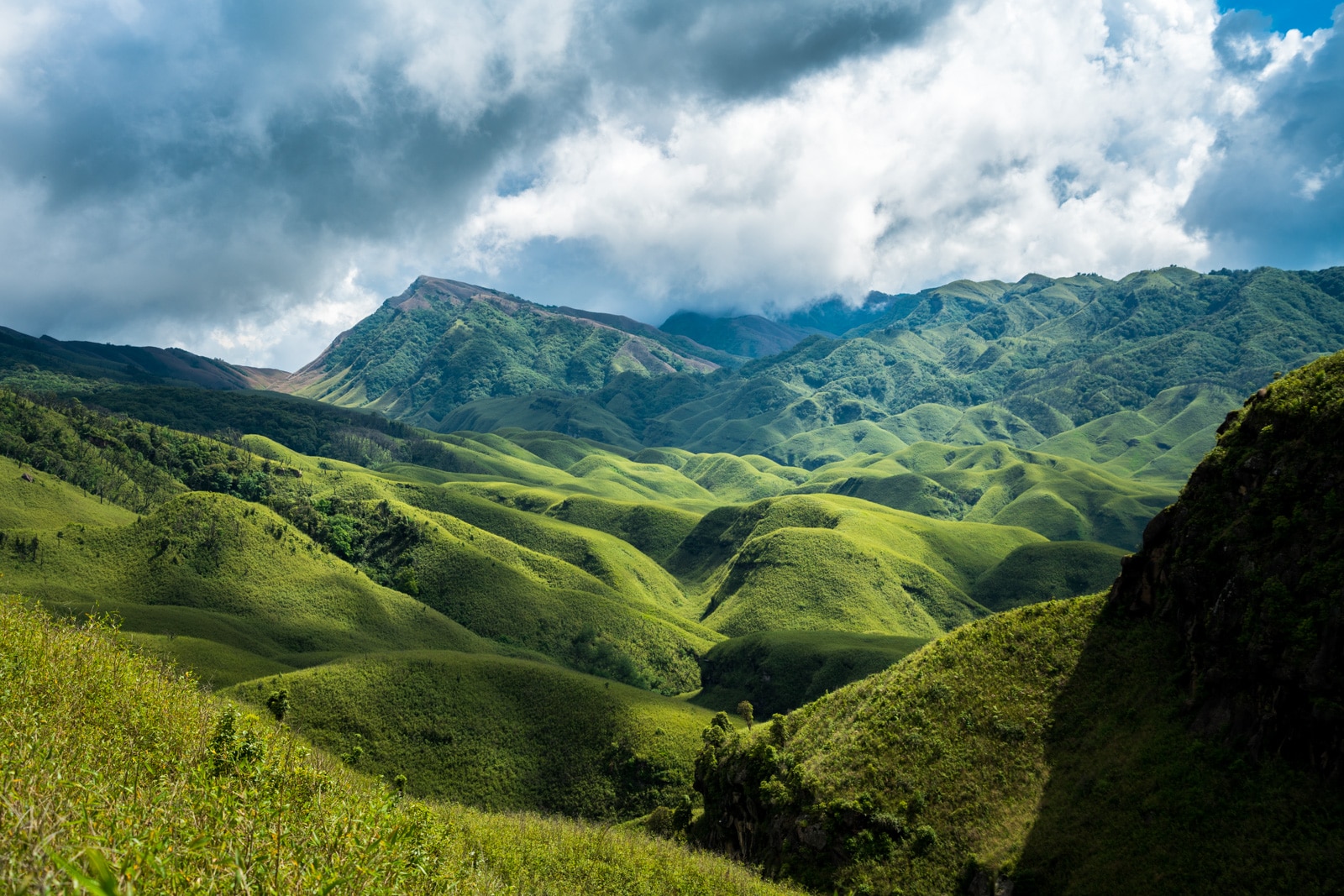
Rolling hills and flowers galore in Dzukou Valley, Nagaland
The rolling hills of Dzukou Valley, on the border of Nagaland and Manipur, are one of the highlights of India’s Northeast . Here’s some photographic proof, and a guide with everything you need to know about Dzukou Valley.
Dzukou Valley -sometimes spelled Dzükou Valley or Dzüko Valley- sits high amongst the clouds, at 2,452 meters above sea level, straddling the border of Nagaland and Manipur in northeast India.
In summer, vivid green hillocks pave the way for blue mountaintops, and bright flowers wave in the winds amongst the tall grasses. In winter, temperatures drop far lower than one would expect in such tropical states, and Dzukou Valley freezes, sometimes covered in white snow.
Below you can find some quick info on Dzukou Valley, some photos to inspire you to trek to Dzukou Valley, and practical information on visiting Dzukou Valley.

Even through the clouds, sunset at Dzukou is stunning
An introduction to Dzukou Valley
Dzukou Valley is most famous for its multicolored carpets of flowers that bloom in summer, most notably the Dzukou lily which is found only in Dzukou Valley.
The flowers begin to bloom with the monsoon season, and the first two weeks of July are usually peak flower season in Dzukou Valley. But if you can’t make it during flower time, we assure you, it’ll be gorgeous at any time of year, and it has much more to offer than colorful flora for saturated selfies.
It’s a beautiful place to hike around in itself, flowers or not, and if you’re into rock climbing there are plenty of opportunities to break a sweat within the valley. Even more interesting (to us, anyway) , Dzukou Valley is well-known and loved by local tourists from Nagaland and Manipur, but has yet to be “discovered” by foreigners and domestic tourists from further away. Come visit while you can, because India’s northeast is almost certainly going to experience a tourism boom in the coming years.
In case you need more convincing…
Feast your eyes on these photos of Dzukou Valley
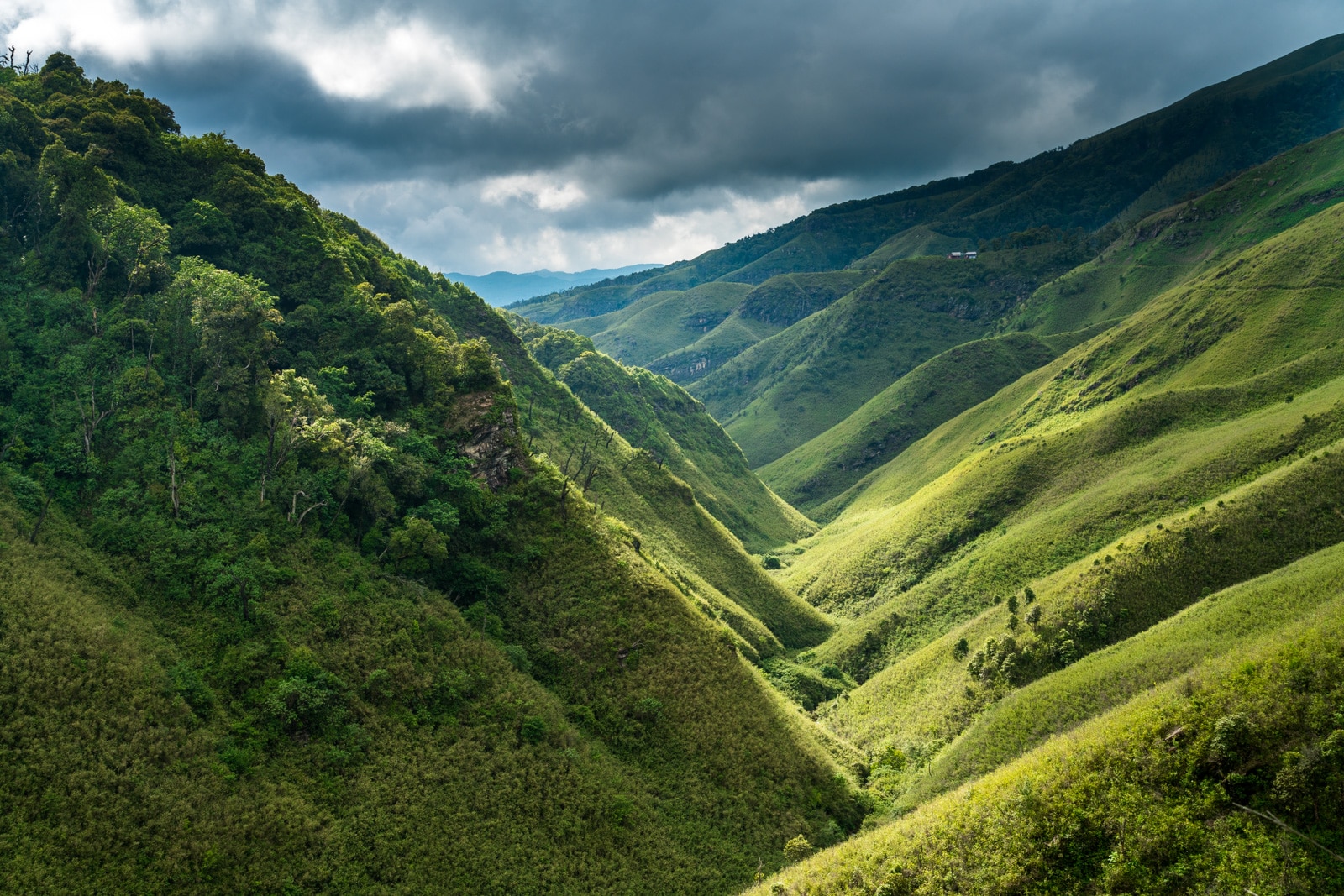
The path leading into Dzukou Valley
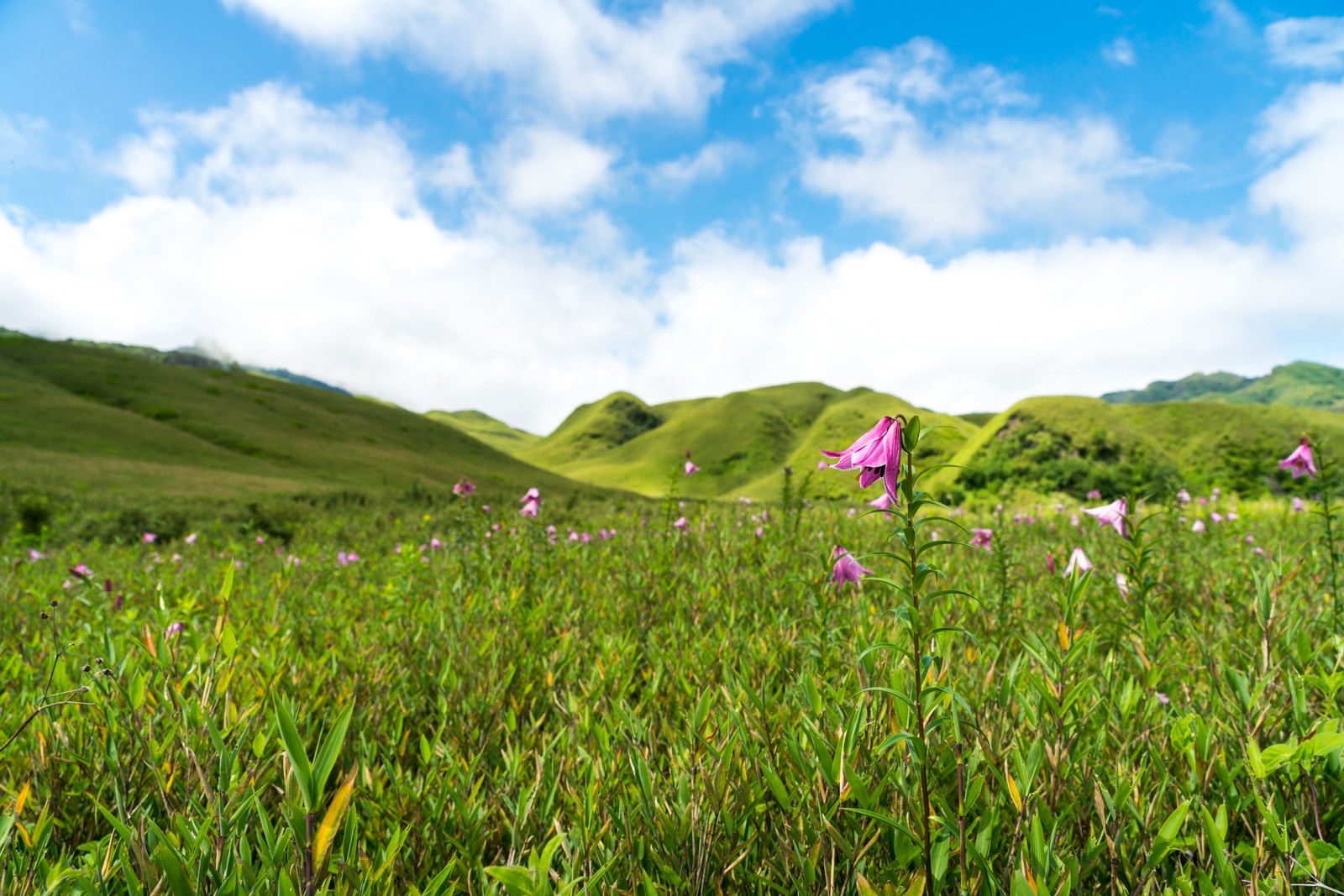
Dzukou lilies beginning to bloom in the valley
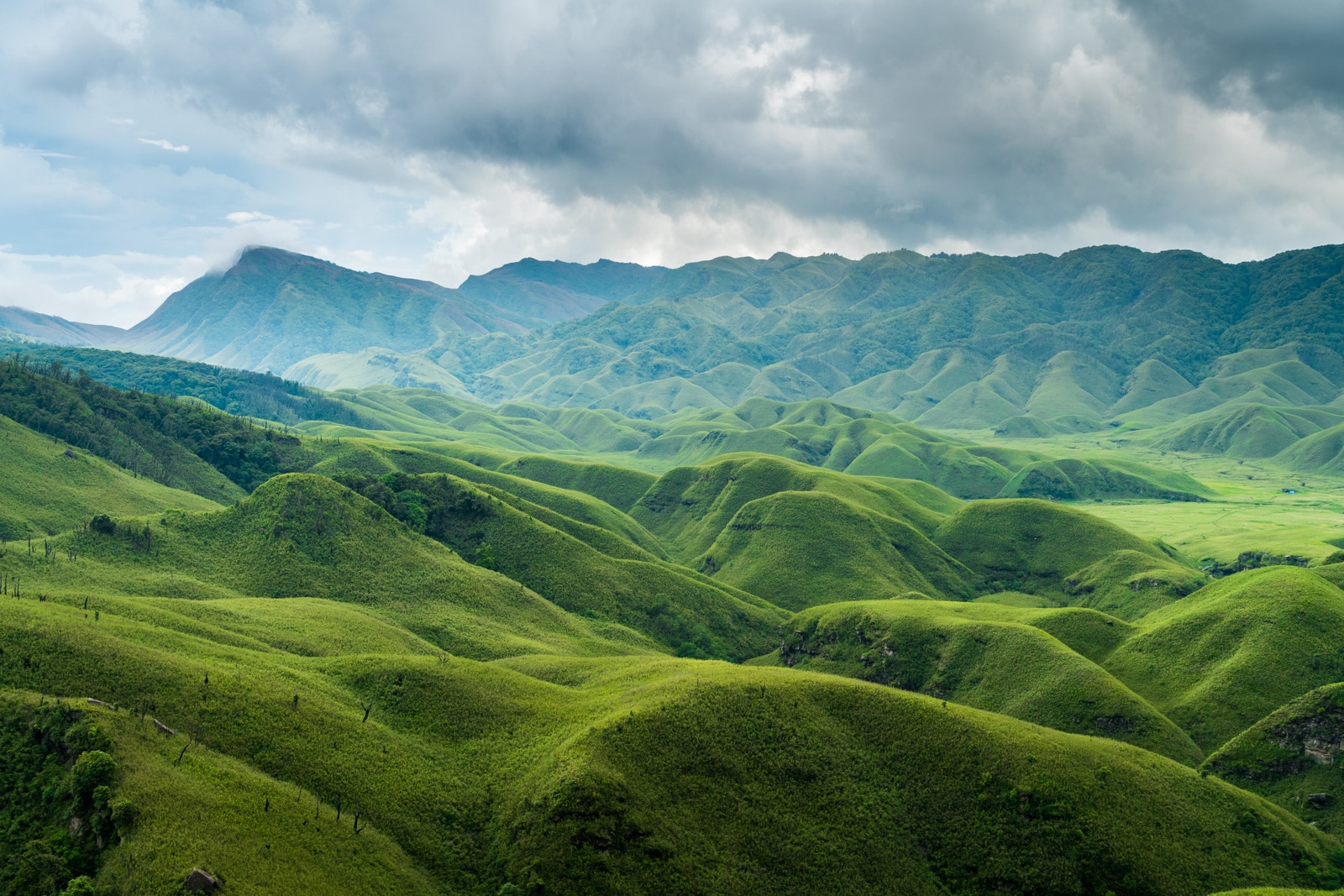
Typical cloudy Dzukou weather
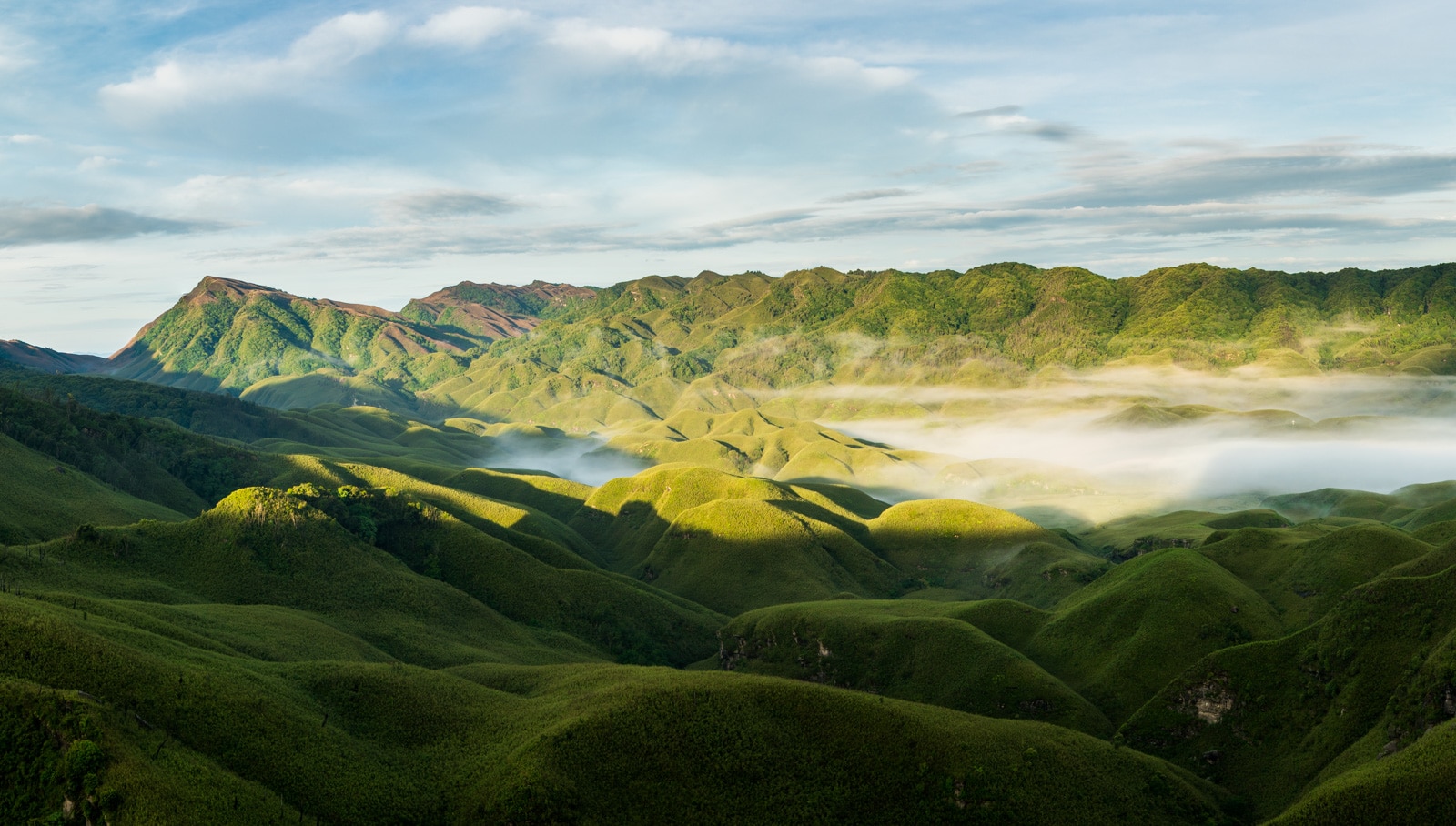
Early morning sun breaking over the valley
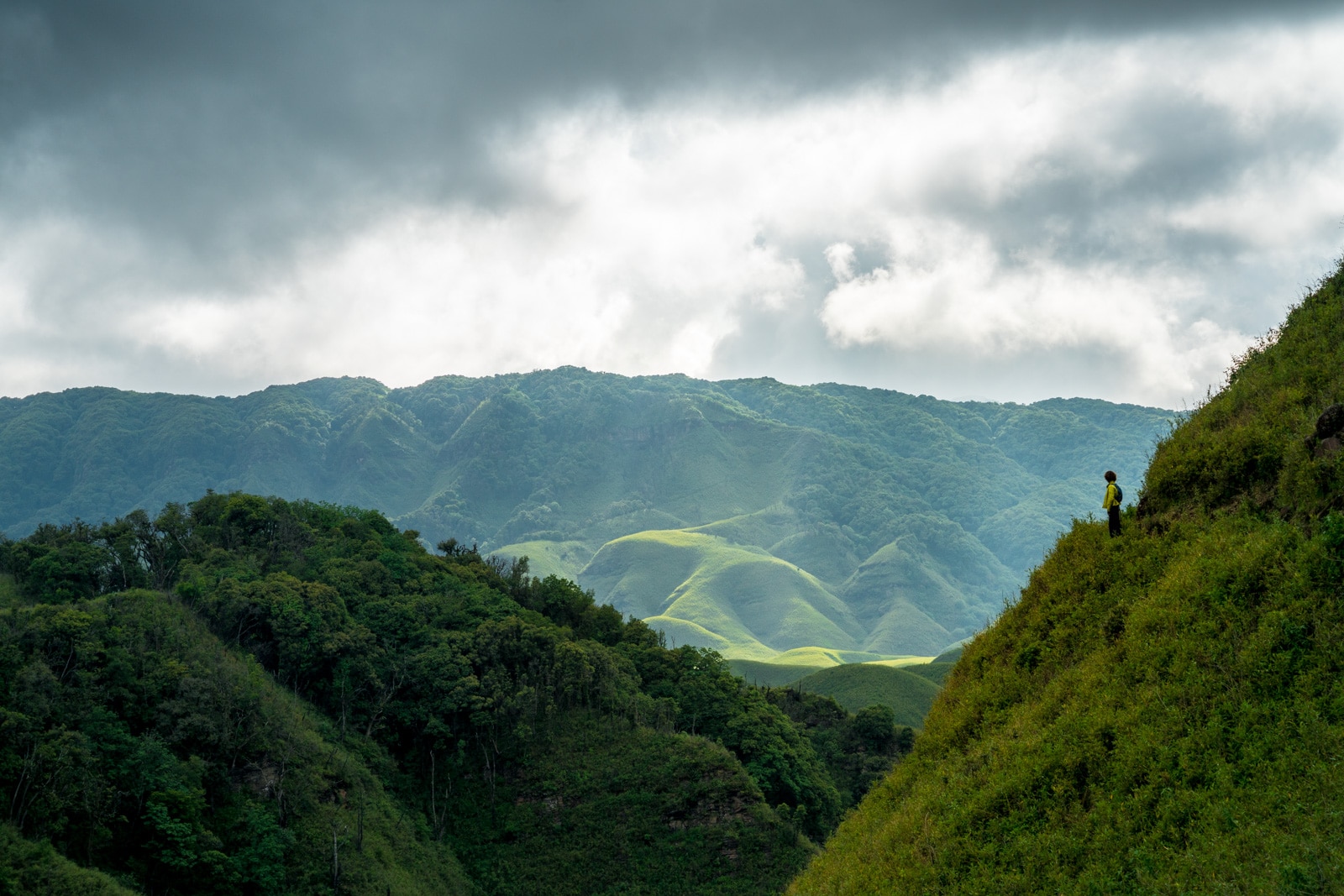
Wandering into the valley
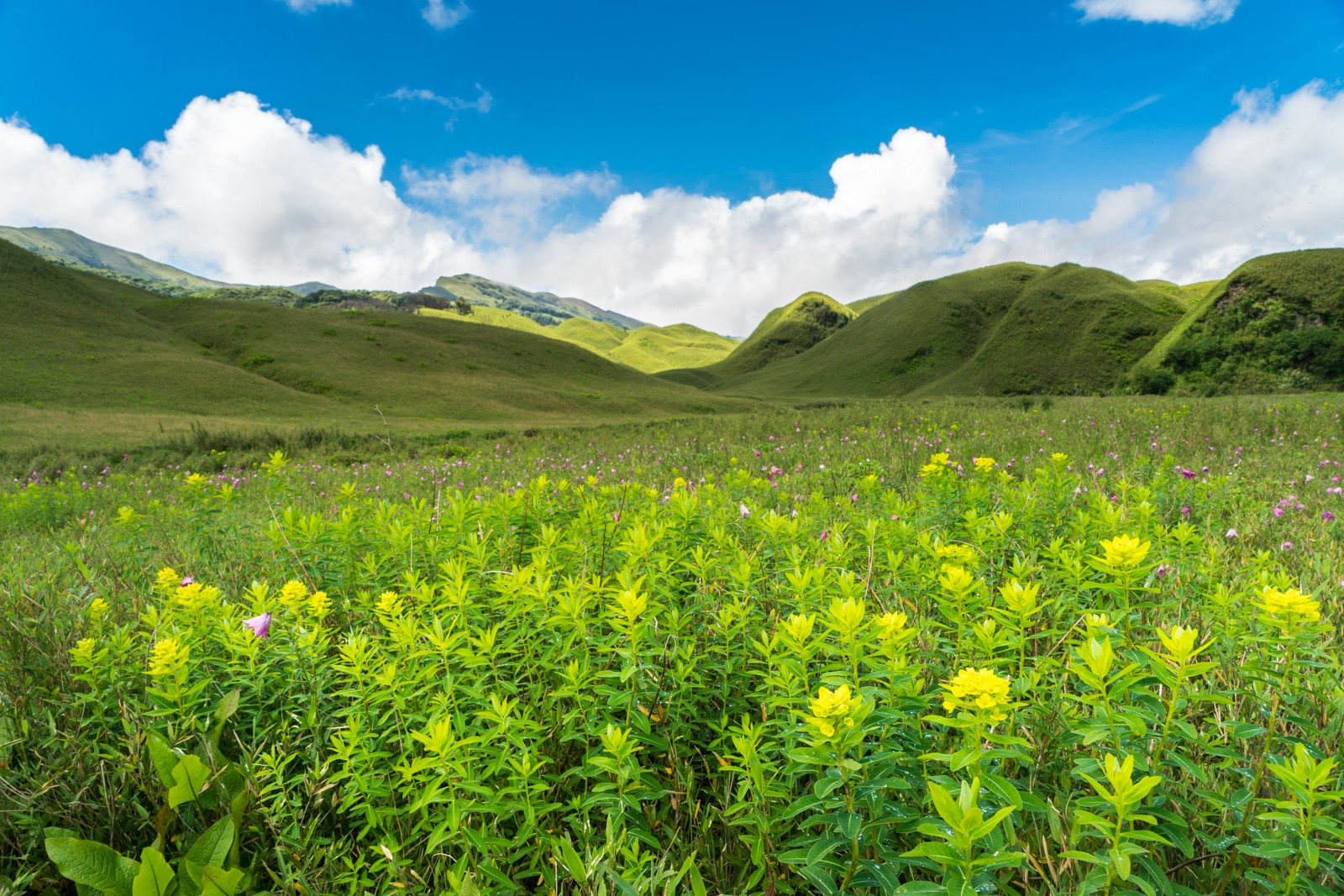
Yet more flowers a-blooming in the valley
Now that we’ve convinced you to visit (we have, haven’t we?) , it’s time to get down to business! Read on to learn everything you need to know to make your visit to Dzukou Valley a success.
How to get to Dzukou Valley from Nagaland
Although it’s possible to get to Dzukou Valley from Manipur, the main approach is from Nagaland. There are no amenities on the Manipur side, the trekking trail is much more strenuous, and roads to the valley are in poor condition. Most visitors from Manipur drive to the Nagaland side to enter the valley.
If you wish to approach from Manipur, make sure you have the proper equipment and a local guide who knows the way. This guide will focus on how to get to Dzukou Valley from Nagaland.
From Kohima , the laid-back capital of Nagaland, getting to Dzukou Valley is a relatively straightforward affair. The valley can be approached from two towns: Jakhama and Viswema. Jakhama (spelled Zakhama on Google Maps) is about 20 kilometers from Kohima and Viswema about 25 kilometers away from Kohima. Kohima itself is reached by bus. The nearest railhead to Kohima is in Dimapur.
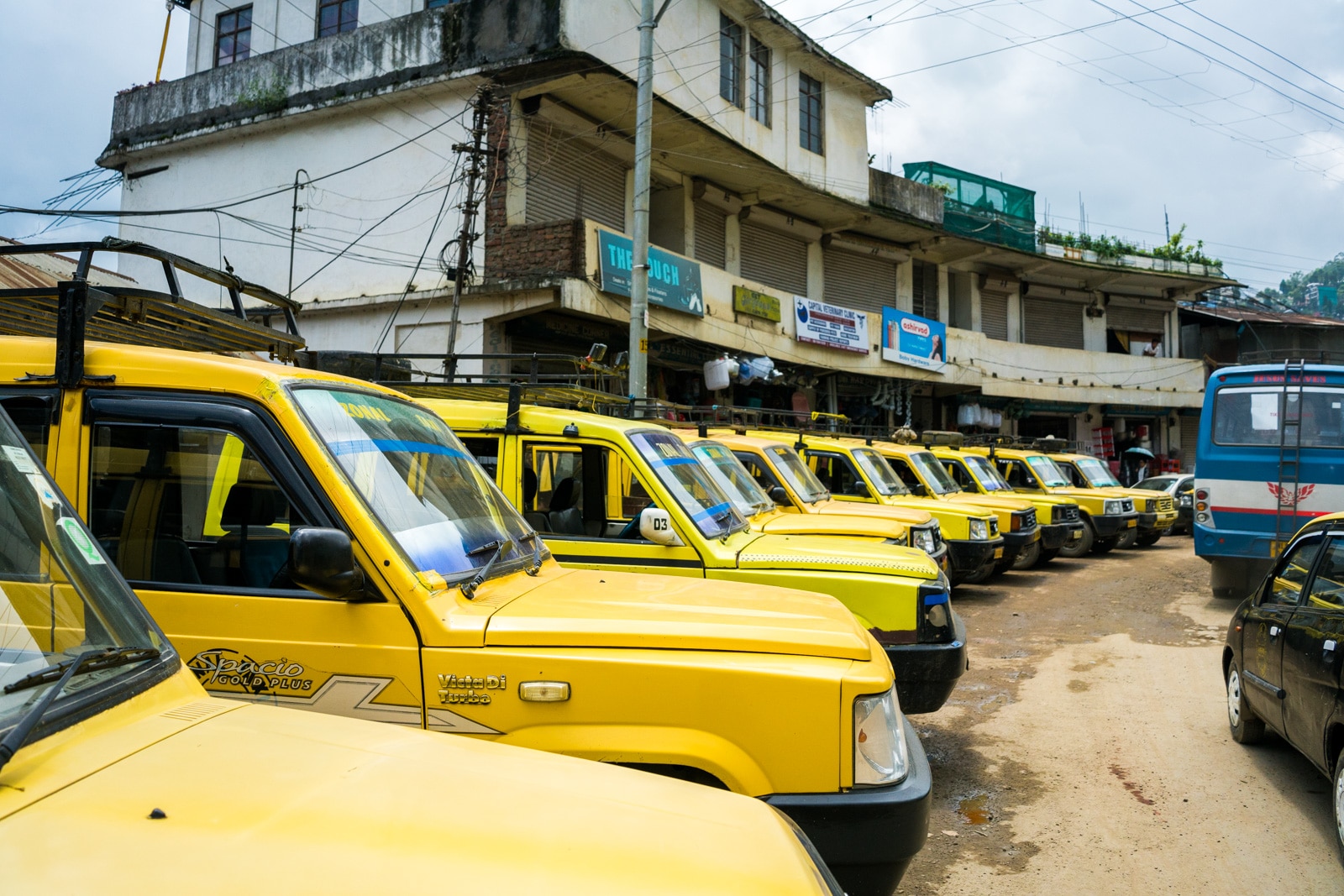
Shared taxis to Viswema
To get to either of these towns from Kohima, take a shared taxi from the Network Travels AOC Bus stand. There are several yellow vans and Sumos parked—just ask one of the men sitting around, and you’ll soon be pointed to the right vehicle. It costs 40 Rs per person to get to Jakhama, and 50 Rs per person to get to Viswema. The taxis leave when full, and it takes about 30 – 45 minutes to reach Viswema.
Heading to Nagaland? Make sure to check out the tribal village of Longwa , on the Myanmar border!
How to approach Dzukou Valley
The approach you should take depends on your fitness/masochist level. The trek from Jakhama to Dzukou Valley is more demanding but takes less time. The trek from Viswema to Dzukou Valley is more gradual but generally takes longer.
We recommend taking the Viswema approach entering the valley and exiting Dzukou Valley via the path to Jakhama.
As of World Environment Day 2019, Dzukou Valley is a plastic-free zone. This means you’ll have to pay a security fee if you’re carrying any polythene bags. You’ll get the security fee back when you leave and proof you’re still carrying your bags.
Getting to Dzukou Valley from Viswema
The Viswema approach starts with roughly 8 kilometers of motorable road. The road slopes up gently, and the walk takes around 3 hours. You can hire a taxi from the main highway to the end of the motorable road, but be prepared to pay 1,500 Rs for the ride.
Alternatively, you can try hitching a ride. There’s some construction going on at the end of the road, and the construction workers will probably let you jump on the back of their truck if they pass you. You could also walk to the trailhead, but this will take another hour or so.
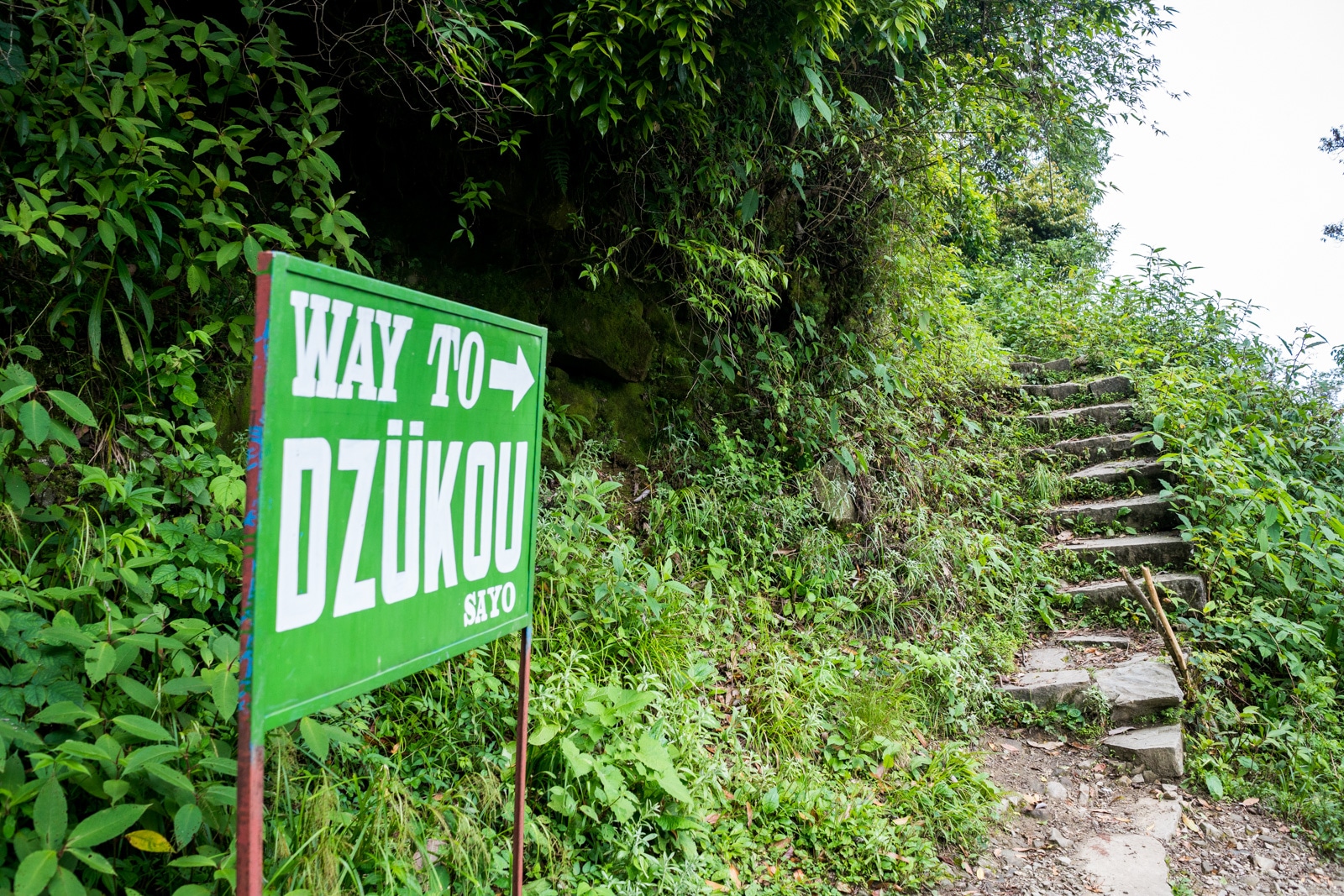
The start of the steep uphill climb on the Viswema approach
To get to the valley, follow the trail for about 45-minutes to an hour. The climb is steep and could be slippery depending on the weather, as there’s a lot of dirt/mud. Be careful!
Surprisingly, there are plenty of dustbins along the way. Make sure to use them to throw your trash out while walking.
After the steep climb to the top of the mountain, you’ll be in Dzukou Valley. From the beginning of the valley, it’s another pleasant two hours through the valley to reach the rest house. There is a little rest stop at the beginning of the valley trail where you could have a lunch break.
Getting to Dzukou Valley from Jakhama
The approach from Jakhama is much more demanding than the one from Viswema, and unless you’re into that sort of thing, we recommend you take this one down, not up. The steep path is lined with rough-hewn stone steps, which are much easier to walk down than the muddy trail up from Viswema. It took us about 3 hours to walk down from the valley to the main road on this path.
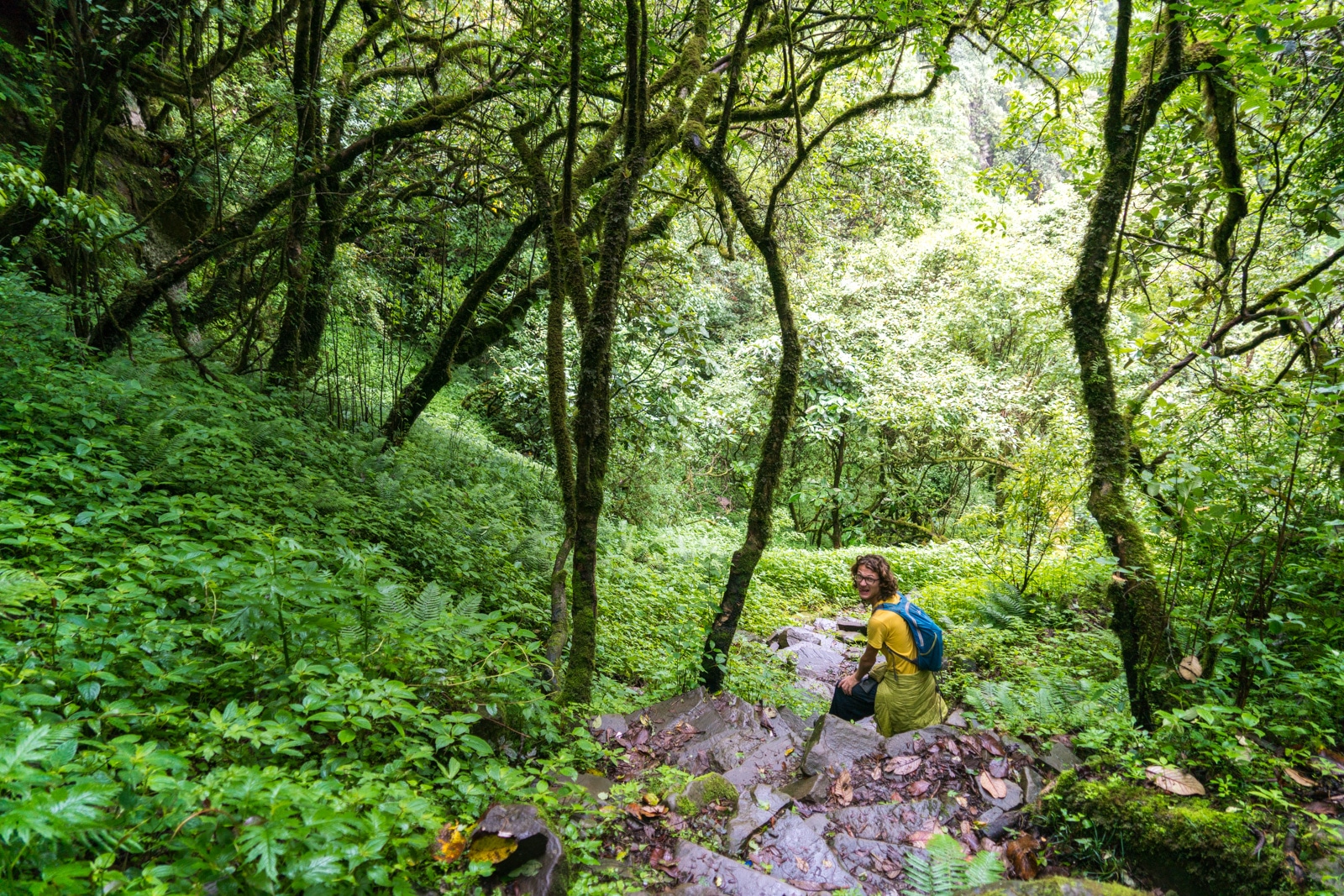
Wobbly legs on the long way down to Jakhama
If you’re heading upwards, from Jakhama there’s a motorable road for about 3-4 kilometers, after which your ascent starts. It’ll take at least 4 – 5 hours to walk up, and it’s a pretty steep affair. The steps are in good condition, though, and you’ll arrive very close to the rest house in the valley. The path eventually merges with the trail through the valley starting near Viswema.
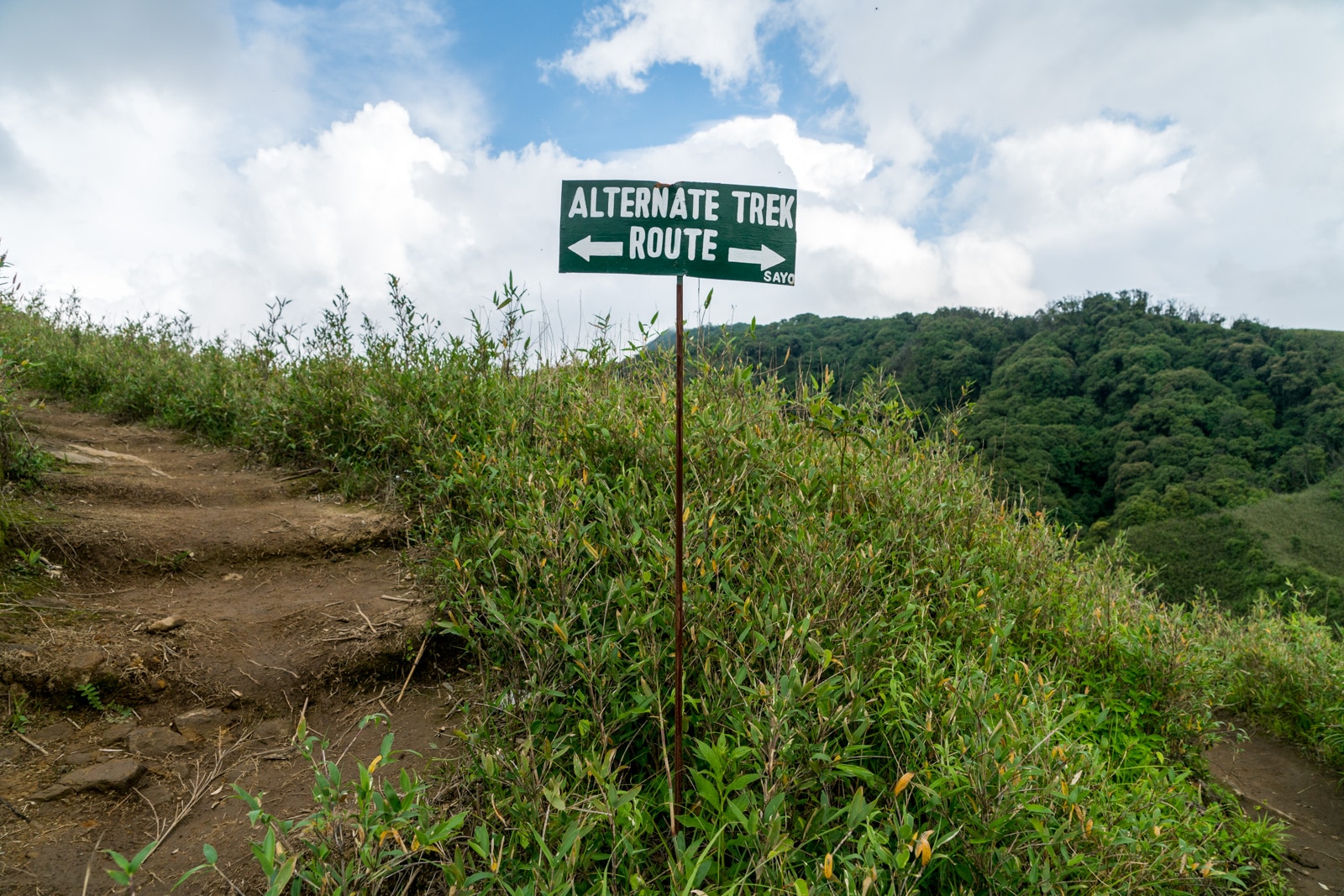
To the left is the path to Jakhama, to the right, Viswema
Cost of visiting Dzukou Valley
Entrance to the valley costs 20 Rs per person for people from surrounding villages, 50 Rs per person for other Indians, and 100 Rs per person for foreigners. Entrance fees are paid at the rest house, and you only need to pay once, not per day.
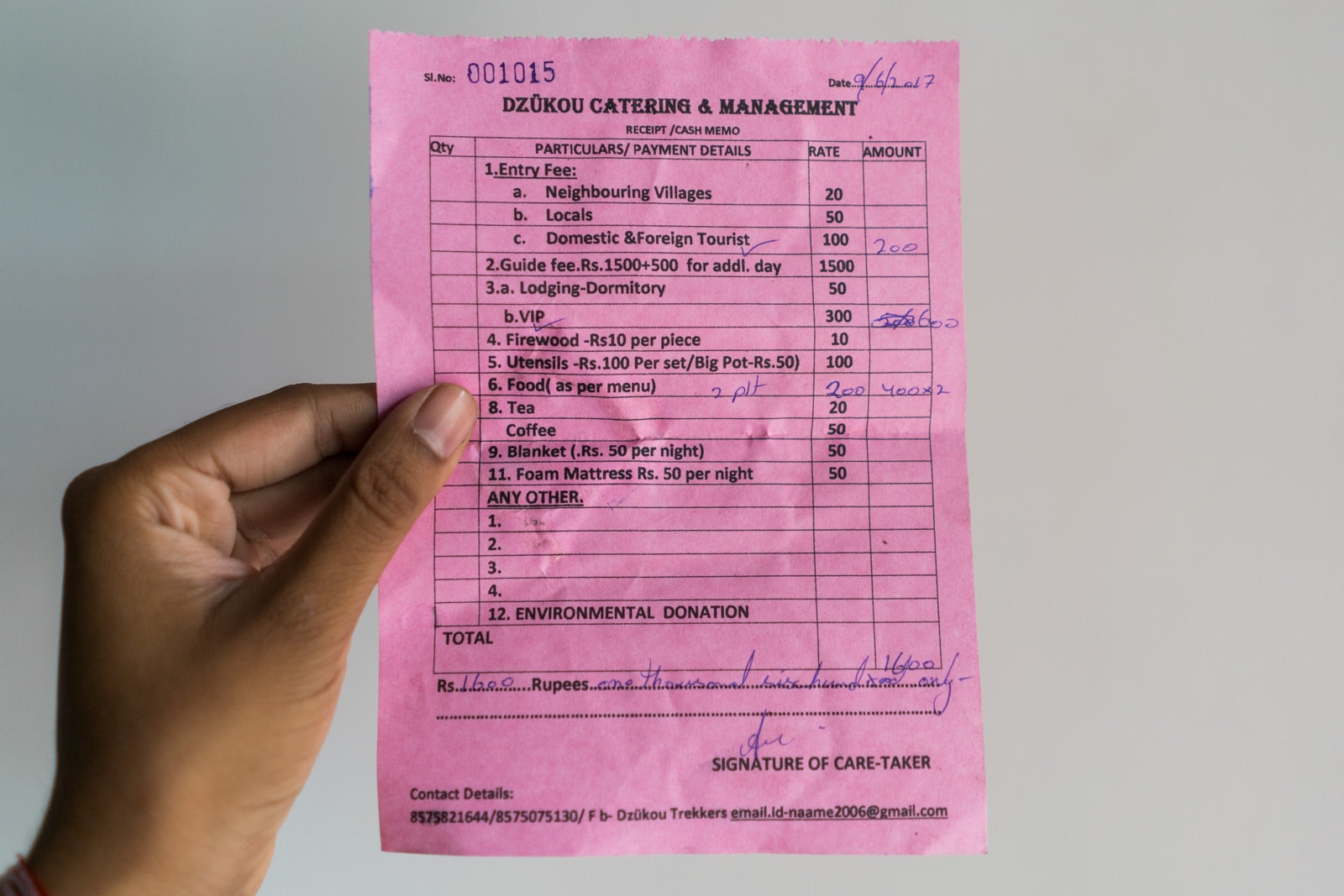
Price list for the Dzukou Valley rest house
Where to stay in Dzukou Valley
There is a basic rest house overlooking the valley, offering two refugee camp-like dorms and five private rooms with barebone amenities. Bring your own inflatable mattress, or you’ll regret your poor life choices.
The dorm costs 50 Rs per person , and private rooms are 300 Rs per room . Mattresses, blankets, and pillows are extra. Simple breakfast and dinner are also available.
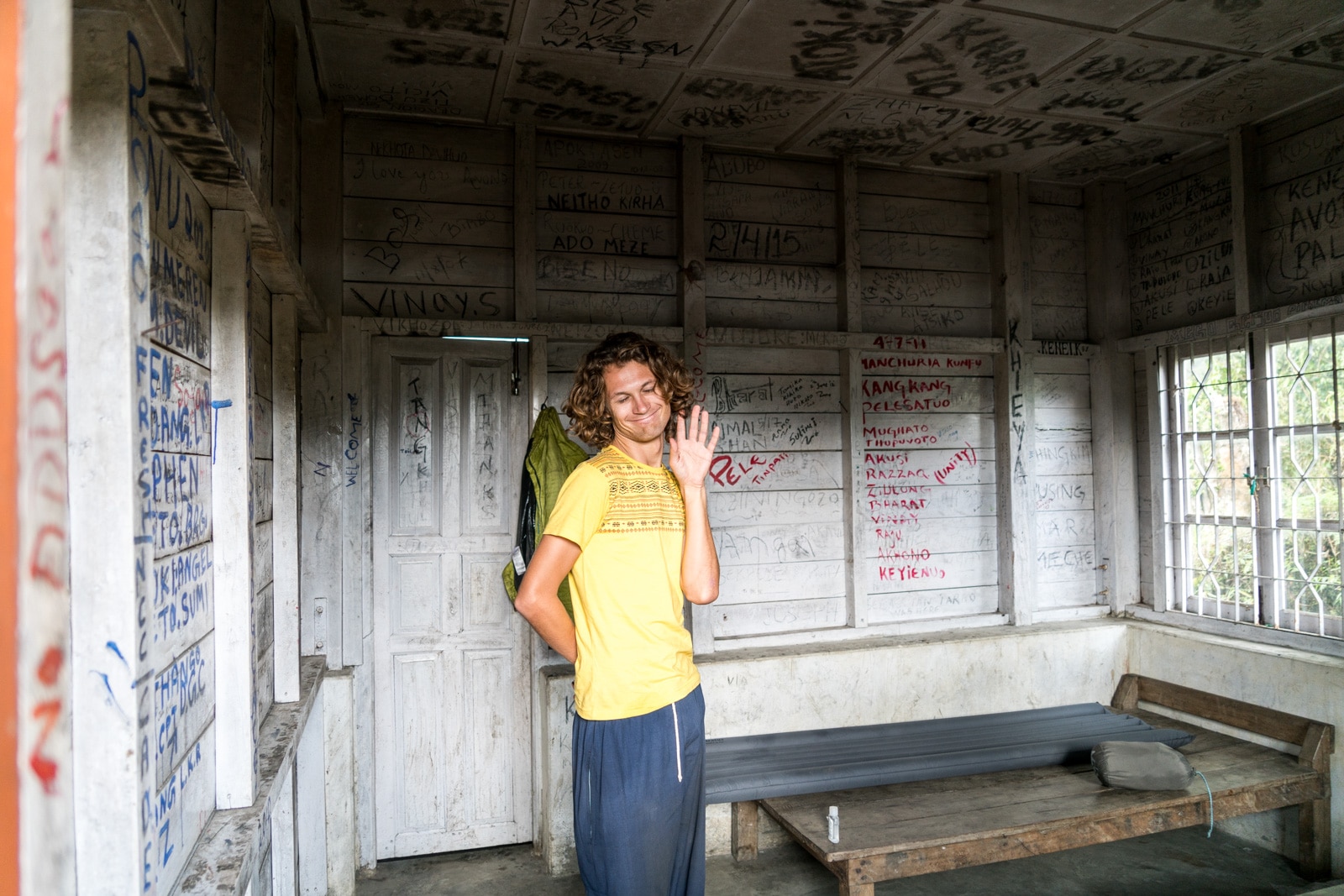
A “VIP” rest house room. We call it ~hiker chic~.
If you have the proper gear, Dzukou Valley is also a great place to camp. There are several natural campsites in the valley. The main site is smack in the middle of the valley, while the others are sheltered by small caves. You can camp virtually anywhere you want, however, as long as you pay the park entry fee. The valley is a popular camping spot for local tourists, and when we were there several groups has set up camps throughout the valley. If you ask nicely you can probably join such a camp if you want to.
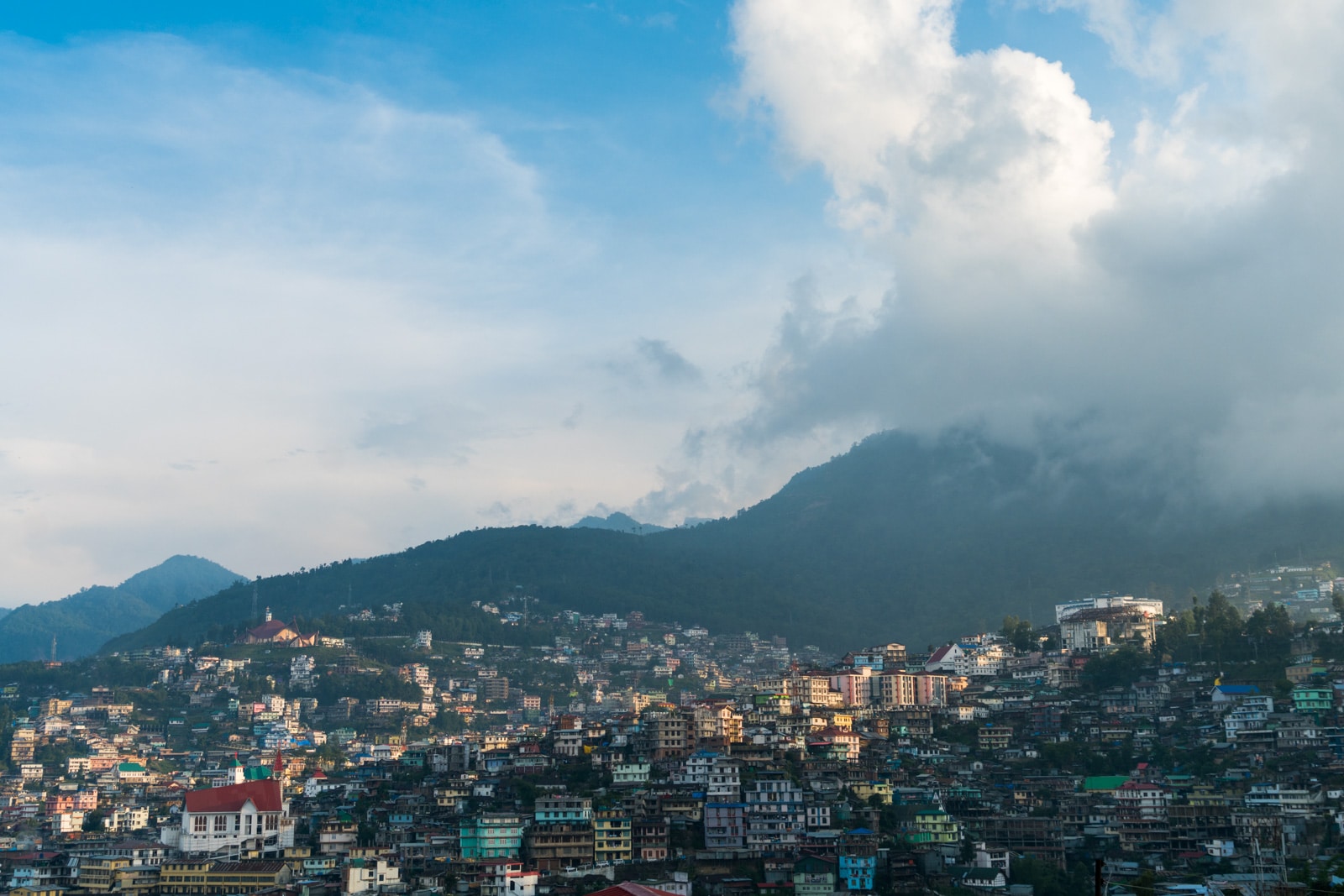
A sick view of Kohima from the balcony of Morung Lodge
Where to stay in Kohima
Kohima is a pleasant enough city to stay for a day or two before or after your visit to the Dzukou Valley. Unfortunately, super budget accommodation is hard to find.
Pine Hotel offers very basic rooms, starting at 1,000 Rs per night . A more pleasant—but also more expensive—option is the Morung Lodge homestay right next door. The interior is charming, Nino (the owner) is nice, and it boasts a 4/20 friendly atmosphere, but at 1,000 Rs per person for a dorm bed (including simple breakfast and dinner), it’s woefully overpriced. Still, it was a good and safe place to leave our extra luggage while hiking to Dzukou Valley.
What to do in Kohima
Kohima is the laidback capital of this hilly state, and you could do worse than exploring the bazaars and just walk around to experience the atmosphere. There are also several churches, and a war cemetery remembering the victims of the battle for Garrison Hill during the Second World War.
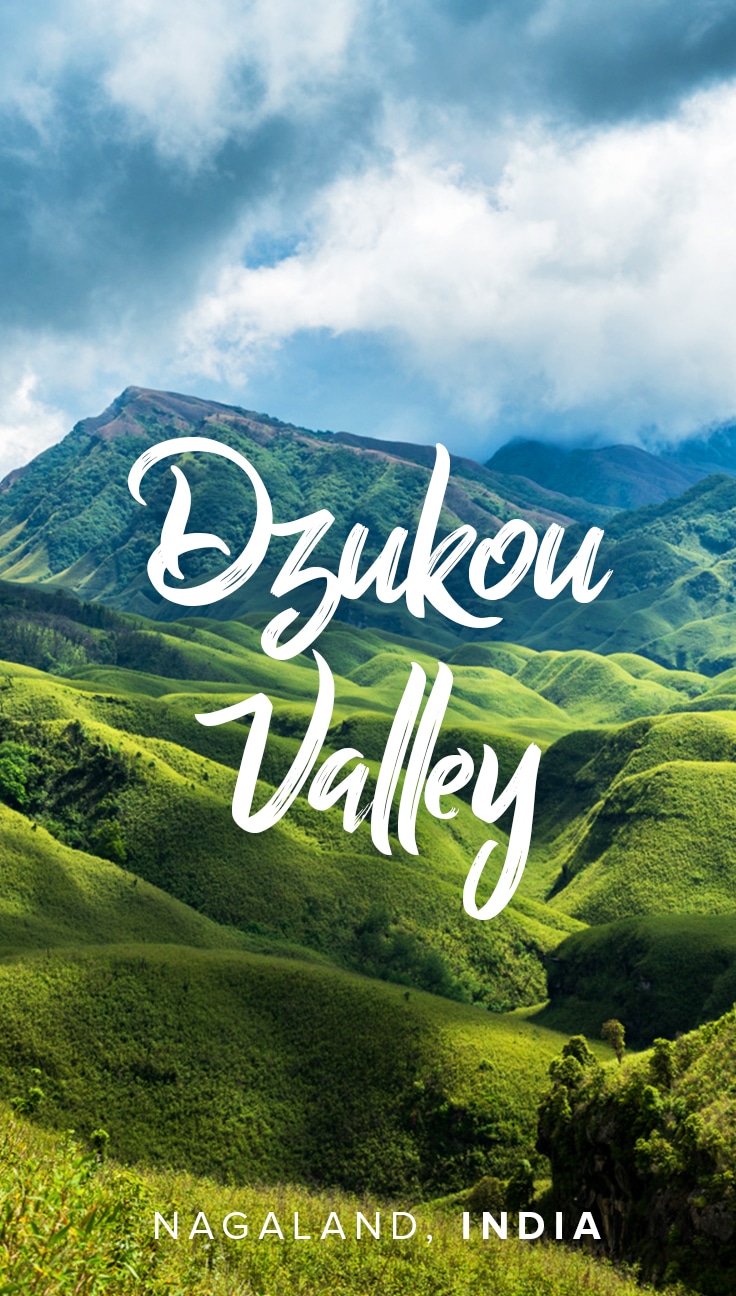
Useful? Pin it!
So there you have it, a quick guide on how to get to Dzukou Valley from Nagaland. Let us know in the comments if anything changes, or if you know a good place to stay in Kohima.
- Northeast India

Alex Reynolds
64 thoughts on “ rolling hills and flowers galore in dzukou valley, nagaland ”.
Hello there, I just wanna know about the paying Rs 1500 for the ride. Is it for the round trip or is it only one way.
How I’ll get tourist guide to dzuko valley
Leave a Reply Cancel reply
Your email address will not be published. Required fields are marked *

- Privacy Overview
- Strictly Necessary Cookies
This website uses cookies so that we can provide you with the best user experience possible. Cookie information is stored in your browser and performs functions such as recognising you when you return to our website and helping our team to understand which sections of the website you find most interesting and useful.
Strictly Necessary Cookie should be enabled at all times so that we can save your preferences for cookie settings.
If you disable this cookie, we will not be able to save your preferences. This means that every time you visit this website you will need to enable or disable cookies again.

Dzükou Valley Trek: Your Ultimate Guide To India’s Famous Hike
By Joydeep Phukan. This guide to Dzukou Valley trekking contains affiliate links to trusted partners!
Interested in doing the Dzükou Valley Trek ?
Then you’re in the right place!
You’ve likely heard of the famous hikes in India’s Himalayan region; but, have you heard of the Dzükou Valley Trek in Northeast India?
Sitting in the clouds at an altitude of 2,452 meters (8,000 feet) above sea level, the Dzükou Valley — also written as Dzukou Valley or Dziiko Valley — is located in the Indian state of Nagaland.
The administrative border between the states of Nagaland and Manipur passes through the valley; however, Dzükou Valley is only accessible from the Nagaland side.
Inhabited by 16 major ethnic groups and sub-groups, Nagaland is blessed with cultural diversity, mountains, and natural beauty, which is best explored by doing the popular Dzükou Valley Trek.
Interesting fact:
The term “Dzüko” is derived from the local Viswema dialect of the Angami Nagas and means “dull and soulless” — though don’t let this deter you from visiting for a hike. The name was given because the ancestors of Viswema village couldn’t cultivate crops or establish a settlement in the valley.
They were, however, still able to appreciate its extreme beauty. Dzükou Valley is covered in dwarf bamboo shrubs, with high hills surrounding uniform hillocks and a tranquil river flowing through the valley. Moreover, the views you’ll enjoy while hiking are truly spectacular.
Table of Contents
What Type Of Hiker Are You? [Free Quiz]
Now, before we dive further into how to hike the Dzükou Valley, I want to share a free personality quiz I think you’ll love!
Discover your hiking persona in this fun and short hiker personality quiz , which also shares trail suggestions based on your results.
Once you’ve grabbed the quiz, keep reading for an in-depth Dzukou Valley Trek Guide. This stunning hike is a must-do for outdoor enthusiasts visiting India !
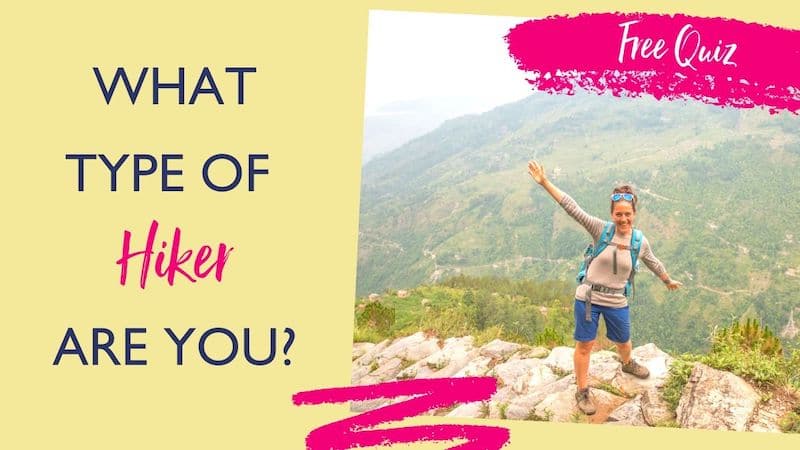
Dzükou Valley Trekking Map
Before hiking in the Dzükou Valley, it’s recommended to check out a map to get a lay of the land.
The below Dzükou Valley map offers a great starting point, or you can click here for the interactive Google Maps version .

Best Time To Do The Dzükou Valley Trek
In terms of the best month to visit Dzukou Valley, it’s truly a year-round destination.
In fact, monsoon season — May to August — is when the vibrant pink Dzükou Lily blooms. This flower is very special, as it can only be found in the Dzükou Valley. As it grows alongside other colorful flowers against lush green grasses, it creates a truly stunning scene.
On the other hand, during winter, the Dzükou Valley is covered by frost and receives snowfall, particularly towards the end of December until February. As long as you don’t mind the cold, this can be a lovely time to visit as you can take in frozen views of the valley.
How To Reach Dzukou Valley (Getting There)
The Dzükou Valley can be reached via two hiking trails; one from the Viswema Village and the other from Jakhama (also spelled Zakhama).
Hikers generally go through Viswema, as the Jakhama trail is much steeper. In fact, Viswema only has about one hour of uphill hiking vs Jakhama, which is a steep ascent almost the entire way. Remember, you can always go up the Viswema trail and down the Jakhama trail.
Viswema Village is about 14 miles (22 kilometers) and Jakhama is about 9 miles (15 kilometers) from Nagaland’s capital city of Kohima.
To reach Kohima, private cars, taxis, sumos (shared taxis), and buses regularly drive from Dimapur, which is home to the nearest regional airport. LGBI Airport in Guwahati (Assam) is the nearest International Airport.
By railway, the Dimapur Railway Station is well connected to other states. You can head to Kohima from the station by boarding public buses, private cars, and sumos. It takes around 2-2.5 hours to reach Kohima from Dimapur.
From Kohima, you can take a shared taxi from the Networks Travel AOS Bus Stop to reach either Viswema or Jakhama.
Important note:
Indian nationals must get an Inner Line Permit (ILP) to visit Nagaland. For foreign visitors, passports and visas are enough for entering Nagaland; however, they sometimes ask foreign tourists to register themselves at the nearest local police station upon their arrival to the state.
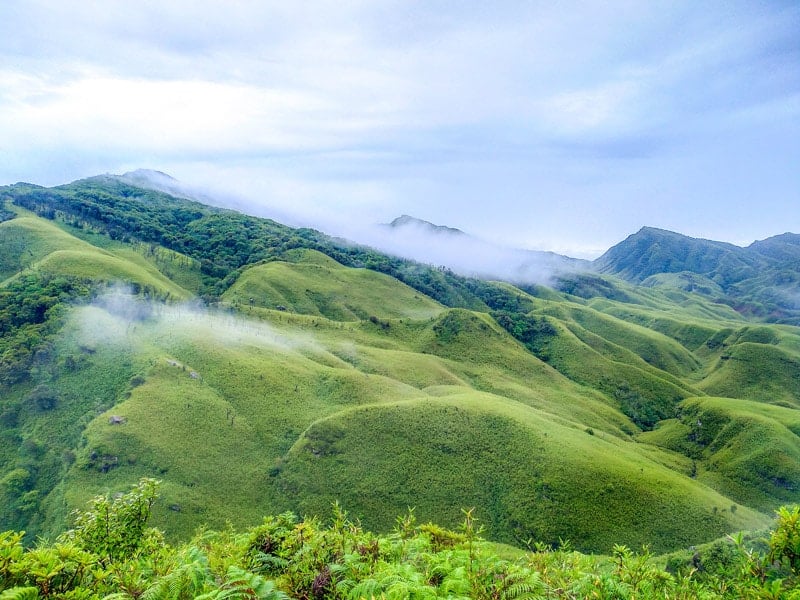
The Dzükou Valley Trek– Essential Information
Dzükou Valley Elevation: 2,452 meters (8,000 feet) above sea level.
Dzükou Valley Trek Elevation Gain : Viswema is 1,631 meters (5,351 feet) above sea level and Jakhama sits at 1,606 meters (5,269 feet). This means a hiker would gain about 821 meters (2,694 feet) when hiking from Viswema and about 846 meters (2,776 feet) when hiking from Jakhama.
Dzükou Valley Trek Difficulty: Moderate (from Viswema) and difficult (from Jakhama).
Dzükou Valley Trek Duration: The minimum time to reach the Dzukou Valley Guest House — which is the end point of the trek — is about 4-to-5 hours from both villages. The Dzukou Valley Trek distance distance via Viswema is approximately 13 kilometers (8 miles) and 10 kilometers (6 miles) via the Jakhama trail.
Dzükou Valley Trek Location : Kohima District, Nagaland.
Dzükou Valley Trek Trailhead: The best part of hiking to Dzukou Valley is plenty of signage along the way!
- The trailhead at Jakhama starts from the main road near a bridge by the river — a little ahead of the sumo stand of Jakhama. Click here for a Google map .
- At Viswema, the hiker has to first reach the “Trekker’s Point”, which is about 8-9 kilometers (5-5.6 miles) from the village. The actual trail starts from the Trekker’s Point. Click here for a Google map .
Other Nearby Hikes: When in Nagaland, also don’t miss Mt. Saramati and the Japfu Peak Trek .
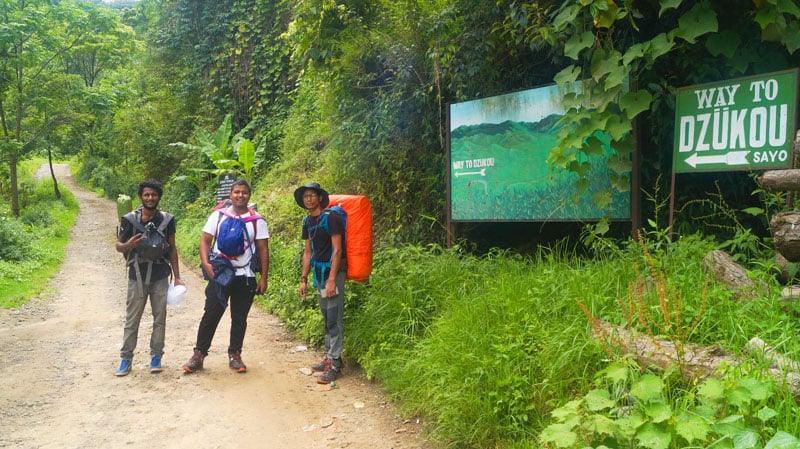
Dzükou Valley Trek Step-By-Step Guide
Ready to embark on one of the world’s best hikes ? Let’s do this!
Dzükou Valley Trek via Viswema
From Viswema, one can walk 8 kilometers (5 miles) along drivable road or hire a taxi outside the village gate for about 1000-1500 INR (~$14-$20 USD). While walking can save you money, it also expends quite a lot of energy and adds about 2-3 hours to your hiking time.
Once the road ends, you’ll reach the “Trekker’s Point” — which is when it’s time to hike.
The trek begins with a steep 4-kilometer (2.5-mile) climb up rough-hewn stone steps through forest. This section takes about 45 minutes to an hour.
Note that depending on the weather, this section can be muddy and slippery, so make sure you bring the proper hiking attire .
Keep trekking until you reach the top of Viswema Hill, which is when you officially reach the Dzükou Valley. Spend some time here admiring the breathtaking views over the valley.
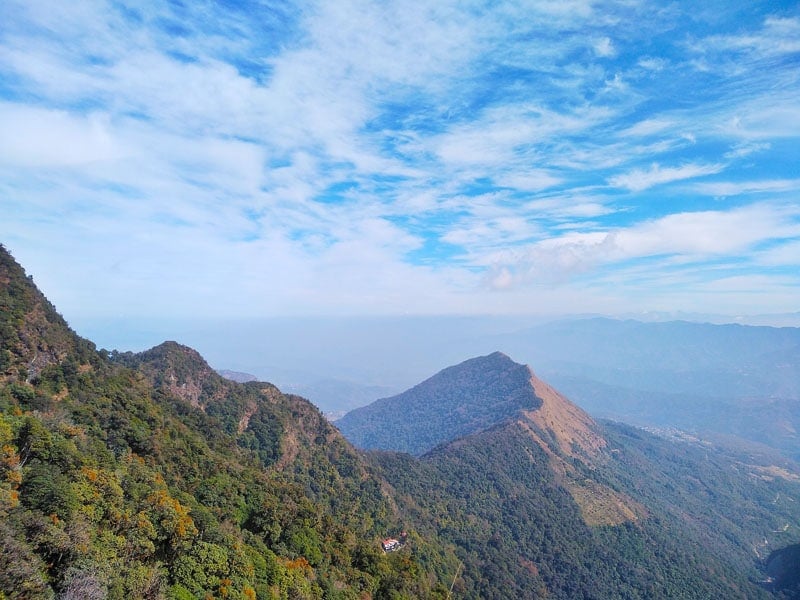
Along with being beautiful, this is also where the steep section ends and where you’ll be faced with two trails. The one to the left goes to Mt. Tempfu, while the trail to the right leads you to deeper into the Dzükou Valley.
Head right and enjoy the scenery, as the rest of the trail — which is another 4 kilometers (2.5 miles) — is relatively flat. You’ll zig-zag along the valley slope and cross lovely little streams until you reach the Dzukou Valley Guest House.
Dzükou Valley Trek via Jakhama
Your other option is to hike from Jakhama, which is the more demanding of the two options, but it takes less time. Also note that during monsoon season, this trail may be extra slippery, so make sure to have proper footwear.
The trail begins at the bridge near the main road of Jakhama village.
Personally, I hiked right from the sumo transport stand in Jakhama. From the sumo stand, you can ask the driver to drop you 4 kilometers (~2.5 miles) ahead at the small rest house constructed by the Kohima Forest Division.
Hiking a little ahead, you will see local farms and farmer huts, which is where the road ends. From here, you’ll cross another river and begin the super steep trail through dense forest.
It is a painful straight ascent, with stone steps bringing you higher and higher until you reach the top of Jakhama Hill, which takes about 3-4 hours.
From here, you can enjoy a lovely view of the Dzükou Valley, the Viswema Trail, and the Watch Tower of the valley. The Watch Tower is of particular note, as it offers a true panoramic view of the Dzükou Valley and the villages below. It can accessed from near the Dzukou Valley Guest House.
After descending the hill, the Viswema Trail and Jakhama Trail merge. Turn right and you will immediately be able to see the Dzukou Valley Guest House. It is a flat stretch of just 2 kilometers (1.2 miles) to the accommodation.
Staying At The Dzukou Valley Guest House
The Southern Angami Youth Association (SAYO) maintains the Dzukou Valley Guest House.
There are two houses, which they refer to as dormitories. One has a wooden floor while the other is concrete. Hikers sleep on the floor in these dorms, and the guest house caretakers provide blankets, mats, and other sleeping accessories.
Once you reach the guest house, you will need to pay an entrance fee for hiking the Dzükou Valley as well as for accommodation, meals, and sleeping accessories.
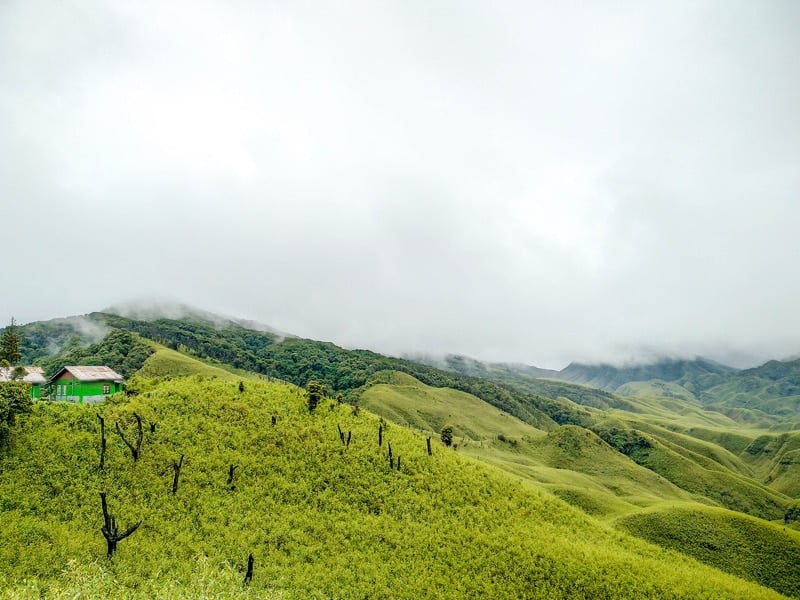
The guest house kitchen offers both vegetarian and non-vegetarian meals once a day. You can eat noodles (non-vegetarian) on other occasions.
A makeshift kitchen can also be rented if you want to cook for yourself, though you’ll need to buy firewood and rent utensils from the guest house.
There is also a small shopping stall at the campsite offering sweets, biscuits, and noodles, among other things.
A toilet/bathroom is available for public use.
SAYO also offers a cottage secluded from the main campsite area. It costs more than the dorms but has an attached bathroom.
Moreover, there is a campsite with space for pitching your own tent or you can rent a tent from the guest house.
In the summer months, water is readily available at the campsite in a reservoir connected to the stream. In winters, however, you have to collect water from a stream about 5 minutes away from the campsite for drinking and flushing the toilet.
Dzükou Valley Trekking Tips
Now that you know what hiking the Dzükou Valley is like, let’s go over some essential tips. The below advice will really help you have the best Dzukou Valley trip possible.
-Most people hike the whole day and stay at the guest house for only a night; however, to really experience the serene beauty of the valley, I would suggest you to stay at least 2-3 days. You may hike down into Dzükou Valley, visit the Watch Tower for a panoramic view, and swim in a river. Furthermore, you can hire a local guide to take you to lesser-known caves, natural pools, and waterfalls.
-Since there are two trail options, why not do both? Many people opt to hike the easier trail from Viswema to get to the guest house and then return via the steep Jakhama route, which is much easier on the way down, especially with its stone steps.
-Riverside camping has been banned due to littering. Therefore, the Dzukou Valley Guest House is where you can stay in the valley.
-There is no electricity in the valley, so make sure to carry a power bank and headlamp. Moreover, charge your phone and camera battery fully before setting off on the Dzükou Valley Trek.
– Traveling solo ? You can totally do the Dzükou Valley Trek on your own! Plus, the Dzükou Valley is an incredible destination for solo female travel in India . That being said, a local guide will help you from getting lost, can enlighten you about local Naga traditions, and can share interesting folklore stories associated with the valley. Bonus: by hiring a local guide, you’re supporting the local economy.
-You won’t find any shops for snacks or eateries along the trail. Though you will find a few streams for collecting clean drinking water, it is always advisable to carry a good amount of drinking water and dry fruits to eat during the hike.
-Since the trek time is about 4-5 hours from either of the villages, it is suggested that you start early in the morning. Arriving to the guest house in the evening can sometimes mean there aren’t any rooms or campsite spots left.
-While blankets are available at the guest house, if possible, it’s wise to bring a high-quality sleeping bag and accessories . This is especially true during the cold winter months.
-There is no network connectivity in the Dzükou Valley. If you want to call your loved ones, you have to climb to the peak of the hill where the Watch Tower is.
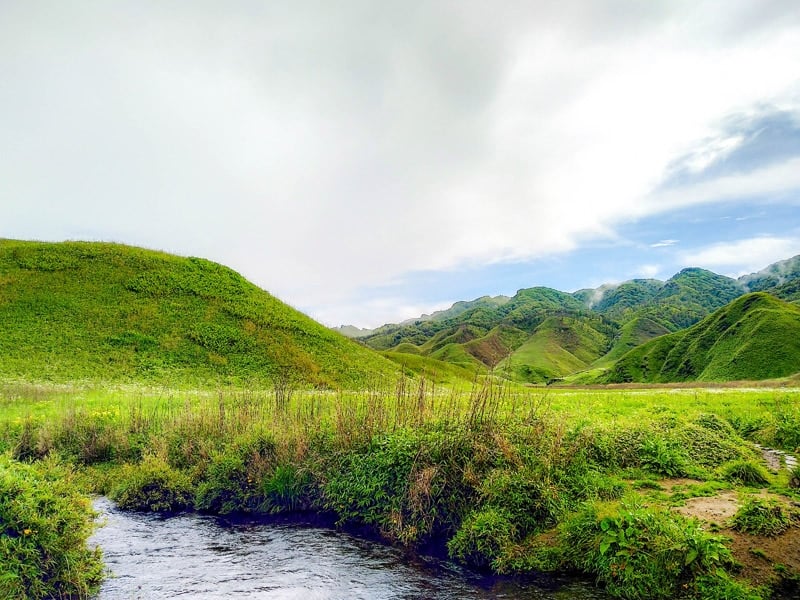
What To Pack For The Dzükou Valley Trek
If you are visiting the Dzükou Valley during monsoon season in the summer, there is a higher chance of rain. Therefore, a poncho or raincoat and rain cover (for your backpack) is a must.
You must also wear shoes with good grips, as the trails become slippery.
As far as clothing is concerned, hikers should bring a lightweight jacket, thermals, stretchable hiking pants, t-shirts, socks, and gloves. Bring an extra set of clothes if you plan to spend time swimming.
Wearing sweatshirts or T-shirts during the day is sufficient, but it gets very cold at night.
Moreover, during winter, it’s extra important to carry a quality sleeping bag. You’ll also want to bring some extra layers and potentially an extra jacket for additional insulation.
You can purchase all of your hiking clothing and camping gear at REI here .
Dzükou Valley Trek Cost
In terms of the Dzukou Valley trip cost, registration for the hike costs 100 INR (~$1.34 USD), while accommodation costs:
- 1500 INR (~$20.15 USD) for a room in the cottage with attached bathroom
- 100 INR (~$1.34) for a dormitory space or campsite
Now, if you’re curious what the approximate costs are for your entire round-trip from Guwahati in Assam (where the international airport is located), you’ll likely spend about 4,000 INR to 6,000 INR (~$54-$81 USD). This includes trains, transport, accommodation, food, and guide.
Travel Insurance For Your Dzukou Valley Trip
When visiting India — or anywhere else in the world — it’s wise to get travel insurance.
One of the best travel medical insurance for travelers is SafetyWing as they’ve got a large network and offer both short-term and long-term coverage — including coverage if you’re traveling for months as well as limited coverage in your home country).
Additionally, SafetyWing is budget-friendly and offers $250,000 worth of coverage with just one low overall deductible of $250.
Click here to price out travel insurance for your trip in just a few clicks .
Have you ever done the Dzükou Valley Trek ?
About The Author
Joydeep Phukan is the founder of the blog The Gypsy Chiring . He shares his stories and tips on travel, adventure, food, and culture from places around the world — but primarily covers Northeast India. He intends to promote the lesser-known cultures and offbeat destinations of Northeast India. Connect with him on Instagram , Facebook , Twitter , and Pinterest to explore Northeast India together.
Enjoyed this Dzukou Valley Trek blog post? Pin it for later!
Related posts:

Hi, I’m Jessie on a journey!
I'm a conscious solo traveler on a mission to take you beyond the guidebook to inspire you to live your best life through travel. Come join me!
Want to live your best life through travel?
Subscribe for FREE access to my library of fun blogging worksheets and learn how to get paid to travel more!

Turn Your Travel Blog Into A Profitable Business
Subscribe to my email list to snag instant access to my library of workbooks, checklists, tutorials and other resources to help you earn more money -- and have more fun -- blogging. Oh, and it's totally FREE! :) // Privacy Policy .
Check your inbox for your welcome email + resource library password!
Hello there, I just wanna ask about hiring a taxi to reach the trekker’s point. It cost 1500 INR for the taxi. Is that for the round trip or do we have to pay another 1500 INR to reach the Viswema village gate from the Trekker’s piont. IF its for the round trip, then does the taxi wait or do we call for it to pick us up. Answering this would be very helpful. Thank you.
It’s not a round trip. You have to pay again. The fare has recently been increased too. It is 2200 INR just for taking you up till the trekker’s point. And yes , you have to call the driver once you get network near at the top of the Viswema hill or a little below. The alternate choice is to hike right from the main road via Viswema or trek through the Jakhama trail.
Thank you….. you have been very helpful. I just needed this information to complete my plans. Thank you again.
Great article. I think a lot of it can be summed up by the simple rule of respect for persons and respect for land i.e treating others as you would like to be treated…this usually works for me. Obviously that’s oversimplifying it a bit… 🙂
Idk why I’m googling Dzukou Valley today but I got nostalgic… back when I visited Nagaland in 2015 there was little to no information about the region online 😀 it’s cool to see more now. I visited a friend (made unexpectedly over a facebook bug lol) in Chedema Village and we made a 3day trek to Dzukou (took the Jakhama route and itttt was toughhhh). It was mid August and it was super weird but we got nice weather until we were almost completely descended. Sad to hear the riverside camping is forbidden now, it was nice to sleep under the slanted rock outside 😀 but littering is a big problem and was really sad to see all over the region. I was barely 18 and never had travelled out of europe so arriving in New Delhi and taking a 36hr train to Dimapur was a huge culture shock xD but reaching the mountain village was such a relief. The Naga people in the village were so welcoming and curious.. I really loved staying there 🙂 ..uhh yea so thanks for helping me indulge in reminiscences ~
Yay! Glad to know that the article helped you reminisce your beautiful memories of Dzukou Valley. It would be great to meet you in person. Do plan again, I would be happy to help. Are you aware of the Hornbill Festival of Nagaland? Here, all the 16 major Naga ethnic groups showcase their culture. You would love to attend it. It is conducted every year from December 1st to December 10th.
Leave a Comment Cancel Reply

Dzukou Valley Trek, Nagaland
Dzukou Valley in Nagaland is probably the most famous trek in entire Northeast India nowadays and there is a good reason for it. It was not that famous till at least 2015 and mostly locals used to visit it. However, a place like this could not have remained hidden for a long time in the information age. So, the pictures of those iconic rolling hills started flooding the social media with a few years, it became one of the most sought-after destinations. Proximity to the venue of the popular Hornbill Festival also made it more popular.
Nevertheless, my experience with this valley has been more complex than it should have been (Although later on I did it again with ease but my initial attempt ended with a failure). I am not sure how to describe or explain this. It is a short and easy trek that everyone else seems to have done with consummate ease. But for me, it took two attempts, and even after that, I barely made it to the entry point of the valley and could not really explore it in a way it deserved. Only during my 3rd attempt I managed to do a satisfactory exploration. I wanted to call this post “two and a half failures” but people have complained about too much negativity in my tone in the past. So, let me just cut the self-loathing and have a look at Dzukou through these three trips, one failure, one half-success, and one success.
Dzukou Valley Trek: Failed Attempt (September 2017): A Night at the Jungle Hut
As my regular readers know, I started this blog with a trek to the Valley of Flowers in Uttarakhand in 2010. Since then, I have had a fascination of such areas, desolated high altitude valleys, that can be reached only after a trek. I have known about Dzukou since then but I never managed to make it due to my base in Delhi and excessive focus on Himachal.
Nevertheless, I arrived in Kohima with a lot of expectations this September. While rains are always to be expected in the northeast, this year, it had rained even more than usual. I initially planned it in August but gave up due to the same reason. Ideally, September is too late for the wildflowers but considering the rains, I expected them to remain. I knew it will still rain but I expected it to be less severe, which was my first mistake.
The primary decision I had to make here is regarding the route (Details in the guide section at the bottom). I decided to take one from Viswema village, the one that is longer but easier according to other reports. The village is 22 KMs from Kohima and the second mistake I made here is to start from Kohima in the morning instead of looking for some nearby accommodation the previous day. I waited for the complimentary breakfast at my homestay, took a slow city bus to the Network Stand, and then took a slow shared car to Viswema. It was already 10 AM by the time I was at the start of the trekking point.
The trekking point at Viswema is located just on the other side of the village, by the side of the road. There are a couple of small shops and a garage too. I talked to one of the guys who advised me to buy a sheet of plastic for INR 30 from the nearby shop. This was the wisest advice I received on this trip. He also asked me to hire a car from the village but that would have been too expensive for a budget traveller.
Actually, it is a motorable road from Viswema that leads one to the actual trekking point, after which, one has to complete a steep but short hike. I was told that this stretch is around 6-7 KMs and I was hoping to cover it in 2 hours. However, I expected a completely straight road, which was another silly assumption on my part. It is actually a gradual incline, and so walking is not as easy as it sounds, especially as I was carrying all my luggage including the laptop as I wanted to stay up there for a couple of days.
The initial hike was still pleasant. I quickly knocked off a couple of kilometers. Viswema was looking like a dream from that altitude. I clicked one good photograph but a thick veil of mist appeared out of nowhere and obliterated the whole landscape in front of my eyes within two minutes of that capture.
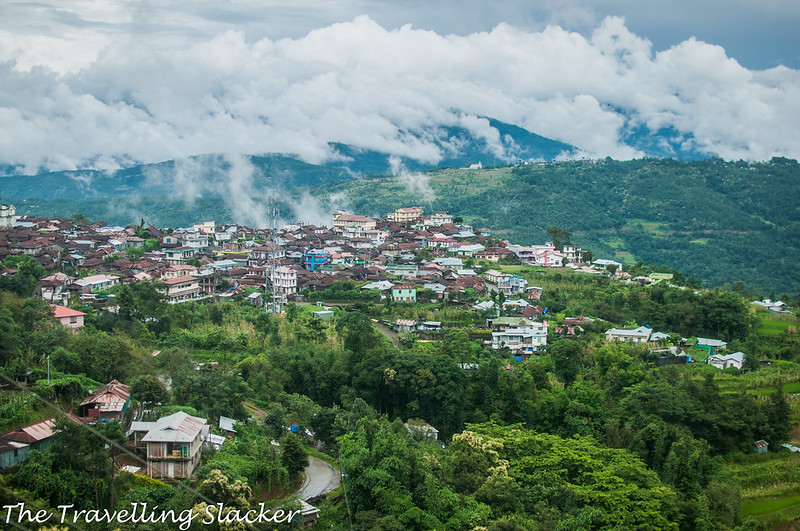
I kept going but soon it started raining. I tried to continue but the rain got progressively heavier and not having waterproof shoes was beginning to cost me. By that time, I had covered an awkward amount of distance. I had come too far to return while I still had to cover a lot more to reach my destination. I was worried about my equipment too so I paused, and waited for a while. The rain subsided but it had taken away almost an hour of my valuable time. Due to unfavorable timezone arrangements, it gets dark pretty quickly in the Northeast. It was already past noon and I had no more than 4 hours in hand. On the positive side, there was a large Bhutan Glory (Bhutanitis Lidderdalii) on the road. I almost stepped on it but saw it at the last moment. Then I captured it… digitally.

The road was longer than I’d imagined. It must have been 8-9 KMs from the main road and the light was fading fast. Finally, I reached the end of the road and it was already past 3.30 PM. Here, I found a hut, and a building that was under construction. I am sure in the future this will be turned into a tourist facility but at that point of time, there was no one. I noticed the steep trekking trail going upwards inside the jungle. Another non-steep route was going straight. So, it was a bit confusing and there was no signage to guide the trekkers. I decided to take the steep one.
The first few steps went well, but after that the trek was getting progressively more difficult. Due to the rains, a hilly stream was overflowing and merging with the steps, making it very difficult to move. While this stretch is short, it is covered by a thick, evergreen canopy, making it even darker. Soon, I was finding it very hard to see and beginning to question my decision and wisdom. At one point, I completely stopped because I could not see the trail ahead. Was it even the correct route?
Today, in hindsight, I can say that I was on the right path and I was almost there, barely 200 metres away from salvation. But at that moment, it was pretty dark and I had no idea what was happening. Maybe the rains had also obliterated some parts of the trail, which led to the confusion along with the lack of signage in the beginning. I paused for five minutes but the visibility dropped further and the rains also started again. With a heavy heart, I decided to come back.
The return turned out to be even harder. It was no more than 5 PM but it was pitch dark inside the jungle. I missed the trail at some point, slipped at a few points, found myself in a very awkward spot and could not proceed further although I knew I was not far. I was not carrying a torch either and my phone was dead too. I considered my options. One option was to sit still in the jungle for the next 12 hours and wait for the morning light. But in that case, another burst of rain would have been a terrifying prospect, along with the arrival of any kind of wild carnivore.
Just at that point, it occurred to me that I still had a functioning camera. I cursed myself for my stupidity and took it out. While we underestimate the glow of the camera screen under normal circumstances, in that primal darkness, it worked like a torch. I could finally see the trail, which was just two feet away from my spot. The next half an hour was tiresome but finally, I managed to come out of the jungle and reached the hut.
I think constructions use this hut occasionally but there was no one that night. Now, I could keep walking and tried reaching the main road. But I was tired already and that would have taken at least 3 hours more and it would have been hard to get a transport to Kohima from there. I was also not sure if there was any accommodation option in Viswema. Even if it was there, I would have reached after 9 PM and as far as I had seen, these places become desolated after 6 PM. So, I finally decided to spend the night in that hut and start moving in the morning. The room was locked but there was enough space in the porch. There were some mats, a bench, utensils, and various other items, suggesting that I was not the first person to stay there.
My material, as well as social, needs have always been very modest. So, I was happy to find a place to lie down after a tough day. I was fine with the desolation but the only problem was food. I had not had anything after breakfast. I knew that accommodation and food will be available in the valley but now I had no option left. I checked all accessible corners of the hut and finally found a bottle of Kissan Jam. It was mostly empty, except a few drops at the bottom of the bottle. I had to use my toothbrush bring that out and had my first morsel in 12 hours. It reminded me of Adrien Brody in The Pianist, when he receives some normal food after many days of struggle. I have always been against excessive glamorization of travel writing, but yes, sometimes it can make you look like a Hollywood star, although there was no one to witness that glorious moment.

I dozed off soon, but was woken up by the sound of something jumping on the tin roof. I could not really see anything but the sleep had departed already. I opened my laptop to check time. It was 1 PM. I thought of watching a movie and wait for the morning. But the only unwatched film with me was Mikhail Kalatozov’s Soy Cuba. It was too experimental a film to be watched when one was physically drained. But I think it had the desired impact and I was feeling sleepy again. After that, there was no interruption that night, or at least, I did not realize.
I woke up at around 4.30 AM after that and it was already pretty bright. I even considered going back to the valley. But I was too tired and also, I soon realized that my camera had accumulated a lot of vapour inside and it was no longer usable. This will remain a great regret for me because I could not take a single photograph of my shelter. Anyway, I walked fast, reached the highway by 7 AM, and then caught a cab to Kohima to end my ordeal.
Dzukou 2nd Attempt: A Successful Ascent in December 2017
I returned to Nagaland after 3 months and this time I was no alone. I have already published my Pfutsero Travelogue . After that, we arrived in the same area. Being in a group meant that we had better bargains and were saving money on accommodation and transport. However, this also meant that we were finding it hard to coordinate and although we planned to go for the trek every day for the next 4-5 days, we could never collectively make up our minds to leave on time. I did not even want to visit Hornbill Festival but that is where we ended up every day and downed ourselves in rice wine and rice beer.
Finally, on the last full day of the trip, we decided to give it a try. By that time Johann and Devesh had left for Mon district and only Shubham was remaining of the original group. But he had a group of friends joining in and they also had their own vehicle. So, the first part of the trip was taken care of. We just drove to the steep trekking point, following the same route. The steep hike also seemed easier in the dry season. It took us around 50 minutes to negotiate this part, and in the process, I realized that I was very near to the top when I gave up last time.
After around 1.1 Km of a very steep hike, the valley finally opened up in front of us. I have done far longer treks but this was a reward comparable to many of them. It was a hazy, cloudy day but one glimpse of the valley was worth all the effort. It was also greener that my expectations although it was way past the peak season.
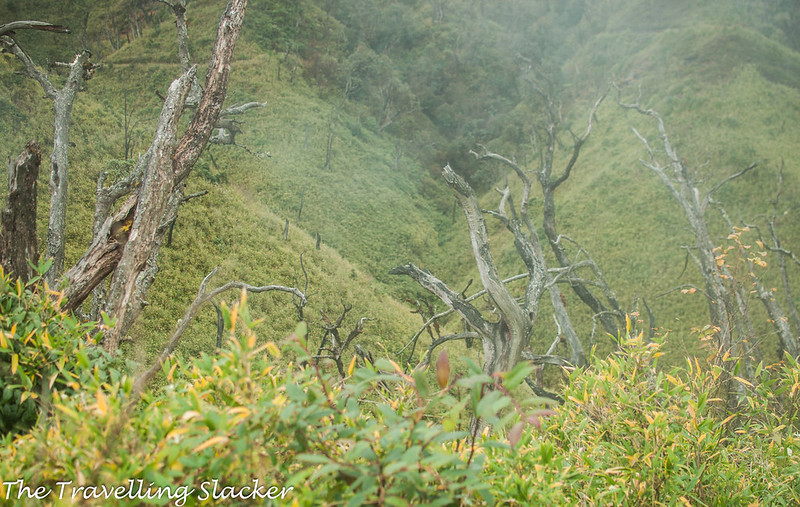
It is still 4-5 KMs after this point to the official resthouse of Dzukou. But it is a straight stretch where you just have to keep walking and the house was already visible in the horizon. We walked through dense foliage but the trail was very clear and we had no issues in reaching the destination in another hour and a half, including some photography breaks.
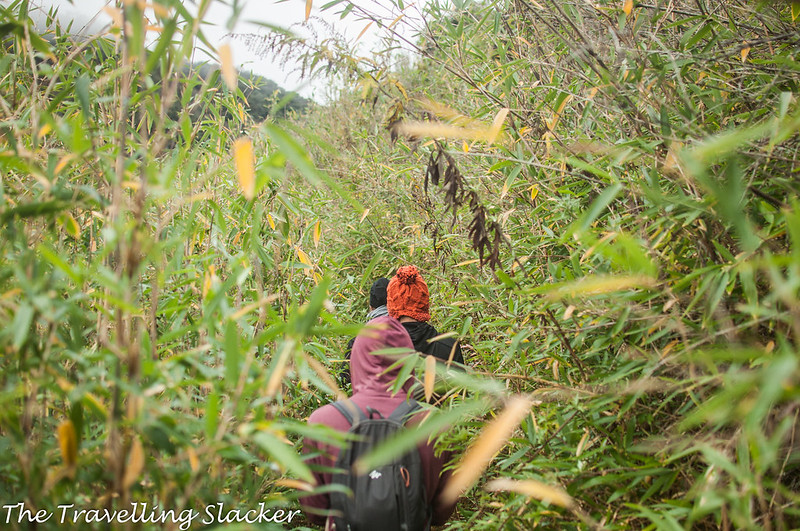
The people at the hut served some good fried rice and tea for us. There were already a lot of other people in the valley, most of them seemed to have stayed the night. By deciding to come on the last day, I already knew that I was not going to fully enjoy the valley. I tried hard to compensate and took a few more photographs but the weather was worsening. We spent no more than 3 hours at the top when the rains returned, reminding me of the previous attempt. This time though, I was not alone and nor did I have any luggage. So, we rushed back in a hurry and reached the car in a couple of hours, just before it got completely dark.
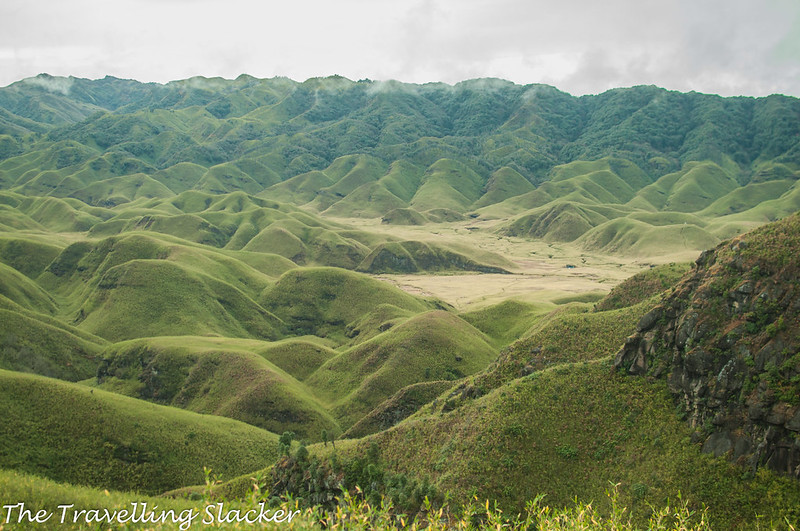
So, in the end, finally I can say that I have set foot in the Dzukou Valley but in my heart, I know that much more had to be seen. I must return next year, during the flowering season. But till then, all I can do is remember that lonely, drenched night, and watch the remainder of Soy Cuba.
Dzukou 3rd Attempt: Spotting the Dzukou Lily in June 2019
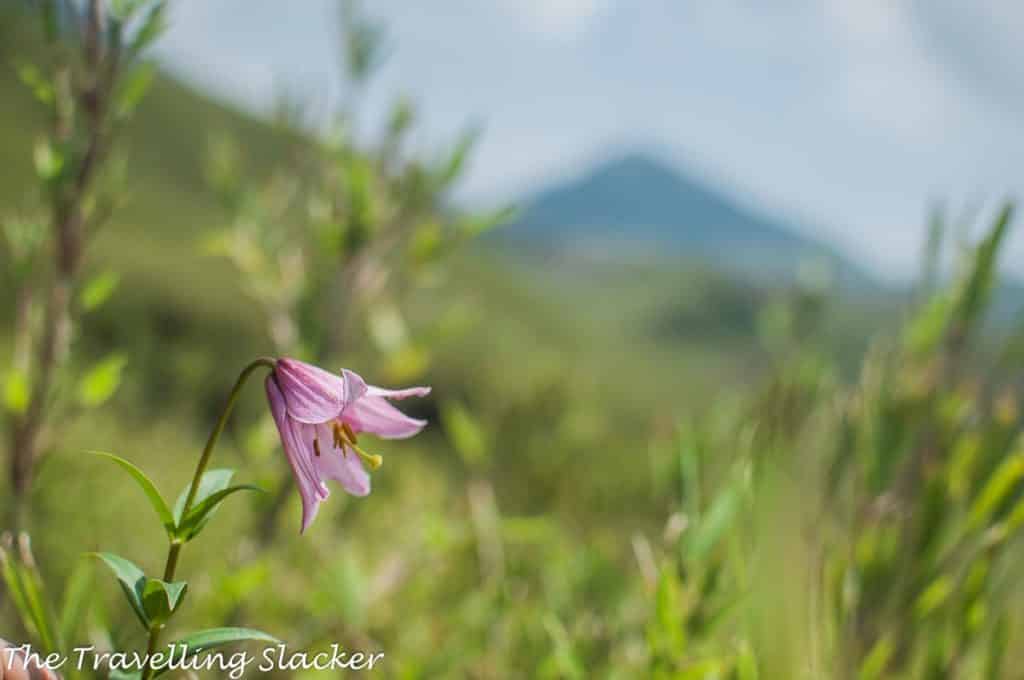
So, I finally made another solo trip to Dzukou, and this time, finally I had good weather and the right season. I even spotted the Dzukou Lily in full bloom as you can see above. I have also updated the guide below with latest information.
You can read the Dzukou Lily experience here with more photographs .
Jump to Specific Queries
Dzukou Valley Travel Guide
How to reach dzukou valley.
There are two primary trek routes to Dzukou Valley. Both involve a bit of motorable road, and a bit of steep trekking, and then some straight walk in the valley.
- From Viswema Village (22 KM from Kohima + 8 to 9 KM motorable road + 1 KM steep hike + 4 to 5 KM straight walk in the valley to the resthouse)
- From Zakhama Village (16 KM from Kohima + 3 to 4 KM motorable road + 5-6 KM steep hike + 1 to 2 KM walk in the valley to the resthouse)
- There is also a route from Manipur side ( Senapati District ), but it is even more obscure, unmarked, and I have never met anyone who has done it.
How to reach Viswema from Kohima?
At Kohima, go to the Network AOC Stand (Don’t confuse it with NST stand, where you are most likely to arrive from Dimapur), from where you get shared cars to any of these villages at INR 50-80 per head.
How to get cars to the trekking point?
You can ask around after reaching Viswema for cars to cover the motorable road and reach the trekking point (You can walk this stretch but it takes up around 3 hours through gradual incline and tires you even before the start of the actual trek). You can also take someone from Kohima but I am sure they will ask an exorbitant amount. From Viswema they tend to ask for INR 1500 even if you are alone. So, this works better if you have more people to share the cost. The best guy to ask is the auto-repair guy at Viswema , whose garage is located just at the start of the road, and where the shared cars from Kohima also drop you.
Where to Stay the night before Dzukou?
This is a tricky one. You can always start at Kohima and start as early as possible. But you can also start in one of the roadside villages so that you can start quickly in the morning. I have done it both from Kohima and from Kigwema on different occasions.
Where to Stay on the Highway near Dzukou?
I once stayed in the one called Vicha Paying Guest at Kigwema and we had a good experience in this family-run homestay, which also had the best food I had found in the entire Nagaland. The stretch between Kohima and Zakhama has many homestays nowadays and this trend will only grow. However, some of them come alive only during the Hornbill Festival in December because that’s when more people visit.
Where to stay cheaply in Kohima?
Kohima is an expensive city and can get difficult for backpackers and budget travellers. There are some godforsaken old school hotels in the market that you should probably avoid. I am aware of three places that offer shared bunk beds in Kohima City.
Morung Lodge (INR 800/bed/night with breakfast) at Midland Colony. It is a good place, highly rated online, with good views and facilities, and I have stayed here before. However, to be honest, 800 is a bit too high for a shared bed.
EcoStay Hostel (INR 550/bed/night with breakfast) near the World War Cemetary is a new development and I just stayed here for my latest trip. As of now, it seems to be the most affordable decent option for backpackers. The rooms need a bit more space though. An open balcony would have made it infinitely better.
Central Guest House (INR 300-400/bed/night) near the NST bus stand is the cheapest option. I have not stayed here but from what I learned from the ones who stayed, the facilities are not that great.
Will there be someone in the valley to help me?
Yes, there are a couple of appointed people who are supposed to man the guest house throughout the year. They also collect fees, provides bedding, and cook food for the visitors.
What is the altitude of Dzukou Valley?
It is around 2400-2700 metres.
Where to Stay in Dzukou?
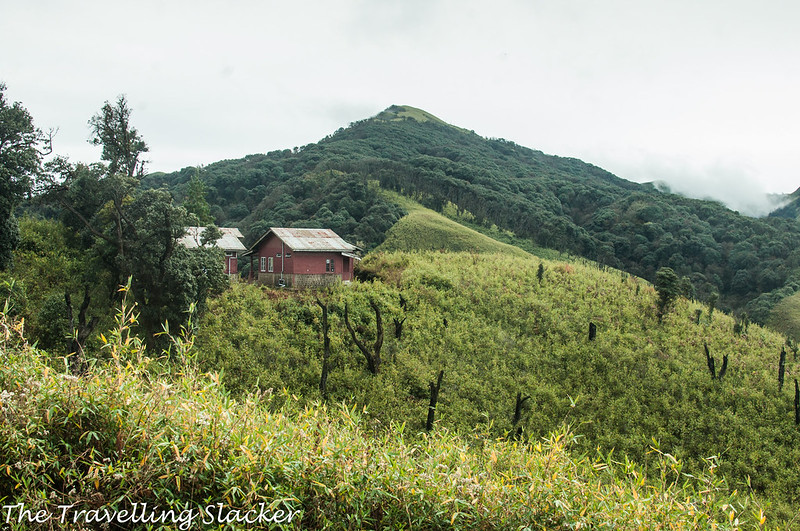
Can I pitch a Tent in Dzukou?
Yes, you can pitch your own tent for INR 100, or even borrow a tent from the caretaker to pitch at a designated spot near the rest house. The second option, of course, costs more. (Check the Price Chart below for more details).
Can I get food in Dzukou?
Yes, there is a kitchen and they provide some basic food like tea, rice, omelet, noodles, etc. I saw some people cooking pork, not sure they took the food with them or the caretaker provided them.
What is the right season for Dzukou?
It can be accessed throughout the year. For the wild blossoms, visit it in the summer and monsoons (May to August). The rains can be challenging but this is the price you pay for best views. The famed Dzukou Lilies bloom around late May and early June. A lot of people visit it in December to club it with the Hornbill Festival but to be honest, that is a dry and dull season for the valley.
Are there any entry fees to the Valley?
Yes, they charge INR 100 as an entry fee even if you don’t spend the night, along with INR 200 as a camera fee in case you have it.
What about phone and data connectivity in the valley?
Most services work till Viswema. There is no real connectivity up in the valley. Sometimes you may capture some random signals but don’t get too excited.
Where do I get Old Monk before the trek?
Nagaland is actually a dry state where commercial alcohol is prohibited. But you can always get some traditional rice beer, which ia integral part of their culture and not prohibited. You will have to ask around for this though unless your time it with Hornbill fest, where they sell it openly, but at a premium.
Dzukou Valley Price Chart (Rates for amenities)
With my recent trip, I noticed that the prices have increased a bit with its increasing popularity. Packed food is sold at a premium also, but that is expected in a trek due to supply issues. You can also get firewood for a bonfire and use the kitchen items too. So, here is a list of prices of various items atop Dzukou Valley.
Entry Fee: INR 100 per head
Camera Fee: INR 200
Stay Fee at the Dormitory: INR 50 (Do note that at 50 you are just allowed to stay, blankets etc cost extra)
Stay Fee at Individual Room: INR 1500 (Yes, I haven’t added an extra 0 by mistake!)
Permission for pitching own tent: INR 100
Hiring Tente from the Caretaker (2 people in 1 tent): INR 1200
Foam Mat for Sleeping: INR 50
Light Blanket: INR 50
Thick Blanket: INR 150 (Basically light blanket is useless in the cold night atop the valley. I had to use a combo of light and thick).
Cup Noodles: INR 70-90 depending on brand and size.
ORS-L 200 ml Tetrapack (Health Drink) INR 60
Omelet INR 80
Milk Tea INR 20
Red Tea (Black Tea) INR 20
Simple Veg Dinner with Daal & Potato INR 200
Dinner with Meat INR 300
Fire Wood INR 10 per piece
Borrowing Kitchen Items: You can borrow kettle, utensils, plates, etc, especially if you are camping and cooking on your own, for some additional cost. But if you build a good rapport with the guys, they can be lenient.
Photography and Drone Permissions atop Dzukou?
As mentioned before, you need to pay INR 200 for the camera. If you click on your phone, then you can avoid this cost.
On the other hand, Drone Photography is Strictly Prohibited inside Dzukou Valley . However, I saw some people doing it inside the valley without the caretaker noticing. But if he does notice it, he will ask you to stop and delete the footage.
Do we find Drinking Water atop Dzukou Valley?
There is water supply from the nearby streams, which is used for all purposes including drinking and washing. If you are not comfortable with that, bring your own bottles (and please take them back to the nearest dustbin in the city too). They don’t sell water bottles atop the valley.
Toilets atop Dzukou?
There are basic Indian style toilets. You will have to carry the water on the buckets.
Approximate Budget for Dzukou Trip (From Guwahati)
I always do it as a part of the longer trips so hard to make a proper estimate. In general, if you make a quick trip from Guwahati in 3 days, I think you can manage it in INR 3000-4000, if you don’t hire the car from Viswema (which costs an additional INR 700-800). These costs are assuming if you go for the cheapest options including sleeper class train from Guwahati, bus or shared car to Kohima, and the dormitory to stay at Dzukou and backpacker hostel at Kohima.
Ideal Dzukou Valley Itinerary
This itinerary is a bit hectic. It is assuming that you don’t do anything else and only going fro Dzukou Valley Trek. Ideally, you should have more days to relax and enjoy. Add a day extra to suit yourself.
Arrive in Guwahati from your place. To keep costs low, take a night train (Nagaland Express) from Guwahati to Dimapur (Get the online ILP beforehand so that you don’t have to waste your time at Dimapur).
The train reaches a very early morning, around 4-5 AM. So, come out and find a bus and then reach Kohima by 10 AM. Have breakfast somewhere and find a cab to Network Stand and get a shared car to Viswema. From here, you can hike (or pay a locla drive to drop you a bit ahead to make it easier). You will reach Dzukou Valley between 2 PM-5 PM depending on your choices. Enjoy the valley, watch the sunset, interact with other trekkers around the bonfire, and sleep at the dorm.
Next morning, enjoy the valley in the first half. The valley is actually vast and from the dorm, you can go ahead a long way. Enjoy the views, take photographs, or just do nothing. Wrap up your expedition by noon and hike back to the main road by afternoon. Catch some bus or cab going towards Kohima on the highway. Stay at a hotel or backpacker hostel in Kohima.
Leave the next morning for your next destination.
ILP for DzukouValley?
As usual, Indians need an inner line permit (ILP) for any place in Nagaland (Foreigners are exempted). You can get it from Guwahati, Delhi, or Dimapur office. However, nowadays they seem to be a bit lenient and don’t seem to ask tourists. Also, nowadays the good news is that you can get the ILPs online by filling up a form and making online payments. Read this post to know how to apply Naglanad ILP online .
Plastic Advisory at Dzukou
There are some recent reports of declaring Dzukou Valley a plastic-free zone, which is something that is immediately implemented, although I am not sure how easy or difficult that will be. I have noticed that dustbins have been installed at various spots throughout the trail but still I saw a lot of plastic litter at various points in the valley. I think some strong punitive measures have become necessary.
Also Read: Other places to see and things to do around Kohima
Also Read: Hornbill Festival Travel Guide if you are planning to visit it.
- Latest Posts
- Boosting Global Travel Experiences with the Power of Bitcoin and Digital Nomadism - 2024/04/15
- Modern-Day Bali Jatra: Your Travel Plans Made Easy - 2024/04/04
- Top 5 tourist destinations in India for an adventure trip - 2024/03/30
Related Posts
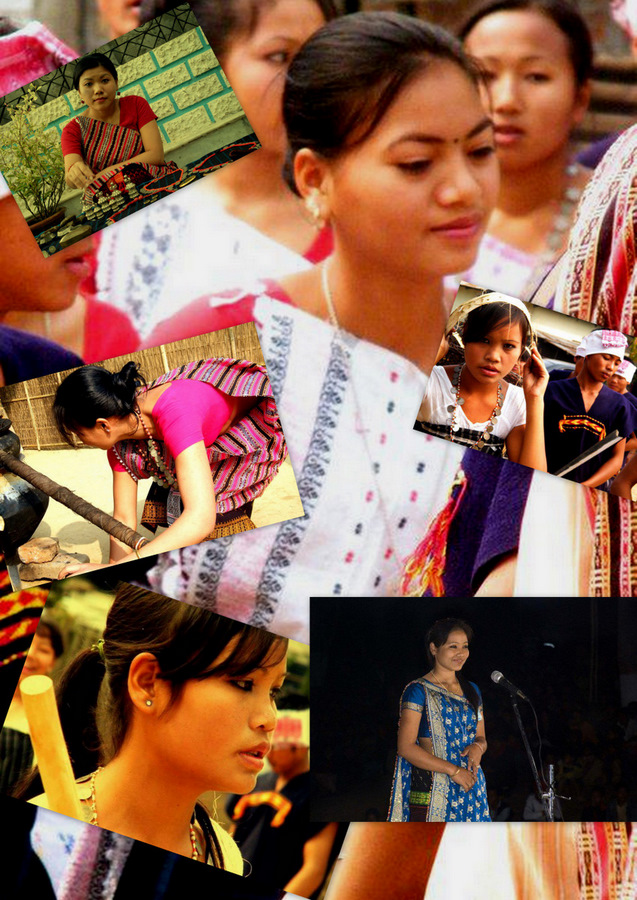
Postcards from Karbi Anglong: 38th Karbi Youth Festival
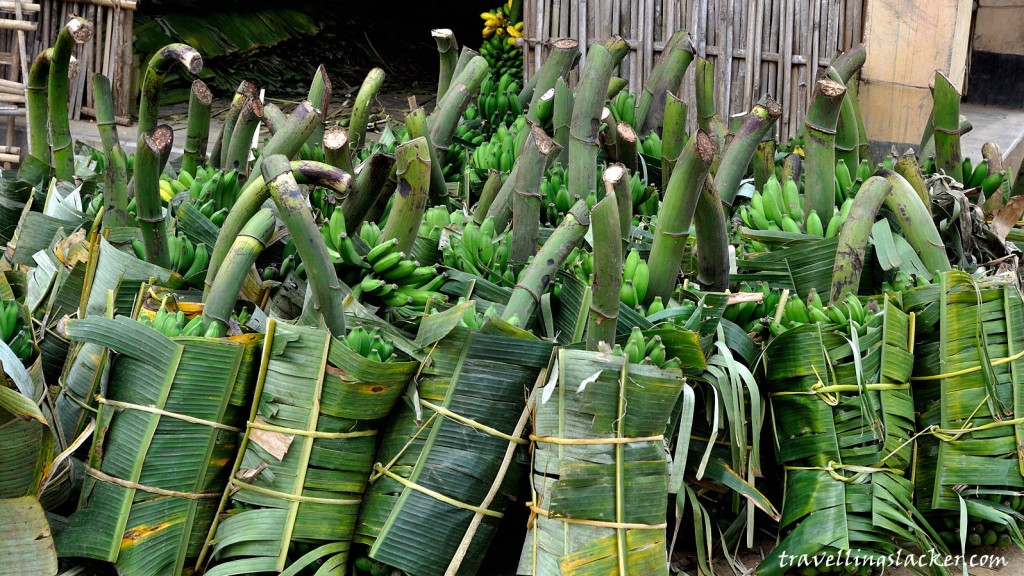
Goalpara Diaries 1: Dudhnoi Market and the Banana Cartel
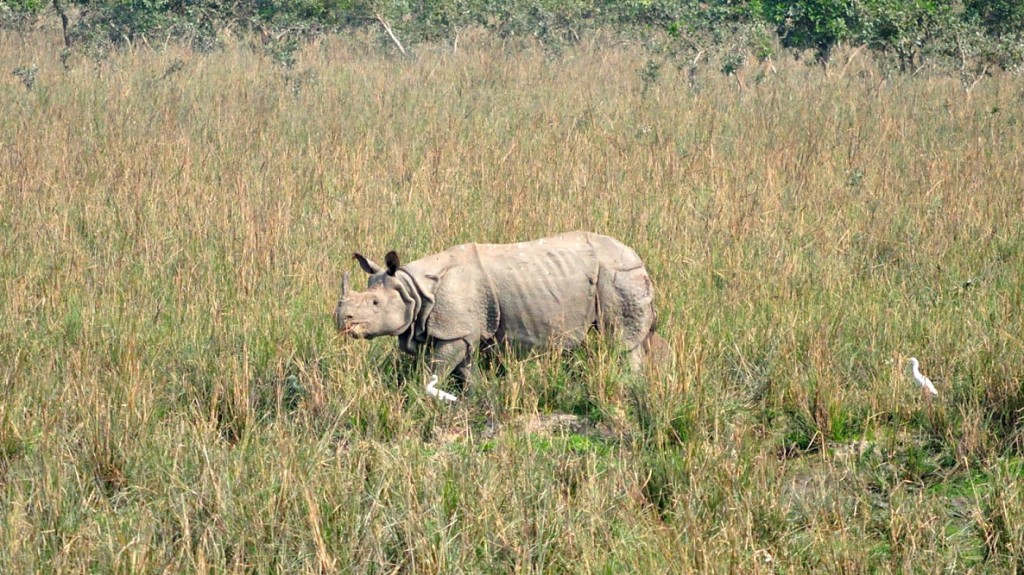
Pobitora: Where Rhinos Dare
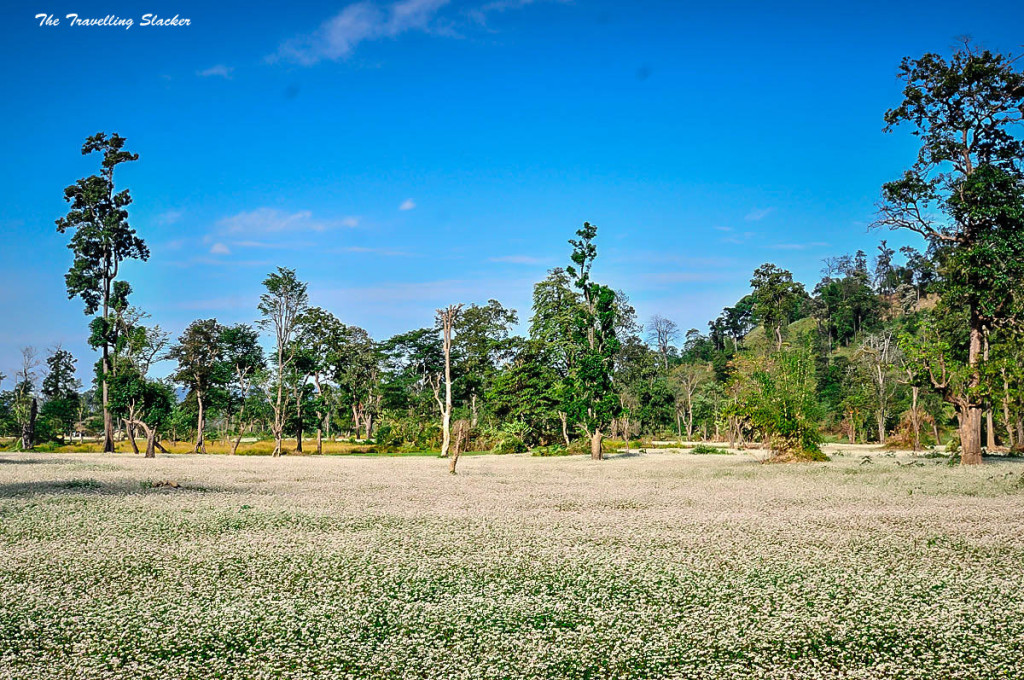
Namdapha: Flora, Flora, Flora!
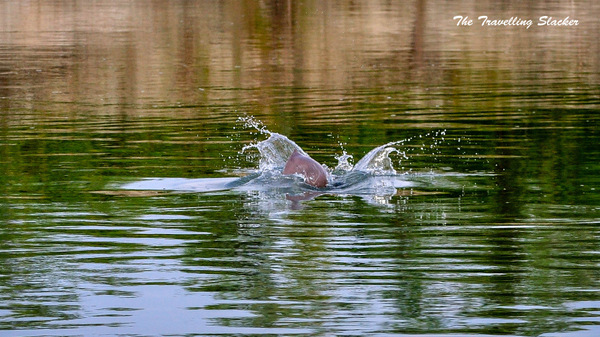
Dibru Saikhowa: Shooting River Dolphins
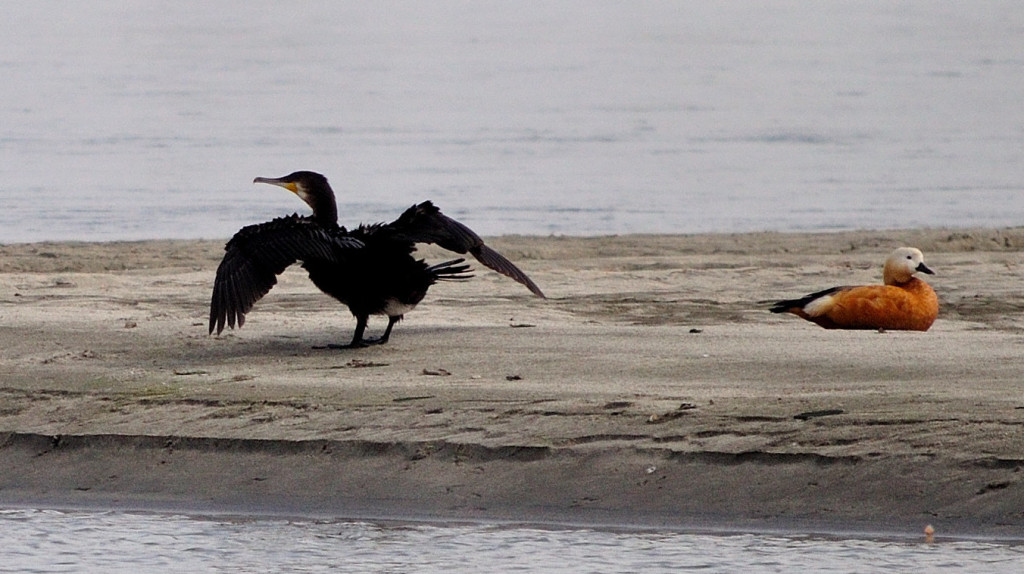
Dibru-Saikhowa National Park: Birds and more Birds
28 thoughts on “dzukou valley trek, nagaland”.
Wow! I know I can never trek in this lifetime at least! I know I will miss untamed untouched beauty of nature ……but I know I can experience it through your blog post Jitaditya 🙂 Its fantastic that you share things as is…..
Beautiful and intriguing blog. Couldn’t take a pause once I started reading. ?
Amazing Valley, Thank you so much for your post. Awesome pics.
What a lovely trek! Thanks for the detailed information…
Wow! Could feel all your apprehensions and the sense of adventure. Thank you!
Such a beautiful trek.
The landscape of Nagaland looks so beautiful. I had no idea about Nagaland beyond Kohima and Mon but looks the rolling hills are simply stunning. This trek also seems to be relatively unexplored. Hope people do not start going there in hordes now.
Gosh, I travel by myself but I don’t think I’d dare do this kind of trek alone. The landscape is stunning though and I’d love to visit those hills. I remember that moment in the Pianist – great film isn’t it? Glad you could re-enact your own version with the leftover jam!
Because of your 0.5 success (the other way of looking at it!), you have some amazing photographs to take home and share with us. No, you are not too negative. Most of the time, writing about the failures gives the readers tips on how not to fail. But I think being more concise will help!
What a riveting post Jitaditya…I loved the story of your failure as much as I loved your success. There is always something inspiring and something to learn from all such experiences, and your story kept me hooked with excitement till the end.
Bookmarking it and hope to do it sometime in future 🙂
It was nice to read both your success and failure at this trek. Many travelers out there don’t for the gram and forget to accept that traveling is not all rosy. The pictures of Viswema with the mist and without mist is beautiful, really really beautiful. There’s lushness and fertility on the valley. Glad you never gave up and tried again. That’s the spirit. Been planning an Himalayan trek but haven’t recorded any progress yet. You’re an inspiration.
Holy smoke! That sounds flat cray cray. I hate the feeling of being lost or not actually being sure where I am, especially when it’s getting dark. You handled it like a champion! Is this the same area that the Japanese invaded during WW2? P.S. Don’t listen to people who rag on your writing style that it may be ‘negative’, because your voice is very refreshing! I hope I don’t have any ‘getting lost’ nightmares tonight though. 😀
What a beautiful place! Your photos are lovely. Never heard of this place, but it seems like a great destination.
Some beautiful views from the parts of the trek that you did complete. And you got a beautiful photo of the Bhutan Glory – such a stunning butterfly. I don’t think there’s anything wrong with having turned back, especially if you were hiking in the rain and dark. I would have turned back sooner lol! And I give you huge kudos for heading back to attempt the trek again after the first time – I’m sure the memories of a drenched night weren’t totally enticing you to get back!! Congrats on making it into the Dzukou Valley in the end – and I look forward to hearing about your next trip during flowering season!
What an epic saga. Kudos to you for not giving up in the face of adversity but moving on. In spite of the odds you still managed to get some stunning shots. I am sure you would already be planning your next hike to the same place and I am sure you will complete it fully this time. All the best !
Whoa whoa whoa! Had goosebumps reading of your first attempt. Have been lost in the forest in the night for just a few minutes and it was harrowing not knowing where to go. To be stuck like you did…oh man! Am sure there were great lessons to be learnt frim this experience, though! The landscape looks just so stunning! We have always thought we’d head to the NE with 3 months time to do justice, but looking at your stories, that doesn’t seem enough time!
Hey 3 months is not bad… maybe not the whole but pick up 2-3 states and explore them well…
Awesome place… This is heaven for me. I want to go there again and again…
can i take my 5 year old kid for the dzukou trek
You can… just take a guide along for caution so that you don’t lose way with a kid.
Pingback: Hornbill Festival: A Complete Travel Guide – The Travelling Slacker
Pingback: Kohima: Things to do after Hornbill – The Travelling Slacker
I have organised the Zdukou Valley trek tour.. Really beautiful place … peoples should visit
Very informative post. Planning to go here in Oct. Your post will become my tour guide. Hahaha
Such a lovely images of Dzukou Valley. Good information about the tour. If any interested to visit the Dzukou Valley can contact UFO at https://www.ufoadventuretravel.com/tours/detail/dzukou-valley-japfu-peak-trek
Pingback: 15+ Best Treks in Northeast India - Periplus Northeast
Best guide I have ever come across.I’m planning to visit the valley in March. How’s the weather in March
March should b pleasant in this area.
Leave a Comment Cancel Reply
Your email address will not be published. Required fields are marked *
Save my name, email, and website in this browser for the next time I comment.
This site uses Akismet to reduce spam. Learn how your comment data is processed .

Southeast Asia
- North America
- Central & South America
- Australia & South Pacific
- Middle-East
- Solo Travel
- Zodiac Travels
- Wellness & Spas
- Family Travel
- The Conscious Traveller
- Accessories
- Points and Miles
- Manushi Chhillar
- Quick Style
- Rajkummar Rao
- Chefs Himanshu Saini & Neha Mishra
- Poorna Jagannathan
- Guru Randhawa
- Edition 2023-24
- Edition 2022-23
- Edition 2021-22
- T+L Experiences
- Web Stories
- Destinations
India Bucket List: Visit The Magical Land Of Dzukou Valley
Relatively less explored, the dzukou valley in nagaland is a paradise that can make even the most discerning trekker an ardent fan..
By: Ranjan Pal Published: Dec 21, 2020 07:00 AM IST
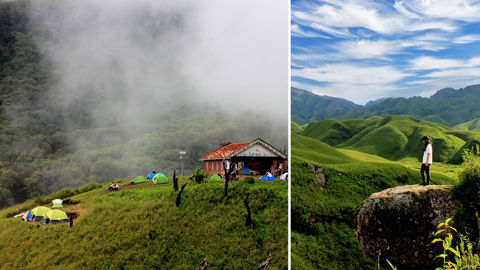
Relatively less explored with a landscape that enthrals, the Dzukou Valley in Nagaland is a paradise that can make even the most discerning trekker an ardent fan. Text & photographs by Ranjan Pal
In the winter of last year, as I was planning my first extensive tour of the Northeast, I was advised by David Angami, founder of the adventure travel outfit India Trail , that I shouldn’t miss out on the Dzukou Valley in Nagaland. I must admit I was a bit sceptical and a tad blasé at first, having been on several magnificent high-altitude treks in the Great Himalayas, where I had crossed icy passes forbidding in their isolation and took in amazing vistas of soaring peaks that kissed impossibly blue skies. What could such a low-altitude ramble in the green hills of Nagaland offer to an experienced adventurer?

Few tourists even hear of the place. But David Angami persisted and sent me some images as well. I stared at them for longer than I thought I would. There was something hauntingly different about this lost green valley, and the idea of a trek to stretch our limbs at the end of our Northeastern adventure appealed to me. And so, Dzukou Valley was added as dessert to the main course of Kaziranga National Park and the Hornbill Festival .
It was a crisp winter morning in November, when the five of us found ourselves bumping along a hill track in a battered old Sumo towards the starting point of our adventure . There are two trails that take you to the hidden valley—the Viswema route and the Jakhama route, both named after the villages from where they are accessed. Being a shorter but sharper ascent, the Jakhama trail is definitely the one less taken, but we opted for the more leisurely Viswema route considering we were all in our senior citizenhood!

After reaching the end of the motorable road, we walked along the broad path before it turned abruptly into a man-made stone staircase that ascended through a thick forest of chestnut, juniper, and oak. This steep climb to the crest of the valley took us about an hour—a tough slog compensated by the occasional vistas of the valleys below us that appeared through breaks in the trees.
As we broke through the treeline, I was caught off guard by the sight before me. On one side was a panoramic view of the hills and valleys of Nagaland with small villages dotting the landscape; on the other, a narrow entrance into a surreal world. A carpet of green covered a shallow valley and stretched all the way to a small cluster of houses, visible as distant specks on the horizon. Burnt skeletons of trees stuck out of the green foliage everywhere, like black bristles on the scalp of a sleeping Frankenstein’s monster.

We ambled along in a single file in the bright sunlight, following a narrow trail cut through the foliage towards signs of human habitation. The rest houses appeared closer than they were, and it took us two hours to reach them. People try to make it to Dzukou Valley and back in one day, but this makes little sense if you want to relish the beauty of the place. We had decided on two nights and had opted for a full-service camping experience with tents, guide, and porters. But there are cheaper options too, and the rest houses have private rooms and dormitories with spartan sleeping and toilet facilities and a common firewood kitchen. These are maintained by the Southern Angami Youth Organisation (SAYO) and are the only human settlements allowed in the entire valley.
After unrolling our sleeping bags and settling into our tents, we snuggled with warm cups of tea in our hands to watch the main show. Sunset arrives very early in this far eastern corner of India , and the valley quickly began to darken before us. A series of small green hillocks undulated downwards to a plain covered in thickets of dwarf bamboo. To me, they looked like mysterious forms huddled under a vast blanket of green. Then the sun finally sank behind the line of dark hills.
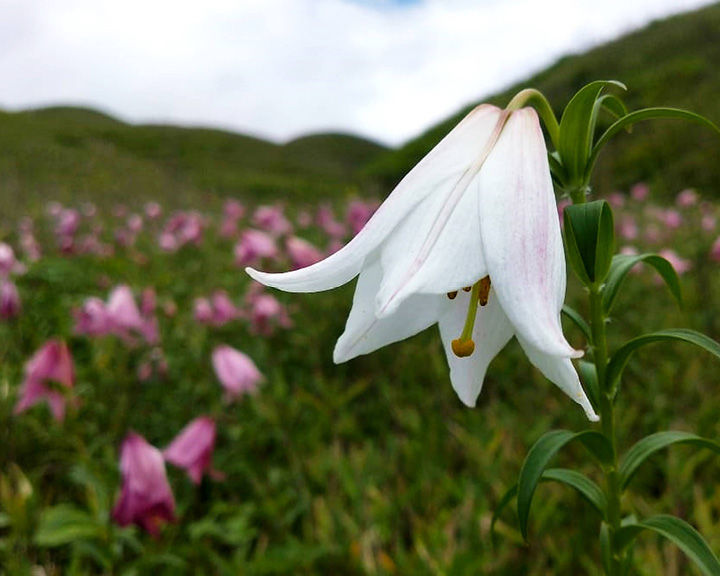
We woke up in the cold light of dawn, as the shadows were being dispelled by sunlight. Younger bravehearts had woken long before us and scrambled down to experience the dawn in the frozen valley. We waited until the sun had warmed our older bones before venturing down. After crossing a few shallow but incredibly clear streams that flowed silently through the valley floor, we clambered up a small hillock to reach our final destination—a tall cross standing watch like a lone sentinel, its battered sheets of metal tattooed with graffiti over the years. Many Nagas are Christians today, their conversion dating back to the days of the Britishers, who thought converting them would transform the warrior culture and stop the constant feuds between villages. At the base of the cross, a small group of devotees from the Angami tribe sat huddled, carving out their names on smooth flat pebbles that they would later place in the clear waters for good luck. We joined them in silence.
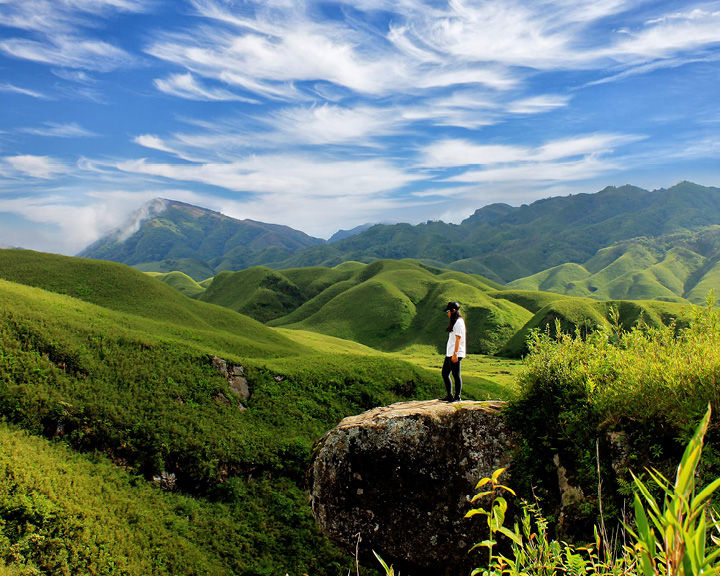
During the high summer months of June and July, Dzukou Valley transforms into a botanist’s delight. A secret garden in the heart of the valley is carpeted with wildflowers and rhododendrons, with the star of the show being the rare pink Dzukou Lily, an endemic variety. For the foreign visitor, the added attraction of the valley is that it is still relatively undiscovered, probably because of its remote location and the fact that there is no luxury accommodation here. So, if you are an outdoors enthusiast looking for an outstanding offbeat adventure that will not tax you in terms of time, budget, or effort, look no further than Nagaland’s magical Dzukou Valley.
GETTING THERE The trek starts from Viswema village in Nagaland, which is a 45-minute drive from Kohima. The closest airport to Kohima is at Dimapur, which serves direct flights to and from Guwahati, Imphal, and Kolkata. The drive from Dimapur to Kohima is about 78 km and takes approximately three hours.
STAY Dzukou Valley has only one basic rest house offering two camp-like dorms and five private rooms. If you are basing yourself in Kohima, Hotel Vivor is a fairly new hotel with modern facilities located away from the crowded centre of the town (starts from INR 5,500). If you want to be in the heart of Kohima, then Hotel De Oriental Grand is a good option (starts from INR 5,000).
WHEN If you want to witness Dzukou Valley at its spectacular best, plan your visit during the flowering season of April-July. However, if you want to combine the trek with a general tour of Nagaland, then the festive season (October-December) would be ideal, as the Hornbill Festival takes place in early December in Kohima and Christmas is the most important festival for the Christian Nagas—in the course of a normal year.
IDEAL FOR Adventurous travellers, nature lovers.
TOURS The best way to experience Dzukou Valley is to let a professional adventure travel company like India Trail organise everything for you, including tents, guide, porters, permits, and all meals. (INR5,540 for three nights and four days per head for a couple, and INR10,867 per head for a four-person group).
DISCOVER The highlight of any trip to Nagaland has to be the Hornbill Festival, a vibrant celebration of the culture and heritage of the 16 distinct Naga tribes spanning the first 10 days of December. (The festival is set to go virtual this year). Don’t miss the guided Battle of Kohima Walk through Garrison Hill and the Kohima War Cemetery. Taking village walks through Khonoma, Dzulake, Kigwema, and Mima is an enjoyable way to discover Nagaland and understand how the society functions.
Related: Explore The Green Village Of Khonoma In Nagaland Through A Series Of Stunning Photographs
- Dzukou Valley
- hidden gems of Northeast India'
- northeast India
Related Stories

Timing Is Everything: Discover The Best Time To Visit Rajasthan For The Ultimate Itinerary
By Shalbha Sarda

Must-Have Thai Souvenirs: Ruang Khao Siam Sapphire, PAÑPURI, And More
By Tipapa Chandarasrivongs

Most Beautiful Places In Barcelona: Your Guide To The Catalan Capital's Scenic Sites
By Lakshmi Sharath
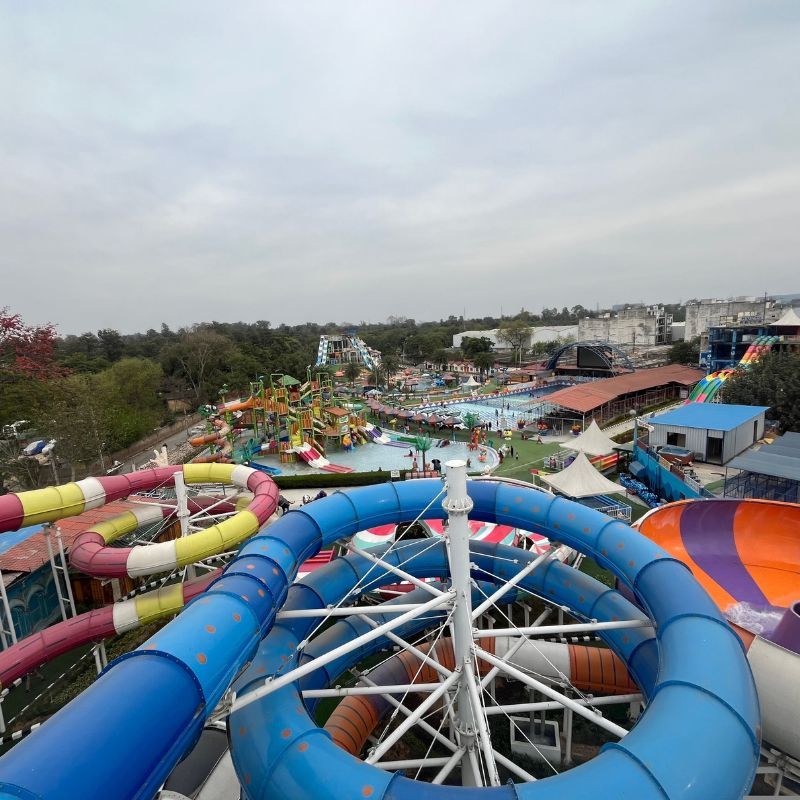
Delhi-NCR's Coolest Water Parks: Your Guide To Family Fun In The Sun
By Esha Dasgupta
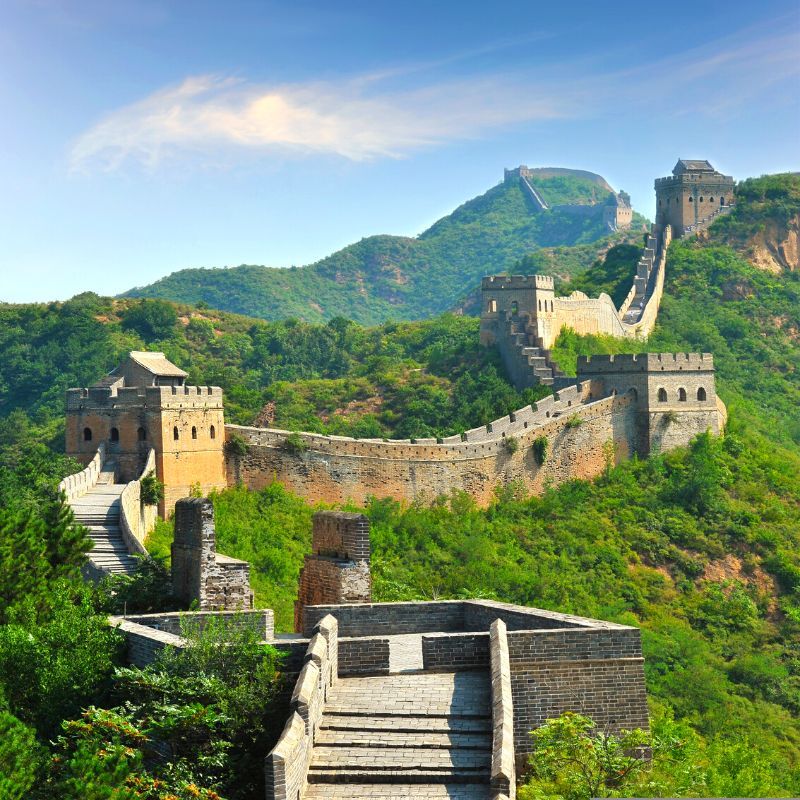
The Great Wall Of China Awaits: Your Essential Guide To Planning An Epic Visit
By Priyaja Bakshi and Shrestha Purkayastha
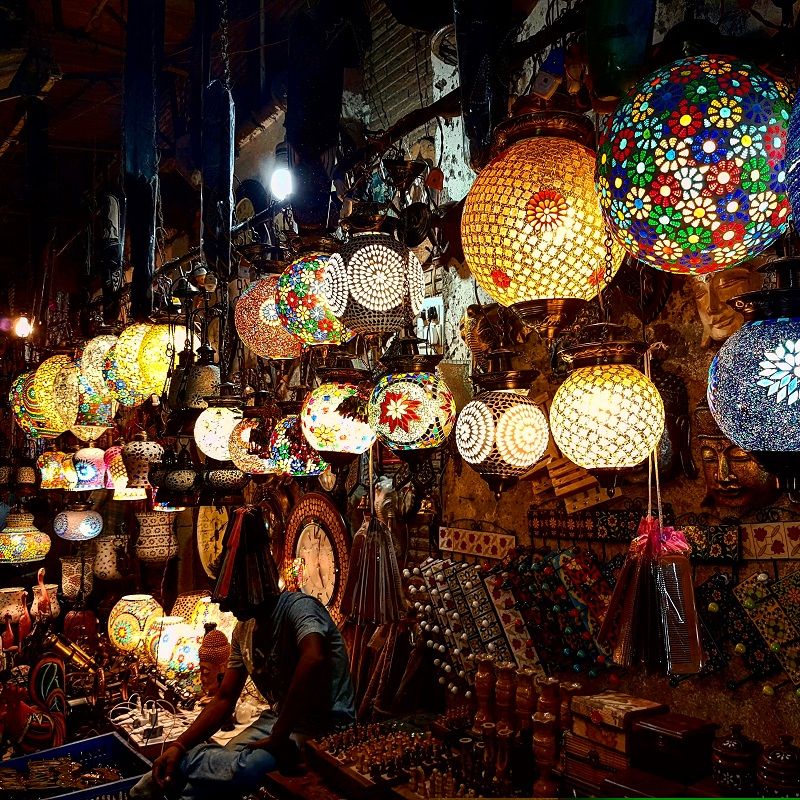
Souk Stories: Explore The Best Flea Markets In India For A Shopaholic's Delight
By Pyusha Chatterjee
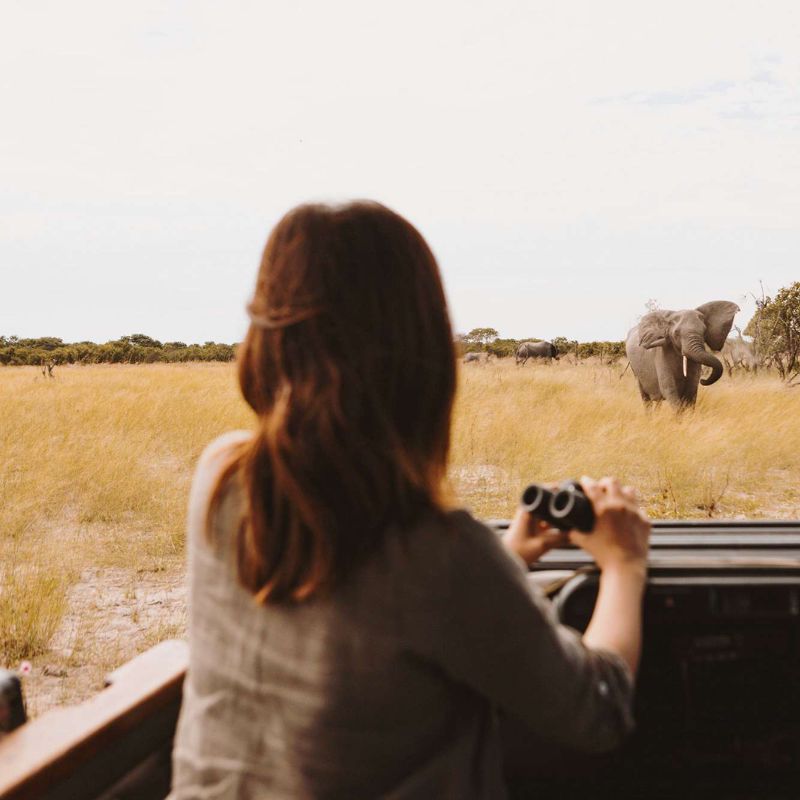
This 7-Night Safari In Botswana Is All About Wildlife, Water, And Sustainability
By Stefanie Waldek

Himachal's Hidden Gem: Exploring The Quaint Town Of Naggar
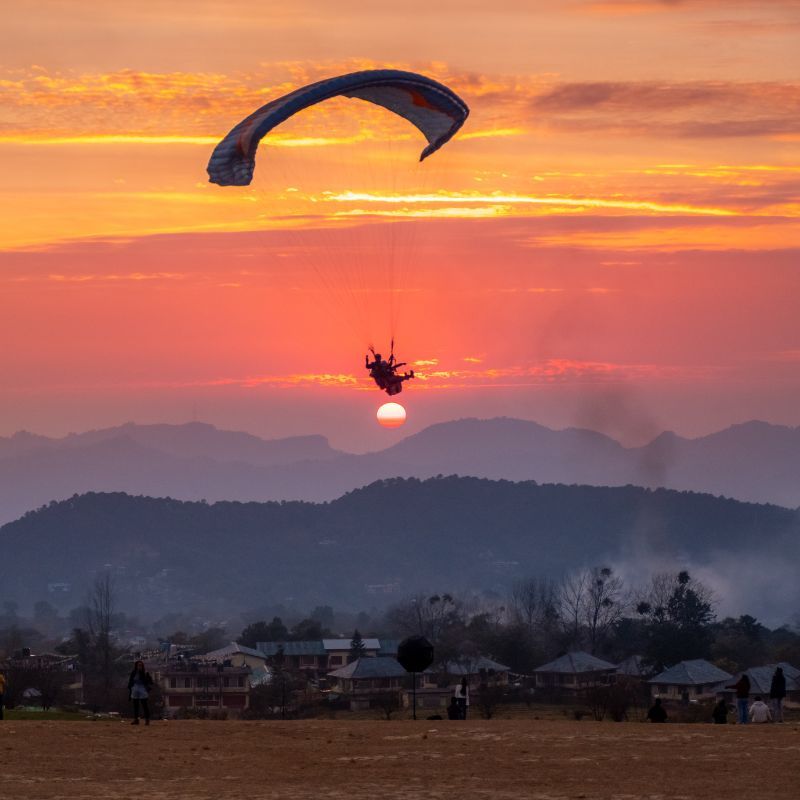
Jibhi And Bir-Billing: Explore The Hidden Havens Of The Himalayas
By Esha Dasgupta and Japleen Kaur
Subscribe to our newsletter to get the latest on travel, stay & dining.
You’re all set
Thank you for your subscription.

Dzukou Valley Trek
Nagaland • 7 days.
MAX ALTITUDE
₹ DIY + 5% GST
Dimapur to Dimapur
Available Batches
Brief description.
Translated from local language, Dzukou means cold water for the cold stream that runs through this charming valley. Known for its natural splendor, this valley of rolling hills is unlike any other you ever saw. Get this, this densely forested valley barely has any trees! Even so, the trail for this valley which straddles the border of Manipur and Nagaland is unbelievably green and full of colour from the many wildflowers on its green carpet of rolling hills. The valley is home to some rare and endangered species of fauna. One of which is the Dzukou Lily. The state bird of Nagaland, the Blyth tragopan, also frequents these hills along with other rare species like the Asian golden cat, the Hollock Gibbon, clouded leopard and the horned toad amongst countless other species of fauna that call these beautiful forests home. Very many rare species of rhododendrons do their bit in adding to the magic to this mystical valley. Declared as a plastic-free zone to protect its rich biodiversity from getting harmed, the trail also brings you to some of the smaller villages in the region. It takes you to a maximum altitude of 2,452M and gives you enough opportunities to brush shoulders with the locals of the area. It is a beginner’s level trek perfect for anyone who wants to explore some of the remotest regions of Nagaland. Stay on this page for more information on this trek.
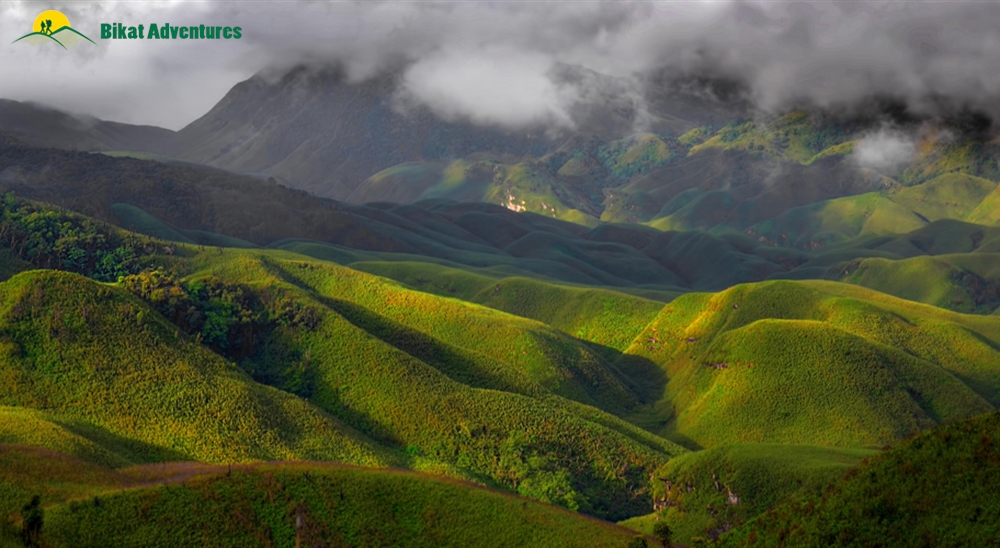
Arrive to Dimapur and head to Khonoma
The first day is reserved to make your way to Khonoma which is a small town 3 hours away from Dimapur. Dimapur has an airport from where you can get a ride to Khonoma.
(If you need help figuring out how to reach Dimapur, read this ).
If you wish to travel with us, we can arrange for a shared vehicle between Dimapur and Khonoma.
There’s nothing more on the agenda for today other than to get acquainted with the new place and to each other.
Khonoma to Seikhakie
Khonoma is the ‘first green village of the country’. We start off in the morning by exploring the village – the culture and the cuisine and the way the locals go about their usual business in this unusually beautiful place. The hospitality of the locals sure deserves a special mention as well. Post breakfast we start our trek to Seikhakie. There’s no rush since it is only about 4 kms from Khonoma. Today is a fairly easy walk to our campsite for the night.
Seikhakie to Dzukou
We leave for Dzukou post breakfast. It should take close to 4 hours to cover the distance of 6 kms to Dzokou so we have all the time to go as slowly as possible and observe all there is to soak in in the Khonoma Nature Conservation and Tragopan Sanctuary. It is not a biodiversity hot spot for no reason!
When you have reached a lush green landscape of rolling hills with veins of water spread in all directions, know that you have reached Dzokou Valley. This is where we camp at night.
Dzukou to Dzulekei
We start the day with no hurry. After breakfast we head out to a waterfall 3 kms away from the campsite. The waterfall is stationed in the Dzulekei village. Once we are here, we spend some time at the waterfall. We use the rest of the day to explore the village and talk to the locals. We spend tonight in the village.
Dzulekei to Dimapur
On this final day, we head out from Dzulekei and make our way to Dimapur. Expect to reach by mid-afternoon. You can get your flight out from Dimapur the same day.
Frequently Asked Questions
Pick your question, eligibility: fitness benchmark.
There is no requirement of extreme fitness training for this trek. If you have basic physical fitness and knowledge of trekking you must undertake this trek.
Eligibility: Requisite Skills
Basic mountain mannerisms. Basics of knowledge of mountain ascending and descending techniques. Basic knowledge about camping
Eligibility: Experience required
This trek can be done by beginners as well as experienced trekkers.

About the activity: Why should I go for this trek?
The Dzukou valley trek is one of the few treks which give you an opportunity to immerse yourself in the culture of Nagaland. This 5-day trek takes you into the lush green mountains which are blessed with enriching flora and fauna.
Best Season: What are the best months to visit this trek?
The best season to do this trek is the winter season. From the months of November to March.
Connectivity: How to Reach the base of the trek & how to go back from the end point?
By Air The only airport in the region is Dimapur Airport. You can take a flight from all major airports to this airport. By Road From the Dimapur airport, you can take a cab to the base camp village of Khonoma. It takes around 3 hours to reach the village.
Connectivity: What is the cellular network connectivity for this trek?
The cellular network is available in several patches of the trek.
Eligibility: Is this trek good for me?
Anyone who is new to the trekking and wants to venture into the experience should begin with this trek. It can be easily done by yourself with no prior trekking experience.
Since it is a beginner’s trek, you need no special prior experience. Although one is required to have mental preparedness and stamina before he begins the trek. Running exercise is recommended.
Dzukou valley trek
Best season:.
Best season to do the trek is in the winter season when the weather is pleasant. Summers are hot and monsoon attracts significant rainfall.
Packing List: What to pack
Carry a backpack with rain cover, good trekking shoes, water bottles, quick dry clothes, trekking pole (optional)
The base of the trek is the pretty village of Khonoma which is at a distance of 90km from Dimapur and can be easily reached by taxi.
Intermittent to lack of cellular network as you proceed further into the valley.
Nearby attraction: What are the nearby attractions that I can explore?
The nearby cities of Dimapur and Kohima are the popular attractions from Khonoman. The Nagaland zoological park close to Dimapur is a popular attraction.
Accommodation: What will be the accommodation type in this trek?
There are hotels present in the towns of Khonoma and Dzulekei. You can easily camp on the trekking days.
Weather conditions: What will the temperatures be like during this trek?
Days are hot and humid while the nights are pleasant. Monsoon receives a lot of rainfall.
Weather conditions: When will there be snow on this trek?
There will be no snow on this trek.
What's Included
Whats included, whats not included, cancellation policy, cash refund.
Cancellations up to 30 days prior to departure date 5% Deduction
Between 30 days to 15 days prior to departure 50% deduction
Less than 15 days of departure No Cash Refund
Voucher Refund
Cancellations up to 5 days prior to departure date No Deduction
Cancellations less than 5 days prior to departure No Refund
Please note
- Cash refund is applicable only in case of bookings made without using any promotional offer code or vouchers.
- This is only a brief of cancellation terms. For finer details please refer Detailed Cancellation Policy.
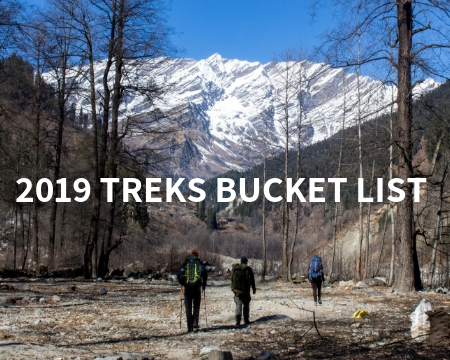
Bucket List Treks For 2019
Kiritika Jyotshi 09 January 2019
As travelers, we have constant urges to explore new places and expand the picture gallery of our phones with the bittersweet memories from our trips. Our love for the unseen places just keeps increasing and trust us, it becomes an addiction before
Informative

5 ALTERNATIVE TREKS TO DO IN 2019 INSTEAD OF ROOPKUND
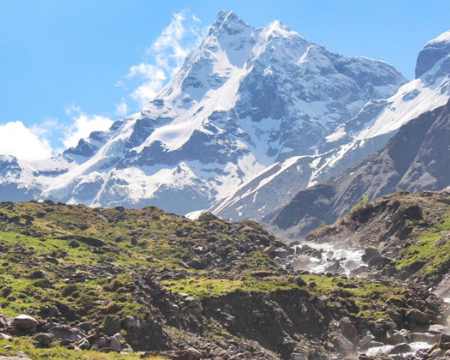
Best Himalayan Treks That You Can Go For This Summer
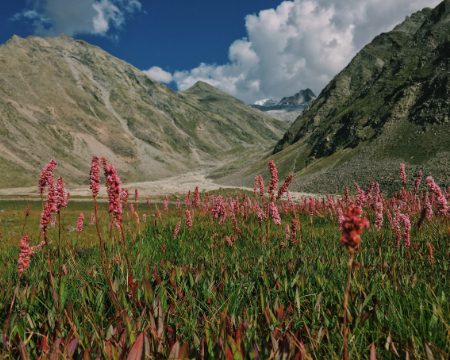
11 Best Offbeat Treks In India Nobody Knows About
Experiential, enter your email, certifications.

Events by Month
- January July
- February August
- March September
- April October
- May November
- June December
Events by Activity
- Popular Treks
- Aspirational Expeditions
Events by Grade
Events by duration.
- 5 & more Nights
Bikat Adventures
- Environment Policy
- Privacy Policy
- Terms & Conditions
- Work With Us
- Address: 303, 3rd Floor, Tower B4, Spaze Itech Park, Sector 49. Gurgaon
- Pre Sale - 8448680062 , Post Sale - 8588878499, 9667639126
- Cancellation & Refunds
- Content Sharing
We are Social
Payments we process, submit enquiry.
Travel Character
Dzukou Valley Travel Guide – The Hidden Gem Of Nagaland
The word Dzukou or sometimes spelled Dzuko comes from the Viswema dialect of the Angamis which means Soulless and Dullness. When the Viswema ancestors migrated to create a new village in Dzukou but the harsh weather circumstances didn’t allow them to grow crops, which led them to say – The valley is very beautiful but dull and soulless.
Dzukou Valley
Introduction.
- Is Dzukou Valley Worth visiting?
- Best Time To Visit Dzukou Valley
- How To Reach Dzukou Valley?
- Where To Stay
- Things To Do In And Near The Dzukou Valley
- Things You Should Know Before Visiting
- FAQ’s
Situated on the border of Manipur and Nagaland, Dzukou Valley is one of the best tourist attractions in Northeast India. Set at the staggering height of 2452 meters above sea level Dzukou valley is famous for its picturesque landscape, rolling hills and multicolored blooming flowers especially the Dzukou lily which is found only in this valley.
Monsoon is the time when flowers start blooming in the valley and the first half of July is the peak flower season in Dzukou valley. But if monsoon doesn’t suit you best then don’t worry Dzukou valley looks stunning in other seasons as well, especially during winter. Apart from beautiful flowers, Dzukou valley has a lot to offer like rolling hills, a wide range of flora & fauna, and amazing opportunities for trekking and camping. If you love lush green mountains with shades of white clouds then you should include Dzukou valley on your bucket list.
Back To Top
Is Dzukou Valley Worth Visiting?
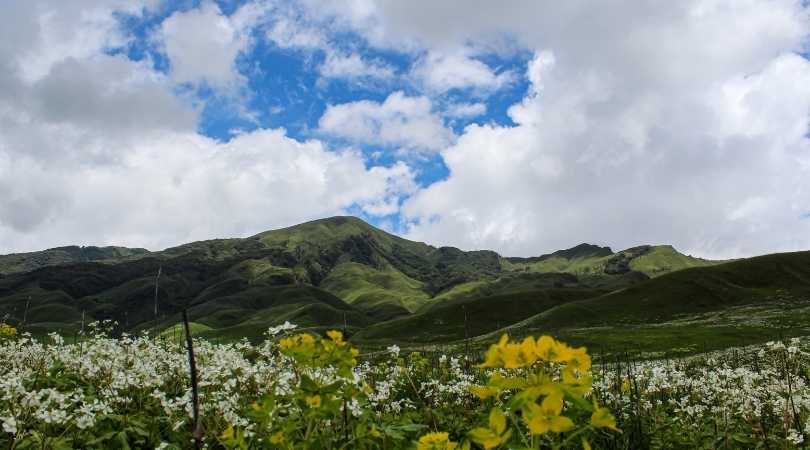
A big yes, as I mentioned above that it is an all-season destination which means no matter when you visit, it always has something to offer. The picture-perfect landscape of the valley takes you into nostalgia like you’re living inside the wallpaper of Windows XP. The pleasant climate and scenic vistas give you an environment where you can just sit and enjoy the flawless beauty of nature. The best part about Dzuoku valley is that it is located in Northeast India and it is yet to be explored by domestic and international tourists. So, you’ll get ample space to experience and enjoy the local culture of this place.
And trust me in upcoming years there will be a tourist boom in Northeast India. So, before it gets too overcrowded plan a visit to Dzukou valley.
Entry Fee – 20 rs Per person from nearby regions / 50 rs per person for other Indians and 100 rs per person for international tourists.
Best time to Visit
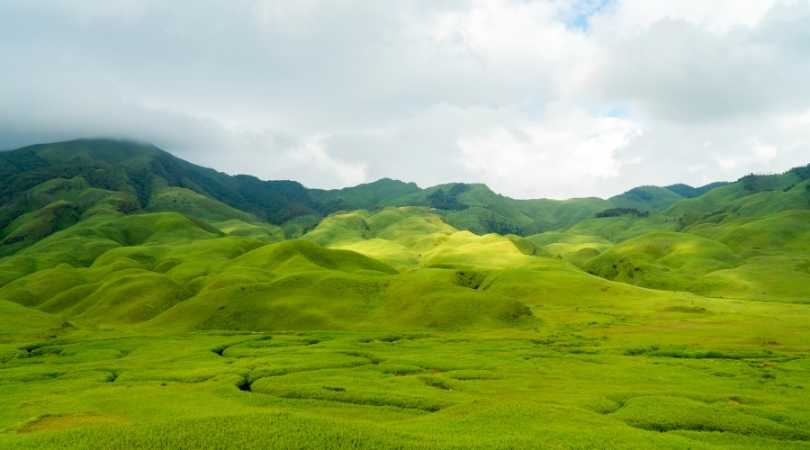
Dzukou valley is an all-season destination. However, June to September is the peak season when the little rain makes the mountains greener and the flowers start blooming. This is the time when you can witness the Dzukou lily which can only find in Dzukou valley. The temperature hovers between 17 to 24 during the daytime and 4 to 8 degrees at the night. So, it is advisable to carry woolens.
Dzukou Valley In Monsoon (June to September)
If you’re traveling during monsoon (June to September) then do remember that Dzukou valley receives heavy rains. There will be leeches too and the path become muddier & sleepier. So, it is recommended to carry raincoat, good trekking shoes and salt for leeches. But all these troubles are worth it as you’ll get to see the valley full of Dzukou lilies. With blooming lilies valley turns into a scenic flower bed and watching this will be a memory for a lifetime.
The pleasant climate is another reason to take the Dzukou valley trek during the monsoon. Unlike winter the weather stays pleasant which makes it easier to stay at the night.
Dzukou valley in Winter (October to March)
If you can bear the low temperature then winter is a good time to visit. During this time you’ll not get to see the blooming flowers but there is a lot more to do like rock climbing, trekking and camping. Despite being a tropical region the temperature during the night can be bone-crushing. But during the daytime, the warmth of sunshine makes the weather pleasant for trekking.
The freezing cold temperature turns the entire landscape into a winter wonderland. From December to February you can expect an intense winter in Dzukou valley. Also, this is the time when you can attend the famous Hornbill Festival Of Nagaland.
Dzukou Valley in Summer (March to May)
Dzukou valley experiences hot & dry summer with rainfall. The average temperature ranges from 18 to 35 degrees Celsius. However, in the last week of May and the first few weeks of the flower starts blooming.
How to get there
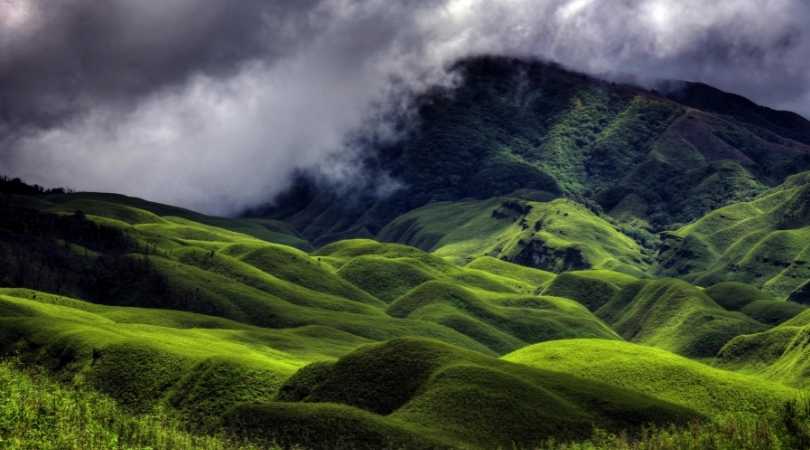
Dzukou valley is located on the border of Manipur and Nagaland. So, either you can reach there from Manipur or Nagaland. But most of the tourists prefer the Nagaland side as the way through Manipur is not good. So, let’s discuss how to reach Dzukou valley from Nagaland –
Reaching Nagaland & Khohima
Train and Flights are the best way to reach Nagaland. The nearest airport and railway station are situated in Dimapur. You can easily get direct flights from most of the major airports like Delhi, Mumbai, Kolkata, Hyderabad and many more. Kohima is located 70 KM from Dimapur, you can get a taxi to reach Kohima. It takes around 2 to 3 hours to reach Kohima from Dimapur.
After reaching Kohima you’ll have two ways to reach Dzukou valley – One is from Jakhama Village (20 Km from Kohima) and the second is from Viswema Village (25 KM from Kohima).
The trek from Viswema to Dzukou valley is long but easier to take while the trek from the Jakhama side is shorter, and takes less time but is more challenging. So, choose according to your stamina and situation. However, I recommend you to enter the valley from the Viswema side and exit from the Jakhama side.
Getting Dzukou Valley From Viswema
To get to the Viswema village from Kohima take a shared taxi from the Network Travels AOC bust stand. The shared taxi will charge you around 50 rs and take around 1 hour. The taxi will drop you at the entry gate of Viswema village which is 8 to 9 Km away from the trekking point. Either you can walk down to 8 to 9 KM to reach the trekking point or hire another taxi but it will cost you 1500 Rs as the road is in the bad condition. You can also hitchhike to cover these 9 KMs.
After reaching the trekking point the steep climb of 45 minutes will start that leads you inside the Dzukou valley. This 45-minute trail is very steep and could be slippery or muddy depending on the weather conditions. And if you’re coming in monsoon season then be prepared for leeches. On the way, you’ll get lots of dustbins so make sure to use them to throw your trash.
After reaching the valley there will be another 2 hours flat yet wonderful trail that leads you to the rest house where you can have food and spend your night. The stay in rest house will charge you 50 rs per person but don’t expect anything fancy. So, bring your own sleeping bags. Also, at the beginning of the trail, there is a rest house where you can have launch.
Getting Dzukou Valley from Jakhama Village
To reach Jakhama you need to take a shared taxi from Kohima that charge you around 40 rs. The trail from Jakhama village is short in distance much more challenging as compared to Viswema. Most of the trail is uphill and very steep so it would be easy to get down rather than go up. So, take this while returning from Dzukou valley as it will bring you back to the main road much quicker. It will take 3 hours to get down from the valley to the main road and 4 hours to reach up to the valley by Jakhama village. So, most of the tourists enter the valley from Viswema village and get down from Jakhama village.
Where to stay in Dzukou Valley
There are mainly 3 options to stay in Dzukou valley – the First is paid one inside the refugee rest house, the second is camping and the third is to take shelter under the natural caves.
Stay in Rest house
There is 2 basic rest house overlooking the valley which contains 2 refugee camps like dorms and 5 private VIP rooms with almost zero amenities. There is no electricity so make sure to bring a power bank & keep your device fully charged. Also, there is no tap water. Water for the washroom and cooking needs to be fetched in the bucket from a small well that is located between 2 dormitory buildings. Also, bring your own sleeping bag or mattress otherwise you’ll regret it. If you’re staying in the dorm then you’ve to sleep on floors.
VIP rooms do have wooden beds and attached washrooms but are not in good condition. I recommend you to stay in the dormitory as it feels safer and helps you to connect with more people. Overall, the rest houses are good places to stay with barebone facilities. The dorm room charge 50 rs per night while the VIP rooms charge 300 Rs per night. Basic breakfast and dinner are also available.
Set Your Own Camp
Dzukou valley is a great place to set your own camp. You will see lots of camps throughout the valley. And if you ask them nicely then you can set your camp own beside them. If you have camping gear then you can camp anywhere in the valley.
You can also pitch your camp near the stream at the bottom of the valley where you’ll have the facility of fresh running water for cooking and drinking. Camp would be a good option while staying in Dzukou valley as it will give you more freedom. But carrying all the essentials up to the valley is not an easy task.
Stay under the caves
At the bottom of the valley, there are some caves where you can spend your night. But you’ve to bring all the essentials like sleeping bags, utensils, food and water.
Things to do in and around valley
Enjoying the breathtaking views while trekking.
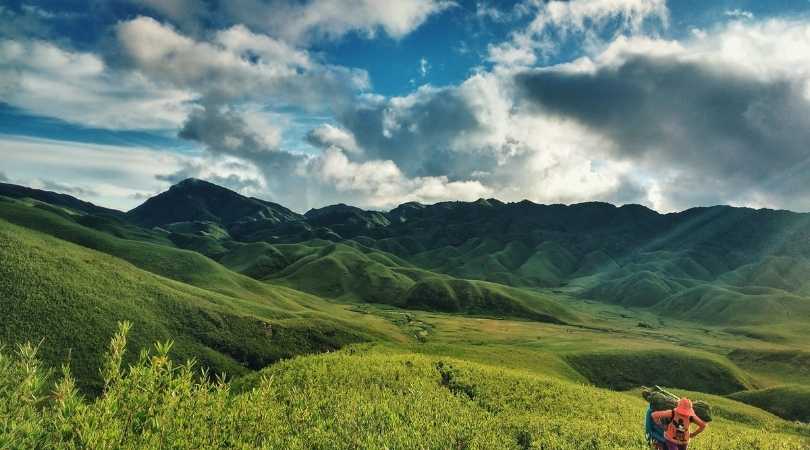
One of the most obvious things to do in Dzukou Valley is trekking. The wonderful landscape of the valley makes you feel as if you are in another dimension. So, keep your camera ready as you will get plenty of opportunities to take some amazing shots.
Hike Japfu Peak
Dzukou Valley is situated in the background of Japfu Peak. Japfu Peak, situated at an altitude of 3,048 meters, is the second highest peak in Nagaland. The Japfu Peak offers panoramic views of the Zukou Valley. The trail is much steeper than thick bamboo, so chances are you could get lost. It would be a good idea to hire a guide to hike Japfu Peak directly from the valley.
Visit Ghost Cave
About 15 minutes walk from the rest house is a cave known as Bhootiya Gufa or Bhootiya Gufa. The cave is about 1 KM long so you would have to bring a good headlight or lamp to explore it. You can ask the rest house staff about it for more details.
Explore India’s First Green Village – Khonoma
After the discovery of the Dzukou Valley, it is now time to explore Khonoma, India’s first green village. Khonoma, located just 20 km from Kohima, is a great place to witness the local culture. The population of this village is very less. Spending a day in a homestay run by the locals will be a totally unique experience. Nestled amidst lush green mountains, this village was once famous for hunting wild animals. So, it would be a very interesting story to know how a hunting village became the first green village in India.
Things you need to know before entering the valley
- Duzkou valley is a plastic-free zone which means you have to pay a security fee if you’re carrying plastic bottles or polythene bags. And you’ll get money while returning if you show proof that you’re still carrying the plastic essentials.
- Carry the sleeping bag as the temperature during the night become freezing cold and the rest house doesn’t have good blankets and mattress.
- Don’t expect fancy food in the resthouse. So, bring your own food to cook.
- Dzukou valley is a great campsite so you can literally pitch your tent anywhere you want.
- You can rent the firewood and cooking utensils from the rest house. The cost for utensils is 50 rs per item and firewood is 10 rs per piece and 100 rs per bundle.
- You can also collect the firewood for that you need to take walk back out along the trail leading to the rest house. You can also collect the dead flower’s stalks and bamboo shoots.
Is the Dzukou valley trek difficult?
Dzukou valley has an intermediate-level trek. At some places, the trail is very steep and uphill. So, if you’re an active person then you will not face any problems.
What is the best time to see the Dzukou lily?
The first half of July is the peak flower season in Dzukou valley. During this time you can see the famous Dzukou lily which can only be found in Dzukou valley.
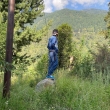
Hi Guys, My Name is Pursottam Saini, living the life of my dream – From traveling one destination to another and seeing the places I still don’t believe.
14 Wonderful Places To Visit In July In India For A Dreamy Vacation (2023)
Sikkim Tour Packages Starting From 4000 Rs
Top 6 Snowfall Destinations In India
How To Reach Gokarna by Bus, Train & Flight
Best Time to Visit Kodaikanal for an Enchanting Escape
Unveiling the Best Time to Visit Auli in 2024
Leave A Reply Cancel Reply
Your email address will not be published.
Save my name, email, and website in this browser for the next time I comment.
Top 15 Budget Backpackers Hostels and Guesthouse In Manali…
Top 15 Beaches in Greece (With Photos and Stay)
Chikmagalur Itinerary For 3 Days – 72 Hours In…
- Havelock Island
- Neil Island
- Baratang Island
- Ross Island
- Chikmagalur, Karnataka
- Travel Inspiration
- Book Your Stay!
- Lucerne. Switzerland
- Philippines
- Hill Stations
- Waterfalls in the World
- Honeymoon Places in the World
- Beach Honeymoon Destinations in the World
- Festivals in the World
- Best Travel Accessories
- India Travel Tips
- Best Travel Hashtags
- Guide To Plan A Perfect Beach Vacation
- How To Plan a Perfect Honeymoon?
- Honeymoon Checklist
- Travel Shop
- Disclaimer Policy

Dzukou Valley (Nagaland)
Viswema, Nagaland
Maximum Altitude
INR 6500/- Per Person Dimapur to Dimapur
Available Date
6th July to 10th July 2024
13th July to 17th July

About Dzukou Valley Trek
Dzukou Valley Trek is one of the most famous trekking routes in the northeastern state of Nagaland, India. Here are the details:
Location: Dzukou Valley is situated at the border of the Indian states of Nagaland and Manipur, about 30 kilometers south of the state capital, Kohima. It lies at an altitude of around 2,438 meters above sea level.
Duration: The trek typically takes around 2-3 days to complete, depending on the pace of the trekker and the chosen route.
Difficulty Level: The trek is considered moderate in difficulty. While not extremely challenging, it does involve steep ascents and descents in certain sections, as well as rocky terrain. It's suitable for both novice and experienced trekkers.
Best Time to Visit: The best time to undertake the Dzukou Valley Trek is from October to May. During this period, the weather is generally pleasant with clear skies, making it ideal for trekking.
Route Options:
There are two main routes to reach Dzukou Valley: one from the state of Manipur and the other from Nagaland.
The Nagaland route typically starts from the base camp at Viswema village, near Kohima, and involves a trek of about 17-18 kilometers to reach Dzukou Valley.
The Manipur route usually starts from the foothill village of Zakhama and involves a trek of similar length.
Both routes offer stunning views of lush green landscapes, cascading streams, and vibrant flora.
Permit: Trekkers are required to obtain Inner Line Permit (ILP) to enter Nagaland, which can be obtained from the Nagaland House in major Indian cities like Delhi, Kolkata, Guwahati, and Dimapur. Additionally, there might be local permits required which can be arranged through local tour operators or authorities.
Accommodation: Basic accommodation options such as guesthouses and camping sites are available near the Dzukou Valley. However, it's advisable to carry tents and camping equipment as facilities may be limited.
Safety Precautions: Trekkers are advised to travel with a guide, especially if they are unfamiliar with the terrain or local conditions. Weather can change rapidly, so it's important to be prepared for rain or sudden drops in temperature. Additionally, carrying sufficient water, food, and first aid supplies is essential.
Highlights: The trek offers breathtaking panoramic views of the valley, especially during the months of December and January when the entire valley is carpeted with blooming Dzukou lilies, making it a photographer's paradise. The valley is also home to a variety of flora and fauna, including rare species of flowers and birds.
Overall, the Dzukou Valley Trek promises an unforgettable adventure amidst pristine natural beauty, making it a must-visit destination for trekking enthusiasts.

Reporting at Dimapur railway station then drive to Kohima , Arrival in Zakhama
Arrive in Kohima, the capital city of Nagaland.
Acquire any necessary permits (Inner Line Permit) if not obtained prior to arrival.
Spend the day exploring Kohima, visiting local markets, War Cemetery, and other attractions.
Stay overnight in Zakhama .
Zakhama to Viswema Village (Base Camp), then trek to Dzukou Valley
After breakfast, drive from Kohima to Viswema Village, the starting point of the trek. It's about a 45-minute to 1-hour drive.
Reach Viswema Village and start the trek towards Dzukou Valley.
The trek from Viswema to Dzukou Valley typically takes around 5-6 hours depending on the pace.
Enjoy the scenic views along the trail, passing through forests and rocky terrain.
Reach the Dzukou Valley base camp area and set up camp.
Spend the evening relaxing and enjoying the tranquility of the valley.
Dinner and overnight camping in Dzukou Valley.
Explore Dzukou Valley
Wake up early to catch the sunrise over the valley, which offers breathtaking views.
After breakfast, explore the Dzukou Valley. You can trek around the valley, visit nearby viewpoints, or simply relax amidst the natural beauty.
During the months of December and January, the valley is adorned with blooming Dzukou lilies, creating a stunning sight.
Carry packed lunch to enjoy amidst the picturesque surroundings.
Spend the day exploring and taking in the beauty of the valley.
Return to the base camp area in the evening.
Return to Kohima via Zakhama
After breakfast, pack up camp and start the trek to Zakhama Village.
Depending on the pace, it usually takes around 4-5 hours to trek back to Zakhama Village.
Reach Zakhama Village and drive back to Kohima.
Upon reaching Kohima, check into accommodation and relax.
Spend the evening exploring Kohima further or simply unwind.
Dinner and overnight stay in Kohima.
Enjoy breakfast at the hotel.
Depart from Kohima to Dimapur , marking the end of the Dzukou Valley Trek adventure. Our service ends here, leave only footprints take only sweet memories of Northeastern Himalayas.

"What included"
Cost of transportation to and from. (Dimapur to Dimapur) Cost of accommodation in Huts/Hotels/Homestays. Cost of Fooding while on trek (Morning and evening Tea, Breakfast, Lunch, and Dinner- meals will be provided. Breakfast-Roti, Sabji/Maggi, etc., Lunch/Dinner-Rice/Roti, Sabji, Dal, Achar, etc.).(Day 1:- Evening tea to Day 5:- Morning breakfast) Cost of Permit fees .
"What not included"
Cost of Personal expenses. Cost of emergency due to bad weather conditions. Cost of personal porter. Meals during transit i.e. meals while on road or travelling will not be provided. No meals will be provided in Last day (Day 5) Cost of personal porter to carry his/her backpack.
Things to carry on a trek.

Have a question in your mind?
call us/whatsapp
+91-9748955458 +91-9674715111
Click the whatsapp icon to start whatsapp chat
to know our office location and more details
Booking Policy:
To book your trek, you need to pay 30% of the trek fees as advance. Rest 70% to be paid in cash when you reach the basecamp, to be collected by the team leader.
One can pay the amount online(Net Banking, GPay, UPI ID).
Details to be shared on request.
Cancellation Policy:
30 days before the trek date, full refund of the paid amount
15 days before the trek date, 50% refund of the paid amount.
Cancellation less than 15days to the start date of the trek, no refund possible
In case Himalayan Passion cancels the trek or trip, full refund will be paid.
One has option to send another person on their behalf.
One has option to adjust the paid amount on any other trek, if a person cannot join the trek he/she paid for.
Sorry, we couldn't find anything that matches your search.
Destination

Famous Places to Explore in Hyderabad
A vibrant city with the imposing...

Raipur Tourist Places | Best Place to Visit
The stronghold of several erstwhile...

Declared as India's first UNESCO World...

Ananthagiri
The verdant Ananthagiri Hills is...

Located on the banks of River Godavari,...

Situated around 40 km from Raipur,...

Boasting the famous Chand Baori...

Albert Hall Museum
A magnificent building built in...

2023. The year of India’s G20...
- Dzukou Valley
- Destinations
Just behind the Japfu Peak is the serene and scenic Dzuko Valley or the valley of flowers. Offering one of the most spectacular landscapes in the country, the valley is more popular with trekkers for its interesting and challenging trekking circuits. It prides itself for being one of the most-visited tourist sites in not only Nagaland but the entire Northeast India. Perched at a height of 2,450 m, it attracts adventure and nature lovers for its scenic beauty and rich flora. The valley is best visited in the full bloom season when beautiful lilies, aconitums, euphorbias and other species of flowery plants carpet the landscape, making it look like an artist's canvas. To reach this exotic valley, travellers need to take a 4 km steep climb, which holds great appeal for thrill seekers. From Dzukou, travellers can also take a 17 km trek to Viswema Village or a 15 km trek to Zakhama. The valley is located at a distance of 30 km from Kohima and the way is lined with handicraft stores from where tourists can collect local souvenirs as reminders of their trip to Nagaland.
Other Attractions in Kohima
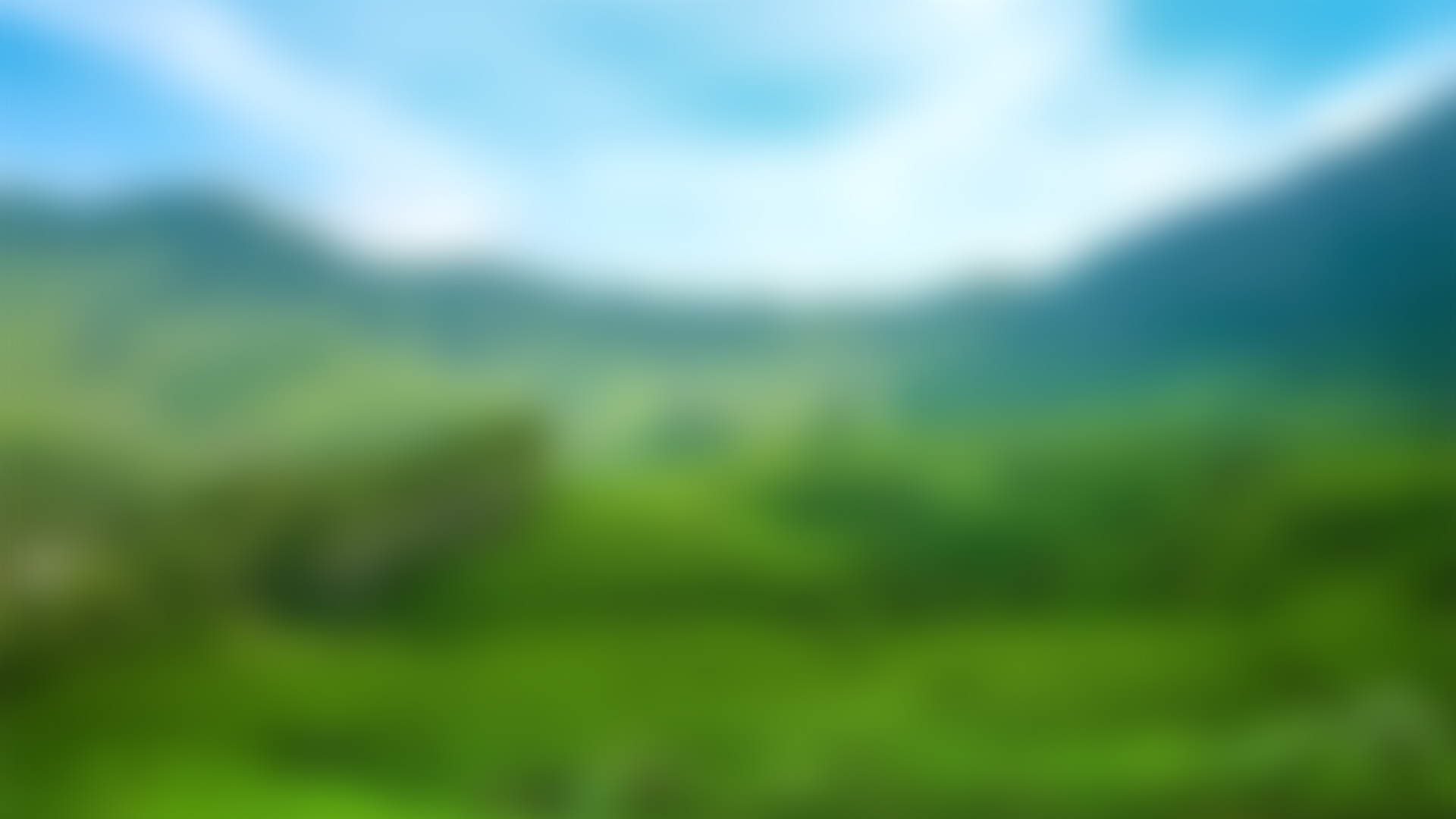
Located at a distance of 50 km from Kohima, Tseminyu is one of the...

One of the most difficult treks in Nagaland is the climb to the Japfu...

A quaint hill town village boasting ethereal natural beauty, Dzuleke...

War Cemetery
“When you go home, tell them of us and say for your tomorrow we gave...
We use cookies to ensure that you have the best experience on our website. Continued use of the website would be assumed to be an acceptance of these conditions.
Sign up to our newsletter to receive exciting content about the tourism destinations in India.
Thank you for subscribing! Explore India with us.

Trekking To The Dzukou Valley
- Post last modified: UPDATED ON: May 10, 2020
A stunning landscape of rolling hills filled with the mysterious mist, a multi-layered green cover of the bamboo plants, a multi-coloured carpet of the wild flowers and a land of the narrow rivers with crystal clear water crisscrossing each other in the middle, the peaceful and enchanting Dzukou Valley is a visual treat to the wandering souls, perhaps the most graceful 2-days trek in North East India.
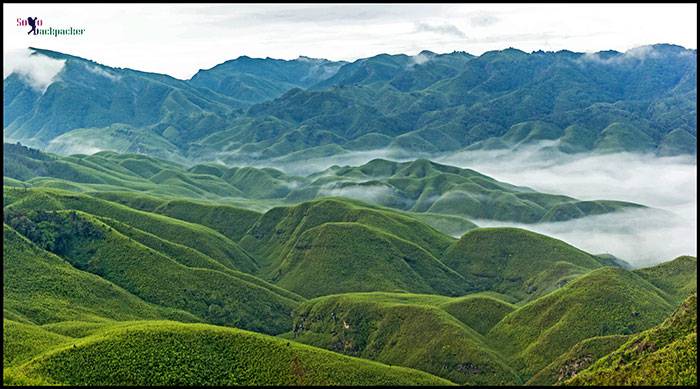
Surrounded by the mighty Japfu hill range and hidden by impenetrable forests of the wild Naga land, the trek offers a thrilling adventure– walking in the dense forests, traversing the raging rivers, meandering through the thick bamboo vegetation and living in an isolation away from the maddening crowd of a hectic urban life. Then comes the monsoon season in the month of July, when the wild flowers bloom in the valley. The hidden secret of North East India turned into a picture perfect paradise after the blooming of Dzuoku Lily and that’s why it is also perceived as the “Valley of Flowers of the North-East”.
Arrival in Kohima
Permit requirements for dzukou valley, trekking to the dzukou valley, trekking to the lower part of dzukou valley, return from dzukou valley, how to reach dzukou valley, entry fee for dzukou valley, accommodation in dzukou valley, is it possible to go solo in dzukou valley, mobile connectivity in dzukou valley.
I was desperate to explore the little paradise of North East India right from the beginning of my arrival in Guwahati, and finally decided to trek alone in the month of September. I departed from Guwahati by an overnight train to Dimapur and without any significant event reached there in the early morning.
The onward journey from Dimapur to Kohima by a shared car was an unforgettable experience. The road condition to Kohima is terribly bad, and there was only slush and mud due to the excessive rain. After 3 hours of a bumpy ride in a Maruti 800, I reached Kohima, a beautiful hill city with a ridiculously low volume of road traffic and peaceful environment. Later I realised that the low volume of traffic was because of the Sunday, the weekly holiday of the most people in Nagaland. A majority of Naga people follows Christianity, and they don’t work on the Sunday and go to the church three times in a day. Most of the shops remain shut, shared passenger vehicles don’t ply on the roads and the life comes to a standstill every Sunday.
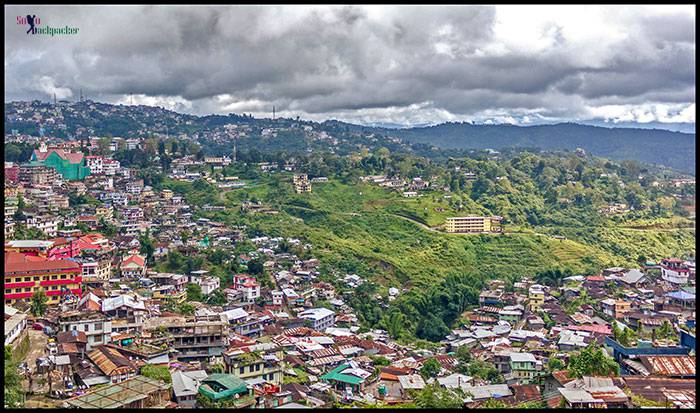
While there is no separate permit requirement to enter into the Dzukou Valley, an Inner Line Permit is required by all Indians except the residents of Nagaland to visit the state of Nagaland beyond Dimapur.
I was already having an Inner Line Permit issued in Guwahati, but in case, you reach there without a permit, you can get it from the DC office in Dimapur.
I arranged a hired vehicle somehow to drop me to Zakhama village, near the starting point of the trekking trail. I could have trekked via Vishwema Village, and it was actually a lot easier, but a hired vehicle to Vishwema village could have cost me much more. I decided to move on Dzukou Valley Trek via the Zakhama route to save a few hundred bucks.
I moved on a newly constructed unpaved road going upwards on the hill and kept asking for the precise direction from the people working in their fields. After crossing a minor river, I reached on the correct trail to the valley. During the rainy season, the river crossing could be a risky situation. Some signboards are placed at frequent intervals, but gradually they disappeared on the trail in the dense concentration of shrubs.
After a while, the vegetation grew so thick that I could not judge the trail under my feet. Imagine a situation, where you trek through the dense vegetation notorious for the poisonous snakes and you even don’t able to see the ground. I did encounter a snake, luckily on a visible trail and slightly away. Alone in a deep forest, I kept moving on the trail. Sometimes, the forest appeared so thick that it conveyed the feeling of a strange darkness in the surrounding.
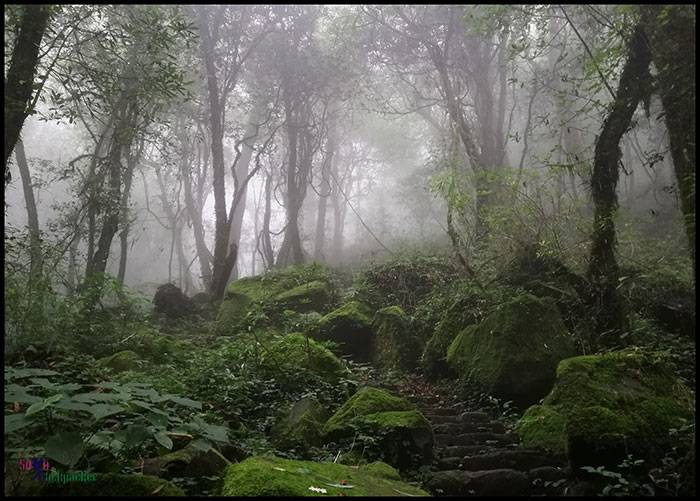
Slowly, the unpaved trail was replaced by stone boulders covered by the slippery green algae. During the dry season, the path is good to traverse with a trekking stick, but during the rain, it would be very slippery and one has to trek with extreme caution. A pair of good trekking shoes is compulsory on this trail. I met few local old women, rapidly descending on the trail through the forest without any trekking shoes, but they were the natives.
On many other trekking trails, we trek over the soil, so falling on the trail doesn’t cause any severe problem. But there on the trek to Dzukou Valley, most of the trail consists of rocks. A slight moment of carelessness can cause you to fall on the stones while breaking your feet, back, waist or something else. Therefore, it is not a pleasant experience to fall over the stones at all. A sturdy trekking shoe and a trekking stick are highly recommended on this trail.
Also Read: Trekking To Kheerganga in Himachal Pradesh- A Himalayan Heaven Of The Restless Souls
The deep forest of Dzukou Valley Trek posses many other challenges for a trekker. The other one is passing over the numerous water rivulets. When the river is dry, it is possible to navigate them without any hassle, but during the rain when they are supplied with high speed water running down from the top, it is extremely hazardous to pass over them. Few unfortunate trekkers have been swept away already in these rivulets. Due to the deposit of algae and moss, the boulders near the rivulets become very slippery. It required a lot of attention to trade them without getting hurt.
I continued moving cautiously through the lush forest for approximately 3 hours without the visible trace of a single soul. Sometimes, the enveloping clouds, impenetrable forest and profound darkness of the trail sacred me so much that kept wondering that why I was doing that. Why was I not going back? The trail is so scary in the deep forest for solo trekking. There was a potential threat of the rain due to the dense clouds over the forest. There was no proper place to find a shelter except under the trees. But luckily I had a rain jacket and a rain pant to adequately protect me from the rain.
After walking farther on the continuous trail, I fortunately found a big tin shed where four young boys were cooking something. They informed that there was around 25-30 visitors in the valley already, so there was no worry for decent shelter or proper food. That valuable news was a significant relief for me. I kept moving with renewed energy to reach at the guest house as soon as possible. Two more hours of walking and met two other boys descending through the forest. They informed that I was very closed to the valley, hardly 30 minutes of more climb was left.
I walked continuously for 15 more minutes. The sun rays were able to filter the canopy of the trees and suddenly the impenetrable darkness of the surrounding vanished with the glowing light. I looked beyond the forest and thought that I was about to reach on the top. The top edge of the pristine forest was a desired end of all suffering on that day. But, the ordeal wasn’t going over so soon.
I kept moving through the turns and twists of the forests for 30 more minutes before reaching the top edge of that deep forest. From the edge of the forest, I could see a magnificent widespread charm of Mother Nature spread in every direction in front of me. I imagined them as a green carpet of wild grasses from the distance, but a closer look revealed that they were the bamboo bushes adequately covering the entire stretch of the lovely valley. In some parts, the bushes were high enough to hide a young man, but the trekking trail is so well marked that there is hardly any chance to get lost there.
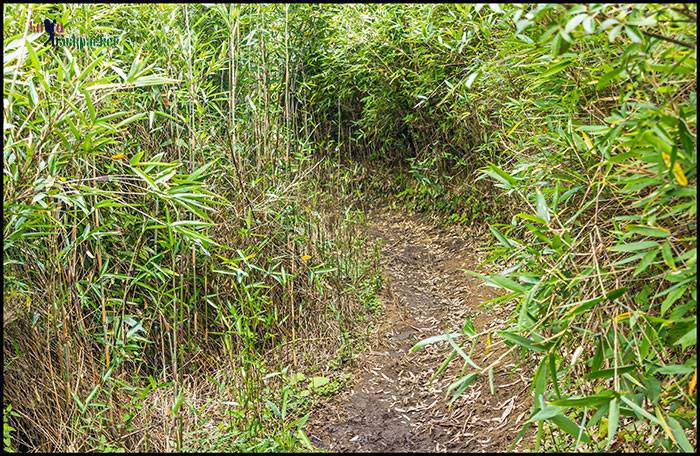
The trekking trail from the leading edge of the pristine forest of the guest house is almost flat through the bamboo bushes. As far as my eyes could see, the breathtaking views of the valley were a memorable experience. Slightly away from the marked trail, in one part of the valley, sun rays were falling gently on a limited portion after penetrating through the enveloping clouds creating a golden hue over the lush vegetation. What a view it was! It was hard to believe a landscape could be so magical. All the pain of a treacherous trek vanished instantly after seeing that breathtaking vista of nature.
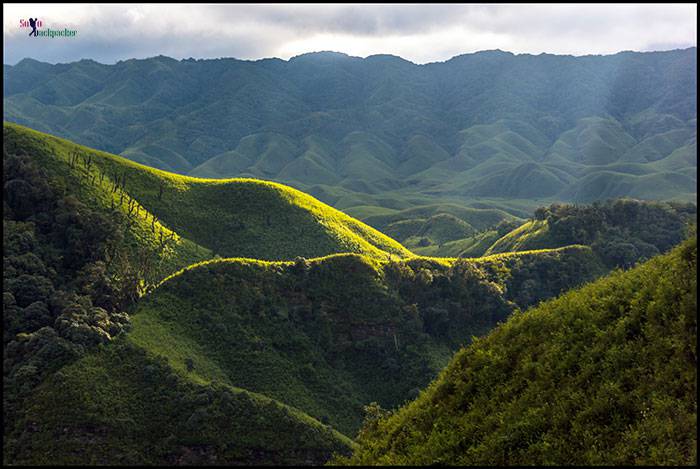
After waking for a few more minutes, I reached at the guest house, already buzzing with many young boys and girls. It was the late evening by the time I reached at that place, so there was nothing to do on that day except making few new friends and chit chatting with them.
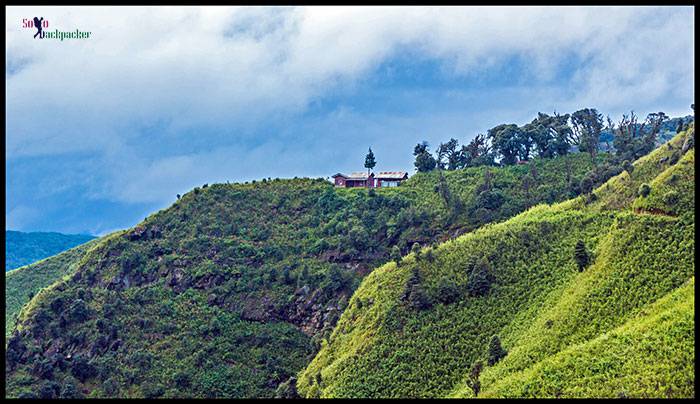
Next day, I moved ahead to explore the lower parts of the Dzukou Valley. From the guest house, a narrow path leads to the lower part of the lush valley. On the way, there is one small helipad. The helipad serves as a vantage point to click some beautiful photographs of the valley. During the rainy season, when Dzukou Lily blooms on the larger scale, the panoramic view of the valley looks beyond imagination.
I reached into the lower parts, that is covered by the wild flowers instead of the bamboo shrubs. I clicked some more pictures and walked all around the lower parts of the valley through the multi-coloured carpet of the beautiful flowers while crossing the narrow rivers filled with crystal clear water. In the month of September, the season of full bloomed Dzukou Lily had been over until then, but at few places small groups of other wild flowers were present, however.
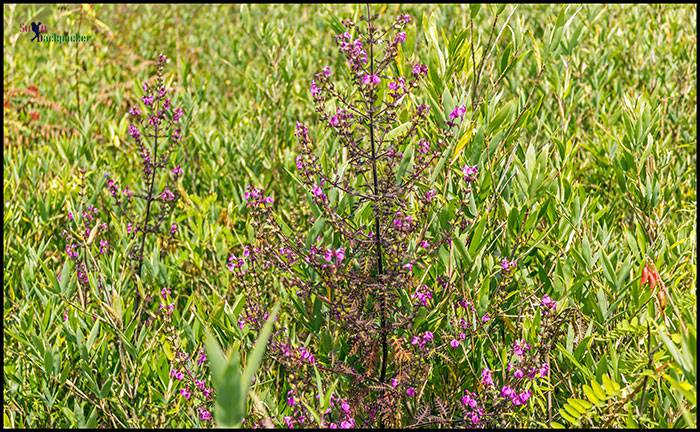
Earlier there used to be a wooden bridge on the narrow river flowing in through the valley. But, it was not there during my trip. The bridge was swept away, probably by floods. Water level in the river was low, so it was reasonably possible to cross the stream without the bridge. A Cross was visible on a distant hill, so I intended to reach there. But just below the grassy hill, the river stream was very deep and it was impossible to cross without getting wet. I promptly returned from that specific point.
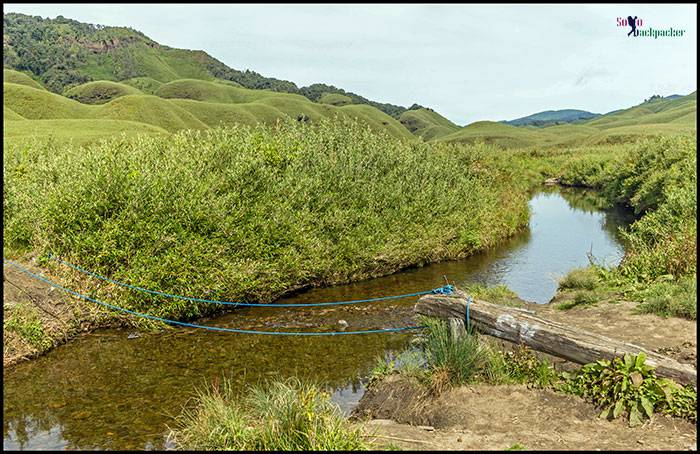
The lower part of the Dzukou valley contains a vast open ground for the camping. There is no fear of wild animals, so this part is ideally suitable for the night camping. If you carry your own tents, you can easily pitch there in the middle of that isolated paradise.
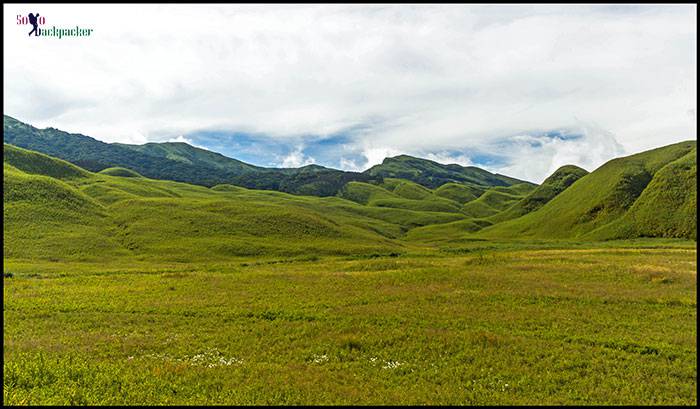
After devoting few hours in the valley, I returned to the guest house. All the fanfare at the guesthouse was already over by then. No one was there except the two caretakers. I also decided to return from the Dzukou valley, this time via Vishwema village route.
After walking for about 20-25 minutes on the same path as on the previous day, I comfortably reached at a tri-junction of three marked paths and found a signboard mentioning the Alternate Trek Route. The marked trail diverting to the left from that point is the one that goes towards Zakhama village, that I already trekked on the previous day. The trail towards the right from that point is the trail to Vishwema village, so I moved on to that path.
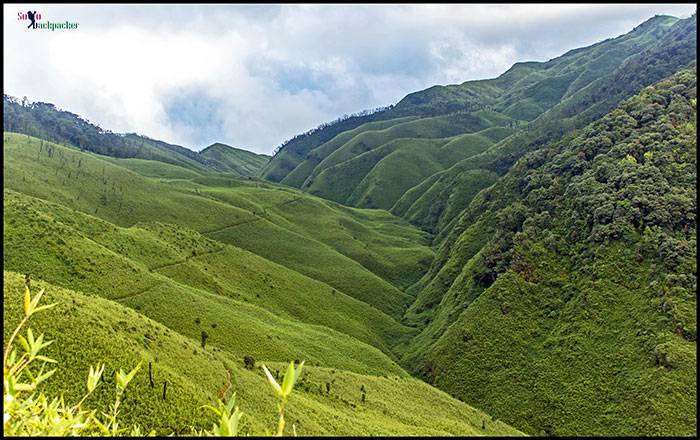
The trail is almost flat for two hours and completely covered with bamboo shrubs. At some points, the bamboo plants are so high and so dense that it is very easy to get lost. But, the trail is perfectly marked, and it is impossible to steer away from the correct path. At the faraway corner of the valley, breathtaking views await at every turn and twist of the trekking trail.
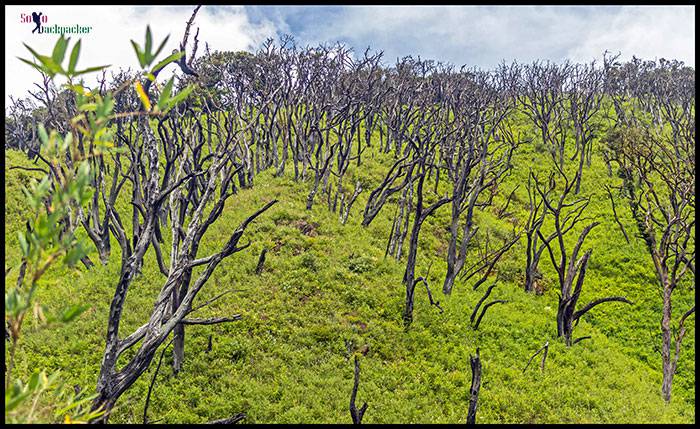
Next two hours was a pleasant walk on a flat terrain and at the end of the valley, I found a rugged trail going downwards into the deep forest. The next one hour walk was through that forest was moreover a tough ordeal, where I had to move carefully without falling down on the stones. Due to the recent rains, the path was very treacherous. I kept moving with utmost care until I reached to the lower end of the forest.
Another Trekking Experience: Trekking to Kedarnath Temple in Uttarakhand
The Dzukou Vally Trek was actually over by that time. Vishwema village was, however 8 kms away. There was no chance of getting a vehicle, so I walked on the unpaved road. The road was covered by long trees and full of water and slush. The view was so monotonous, there was no fun in the walking. Luckily, after 5 kms of walking, I found a pick van that was going towards Vishwema village. The local driver was kind enough to drop me at Vishwema village, from where I got a shared cab to Kohima.
The mesmerising Dzukou Valley is located at an altitude of approx 2438 meters near the border of Nagaland and Manipur in the North East India. It is merely 20-22 kms away from Kohima, the capital city of Nagaland. It is possible to trek in the valley from both the states, Nagaland as well as Manipur. The picturesque valley is best approached from Nagaland side, from the city of Kohima.
To reach Kohima from anywhere in India, one has to reach Dimapur first. Dimapur is considered as a key gateway to Nagaland. It is a major railhead and also served by an airport with two daily flights to Kolkata. Kohima is 75 kms away from Dimapur. The road condition from Dimapur to Kohima is significantly worse, and one has to be ready for one of the most bumpiest rides in his lifetime.
A shared sumo or car takes about 3 hours to cover the 70 km distance between Dimapur and Kohima. The shared vehicle may ask up to 400 Rupees per person, but bargaining is possible.
There are two proper ways to go to Dzukou Valley. The first preferred route starts from Zakhama village and the second from Vishwema village. A third route is also developed from Mao in Manipur, but I have very little information about this route.
Dzukou Valley From Zakhama Village: Zakhama is 16 kms away from Kohima. A shared jeep/sumo typically charges 50 rupees for half an hour journey from Kohima to Zakhama. The trail to Dzukou Valley is slightly ahead of Zakhama Village on the main road. Let the driver know in advance that you are trekking to Dzukou Valley, so that he can drop at the proper place.
If a shared vehicle is unavailable from Kohima, for example on Sunday, then it is possible to arrange a hired one by paying 450-500 Rupees. A signboard is installed there to indicate the path leading to Dzukou Valley. From the signboard, you have to trek through the deep forest for 5-hours and after that walk for 30-40 minutes in the valley to reach at the guest house, where you can stay in the night.
The trail from the Zakhama Village to the Dzukou valley is extremely steep, and the forest is significantly deeper. In the monsoon, it can be extremely challenging, very treacherous, and you have to cross fiercely flowing water streams. Most trekkers traditionally prefer this route for the return journey from Dzukou Valley.
Dzukou Valley From Vishwema Village: The another trail to Dzukou Valley starts from Vishwema village, approx 6 kms further on the main road from Zakhama village. A shared vehicle cost from Kohima to Vishwema village is 60 Rupees. Hired vehicle may charge up to 700 Rupees. A signboard is installed there to indicate the path leading to Dzukou Valley. From Vishwema Village, you have to walk for approx 8 kms on an unpaved road before the actual trekking trail starts through the forest.
This distance can be covered by a hired vehicle also, that may charge up to 800 rupees. The entire 8 kms stretch appears monotonous in landscape, so there is no fun walking on that road for 8 kms. After 8 kms, you have to trek for one hour on an extremely steep trail through the deep forest. After reaching to the edge of the valley, it is a pleasant 2 hour walk on a nearly flat path though the bamboo shrubs to arrive at the guest house. This trail is preferred by most of the trekkers for the onward journey to Dzukou Valley.
A Glimpse of Roopkund Trek in Uttarakhand: Trekking From Wan Village to Bedini Bugyal
While returning from the valley, the last shared sumo from Zakhama or Vishwema is available up to 0400-0430 PM. Plan accordingly. To be on the safe side, try to reach by 0300 PM.
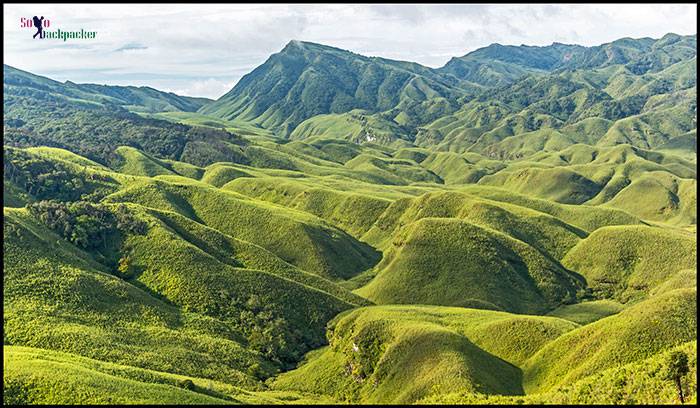
The entry fee for Dzukou Valley is 50 rupees, but there is no ticket counter to levy the entry fee. The caretaker at the guest house charges this fee with other charges related to the food and the accommodation.
During the tourist season, guest house facility is available in the valley for the night stay. Stay in the private rooms cost approx Rs 150. Two big halls are also there, that can be used as dormitories. A single hall can accommodate approx 50-60 people, but you have to sleep on the floor. Sleeping bags, mattresses, blankets, pillows are all available on the rent.
If you do not get any accommodation from the caretaker, then there are 2-3 rock shelters (like a cave) on the riverbank down in the valley from the guest house. But, it requires a lot of courage to stay in the open area in the middle of nowhere, and advisable only if you are in a group.
There are adequate arrangements in the valley for the night stay, but if you wish, you can carry your own tents also.
Yes, it is absolutely safe to trek alone in Dzukou Valley, but the conditions apply. As far as possible, do not trek Solo from Zakhama Route. The forest is really dense, and sometimes the trail is also confusing. If you have to do it, then take a local guide or try from Vishwema route. The best time to trek solo is during the Dzukou Valley Festival in the month of October, when there is a lot of possibilities to find someone on the trail.
Better to avoid trekking in the valley with the children under 10 years of age. If you have to go anyway, always go with a local guide who can help on the trails, especially if the weather gets worse suddenly in the dense forest.
I checked on Airtel, Vodafone and Reliance Jio Networks and there was no coverage at all. At few places on the trail, you may get the mobile signals, but they are very weak. Since, it’s a short duration trek, you can go to Dzukou Valley without losing contact with your family for a longer duration.
How Many Days Are Required for Dzukou Valley trek?
The trek can be easily completed in two days from Kohima, however one added day in the valley is advisable. Some people also complete it only in a single day starting early in the morning from Kohima and returning by evening.
Most Important Tip
This is North-Eastern part of India, so keep in mind that it can rain anytime. When it rains, it rains heavily.
The Dzukou Valley Trek is in fact a short expedition for 2-3 days only, but still there is plenty of adventure in this trek. After reaching the ultimate destination, the breathtaking views of Dzukou Valley are unmatched and unparalleled. It is also possible to add a few more days in the trip itinerary to properly cover the nearby Jafpu peak. Carefully add some village tours to the picturesque villages around Kohima, and you can undoubtedly enjoy a memorable trip in the mysterious land of the Nagas.
Related Posts
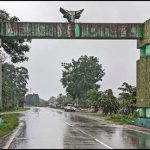
Please Share This Share this content
- Opens in a new window
This Post Has 2 Comments
Very Good information & nice write up
Thank You Sir.
Leave a Reply Cancel reply
Winter is here! Check out the winter wonderlands at these 5 amazing winter destinations in Montana
- Travel Destinations
Dzükou Valley Trek: Your Ultimate Guide To India’s Famous Hike
Published: September 8, 2023
Modified: December 27, 2023
by Dredi Conaway
- Plan Your Trip
- Travel Guide
- Travel Tips
Introduction
Welcome to Dzükou Valley, one of India’s most renowned and picturesque treks. Nestled in the state of Nagaland, this hidden gem offers a breathtaking landscape filled with rolling hills, lush greenery, and vibrant flowers. It is a haven for nature enthusiasts, adventure seekers, and photographers alike. Dzükou Valley is often referred to as the “Valley of Flowers” of the Northeast, drawing visitors from far and wide to behold its natural beauty.
The trek to Dzükou Valley presents an opportunity to escape the hustle and bustle of city life and immerse oneself in the tranquility of Mother Nature. The journey takes you through dense forests, across crystal-clear streams, and up steep slopes, rewarding you with awe-inspiring views at every turn. Whether you are an experienced trekker or a beginner, Dzükou Valley offers an unforgettable experience that will leave a lasting impression.
For those seeking a unique and off-the-beaten-path adventure, Dzükou Valley delivers. Its remote location and relatively untouched surroundings make it a destination that is truly worth exploring. As you traverse the trail, you will discover the rich biodiversity of the region, encounter rare species of flora and fauna, and have the opportunity to witness indigenous Naga culture along the way.
Throughout this ultimate guide, we will provide you with all the necessary information to plan your Dzükou Valley trek. From getting there to choosing the best time to visit, obtaining permits, and identifying camping spots, we have you covered. We will also share safety tips, insights into the local flora and fauna, and even offer some photography pointers to help you capture the beauty of this remarkable destination.
So, tighten your backpack straps, put on your hiking boots, and get ready to embark on an adventure of a lifetime in Dzükou Valley. Let’s dive into the details that will make your trip a memorable one!
Getting to Dzükou Valley
Situated in the northeastern state of Nagaland, reaching Dzükou Valley requires a bit of effort, but the journey is well worth it once you witness the natural splendor that awaits you. The nearest major city to Dzükou Valley is Kohima, the capital of Nagaland. Here are the various modes of transportation to consider:
By Air: The nearest airport to Dzükou Valley is Dimapur Airport, which is well-connected to major Indian cities. From Dimapur, you can hire a taxi or take a shared cab to Kohima, which is approximately 70 kilometers away. The scenic drive to Kohima takes around 3-4 hours.
By Train: The closest railway station to Dzükou Valley is also located in Dimapur. Regular train services connect Dimapur to various cities across the country. After reaching Dimapur, you can follow the same route as mentioned above, either by hiring a taxi or taking a shared cab to Kohima.
By Road: If you prefer road travel, you can drive to Kohima from nearby cities like Guwahati or Imphal. The road journey to Kohima offers magnificent views of the rolling hills and is an adventure in itself. Alternatively, you can also take state-run buses or shared taxis from nearby towns and cities to reach Kohima.
Once you have reached Kohima, you will need to make your way to the base camp of the trek, which is at Jakhama village. From Kohima, it’s a short drive of about 16 kilometers to reach Jakhama. At Jakhama, you will find local guides, trek operators, and porters who can assist you in organizing your trek to Dzükou Valley.
Now that you know how to get to the starting point of the trek, let’s move on to the next section to discover the best time to visit Dzükou Valley, as this will greatly impact your overall experience.
Best Time to Visit
Dzükou Valley experiences different seasons throughout the year, and the best time to visit depends on your preferences and the kind of experience you are seeking. Here are the two main seasons to consider:
Spring (April to May): Spring is considered the best time to visit Dzükou Valley. During this time, the valley is in full bloom with a spectacular display of colorful flowers, including lilies, rhododendrons, and wildflowers. The entire valley transforms into a vibrant carpet of blossoms, creating a picture-perfect scene that is every photographer’s dream. The weather is mild, with temperatures ranging from 10°C to 20°C, making it ideal for trekking and outdoor activities.
Autumn (September to October): Autumn is another favorable time to visit Dzükou Valley. The monsoon rains have subsided, leaving behind fresh green foliage and clear skies. The temperature during autumn ranges from 15°C to 25°C, providing comfortable trekking conditions. The valley retains its verdant beauty, and the weather is generally pleasant, allowing for stunning panoramic views of the surrounding landscape.
It’s worth noting that Dzükou Valley experiences heavy rainfall during the monsoon season, which extends from June to August. While the valley is still accessible during this time, the trails can be slippery and the weather unpredictable. However, if you are a monsoon lover and enjoy the lush greenery, you can visit Dzükou Valley during the monsoon season, but do exercise caution and be prepared for the weather conditions.
Ultimately, the choice of the best time to visit Dzükou Valley depends on your personal preferences. To make the most of your trip, it is advisable to check the weather conditions and consult with locals or trek operators for up-to-date information.
Now that you know when to go, let’s proceed to the next section to learn about the permits and entry fees required for a Dzükou Valley trek.
Permit and Entry Fees
Before embarking on your trek to Dzükou Valley, it is important to obtain the necessary permits and pay the required entry fees. This ensures that your visit is authorized and contributes to the maintenance and preservation of the valley. Here’s what you need to know:
Permit: All visitors, including Indians and foreigners, need an Inner Line Permit (ILP) to enter Nagaland. The ILP can be obtained online through the Nagaland Tourism website or from Nagaland House in major cities like Delhi, Kolkata, or Guwahati. The ILP is valid for a specific duration, so make sure to plan your trek accordingly.
Entry Fees: Once you have obtained the ILP, you will be required to pay an entry fee at the starting point of the trek. The entry fee varies depending on your nationality. Indian citizens typically have a lower fee compared to foreign nationals. The entry fee contributes to the maintenance of the trekking trails, conservation efforts, and the overall management of the valley.
It is essential to carry your ILP and payment receipts with you throughout the trek, as they may be checked at various checkpoints along the way. Failure to produce the necessary documents can result in fines or even denial of entry. It is advisable to keep multiple copies of your ILP and receipts in case of loss or damage.
To ensure a hassle-free experience, it is recommended to plan and apply for your permits well in advance. Check the official government websites for updated information on the permit process, fees, and any additional requirements.
Now that you are aware of the permits and fees, let’s move on to the next section to explore the difficulty level of the Dzükou Valley trek and what to expect along the way.
Trek Difficulty Level
The Dzükou Valley trek offers a moderate level of difficulty, making it suitable for both experienced trekkers and beginners with a good level of fitness. Here’s what you can expect in terms of the trek’s difficulty:
Trail Condition: The trail can vary in difficulty depending on the route chosen. The most common route starts from Jakhama village, which involves a steady climb to the valley. The path is well-marked and maintained, but there are steep ascents and descents along the way. Some sections may be rocky or muddy, especially during the monsoon season. It is essential to wear proper trekking shoes and be cautious while navigating challenging terrain.
Duration: The trek to Dzükou Valley from Jakhama village usually takes around 4-6 hours, depending on your pace and agility. It is advisable to start early in the morning to avoid trekking during the hottest part of the day and to allow sufficient time for exploration and photography in the valley.
Altitude: Dzükou Valley is located at an elevation of approximately 2,438 meters (8,000 feet) above sea level. While this altitude is not extremely high, it is still advisable to acclimatize gradually and pace yourself during the ascent. If you experience any symptoms of altitude sickness, such as headaches, dizziness, or shortness of breath, it is important to rest and descend if necessary.
Physical Fitness: A moderate level of physical fitness is required for the Dzükou Valley trek. Regular exercise, including cardiovascular activities and strength training, can help prepare your body for the climb. It is also advisable to engage in pre-trek training and stretching exercises to improve endurance and flexibility.
Porters and Guides: If you prefer, you have the option to hire local porters or guides to assist you during the trek. They can help carry your backpack and provide valuable insights about the trail, ensuring a smoother and more enjoyable experience.
It is important to assess your own abilities and fitness level before attempting the Dzükou Valley trek. Listen to your body, stay hydrated, and take breaks as needed. Remember, it is not a race but a journey to be savored and enjoyed.
With an understanding of the trek’s difficulty level, let’s proceed to the next section to explore the different route options available for the Dzükou Valley trek.
Route Options
The Dzükou Valley trek offers various route options, each with its own unique charm and characteristics. The route you choose will determine the duration and level of difficulty of your trek. Here are the main route options:
Jakhama Route: The Jakhama route is the most popular and frequently chosen option. It starts from Jakhama village, located near Kohima. This route is well-marked and relatively easier compared to the other routes. It takes approximately 4-6 hours to reach Dzükou Valley, depending on your pace and rest breaks along the way. The Jakhama route offers breathtaking views of the surrounding hills and villages.
Viswema-Zakhama Route: The Viswema-Zakhama route is another feasible option for reaching Dzükou Valley. It starts from Viswema village, which is located close to Kohima, and ends at Zakhama village. This route offers a more challenging and adventurous experience with rugged terrain and steep slopes. It takes around 5-7 hours to complete this route, depending on the weather conditions and your fitness level.
Alternative Routes: Aside from the two main routes mentioned above, there are a few additional options for reaching Dzükou Valley. These routes, such as the Dziikou-Behen and Dziikou-Khozienuo routes, are less frequented and require more time and preparation due to their remote and challenging nature. These routes are suitable for experienced trekkers looking for a more off-the-beaten-path experience.
Regardless of the route you choose, it is advisable to consult with local guides or trek operators who have in-depth knowledge of the trail conditions and can provide guidance based on your preferences and skill level. They can also ensure your safety and help navigate any difficulties that may arise during the trek.
Now that you are familiar with the various route options, let’s move on to the next section, which covers camping and accommodation facilities in Dzükou Valley.
Camping and Accommodation
When trekking to Dzükou Valley, camping is the most popular option for accommodation, allowing you to immerse yourself fully in the beauty of the surroundings. Here’s what you need to know about camping and accommodation in Dzükou Valley:
Camping: There are several camping sites available in Dzükou Valley, offering stunning views and a serene atmosphere. Most trekkers prefer to set up their tents near the stream that flows through the valley, providing a picturesque backdrop. It is important to bring your own camping gear, including a sturdy tent, sleeping bag, and camping stove for cooking meals. Make sure to follow ethical camping practices, such as leaving no trace and respecting the environment.
Accommodation: If you prefer not to camp, there are limited accommodation options available near the base camp in Jakhama village. These accommodations range from guesthouses to homestays, providing a comfortable and convenient place to stay before and after the trek. It is advisable to book in advance, especially during peak seasons, to secure a room.
Whether you choose to camp or stay in a guesthouse, it is important to be prepared and carry essential supplies, including food, drinking water, and basic amenities. There are no shops or restaurants in Dzükou Valley, so packing enough provisions for the duration of your stay is crucial.
While camping in Dzükou Valley is a rewarding and memorable experience, it is important to keep the surroundings clean and maintain a responsible and sustainable approach to camping. Respect the environment, wildlife, and local culture, and remember to dispose of waste properly.
Now that you know about camping and accommodation options, let’s move on to the next section, where we will discuss important safety tips to ensure a smooth and secure trekking experience in Dzükou Valley.
Safety Tips
Ensuring your safety is paramount when embarking on the Dzükou Valley trek. Here are some essential safety tips to keep in mind during your journey:
1. Plan and prepare: Before starting the trek, research and gather all necessary information about the trail, weather conditions, and required permits. Plan your route and carry a detailed map or guidebook.
2. Physical fitness: Maintain a good level of fitness before the trek. Engage in regular exercise and pre-trek training to build endurance and strength. Consult your doctor if you have any medical conditions or concerns.
3. Weather conditions: Check the weather forecast thoroughly before starting the trek. Be prepared for changes in weather and carry appropriate clothing layers to adjust to temperature fluctuations.
4. Trek in a group or with a guide: It is recommended to trek with a group or hire a local guide who is familiar with the trail and can provide assistance and support throughout the journey.
5. Stay hydrated and carry sufficient supplies: Carry an adequate amount of drinking water and stay hydrated during the trek. Pack enough food and snacks to sustain your energy levels throughout the day.
6. Pack essential trekking gear: Ensure you have the necessary trekking gear, including sturdy hiking boots, comfortable clothing, a raincoat or poncho, a headlamp, a first aid kit, and sunscreen.
7. Be mindful of altitude and acclimatization: If you are not accustomed to high altitudes, take necessary precautions to acclimatize gradually. Ascend slowly and listen to your body. If you experience symptoms of altitude sickness, descend immediately.
8. Carry emergency essentials: Pack emergency essentials such as a whistle, a flashlight, a multifunctional tool, a mobile phone, and extra batteries. These items can be crucial in case of unforeseen circumstances.
9. Follow trail markers and stay on the designated path: Pay attention to trail markers and follow the designated path to avoid getting lost. Straying off the trail can be dangerous and may lead to difficult or inaccessible terrain.
10. Respect the environment and local culture: Leave no trace behind and respect the environment, wildlife, and local culture. Do not disturb or harm flora and fauna, and be mindful of the unique traditions and customs of the region.
By adhering to these safety tips, you can minimize risks and ensure a safe and enjoyable trekking experience in Dzükou Valley.
Now that you are aware of the safety precautions, let’s move on to the next section to discover the diverse flora and fauna that Dzükou Valley has to offer.
Flora and Fauna
Dzükou Valley is renowned for its rich biodiversity, boasting a stunning array of flora and fauna. Let’s explore the diverse natural wonders that await you in this picturesque valley:
Flora: The valley is often referred to as the “Valley of Flowers” for good reason. Dzükou Valley is home to a wide variety of flowering plants, including rhododendrons, lilies, orchids, and wildflowers of vibrant colors. During the spring season, the valley transforms into a carpet of blooming flowers, creating a breathtaking sight that attracts nature enthusiasts and photographers from around the world.
Aside from flowers, Dzükou Valley also features dense foliage, with a mix of evergreen and deciduous trees. Bamboo groves, ferns, and mosses can be found along the trails, adding to the valley’s mystical charm.
Fauna: The valley is not just a paradise for plant lovers; it is also a haven for wildlife. While wildlife sightings are relatively rare due to the dense vegetation, lucky trekkers may have the opportunity to spot some fascinating species. Common sightings include Asian black bears, leopard cats, barking deer, and various species of birds, such as pheasants, hornbills, and sunbirds.
For birdwatching enthusiasts, Dzükou Valley offers a true delight. The valley is home to a diverse avian population, with a range of species native to the region. You may catch a glimpse of colorful birds like the Blyth’s Tragopan, the Rusty-cheeked Scimitar-Babbler, or the beautiful Naga Wren Babbler.
The pristine wilderness of Dzükou Valley provides a unique habitat for these flora and fauna, making it a special destination for nature lovers. While exploring the valley, remember to maintain a respectful distance from the wildlife and refrain from disturbing their natural environment.
Now that you have gained insight into the ecological wonders of Dzükou Valley, let’s move on to the next section, where we will provide some valuable tips for photographers aspiring to capture the beauty of this enchanting destination.
Tips for Photographers
Dzükou Valley offers a plethora of photographic opportunities, with its stunning landscapes and vibrant flora. Whether you are a professional photographer or an amateur enthusiast, here are some valuable tips to help you capture the beauty of this enchanting destination:
1. Research and plan: Before you embark on the trek, research the best viewpoints and areas within Dzükou Valley that offer the most photogenic scenes. Plan your itinerary accordingly to optimize your time and make the most of the available light conditions.
2. Capture the changing seasons: Dzükou Valley exhibits different colors and moods throughout the year. Capture the valley in different seasons, from the blooming flowers of spring to the lush green foliage of autumn. Each season offers a unique charm and photographic opportunities.
3. Utilize the golden hours: The soft golden light during sunrise and sunset creates a magical atmosphere in Dzükou Valley. Make sure to wake up early and stay out late to capture the beautiful play of light and shadows on the landscape. The golden hours provide a warm and stunning ambiance to your photographs.
4. Experiment with perspectives: Don’t be afraid to get creative with your compositions. Explore different angles and perspectives to add depth and drama to your photographs. Get down low, shoot from up high, or use interesting foreground elements to create visually captivating images.
5. Showcase the flora and fauna: Dzükou Valley is known for its diverse vegetation and wildlife. Capture the delicate beauty of flowers, the intricate details of ferns, or the elusive wildlife amidst the foliage. Zoom in on the unique features of the flora and fauna to create captivating close-up shots.
6. Use a wide-angle lens: A wide-angle lens allows you to capture the vastness and grandeur of the valley’s landscapes. It can help emphasize the scale of the surrounding hills, the winding trails, and the expansive sky. Experiment with different focal lengths to find the perfect balance in your compositions.
7. Be patient and observant: Nature has its own rhythm, and sometimes capturing the perfect shot requires patience and observation. Take your time, be mindful of the changing light and weather conditions, and be ready to capture those fleeting moments of magic.
8. Carry essential photography gear: Make sure to pack your camera, extra batteries, memory cards, tripod, and filters. The weather in the valley can be unpredictable, so protect your gear with waterproof covers or bags.
9. Respect the environment: While photographing the valley, ensure that you do not disturb the flora, fauna, or the local ecosystem. Follow ethical practices like staying on designated paths, not trampling or plucking flowers, and leaving no trace behind.
10. Immerse yourself in the experience: Lastly, remember to immerse yourself in the beauty of Dzükou Valley. Take moments to soak in the tranquility and let the awe of the surroundings inspire your photography. Enjoy the journey, and let your passion for photography shine through in each frame.
With these tips in mind, you are ready to capture the breathtaking beauty of Dzükou Valley through your lens.
Now, let’s conclude our ultimate guide to the Dzükou Valley trek by summarizing the key points and highlighting the unforgettable experiences that await you in this natural wonderland.
The Dzükou Valley trek is a remarkable adventure that showcases the mesmerizing beauty of Nagaland. With its breathtaking landscapes, vibrant flora, and elusive fauna, this hidden gem offers an unforgettable experience for nature enthusiasts, adventure seekers, and photographers.
From the moment you begin your journey from Jakhama village, you will be enthralled by the lush greenery, captivating vistas, and the serene atmosphere that surrounds you. The trek to Dzükou Valley presents opportunities to challenge yourself physically and mentally while immersing yourself in the tranquil embrace of Mother Nature.
Whether you visit during the spring when the valley transforms into a vibrant sea of flowers or during the autumn when the landscape shines in shades of green, you will be rewarded with awe-inspiring panoramic views that will take your breath away.
As you trek through the valleys and climb the hills, be sure to appreciate the diverse flora and fauna that thrive in this pristine ecosystem. From the delicate blossoms of various flowers to the elusive wildlife that resides amidst the dense vegetation, Dzükou Valley offers a captivating natural spectacle.
Remember to plan ahead, obtain the necessary permits, and take precautions to ensure your safety throughout the trek. Practice responsible camping, respect the environment, and leave no trace behind to help preserve the natural beauty of Dzükou Valley for future generations.
Whether you are an experienced trekker or a novice adventurer, Dzükou Valley welcomes you with open arms. It is a place where you can reconnect with nature, challenge your limits, and create lifelong memories.
So, pack your bags, lace up your boots, and embark on a journey to Dzükou Valley. Let the serenity of the surroundings calm your soul and the breathtaking landscapes ignite your passion for exploration. The adventure awaits, ready to unveil its hidden treasures in this exquisite corner of India.

- Privacy Overview
- Strictly Necessary Cookies
This website uses cookies so that we can provide you with the best user experience possible. Cookie information is stored in your browser and performs functions such as recognising you when you return to our website and helping our team to understand which sections of the website you find most interesting and useful.
Strictly Necessary Cookie should be enabled at all times so that we can save your preferences for cookie settings.
If you disable this cookie, we will not be able to save your preferences. This means that every time you visit this website you will need to enable or disable cookies again.
- Logout Login
- Adventure Holidays
- Weekend Getaways
- Driving Holidays
- Travel News
Top Searches
Amarnath Yatra 2024
Gulmarg Travel
World Heritage Sites
Manali Travel
India's Largest National Park
A beginner’s guide to Dzukou Valley in Nagaland
Precious Rongmei Precious Rongmei / TIMESOFINDIA.COM / Created : Feb 12, 2023, 09:07 IST
You're Reading
The Dzukou Valley in Nagaland and Manipur is a beautiful and tranquil place that is popular among tourists. The valley is located at an altitude of 2452m above sea level and is surrounded by dense forests. The village authorities … Read more
The Dzukou Valley in Nagaland and Manipur is a beautiful and tranquil place that is popular among tourists. The valley is located at an altitude of 2452m above sea level and is surrounded by dense forests. The village authorities have devised a plan to keep the site pristine and have made it a plastic-free zone. Read less

More from Travel News

- How far is Dzukou Valley from Khonoma? Dzukou Valley is approximately 12 km from Khonoma.
- Is Dzukou Valley trek an easy trek? The initial section of the trek, the uphill climb is extremely difficult. Make sure you have comfortable yet sturdy shoes on.
- Where to stay in Dzukou Valley? There is a provision for a dormitory and private rooms. Also, you can pitch your own tent.
Comments (0)

Refrain from posting comments that are obscene, defamatory or inflammatory, and do not indulge in personal attacks, name calling or inciting hatred against any community. Help us delete comments that do not follow these guidelines by marking them offensive . Let's work together to keep the conversation civil.
Comments ( ) Sort: Newest UpVoted Oldest Discussed Down Voted closecomments

SIGN IN WITH
Or post without registration.

Visual Stories

Popular Galleries
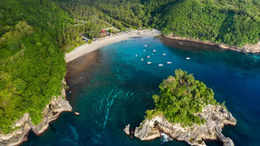
7 incredible Asian beaches that you will want to keep secret! TRAVEL TRENDS

Most photogenic destinations in Uttarakhand to explore this summer TRAVEL TRENDS , UTTARANCHAL

These destinations in India are perfect for slow travel TRAVEL TRENDS , INDIA
Trending stories.
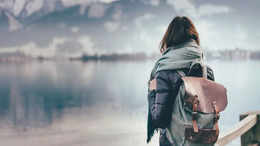
10 Hollywood movies that inspired us to travel!

7 incredible Asian beaches that you will want to keep secret!

Beyond wildlife safari in national parks: 6 must-do activities

- Ladakh: 5 reasons to visit Hemis National Park, India's largest national park

Nagarhole National Park: A pictorial journey through this natural heritage site
- 1 A beginner’s guide to Dzukou Valley in Nagaland
- 2 Go on a walking safari inside Satpura National Park; here’s why
- 3 Watch Kurdi village play hide-and-seek in Goan summer
- 4 Bookmark this! Nepal’s Khumbu region is a treasure trove of unique attractions
- 5 All you need to know about Hemis National Park, the largest national park in India

THE DEFINITIVE GUIDE TO DESTINATIONS, ITINERARIES, THINGS TO DO, RESTAURANTS, NIGHTLIFE and LOTS MORE!
FOLLOW US ON
Places to visit.
- Places to visit in Bangalore
- Places to visit in Mumbai
- Places to visit in Delhi
- Places to visit in Goa
- Hotels in Goa
- Hotels in Jaipur
- Hotels in Shimla
- Hotels in Mumbai
Things To do
- Things to do in Goa
- Things to do in Mumbai
- Things to do in Bangalore
- Things to do in Delhi
Travel Inspiration
- Visa on arrival for Indians
- Honeymoon Places in india
- Hill Stations in India
- Weekend getaways in Mumbai
- Weather in Delhi
- Weather in Chennai
- Weather in Bangalore
- Weather in Mumbai
Best Beaches
- Goa Beaches
- Mumbai Beaches
- Pondicherry Beaches
- Kerala Beaches
- Restaurants in Bangalore
- Restaurants in Chennai
- Restaurants in Pune
- Restaurants in Jaipur
- Hill Station near Delhi
- Winter trip to Ladakh
- Places to visit in Kerala
- Winter Honeymoon Destinations
- UK visa guide for Indians
- Winter Trip to Manali
- Vaishno Devi Yatra
- Special Train Ticket Booking
- HP inter-state Bus
- Honeymoon Destinations India
Latest News
Congratulations.
You have been successfully added to the mailing list of Times of India Travel. To complete the subscription process, kindly open your inbox and click on the confirmation link which has been emailed to you.
Share with friends
Thank You for sharing! Your friend will receive the article link on email mentioned.
- (For more than one recipient, type addresses separated by commas)
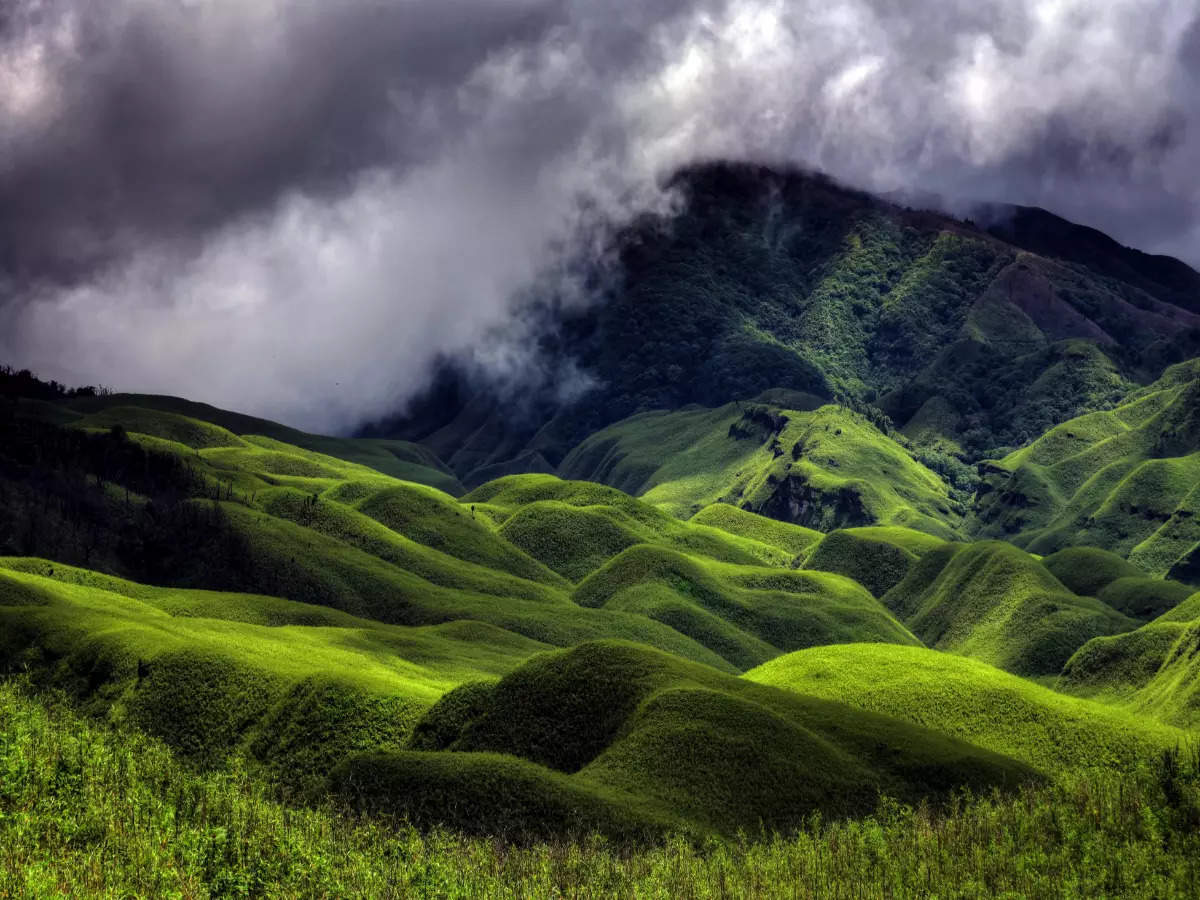
The Dzukou Valley in Nagaland and Manipur is a beautiful and tranquil place that is popular among tourists. The valley is located at an altitude of 2452m above sea level and is surrounded by dense for...
How It Works
- Tell us details of your holiday plan.
- After you submit the form, one of our travel experts will get back to you with customised holiday package based on your requirement, within 24 hours.
- Grab the deal and start packing your bags for an indelible holiday with Tour My India.
Call Us for details
+91-9212777225
Request a quote.
North India
- Himachal Pradesh
- Uttarakhand
- Uttarpradesh
South India
- Andhra Pradesh
- Maharashtra
Central India
- Madhya Pradesh
- Chhattisgarh
Union Territories
- Andaman and Nicobar Islands
- Jammu Kashmir
- Dadra and Nagar Haveli
- Daman and Diu
Popular India Tourism Destinations by Interest

- Hill Station
- Yoga and Ayurveda
Adventure Tourism
- Motor Biking
- Peak Climbing
- Mountain Biking
- River Rafting
- Horse Safari
- Camel Safari
- Jeep Safari
Pilgrimage Tourism
- Christianity
Packages by State
- Jammu & Kashmir
Holidays by Interest
- Heritage Tours
- Ayurveda Tours
- Special Interest
Popular Tour Packages
- Golden Triangle Tour
- Classical India Tour
- Golden Triangle with Tiger Tour
- Sikkim Darjeeling Tour
- Frozen River Trek
Luxury Train Tour
- Palace on Wheels
- Heritage on Wheels
- Maharaja Express
- Royal Rajasthan on Wheels
- Buddhist Circuit Train
Special Packages
- Indian Wildlife Tour
- Temple Trails Tour India
- Buddhist Circuit Tours
- Himalayan Wonder
Fixed Departure Tour
- Chadar Trek
- Chopta - Chandrashila Trek
- Snow Leopard
- Dzongri Goecha La Trek
- Agra Hotels
- Jaipur Hotels
- Udaipur Hotels
- Manali Hotels
- Ladakh Hotels
Wildlife Resorts
- Ranthambore National Park
- Bandhavgarh National Park
- Corbett National Park
- Kanha National Park
- Pench National Park
- Tadoba National Park
Beach Resorts
- The Park Calangute
- Neelam the Grand
- Hotel Calangute Towers
- Alor Holiday Resort
- Lazy Lagoon Sarovar Portico Suites
Luxury Hotels
- Aman-i-Khas, Ranthambore
- Hyatt, Bangalore
- Hyatt Regency, Delhi
- Leela Palace, Udaipur
- ITC Grand Chola, Chennai
Top Weekend Breaks & Short Getaways Near Your City
- Weekend Getaways Delhi
- Weekend Getaways Mumbai
- Weekend Getaways Chennai
- Weekend Getaways Bangalore
- Weekend Getaways Nagpur
- Weekend Getaways Hyderabad
- Weekend Getaways Cochin
- Weekend Getaways Chandigarh
- Weekend Getaways Ahmedabad
- Weekend Getaways Pune
- Weekend Getaways Jaipur
- Flight Booking
- International NEW
International

States › Nagaland › Kohima › Dzukou Valley
Dzukou Valley Kohima
Also known as the Valley of Flowers, the Dzukou Valley is one of the most visited tourist attractions in the North East. Located at an altitude of 2450 meters, it is considered to be one of the most famous adventure spots in Kohima, Nagaland. It is located behind the Japfu range, another important travel destination for tourists in the state.
Mostly visited during the full bloom season, the beauty of the valley is best appreciated when lilies in white and pink, aconitums, euphorbias, and hundreds of other botanical species in varied colours adorn the valley in monsoon.
Popular things to do & see in and around
If you are an avid trekker and love the nature, explore the 3-4 kilometer steep climb to this exotic valley. A 17 kilometer trek from Viswema Village to Dzukou will take you 5-6 hours. And another trek from Dzukou Valley to Zakhama, 15 kilometers, will take you about 3-4 hours.
Dzukou Valley is located just 30 kilometers from Kohima, you can stop by the shops at the city center and pick up some souvenirs for family and friends back at home. You can also shop for local handicrafts and textiles. Stop by at local restaurants to interact with the Nagas and taste their typical cuisine of dried pork, steam bamboo fish and more.
You can carry forward the trek to the village on foot thereafter. The natural beauty enroute the trekking path is worth all the hardships. You can also take rest at the shelters made on the way and sit back and enjoy the greenery surrounding you.
You can also trek to the Japfu range and camp at the peak, which offers a splendid view of the entire valley.
You can also explore the natural caves and rocks to get familiar with the countryside.
Getting There
You can either take a bus or a cab from Kohima to Viswema Village or Zakhama. It will take you about 20-25 minutes by car. Guides and porters can also be hired, although the trekking pathway is well paved and there are a number of sign boards to show you the way.

There are no special permits required for the Dzukou Valley. However, an entry fee of Rs 30 per person is required.
You can avail the rental cabs from Dimapur, which is connected with some of the most important cities in the country. Similarly, you get taxis from Dimapur railway station, which is connected to Guwahati and Kolkata.
Best Time to Visit
One of the most important places to visit in the North East, the Valley of Celestial Charm is best visited between June and September, i.e., the full bloom season.
Top Things to Do & Places to See in Kohima

Japfu Peak Kohima

Heritage DC Bungalow Kohima

Touphema Village Kohima

Intanki Wildlife Sanctuary Kohima

Catholic Church Kohima

Naga Heritage Village Kohima

Kohima Museum Nagaland

Kohima War Cemetery Nagaland

Kohima Botanical Garden Nagaland
Hotels in and around kohima.
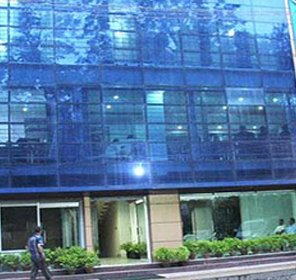
The Blue Bayou
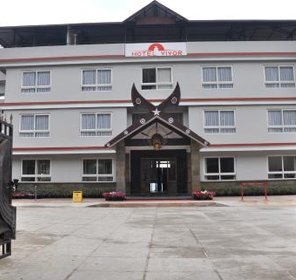
Hotel Vivor
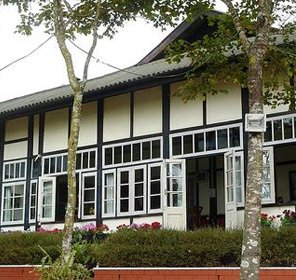
The Heritage
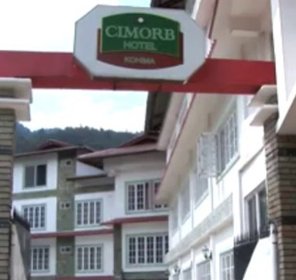
Cimorb Hotel
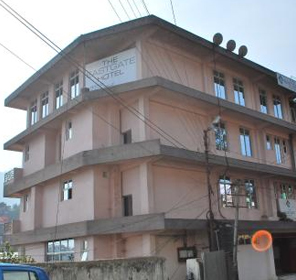
The Eastgate Hotel
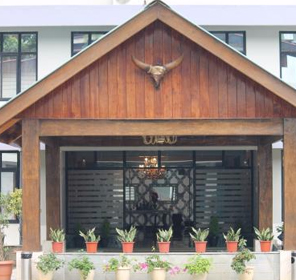
De Oriental Grand Hotel
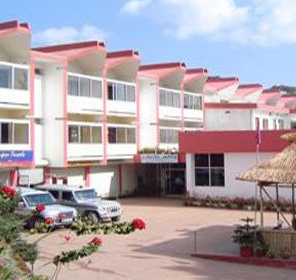
Hotel Japfu
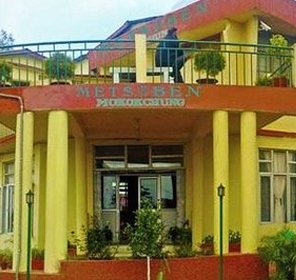
Hotel Metsuben
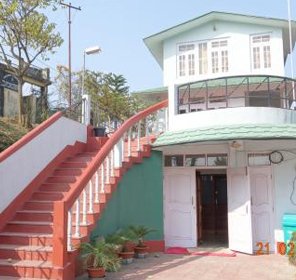
Whispering Winds
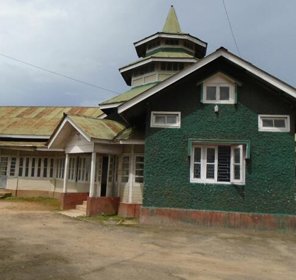
Circuit House
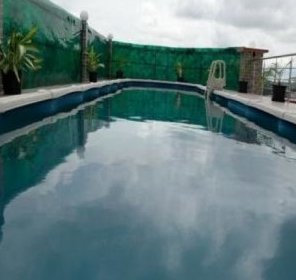
Hotel Lake Shilloi
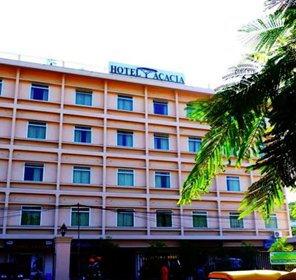
Hotel Acacia
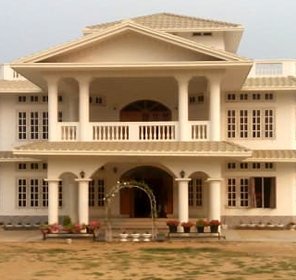
Hotel Pink City
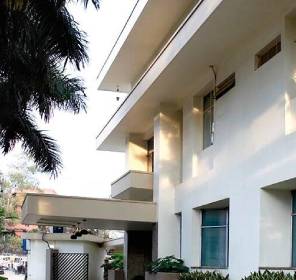
Hotel Tragopan
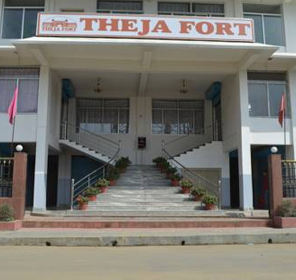
Hotel Theja Fort
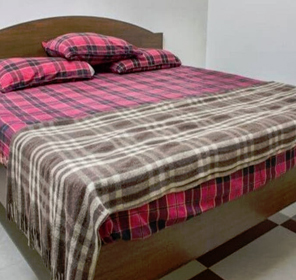
Niathu Resort
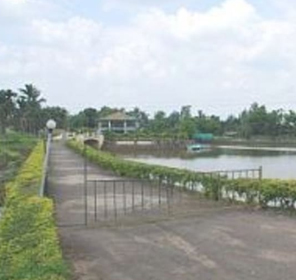
Noune Mini Resort
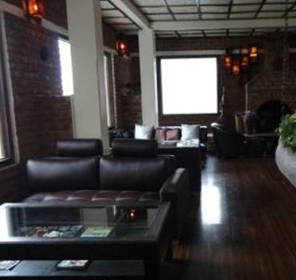
Aradura Inn
Best Tour Packages For Kohima Nagaland
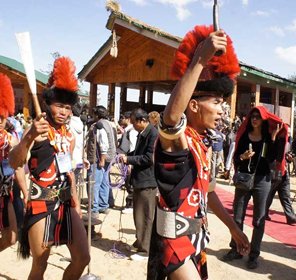
Nagaland Tribal Tour
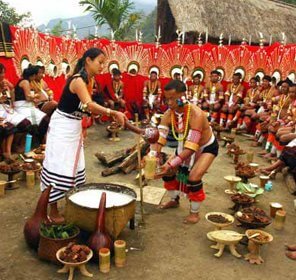
Hornbill Festival Tour Nagaland
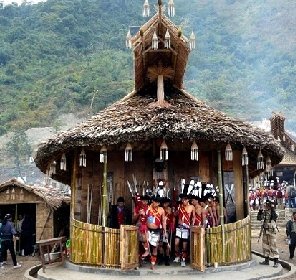
Nagaland Cultural Tour
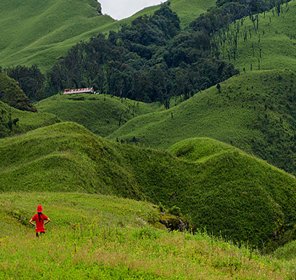
Dzukou Valley Trek
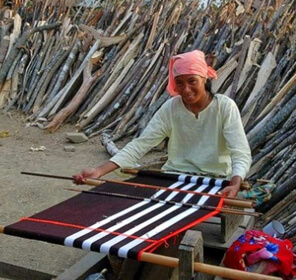
Nagaland Art and Craft Tour
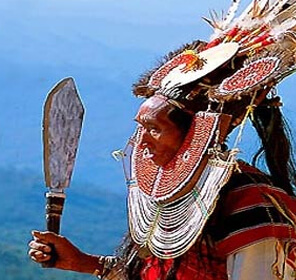
History & Cultural Tour of Assam & Nagaland
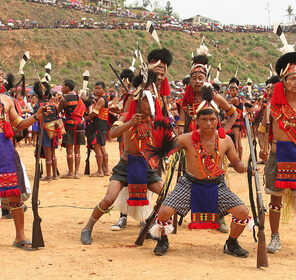
Monyu Festival Tour Nagaland
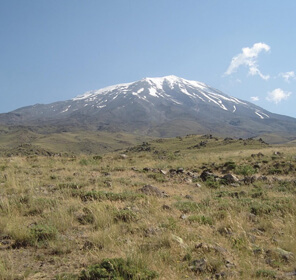
Mount Saramati Trek Adventure
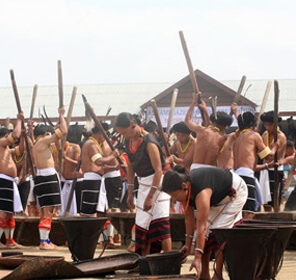
Sekrenyi Festival Tour
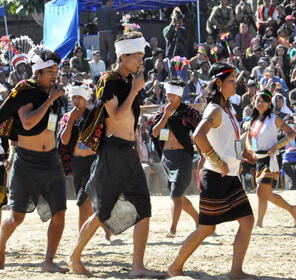
Mimkut Festival Tour
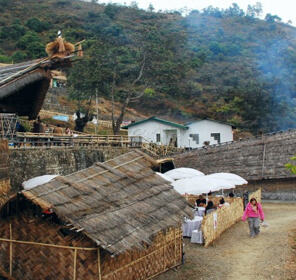
Cultural Heritage Tour of Nagaland
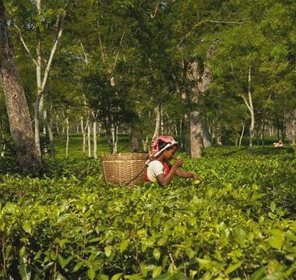
Tea, Wildlife and Hornbill Festival Tour
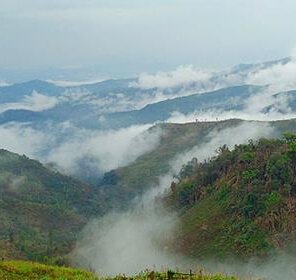
Nagaland Winter Tour
Top tourist destinations in nagaland.
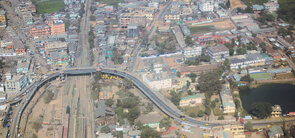
Top Things to Do on Your Holiday to Nagaland
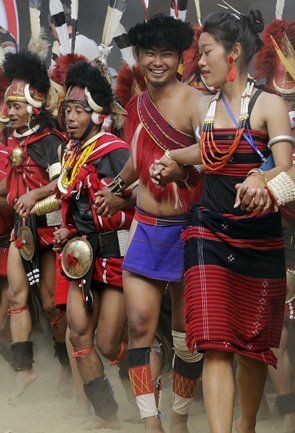
Fairs & Festivals
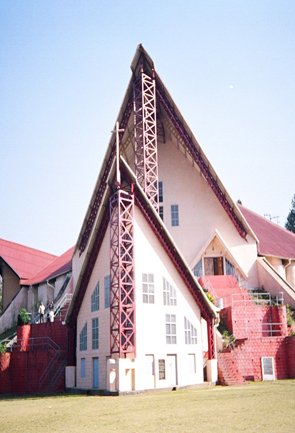
Pilgrimage in Nagaland
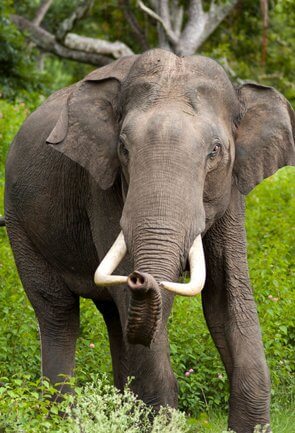
Wildlife in Nagaland
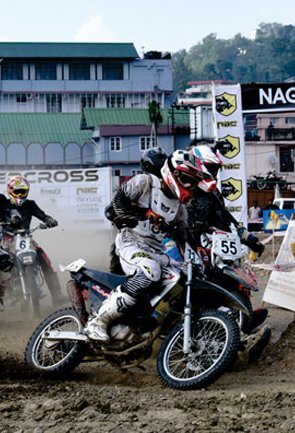
Adventure Tourism in Nagaland
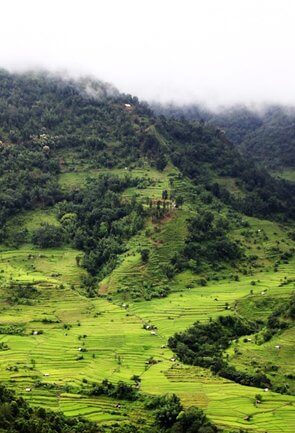
Hill Stations in Nagaland
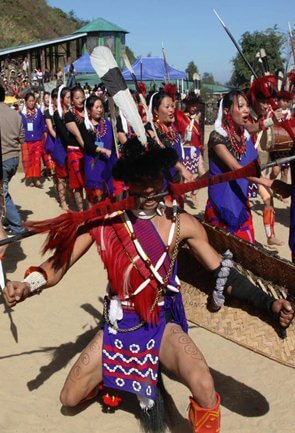
Folk Dance Nagaland

Nagaland Travel Information at a Glance
- Top Destinations
- Top Things to Do
- Top Tourism Attractions
- Top Accommodation
- When to Visit Nagaland
- Nagaland Winter Season
- Nagaland Summer Season
- Nagaland Monsoon Season
- How to Reach Nagaland
- Nagaland Travel by Road
- Nagaland Travel by Train
- Nagaland Travel by Air
- Tour Packages Nagaland
- Entry Permits for Foreigners
- Entry Permits for Indian
- Tourism Map Nagaland


Savaari Car Rentals Blog
Travel begins with Savaari
Top Things to Do in Dzukou Valley – A complete Travel Guide
Perched atop the borders of Manipur and Nagaland, the Dzokou Valley is a mesmerizing blend of rolling greens and azure skies. Traverse this guide to unearth the myriad things to do in Dzokou Valley. From its iconic serpentine streams to the carpet of exotic flowers, embark on a journey through this untouched paradise, capturing the essence of Northeast India’s ethereal beauty and mystique. Book a cab from Guwahati , Imphal or Kohima to explore Dzokou valley in the most comfortable fashion.
Table of Contents
- Places to visit in Dzukou Valley
- Places to visit nearby
- Places to eat in Dzukou Valley
- How to reach
- Best time to visit
Why is Dzukou Valley a Famous Tourist Attraction?
Unknown facts, places to stay in dzukou valley, things/activities to do in dzukou valley .
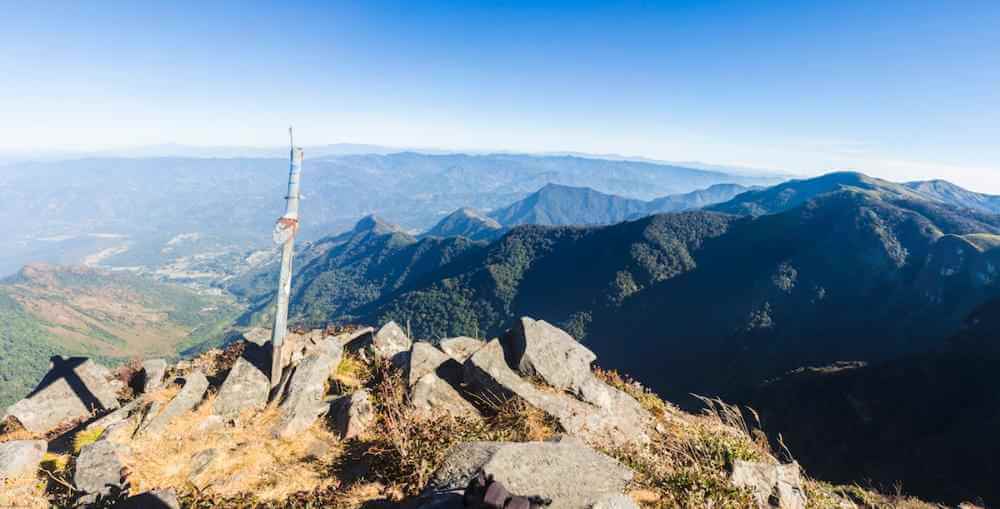
Apart from all the Dzukou Valley sightseeing, you can also include these activities to do on your Dzukou Valley tour.
- Trek through the steep terrain of the valley region. The trek to Dzukou Valley itself is a 17KM long walk and takes around 5-6 hours from Viswema village. From Zakhama village, it is about a 15KM trek and takes 3-4 hours. You can also try the Japfu peak trek, one of the most famous trekking trips in the region.
- Experience the local life by booking one of the homestays in Dzukou Valley. You can spend some time in a village or farmhouse and witness the daily life in rural Nagaland.
- Explore the city of Kohima , the capital and the most populated part of the state. You can do all touristy things here, like shop for locally handcrafted goods, ethnic textiles, or souvenirs, dine at the local eateries and sample traditional cuisine.
- You can also try camping on the camping grounds around Japfu Peak or other designated areas in the Valley. The best time to go camping is after the rainy season when the weather is relatively dry and good for outdoor stay. You can also see the floral bloom at this time of the year.
- Explore the natural caves hidden within the folds of the valley and visit the countryside.
[Also Read: Pelling: Pristine Natural Beauty | A Complete Travel Guide ]
Places to Visit in Dzukou Valley
With the breathtaking view of the Himalayas, rich natural landscape, and hidden geographical gems , there is a lot to do and things to see in Dzukou Valley.
Here are a couple of must-visit Dzukou Valley tourist places –
Sanctuary Falls
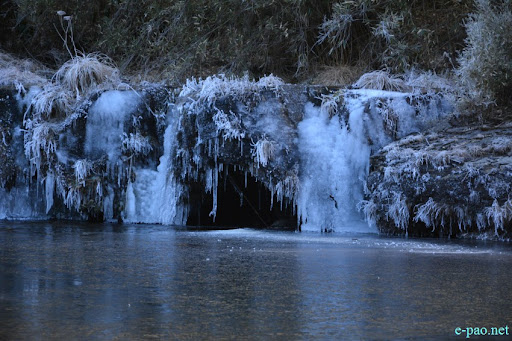
- How to Reach – This tourist spot is located at a walk of about 45 minutes to an hour from west Dzükou and has to be accessed on foot.
- Timings – Sunrise to Sunset
- Entry Fee – NA
- Time Required – 3-4 Hours
- Tips – For best views, visit during or after the winter months, when the waterfall is frozen but always travel with a tour guide.
Pulie Badze Wildlife Sanctuary
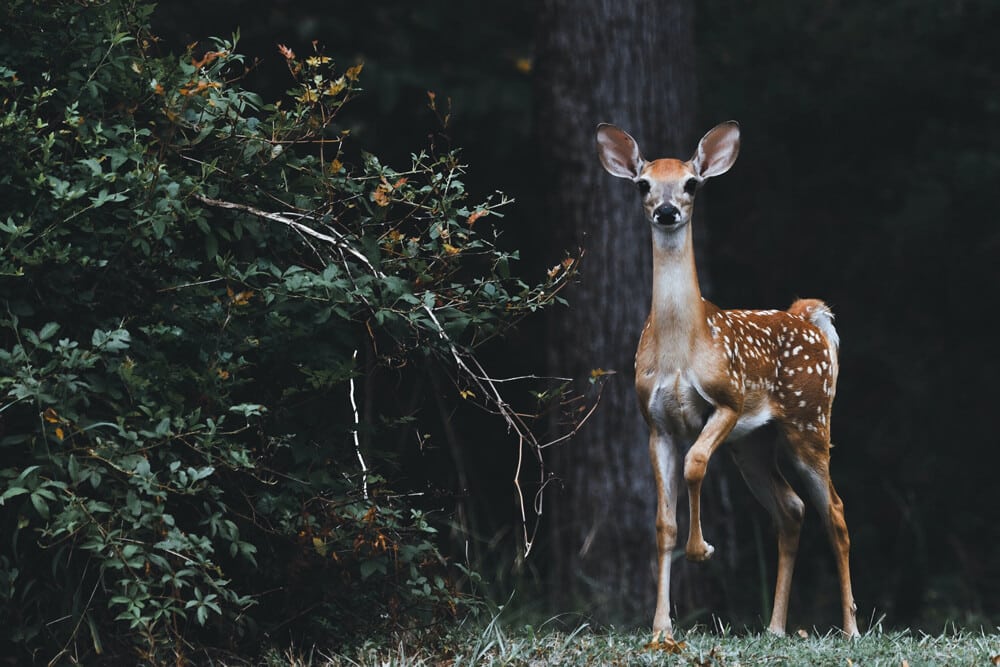
- How to Reach – This sanctuary is adjacent to the valley. You can book a private car to drive through the sanctuary or do a forest trek.
- Timings – 8AM-5.30PM
Places to Visit nearby
The highlight of Dzukou Valley tourism is definitely the alpine flora and fauna and Himalayan beauty. But there are also a host of places you can visit nearby. With popular tour packages, you can include these places in your trip.
Kohima War Cemetery
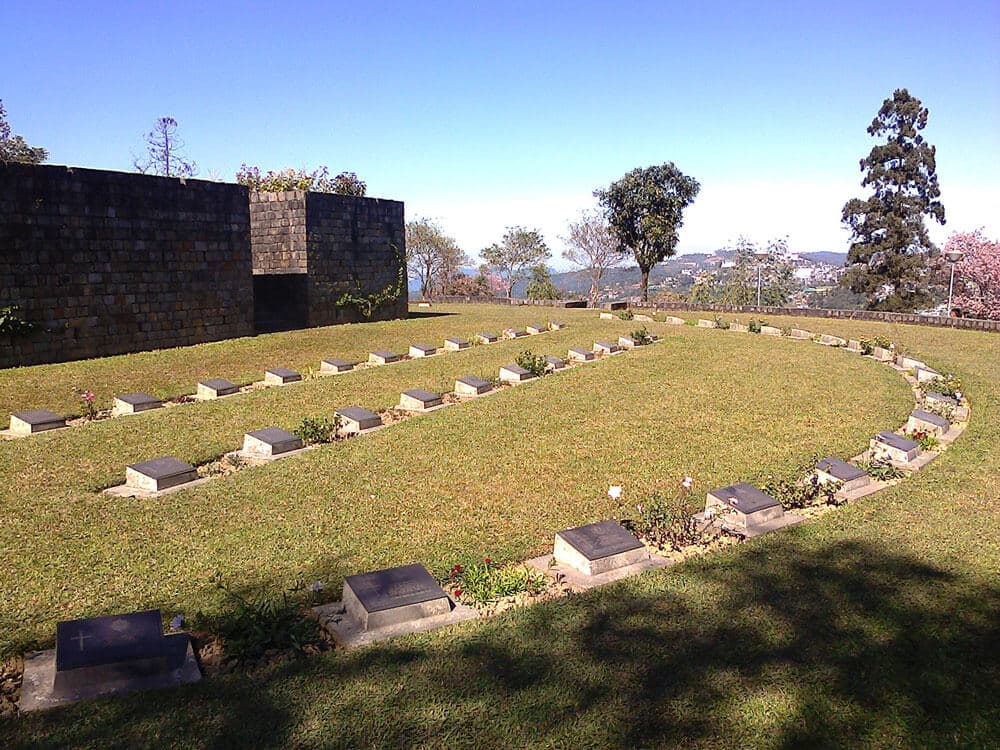
- How to Reach – The cemetery is located at 15.7KM from city railway station. You have to book a cab from the valley area to reach the city.
- Timings – 9AM-4PM
- Entry Fee – Free
- Time Required – Less than 1 hour
- Tips – Don’t miss the legendary cherry tree that the Japanese soldiers used for target practice during WWII.
Kisama Heritage Village
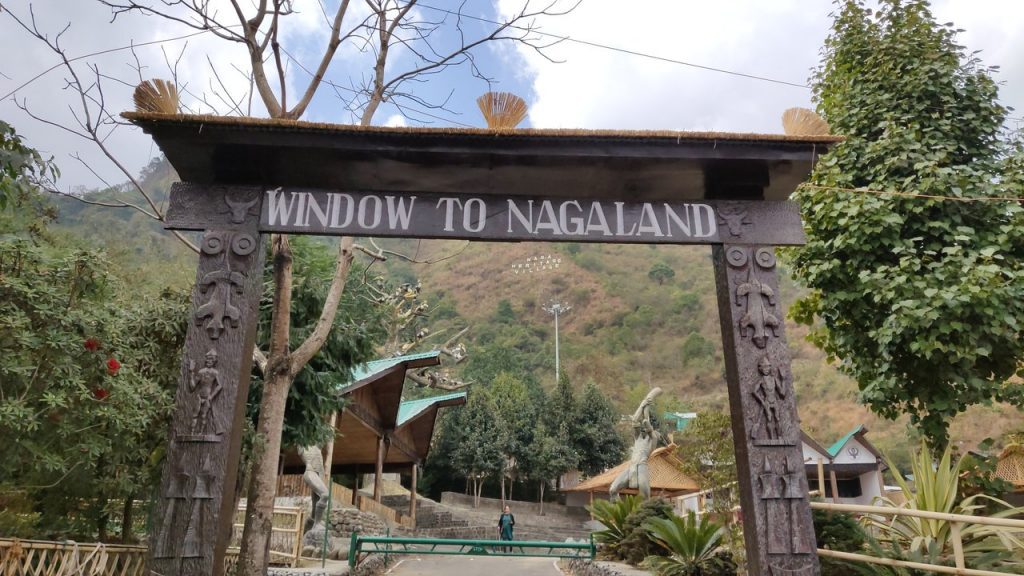
- How to Reach – The tribal village is located at 12KM from Kohima city centre. You can book a local cab or rent a car from the valley to reach.
- Timings – 8AM-6PM
- Entry Fee – INR 20, INR 50 for camera
- Time Required – 1 day
- Tips – Visit during the annual Hornbill Festival to experience local art and cultural showcase.
Kohima Museum
- How to Reach – The museum is located in Kohima, about 18KM from the city railway station. You can book a local cab from the valley to reach the city and go to the museum.
- Timings – 9.30AM-4PM, Closed on Sundays
- Entry Fee – INR 20
- Time Required – 1 -2 hours
- Tips – Don’t forget to take a tour of the art gallery showcasing traditional instruments and tribal hut models.
Places to Eat
Try some of these local and best restaurants in Dzukou Valley –
- Dzukou Restaurant
- Orami Tafale Highways
- Heaven’s Dew Cafeteria
- Oppa Gimbap Kohima
- Cryzal Food Hub
How to Plan a Trip to Dzukou Valley
How to reach dzukou valley.
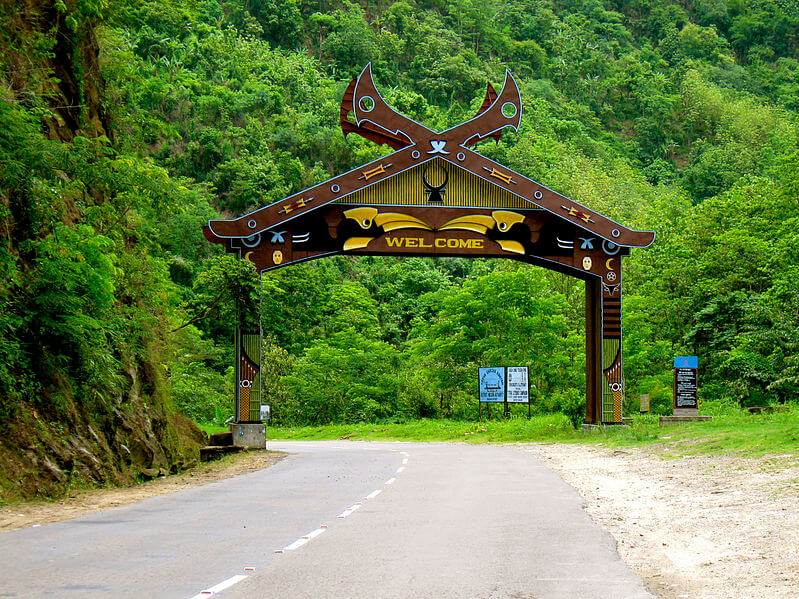
The nearest railway station to Dzukou Valley is in Kohima, the capital city, about 25KM away. There is regular train connectivity to Kohima from other parts of the country. Another 20KM from Kohima lies the towns of Jakhama and Viswema, from where you can easily approach the valley area by road. You can take a train or bus to Kohima from other cities in Nagaland and then book a cab or rent a private car to reach Dzukou Valley directly.
Dzukou Valley is well-connected by road to Kohima and Dimapur, and other major cities nearby, like Guwahati. You can get a cab from Dimapur, Kohima, or any other part of the state and reach the valley area.
The main valley can be explored on foot by trekking through the hilly roads and forest trails, with help of guides and porters. Although there are no special permits required to visit Dzukou Valley, there is an entry fee of Rs 30 per person to enter and explore.
There is no direct flight connectivity to Dzukou Valley. The nearest airport is in Dimapur, about 74KM from Kohima. You can also travel to Kohima Chiethu Airport , about 25KM south of Kohima city. The other nearest and biggest airport is in Imphal, in Manipur. There are regular flights to all these three airports from major cities and towns in India like Kolkata, Guwahati, Delhi, Mumbai, Bangalore, and Hyderabad.
Best Time to Visit Dzukou Valley
Incredible India !! Dzukou Valley, also known as “ Valley of the Flowers of the North-East” https://t.co/er2kqcxcFC pic.twitter.com/R6NbDphKPS — All India Radio News (@airnewsalerts) June 14, 2016
The weather of Dzukou Valley is not very different from the rest of the state. It is mostly cold all throughout the year, except for the summer months when it is pleasant and right after the monsoon when it’s very misty.
At this time the temperature is also quite conducive to exploring the outdoors. Also, the post-monsoon period is when flower season happens. So, if you want to see the valley in full bloom then visiting between June and September is ideal. For outdoor adventures, it’s best to visit Dzukou Valley in October or before December, or from March to May.
About Dzukou Valley
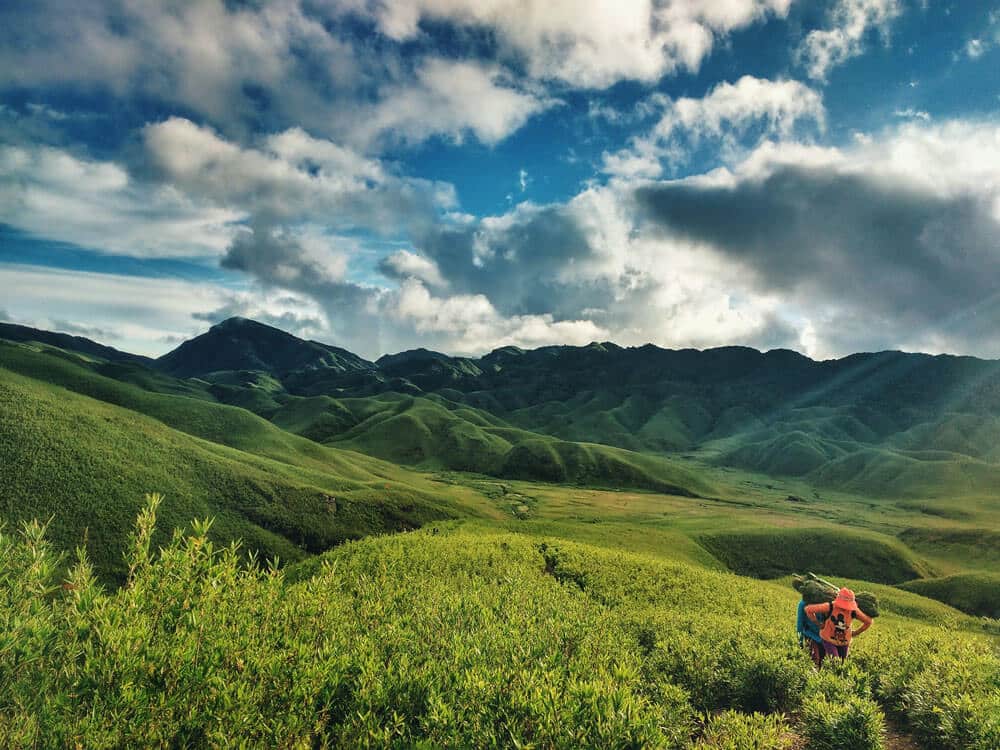
Dzukou is one of the most breathtaking landscapes in Nagaland . The location of the valley on the borders of Nagaland and Manipur. Hence the landscape is shared by both the states, politically.
But geographically, as per the Survey of India, the majority of the valley area is occupied by the state of Manipur. The valley and its surrounding peaks are located at about 25KM from Kohima , the capital city of Nagaland. The altitude of Dzukou rises to about 2452 meters above sea level with the highest peak at M. Iso (Mt. Tenipu) . It is also the highest point of Manipur.
Sitting at the foothills of the Eastern Himalayas, Dzukou enjoys a classic mountain terrain, weather, and flora and fauna , thus offering a spectacular environment. This makes this valley region in Nagaland one of the most visited tourist attractions in the North East .
The etymology of the valley’s name is also quite diverse. The word Dzukou originally comes from the Viswema dialect of the native Angami people which loosely translates to “ Soulless and Dull ”.
Nothing to do with how the place looks now, the definition came from the fact that when the early Viswemas moved to this region, they found it unfavourable for settlement and cultivation, due to the rough terrain and inclement weather. However, there are other regional beliefs that claim that Dzukou translates to “ cold water ”, owing to the ice-cold streams that cut through the valley. It could have also been a reference to the impact of the Himalayas on the region.
This place is also known as the Valley of Flowers , owing to the huge variety of endemic Himalayan flora that is in full bloom in the valley area every year. Of all places to visit in Dzukou Valley, this floral beauty invites travellers from all over the country and abroad to admire the stunning, colourful canvas of an otherwise cold and quiet locale.
The most famous of the flowers is the Dzukou Lily , which is only found in this region. The blooming season is one of the best attractions in Dzukou, when the lilies flower in white and pink, along with other exotic Himalayan flowers like the aconitums, euphorbias, and similar rare species .
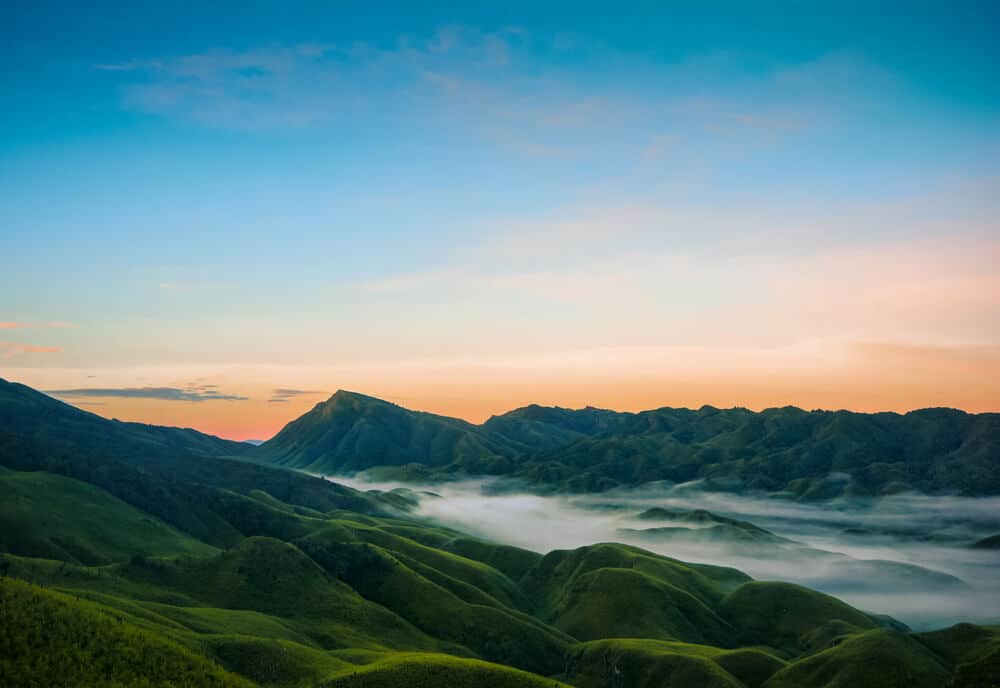
Geologically, the existence of this valley is associated with an ancient volcano. The region is said to be the base of the crater of the volcano, which eventually got covered in moss, grass, and flowers over millennia . The result, as we see it today, is an endless expanse of undulating hills, knolls, lush glens, steep ravines, and dense forests of alpine vegetation.
Here are some of the best Dzukou Valley hotels and resorts that you can explore on your trip –
- Southview Homestay
- Dzukou Valley Guest House
- Crescent International
- The Heritage
- Kohima Camp
Download our Savaari car rental app for a smooth and pleasant journey.
Last Updated on January 31, 2024 by Swati Deol
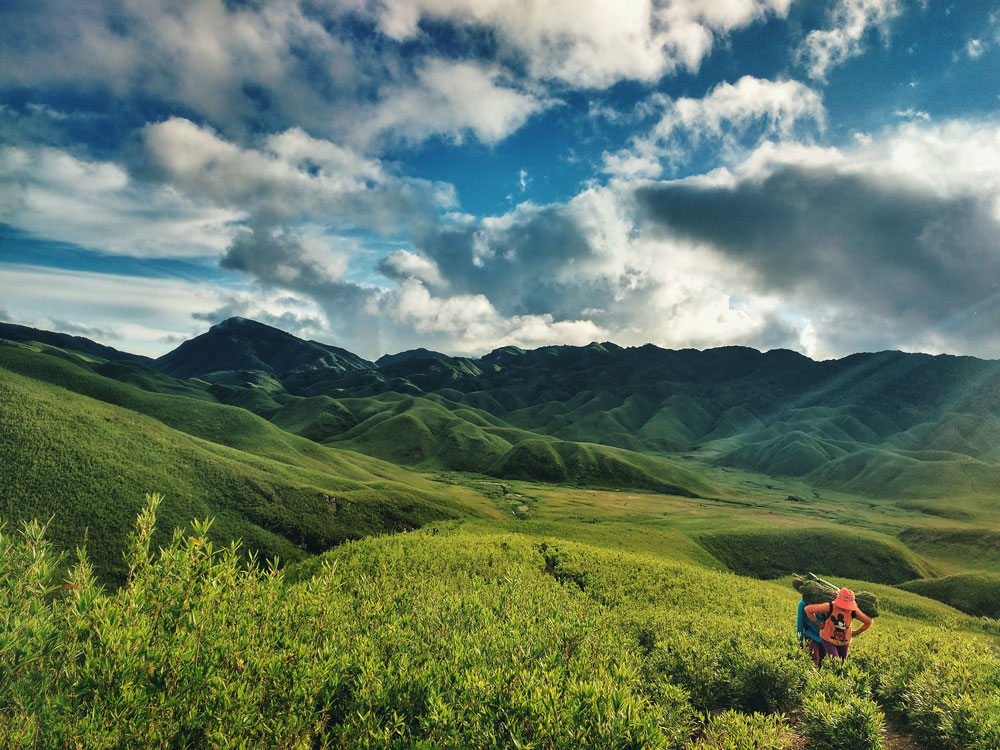
About the author
Related posts.
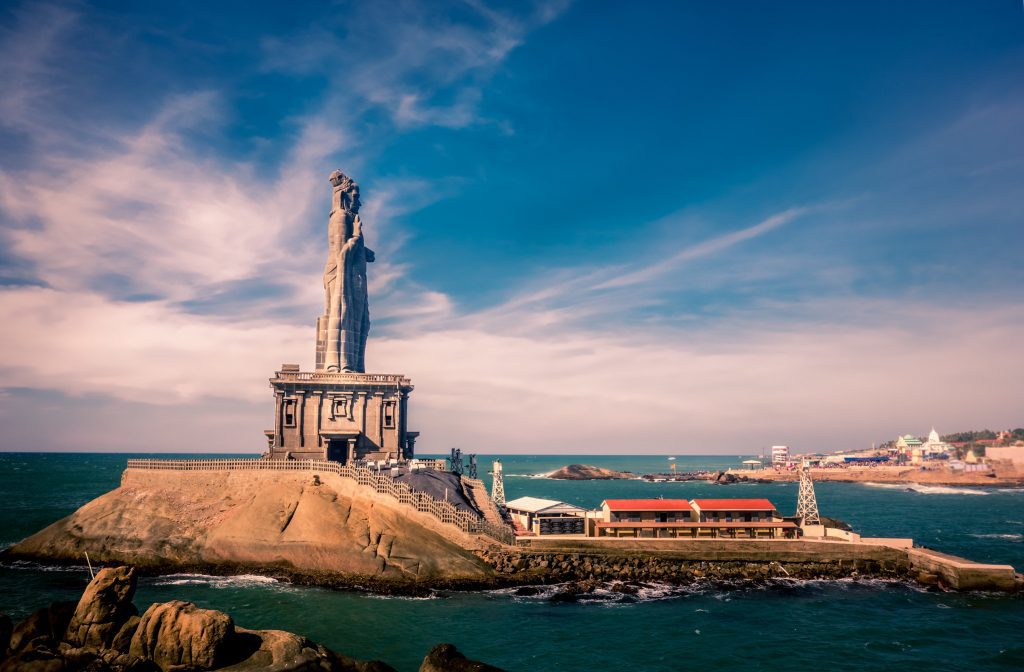
Top Things to Do in Kanyakumari – A complete Travel Guide
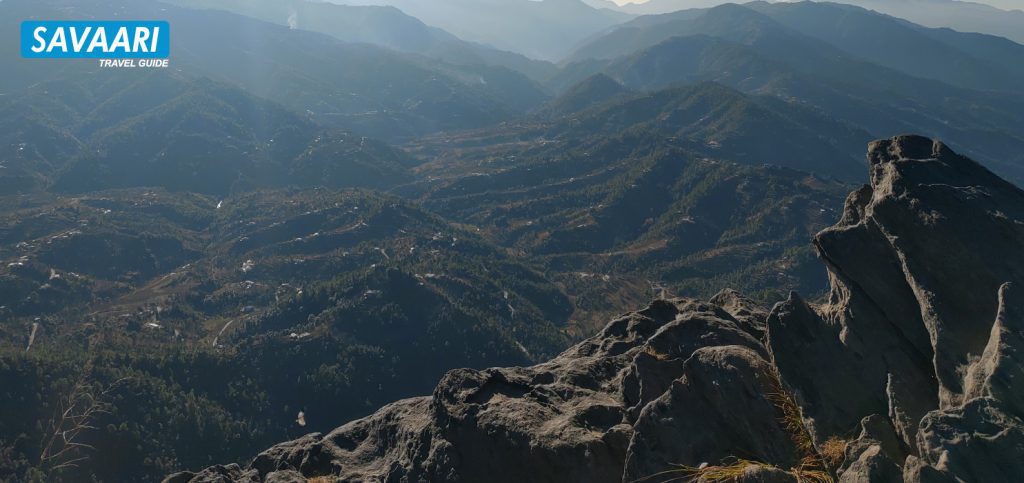
Things to Do in Mukteshwar – A Complete Travel Guide
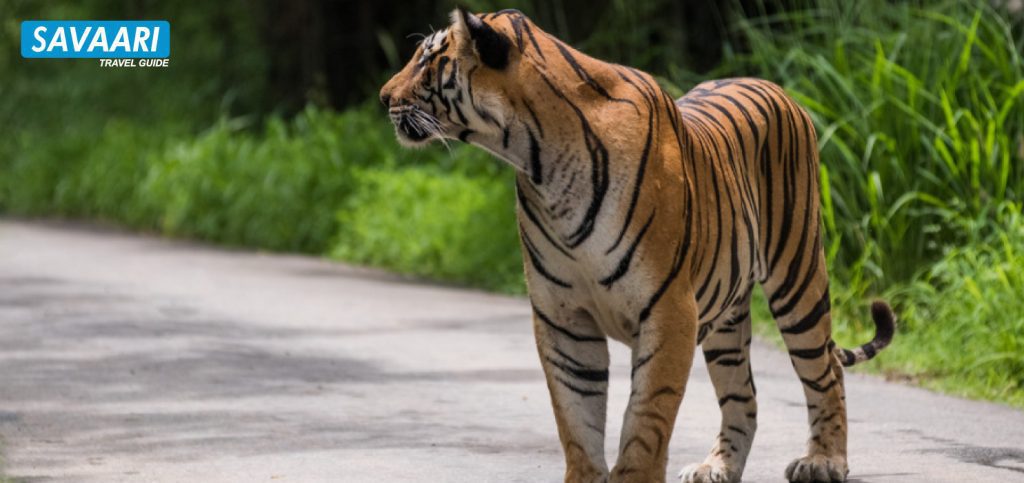
Things to Do in Sundarbans – A complete Travel Guide
Leave a reply cancel reply.
Your email address will not be published. Required fields are marked *
Save my name, email, and website in this browser for the next time I comment.
1800 22 7979
+91 22 2101 7979
+91 22 2101 6969
+91 88799 00414
Business hours
Top Recommended Destinations
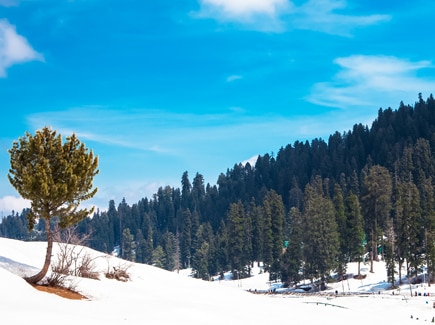
Jammu and Kashmir

Sikkim Darjeeling
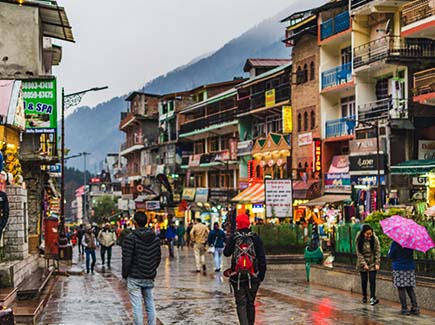
Himachal Pradesh
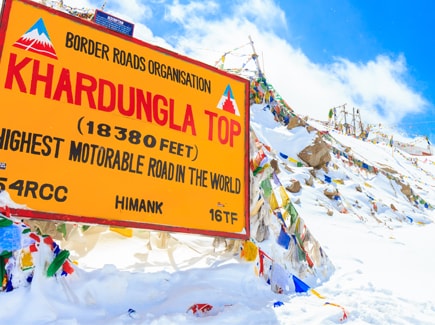
- Chandrataal
- Dharamshala
- Spiti Valley
- Nubra Valley
- Pangong Tso
Punjab & Haryana
- Kurukshetra
Uttarakhand
- Jim Corbett Park
Uttar Pradesh
- Fatehpur Sikri
Andaman & Nicobar Islands
- Neil Island
Andhra Pradesh
- Visakhapatnam (Vizag)
- Chitradurga
- Murudeshwar
- Shravanbelagola
- Athirappilly
- Thiruvananthapuram
- Kanchipuram
- Kanyakumari
- Mahabalipuram
- Pondicherry
Arunachal Pradesh
- Kaziranga National Park
- Manas National Park
- Cherrapunjee
- Bhubaneshwar
West Bengal
- Narmada Tent City
- Rann of Kutch
Madhya Pradesh
- Omkareshwar
Maharashtra
- Chittorgarh
- Kumbhalgarh
- Ranthambore
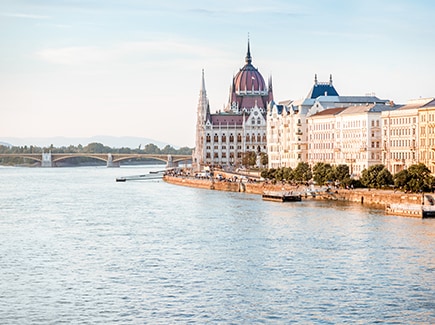
South East Asia
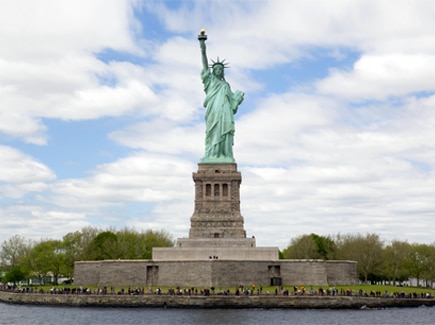
Australia New Zealand
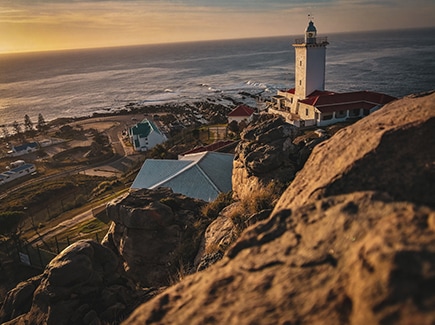
Dubai Egypt Israel
- Nile Cruise
South Africa
- Johannesburg
- Pilanesberg National Park
- Port Elizabeth (Gqeberha)
- Stellenbosch
- Victoria Falls
- Rio De Janerio
- Los Angeles
- Niagara Falls
- Philadelphia
- San Francisco
- Nuwara Eliya
- Kuala Lumpur
- Genting Highlands
- Nusa Penida
- Ho Chi Minh
- Cherry Blossom Tours
South Korea
- Great Barrier Reef
- Great Ocean Road
New Zealand
- Christchurch
Western Europe
- Liechtenstein
- Netherlands
- Switzerland
- Vatican city
Central & Eastern Europe
- Czech Republic
Northern Europe
Mediterranean Europe
- Midnight Sun
- Northern Lights
- Scandinavia
United Arab Emirates
- Ferrari World
Saudi Arabia
An adventure of a lifetime awaits you. Immerse yourself in the untouched beauty of the last frontier on Earth, the serene beauty of icebergs, and witness landscapes that seem straight out of your dreams.

Speciality Tours
POPULAR & available TOURS
Honeymoon special.
Embark on a journey of togetherness.
Inspiring beautiful journeys & Scenic Routes.
Seniors' Special
Golden age celebration tours for 55+ yrs.
Women's Special
Exclusive handcrafted women only tours.
Family Tour Packages
Veena World’s safe, secure, and popular tours
Women's Special with Kids
Travel with your kids (boys & girls, under 12 yrs)
Upcoming Tours
Couples only.
Exclusive tours for middle aged couples.
Luxury Tours
Enjoy the sweet life of luxury & pampering.
One Week One Place
Explore one place at a relaxed pace.
Post Tour Holidays
Explore the city after your big tour.
Short Trips
Quick getaways to stunning destinations.
Treks & Hikes
Exiting adventure & challenges (15-55 yrs).
YOLO Adventures
Experiences for adrenaline junkies (18-35 yrs).
City Walks & Day Trips
Explore the city and culture.
WOW Adventures
Thrilling holidays for family (10-55 yrs).
Students' Special
Dhamaal tours after 10th & 12th exams
Customized Holidays
THEMED EXPERIENCES - Find your reason!
Romantic Holidays
City Breaks
Adventure Stories
Taj Holidays
Air Inclusive Holidays

Luxury Holidays
choose the right tailor-made luxury travel vacations

Island Getaways
explore the tropical island getaways
Buy & Sell Foreign Currency
Aed - uae dirham, gbp - british pound.
All your FOREX needs taken care of
- 10 Unforgettable Things To Do In Dzukou Valley Nagaland
10 Unforgettable Things to Do in Dzukou Valley Nagaland
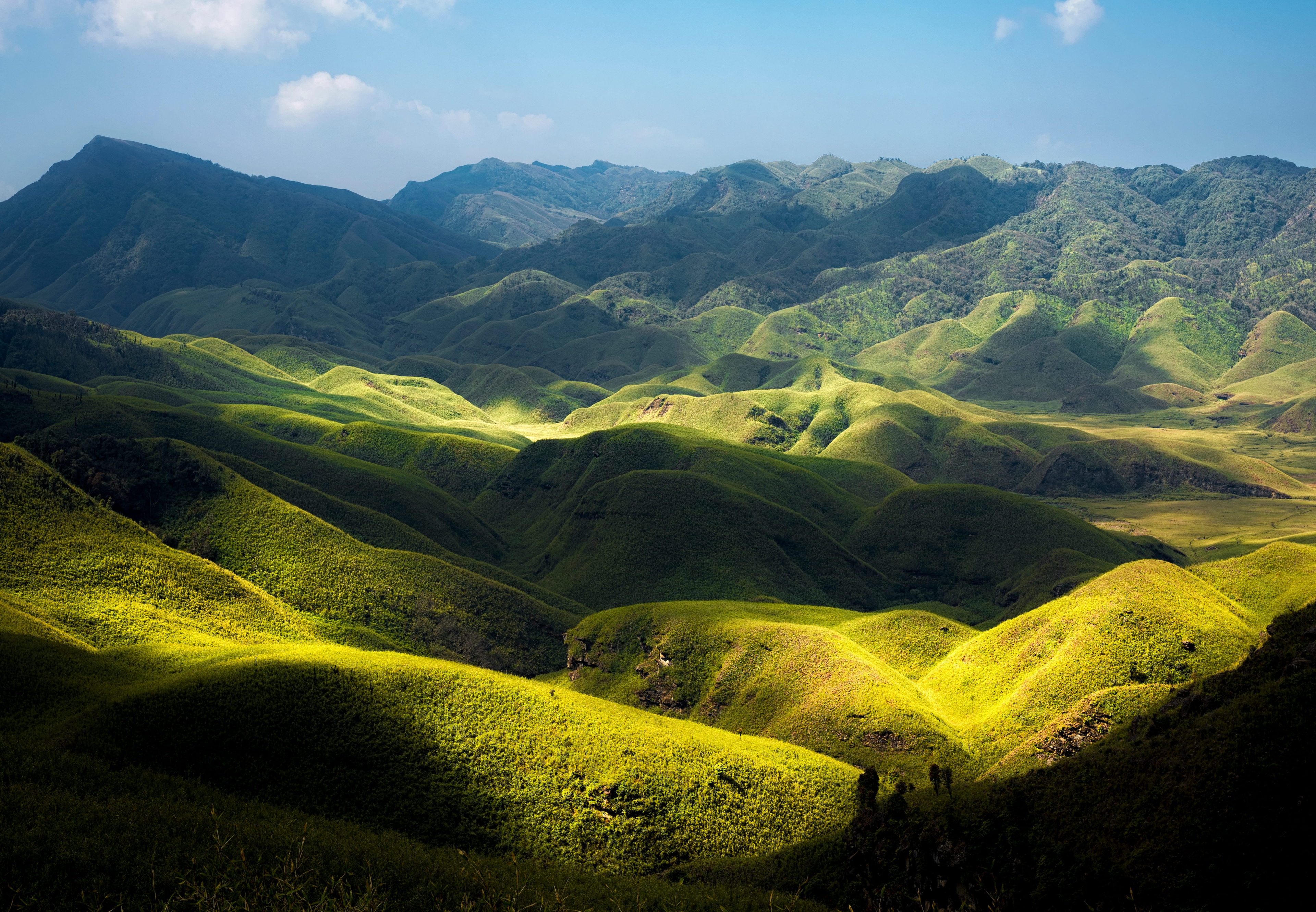
Located on the border of Manipur and Nagaland, Dzukou Valley is a hidden gem waiting to be discovered. Renowned for its pristine beauty and untouched landscapes, this valley offers a plethora of experiences for nature lovers and adventurers.
With its lush green meadows, vibrant wildflowers and pristine streams, Dzukou Valley offers a serene escape from the bustling world. Immerse yourself in the tranquillity of this untouched paradise as you trek through picturesque trails and witness panoramic views of the surrounding hills.
Dzukou Valley’s charm lies in its pristine and unspoiled environment. The valley is often referred to as the ‘Valley of Flowers of the Northeast’ due to the vibrant blooms that adorn its landscapes during monsoon season. Dzukou lilies, rhododendrons and a myriad of other wildflowers transform the valley into a colourful paradise, offering a visual spectacle that is truly awe-inspiring.
Dzukou Valley also offers opportunities for camping, allowing visitors to spend a night under the stars, surrounded by nature. The tranquillity of the valley provides an ideal setting for meditation, yoga and soulful introspection.
Explore this enchanting destination and let its pristine charm captivate your senses in your next Nagaland Tourism package .
Things to do in Dzukou Valley
Here are 10 Unforgettable things that you should not miss when in Dzukou Valley: -
Trekking to Dzukou Peak
Camping amidst nature, witness the valley of flowers, explore the dzukou river, birdwatching in the valley, visit the shiva temple, getaway at the jakhama village, spotting wildlife, meditate at the caves, visit the vishwema village.
Embark on an exhilarating trek to Dzukou Peak, the highest point in the valley. This Dzukou Valley Nagaland Trek trail, adorned with rhododendron forests and gentle streams, offers a mesmerizing journey. As you reach the summit, be rewarded with panoramic vistas of rolling hills, lush greenery, and a sea of vibrant wildflowers.
Experience the joy of camping amidst nature's embrace in Dzukou Valley. Set up your tent on the valley's verdant meadows and fall asleep under a blanket of stars. Wake up to the melodious chirping of birds and the serene beauty of the valley, making it a truly magical experience.

Dzukou Valley in flowering season is renowned for its enchanting meadows carpeted with a kaleidoscope of wildflowers. From lilies to euphorbias, the valley blooms in vibrant hues during the summer months. The iconic Dzukou lilies and rhododendrons paint the landscape with hues of white, pink and red, creating a breathtaking sight. Taking a leisurely stroll through the Dzukou Valley flower's mesmerizing landscape, breathing in the fragrant air and capturing stunning photographs with the misty air and gentle rain adding to the enchantment, is like stepping into a fairy tale.
Follow the melodious sound of flowing water and discover the pristine Dzukou River. With its crystal-clear waters cascading through rocky terrain, the river offers a refreshing respite. Take a dip in its cool waters or simply sit by the riverbank, immersing yourself in the tranquillity of nature.
Dzukou Valley is a haven for birdwatchers. With its diverse ecosystem, it attracts a wide variety of avian species. From the vibrant Himalayan Monal to the elusive Blyth's Tragopan, you'll be enthralled by the sight and sounds of these feathered creatures. Keep your binoculars ready and capture the beauty of these winged wonders.
Located at the heart of Dzukou Valley, the Shiva Temple is a spiritual haven. Pay homage to Lord Shiva amidst the tranquil surroundings and seek blessings for a sense of peace. The temple's serene ambience and stunning views make it a must-visit spot for both spiritual and cultural enthusiasts.
Take a short detour from Dzukou Valley and visit the nearby Jakhama Village for a peaceful and rejuvenating getaway. Located near the capital city of Kohima in Nagaland, this idyllic village offers a serene retreat surrounded by picturesque landscapes, this quaint village offers a perfect setting for a relaxing picnic. Enjoy local delicacies, interact with the friendly villagers, and immerse yourself in their rich cultural heritage. Experience the warm hospitality of the local community as you stay in traditional Naga Huts and savour authentic local cuisine. Engage in nature walks, birdwatching, and trekking expeditions to explore the captivating surroundings.
While Dzukou Valley is home to a rich array of wildlife, the state is also home to several National Parks in Nagaland that adds to its rich biodiversity. Keep your eyes peeled for the rare Blyth's Tragopan, a bird known for its vibrant plumage, or the Hoolock Gibbon, the Himalayan Black Bear and leopards roaming amidst the dense forests. Spotting these elusive creatures in their natural habitat is a thrilling experience for wildlife enthusiasts. Immerse yourself in the lush forests and serene landscapes and embark on wildlife safaris and treks to witness the beauty of fauna in its natural habitat.
Discover the hidden caves within Dzukou Valley and immerse yourself in a meditative experience. These mystical caves provide a serene environment for introspection and inner peace. Take a moment to reflect, practice yoga, or simply enjoy the solitude amidst the soothing ambience.
Located Near Dzukou Valley, The Vishwema village offers a glimpse into the unique culture and traditions of Nagas. The village showcases the rich heritage, customs and traditions of the region. Interact with the friendly locals, witness their vibrant festivals and admire their exquisite handicrafts. Engage in traditional activities such as weaving, bamboo craft-making and traditional cooking.
Best Time to Visit Dzukou Valley
The best time to visit Dzukou Valley Nagaland is all-year round. If you prefer drier conditions and clearer views, you can consider visiting Dzukou Valley during the shoulder months of April to May or October to November. During these months, the weather is more pleasant and the valley is less crowded, offering a different perspective of its natural beauty. If you wish to visit the valley in monsoon, this period offers the most enchanting and vibrant experience as the valley comes alive with a blanket of blooming flowers, including the iconic Dzukou lilies and rhododendrons. The valley transforms into a paradise of colours, with hues of white, pink, and red spread across the landscape.
During these months, the weather in Dzukou Valley remains pleasant, with cool temperatures. However, it is important to note that due to the monsoon season, rainfall is abundant, and the valley can become muddy and slippery. Therefore, it is essential to come prepared with appropriate trekking gear, including waterproof clothing and sturdy footwear. In this season you have the advantage of fewer crowds, allowing visitors to truly immerse themselves in the serenity of the valley.
It is advisable to check weather conditions and plan your visit accordingly, as heavy rainfall can sometimes lead to temporary closures of trekking routes for safety reasons.
Dzukou Valley in Nagaland is a paradise for nature lovers and adventurers, offering a pristine environment, magnificent landscapes and a chance to immerse oneself in the untouched beauty of the region. And with Veena World, it becomes all the more mesmerising!
We are an Indian travel company founded in 2013 and excel at domestic and international tour packages including guided group tours, specialty tours, customized holidays, corporate MICE travel, inbound travel and destination weddings.
Post your Comment Please let us know your thoughts on this story by leaving a comment.
Blog categories.
- Travel Guide
Looking for something?
Embark on an incredible journey with Veena World as we discover and share our extraordinary experiences.
Request Call Back
Tell us a little about yourself and we will get back to you

Our Offices
Located across the country, ready to assist in planning & booking your perfect vacation.
Locate nearest Veena World
Listen to our Travel Stories

5 Minute Travel Tips with Neil Patil
Become a smart traveler in five minutes. Every Monday join Neil Patil and hear about different travel tips and secrets to unlock your full travel Ninja potential.

Aapla Maharashtra
'आपला महाराष्ट्र' ही पॉडकास्ट मालिका म्हणजे महाराष्ट्राची झलकच. गौरवशाली इतिहास , वैविध्यपूर्ण परंपरा आणि आकर्षक भूगोल लाभलेल्या महाराष्ट्राची ओळख करून देण्यासाठीच वीणा वर्ल्डने ही मालिका सुरू केली आहे. या मालिकेतून महाराष्ट्राच्या रोमांचक इतिहासाचे साक्षीदार असलेल्या गड - किल्ल्यांचा थोडक्यात परिचय करुन दिला जाईल. मग दर गुरुवारी न चुकता ऐका ' आपला महाराष्ट्र ' आणि तुमच्या भटकंतीला द्या नवीन दिशा. Looking to explore the wonders of Maharashtra, India? Tune in to 'Aapla Maharashtra', a podcast series that takes you on a journey through the state's rich history, captivating culture, and breathtaking geography. Join us every Thursday for a new episode and discover the many forts that bear witness to Maharashtra's majestic past. Take your travel experience to the next level with 'Aapla Maharashtra'.

Chalo Bag Bharo Nikal Pado
#ChaloBagBharoNikal Pado, a Hindi podcast by Veena World, is here to take you on a virtual tour around the world. Every episode, our host Neil will be joined by expert travellers with years of experience in the Travel and Tourism industry. They’ll share their personal journeys and stories that you’ve probably never heard of before. A new guest, a new experience. New episode every Wednesday. Join us to Celebrate Life virtually.

Know the Unknown
Know something unknown daily in under 3 minutes

Life Stories by Veena Patil
‘Exchange a coin and you make no difference but exchange a thought and you can change the world.’ Hi! I’m Veena Patil... Fortunate enough to have answered my calling some 35 years ago and content enough to be in this business of delivering happiness almost all my life. Tourism indeed moulds you into a minimalist... Memories are probably our only possession. And memories are all about sharing experiences, ideas and thoughts. Life is simple, but it becomes easy when we share. Places and people are two things that interest me the most. While places have taken care of themselves, here’s my podcast, which I consider to be a great platform, through which I can share some interesting stories I live and love on a daily basis with all you wonderful people out there. I hope you enjoy the journey... Let’s go, celebrate life!

Travel. Explore. Celebrate Life.
Travel is indeed one of the things that help us celebrate life. And 2020 has made us realise that more than anything else. With Travel. Explore. Celebrate Life., let's go on a journey around India and the world and talk about culture, history, experiences, food, and more. Your co-hosts Neil Patil and Sunila Patil along with special guests every episode, discuss where to go, what to eat, where to stay, what to pack, what to explore, and much much more. So hop on, chalo bag bharo nikal pado!

Travel Katta
#TravelKatta, a Marathi podcast by Veena World, is here to take you on a virtual tour around the world. Every episode, our host Sunila will be joined by expert travellers with years of experience in the Travel and Tourism industry. They’ll share their personal journeys and stories that you’ve probably never heard of before. A new guest, a new experience. New episode every Friday. Join us to Celebrate Life.
Most Commented
Calling out the spiritually inclined - 10 places of worship worth visiting in india, top 10 places in china - discover the land of oldest living civilization, a 2 week itinerary for a holiday in africa - trace your roots in the cradle of mankind, handpicked wedding destinations around the world for your big day, keep travelling all year round.
Subscribe to our newsletter to find travel inspiration in your inbox.
Trending videos for you

Top Travel Experiences

With Veena World

Dekho Apna Desh

Places to Visit in 2023
Veena world tour reviews, what are you waiting for chalo bag bharo nikal pado, shimla manali upcoming tour dates.
"It is marvelous and remains with better memories forever. Swapnil and Mobin Shai... Read more

"Tour managers Swapnil and Mobin hospitality is very good"

"Very nice experience and well-planned tour From day 1 to 6. Tour manager Mr Swapnil Sawant and Mr.Mobin Khan, very spot spoken , frie... Read more

287 departures
52,783 guests travelled

56 departures
15,711 guests travelled

137 departures
1,06,004 guests travelled

133 departures
23,226 guests travelled

374 departures
72,499 guests travelled
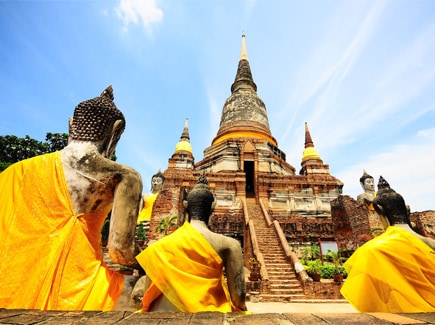
127 departures
1,19,536 guests travelled

18 departures
11,452 guests travelled
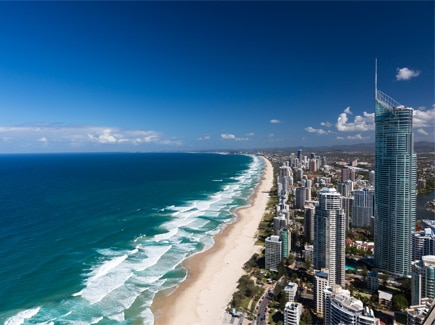
33 departures
11,084 guests travelled
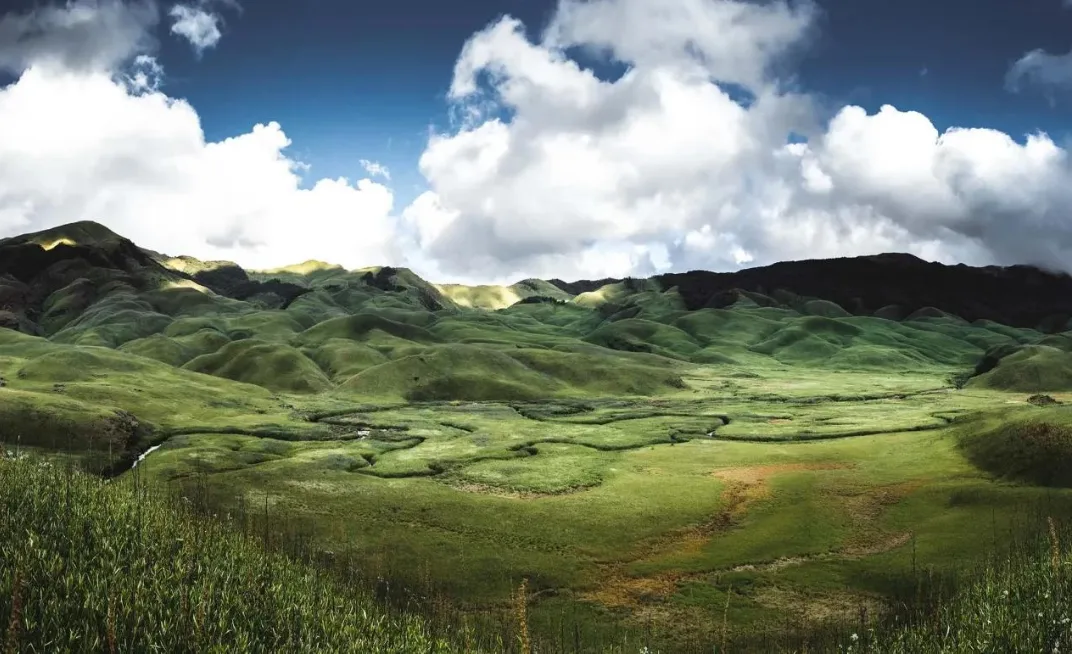
Best Time to visit Dzukou Valley: Nagaland’s best kept secret
” Best Time to visit Dzukou Valley “? Well, the answer depends upon what provides you a greater thrill.
If one wishes to witness – Masterpiece of nature festooned with vibrant, nodding wildflowers, you ought to visit from April to September, the blooming season and the best time to visit Dzukou Valley or the winter season from October to March to boasts a different kind of stark, desolate beauty.
The Pristine Dzukou Valley is an undisturbed land and a secret kingdom of the North – East, India. The valley is a serene retreat where one can escape the hubbub and helter-skelter of urbanity.
The land of undulating rolling hills, stretched with a colourful carpet of flowers and wild dwarf bamboo is breathtakingly beautiful and can be described as a masterpiece of nature’s handiwork.
Dzukou Valley is nestled high amongst the clouds at 2,452 meters above the sea level. This heavenly divine place of flora and fauna is located at the border of Nagaland and Manipur.
The Dzukou Lily(Lilium Chitrangadae), which is found only in Dzukou Valley, is an important highlight that adorns the picturesque landscape.
The timeless erosion and weathering of the rocks leading to the formation of perfectly molded sweeps of hillocks add glamour to its distinctive contours.The burnt trees scattered through the valley, reminiscence of two huge forest fires, adds an esoteric element to the expansive vistas.
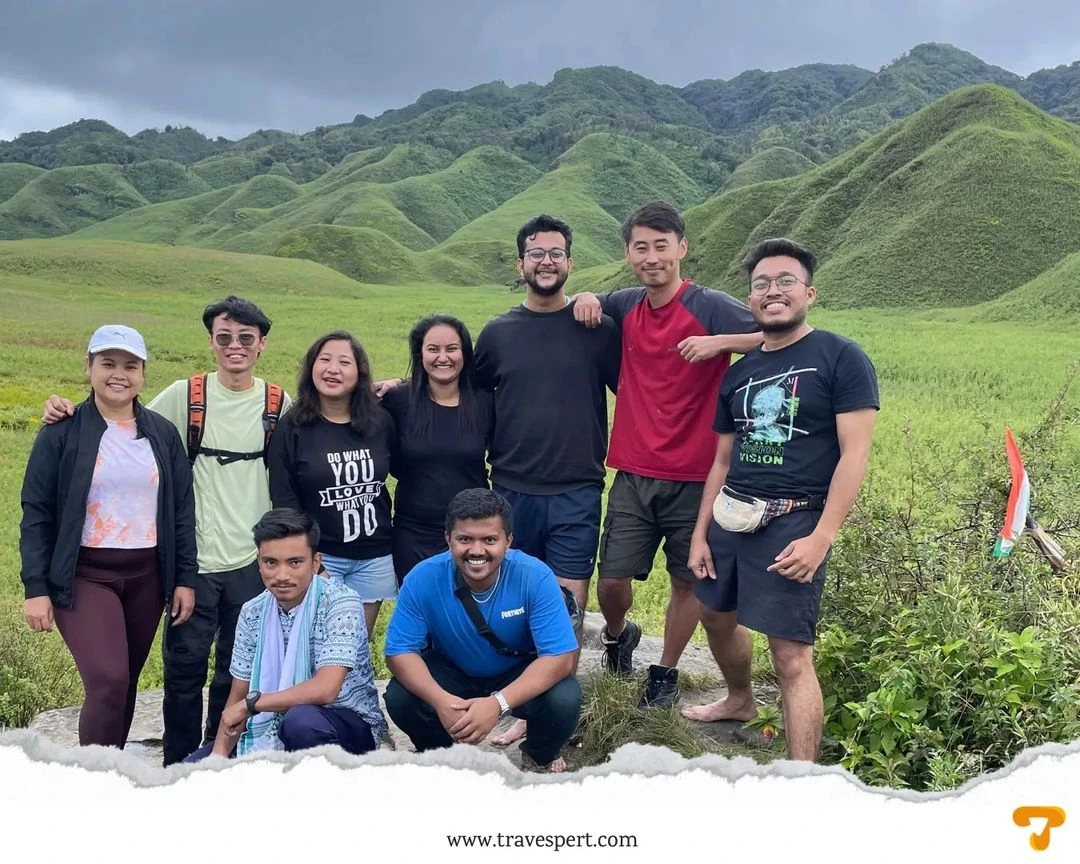
DZUKOU VALLEY
3 Days – 2 Nights
- 1.1 How to reach Dzukou Valley?
- 1.2 Accomodations in the Dzukou Valley
- 1.3 Ecosystem of the Dzukou Valley :
- 1.4 Exploring Dzukou Valley – Feast your eyes :
- 1.5 Convinced to visit the picture-perfect Dzukou Valley?
Best Time to visit Dzukou Valley
The Dzukou Valley spanning across the Nagaland and Manipur interstate boundary exemplifies the best craftsmanship of nature. The alluring valley holds velvety green treeless knolls that spread as far as eyes can take you.
Choose your slot for Best Time to visit Dzukou Valley – Summers paint a colourful picture with the valley blooming with bright flowers but winters turn the valley into a frosty canvas covered in white snow.
If you are someone who loves the rhythmic rain, the vibrant green forest and the wetlands, then we assure you the best time to visit Dzukou Valley is the month of July.
The best time to visit Dzukou Valley for offbeat tourists is from October to May.
The drier seasons – summer and winter are the best time to visit Dzukou Valley due to an advantage – the absence of leeches.
Dzukou Valley Nagaland Best Time to visit – The two driest times to visit the picture-postcard landscape are in the summer season (April – May) and the winter season (November – March), though regardless of when you visit, you’re guaranteed of a visual treat.
Blooming Season(April – September )
If your dream is to experience an enchanting valley festooned with vibrant, nodding wildflowers, April – August is the best time to visit Dzukou Valley.
The first two weeks of July are usually the peak flower season making the Valley refreshing. This is the best time to visit Dzukou Valley.
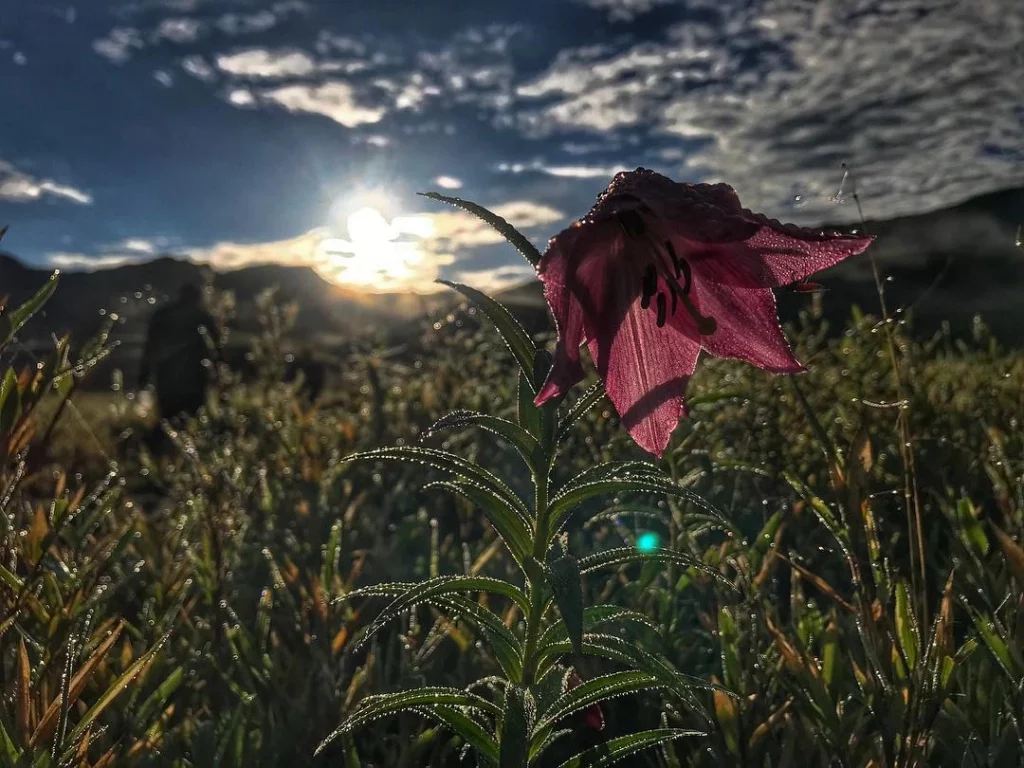
In the misty and sloppy arms of monsoons, the endemic Dzukou Lily(Lilium Chitrangadae) makes its unparalleled appearance. Lilies, Aconitum, Euphorbia and multi-colored Rhododendrons spread across the valley displaying its beauty.
The Flowering Season is the best time to visit Dzukou Valley if one wishes to witness the valley sprinkled with colourful wildflowers blooming and lightening up the masterpiece of nature’s handiwork.
Although Monsoon serves as the best time to visit Dzukou Valley, be aware of the trails as it becomes muddier and slippier, and the leeches will be out in full force. So, bags of salt or spray bottles filled with brine must be carried.
Sometimes visitors get stranded in the valley or washed away in flash floods when returning from the valley during the monsoon season too.
Winter Season(October – March)
The winter season is not the best time to visit Dzukou Valley as one doesn’t get a chance to witness the blooming of wildflowers. The temperature also drops far lower than one would expect in such tropical states.
In winter, the valley loses its emerald green hue and becomes more straw-coloured as the green-pigment chlorophyll breaks down in the leaves of the dwarf bamboo plants.
Delicate ice crystals form on foliage and the meandering rivulets at the bottom of the valley freezes during the night. One can witness it in the early morning before they begin to slowly thaw again during sunrise.
During the winter, though a pinch of warmth can be felt in the direct sunshine during the daytime, there remains an undeniable chill in the air.
Air temperatures during the winter days often hover around 10 °C. At night, air temperatures commonly plummet to several degrees below freezing and each morning one would wake up to see a heavy frost capturing the entire valley.
The catch is that if one wishes to witness such frost wraps, winter season is the best time to visit Dzukou Valley.
We assure you that the Dzukou Valley trek’s best time is at any time of year. If you can’t make it during flowering time, it’s a beautiful place to hike around as it has much more to offer than its colourful flora and fauna.
Dzukou Valley is well – known only by the local tourists from Nagaland and Manipur. This place is usually less crowded than the other scenic spots in the Seven Sister States and is still undiscovered by many global travellers.

How to reach Dzukou Valley?
The Dzukou Valley lies between 25°31’0” N and 25°35’0”N latitude and 94°3’0″E to 94°5’0″E longitude, spanning along Nagaland’s Kohima district and majority on the Manipur side.
Since Dzukou Valley is tucked between Nagaland and Manipur, it can be attempted from either ways.
But the Manipur trail is not marked, since there are no amenities and the trail is much more strenuous.
Hence, the trek to Dzukou Valley is mainly focused from Nagaland. Getting to Dzukou Valley is a relatively straightforward affair from Kohima, the capital of Nagaland.
From Kohima, the valley can be approached from two villages –
- Zakhama(about 20 km from Kohima) and
- Viswema(about 25 km from Kohima)
But as regards, if you’re trekking independently without preparations, one may get lost or take a wrong turn on the way.
The Southern trail starting from Viswema Village is the easiest and maximum attempted route. If one intends to visit Dzukou Valley via Zakhama Village, be prepared for a steep climb of around 2 – 3 hours and 1 – 2 hours of flat land walk. The Zakhama trail is not advisable during monsoons.
The Viswema Trail
The trek from Viswema to Dzukou Valley is the easier of the two routes, with only 1 hour of steep climbing.
The Viswema trail starts with about 8 km of motorable road from the Viswema village to the Trekker’s Point. Then the road slopes up gently, beyond which the actual trekking starts and it takes around 3 hours to reach Dzukou Valley.
One can hire a taxi from the main highway to the end of the motorable road. The same taxi will also come and pick you up after you climb down. But the both side fare is around Rs 5000/-.
The Zakhama Trail
The Zakhama trail is comparatively more demanding as it is a direct route to the Dzukou valley than the Viswema trail and takes less time. But one requires
The Zakhama trail is a steep and difficult path lined with rough – hewn stone steps, which are much easier to walk down than the muddy trek of the Viswema trail. It takes about 3 hours of unremitting, steep uphill trekking to reach the valley.
Accomodations in the Dzukou Valley
Accommodation is not a problem in the Dzukou Valley as there is a guest house located at the top of the valley.
There are three main options regarding where to stay in the Dzukou valley –
- Staying at the Guest House :
The basic rest house overlooking the valley provides two options – dormitory and private, depending on your budget and interests.
The private rooms with very basic amenities cost you an exorbitant price of Rs 1500/- and extra price for meals. 50 rupees for the dormitory and another 50 rupees for a tent if you like camping out in the open instead. Mattresses, blankets, and pillows are extra.
From the guest house in the valley, one can witness the panoramic view of the sunrise brightening up the valley.
- Camping in Tents :
The valley is a popular camping spot for local tourists and many trekkers.
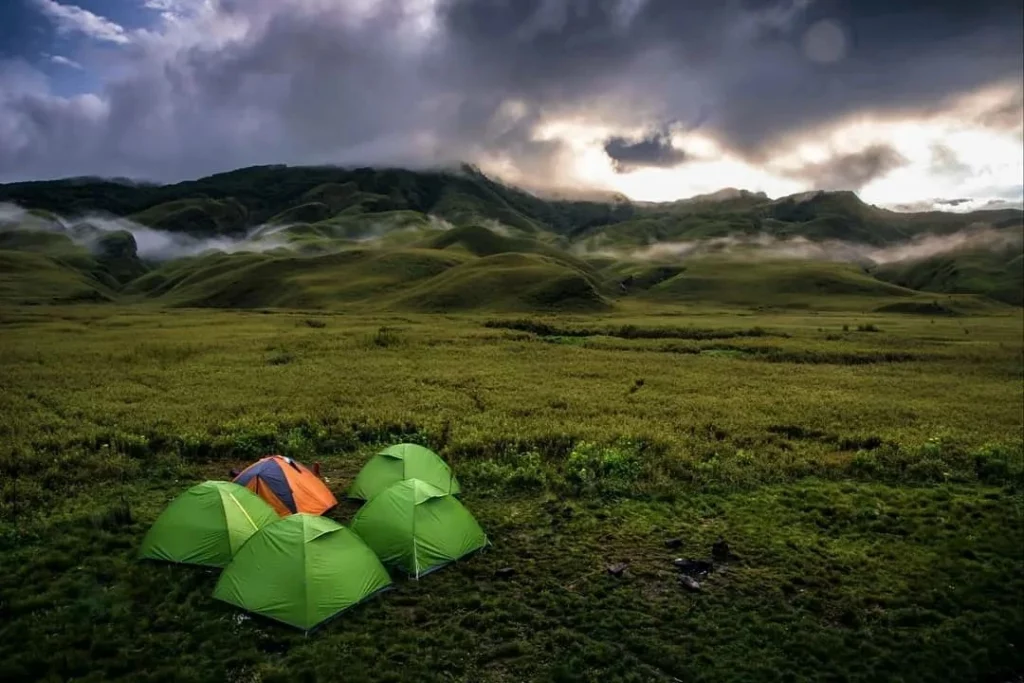
If you have the proper gear, Dzukou Valley is a great place to camp. There are several natural campsites in the valley and the main site lies in the middle of the valley.
- Sleeping under a Cave :
The large rock outcrop at the bottom of the valley has a sizable overhang to provide shelter from the rain.
One can spend the night here to experience vagabondism and complete wanderlust. But one needs to carry everything right from food, sleeping amenities, light, firewood etc to stay inside the caves.
Most trekkers like to spend their night here to experience the real feel of the valley.
Ecosystem of the Dzukou Valley :
Many people speculated about the origin of Dzukou valley stating that it was formed as a result of a meteorite impact or that it is a caldera resulting from a violent volcanic eruption long ago.
Some estimate the age of the geosynclinal valley between 2 to 4 million years old.
Different types of rocks and minerals comprise the rock profile of the valley that includes sandstones, clays, shale siltstone, petrified wood and lignite seams.
The ecosystem of the Dzukou Valley favors the growth of a riot of wildflowers and blossoming rhododendrons during the blooming period(April – September). The rare Shirui Lily(Lilium mackliniae) and most notably, the endemic Dzukou Lily(Lilium chitrangadae) can be seen during this period – the best time to visit Dzukou Valley.
The endemic flower, Dzukou Lily, is a distant cousin of the lighter pinkish shade Shirui Lily(Lilium mackliniae), a rare species of the Shirui Hills of Manipur, which can be seen during the best time to visit Dzukou Valley.
Apart from the rare and endemic variety of lily, one can witness many other flowers like Euphorbia sikkimensis, Ranunculus species, Aconitum species etc. adorning the valley in vivid beauty – Dzukou Valley Nagaland best time to visit.
The fauna of the valley has no detailed studies or surveys. The Asiatic black bears(Ursus thibetanus), leopards(Panthera pardus) and Indian elephants(Elephas maximus indicus)have been reported in the Dzukou Valley.
One of the biggest threats to the Dzukou Valley ecosystem are the wildfires that rapidly spread through the dwarf bamboo cover. Fires are particularly liable to occur during the winter season and are normally started by people(intentionally or unintentionally).
Exploring Dzukou Valley – Feast your eyes :
The immaculate valley of treeless gentle mounds is covered with dwarf grasses and dotted with burnt trees, which stands as a reminder of the devastating wildfires. The candy clouds that float below the valley at the break of dawn, slowly make way for the rays of sun, casting a golden hue on the valley.
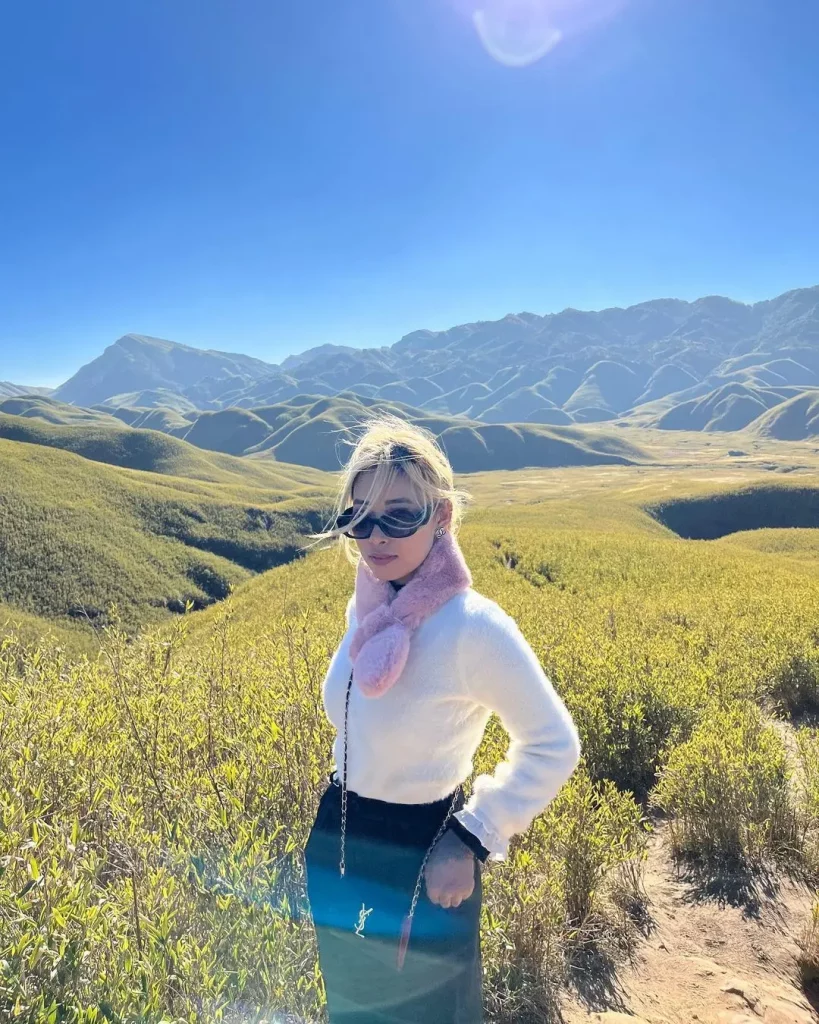
On a perfect sunny day, the pristine valley shines in different shades of green overlooked by the clear blue skies. The winding rivulet flowing through the valley with crystal clear water, perennial waterfalls tucked in the forbidden corners, deep cut ravines and caves seems to be perfectly sculpted by nature.
- A trek to the bottom of the valley :
As you trek down from the guest house located on the top of the valley, one can witness the spectacular
valley sprinkled in flowers.
- Take a dip in the crystal clear water of the rivulet :
The crystal clear rivulet gently flows through the rocks and crevasses tucked in the valley shaping into natural pools. It meanders through the valley and becomes shallow towards the centre.
As they run across the valley, the stream changes its forms – starting from rivulet to waterfall to water pools. Take a dip in this water bath and refresh your journey in the valley.
- Cherish the colourful riot of flowers :
Almost everyone wishes to witness the valley in full bloom. So, while you plan your trip make sure you visit between the months of May – August, June being the best time to visit Dzukou Valley.
Dzukou Valley stands vivid with flowers blooming in white and yellow, occasionally dotted with blue flowers. The endemic Dzukou Lily makes its appearance across the valley in sparse locations painting the green canvas with a sprinkle of pink.
Due to such gorgeous blooms of flowers, the Dzukou Valley is named as “Valley of Flowers in Northeast”.
- Rejoice the views from the rest house :
The first thing that you will notice when you get to the rest house is the perfect view of the Dzukou valley from the property. One could easily spend a few hours soaking up the sun, enjoying the panorama view.
For the best chance of witnessing a perfect sunset one should visit outside the monsoon season – the best time to visit Dzukou Valley, as there’s a better chance of cloudless skies during these times.
- A visit to the Ghost Cave :
In the Dzukou valley, a cave known as the “Ghost Cave” or “Bhoot Gufa” has been reported and it is only a 15-minute walk from the rest house.
The cave extends for around 1 km and so one needs to bring a good headlamp or flashlight if you want to explore it.
Convinced to visit the picture-perfect Dzukou Valley ?
The Dzukou Valley in Nagaland is truly a land beyond imagination, a piece of heaven all year round. It is a perfect travel destination for adventure lovers and a perfect way to end your tour of North-East India.
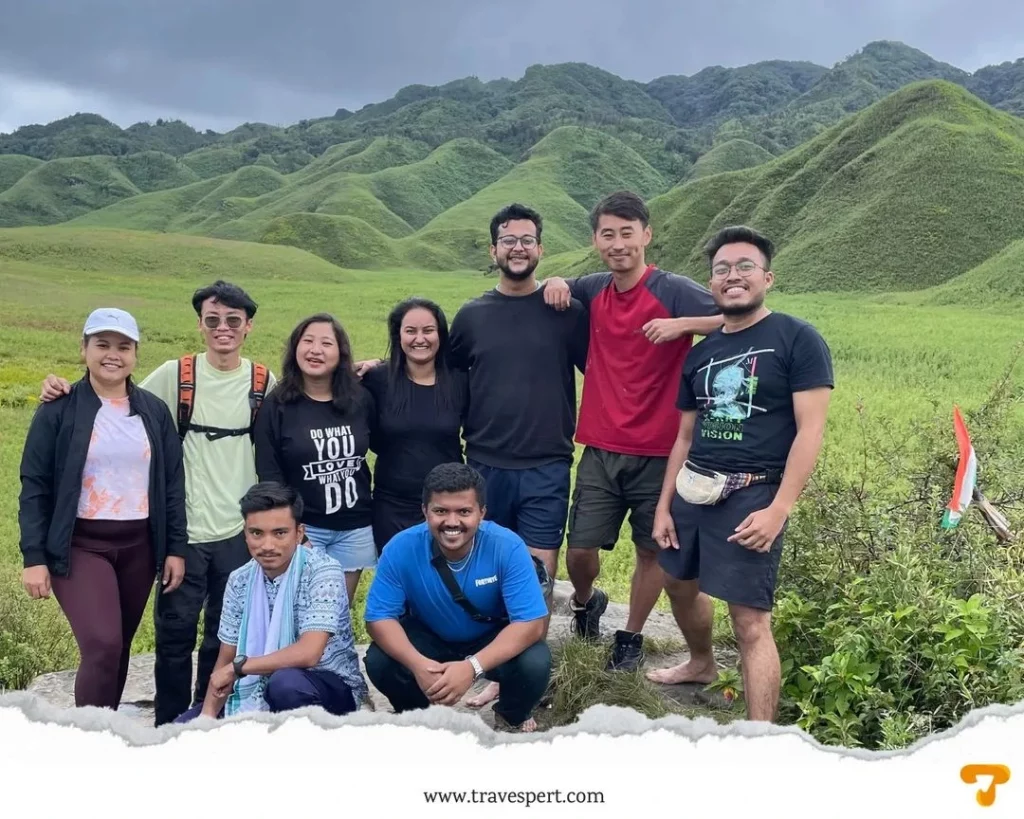
The unbridled whim of lush green forests, gurgling streams of waterfalls and unmatched varieties of flora and fauna are the little tokens while trekking up to the enchanting valley. Dzukou Valley is a visual treat to your soul and is a must visit location in everyone’s bucket list.
Dzukou Valley is most famous for its multicolored carpets of flowers, most notably the Dzukou lily that bloom during the summer – the best time to visit Dzukou Valley.
As the dawn sways by, the silent murmurs of gentle breeze wraps you in its invisible armor, the sky slowly turns into cobalt blue pushing away the clouds and the sun illuminated the valley in spectacular hues of green and golden.
The Dzukou Valley in Nagaland is one of the most memorable attractions in North East India as it holds an outstanding offbeat destination for adventure seekers. You are virtually guaranteed to find peace and solitude in this blissful serene, even if you don’t visit the valley at the best time to visit Dzukou Valley.
The valley is still relatively unspoilt and untouched. It is worth visiting but we encourage you not to schedule your visit for too long, as dramatic changes may be afoot.
If the valley becomes accessible and known to a larger segment of the global tourist, it is likely that the Dzukou valley experience will be greatly diluted.
Leave a Comment Cancel reply
Save my name, email, and website in this browser for the next time I comment.
Hidden Terrains of Dzukou Valley in Nagaland

Located between the North Eastern States of Nagaland and Manipur, the enchanted valley will leave you mesmerised with its unconditional and prolific natural bliss. Trekking amidst the gargantuan rainforests in Zakhama located 20kms from Kohima, the North Eastern Valley of Flowers is a treat to wandering soul and appetite to hungry travellers. Such was the surreal beauty of the place, I could not resists surrendering my senses to the perfectly mowed valleys, the grass that guides you through the path, the flowers that satiate your nerves and cloud that caresses you like a lover.
It is indeed one of the most idyllic natural evolution and months after I am still sitting with a major hangover remembering the essence of morning zephyr, feeling the touch of tickle of cold water stream flowing through the valley and submitting to the panoramic view of burnt wood on the valley.
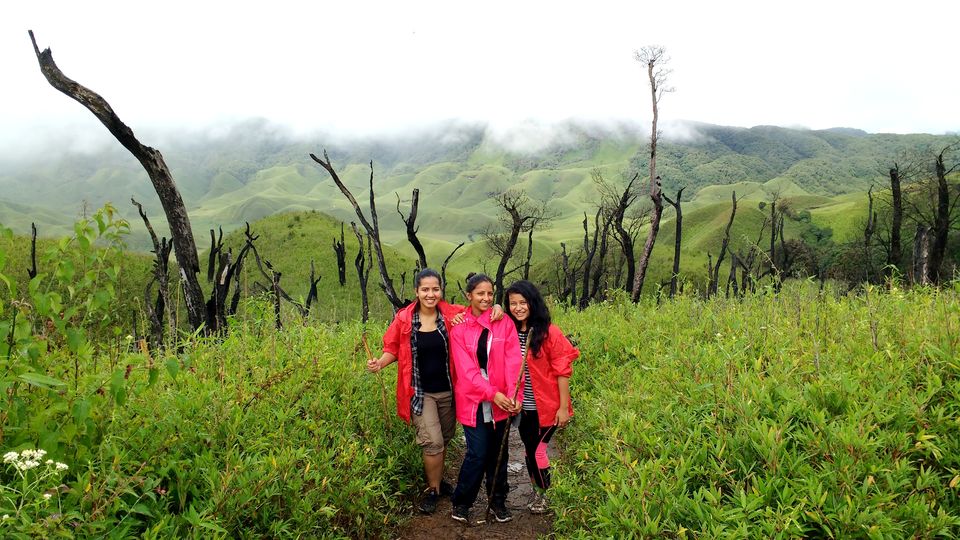
How to reach Dzukou valley
Reaching Dzukou Valley is not a mammoth task if you love trailing the jungles, love being kissed by the wind, enjoy hillside road trips and don’t mind trekking for a while. The quintessential glimpse of the valley is worth all the trek and you get to taste the rainforests at its best with perks of cascading little waterfalls and crystal clear streams in between. The nearest railway station is Dimapur which is well connected to North-eastern commercial Hub Guwahati. Inter-city cabs are easily available from Dimapur Railway Station that drives you straight to Nagaland Capital Kohima at a price of Rs 220 to 250 per person.
After you reach Kohima, the craved destination is located few kilometres away from Kohima. There are two routes from which trekking to Dzukou Valley Starts.
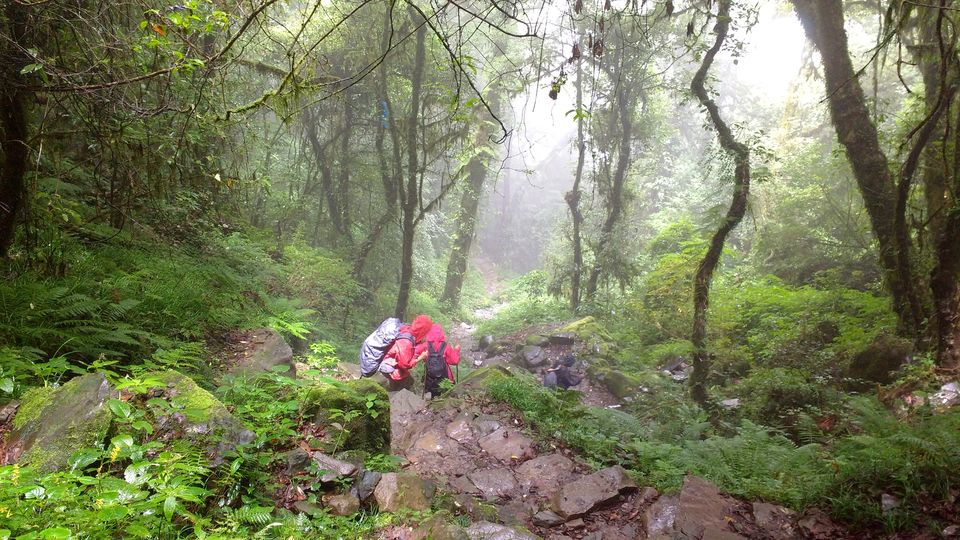
Zakhama Village – This is one of the routes that you can take to reach Dzukou Valley. Take a shared cab from BOC counter in Kohima to Zakhama Village and ask the driver to drop you on the road to Dzukou (Located 3 kms from Zakhama Military Camp). It is shorter short but with forced ascend and steep climb for near about 5 to 6 hours. I took this road and trust me there wasn’t 1% of regret but if you are not the trekker type, take the other road.
Visvema Village – This is located 28kms from Kohima and the route taking you to Dzukou valley is longer but easy. It has steep and ascending climb for only an hour or so and the trail is pretty much straight between flowers and tall grasses. Take this route only if you are not comfortable trekking as it is longer and takes more time but easy.
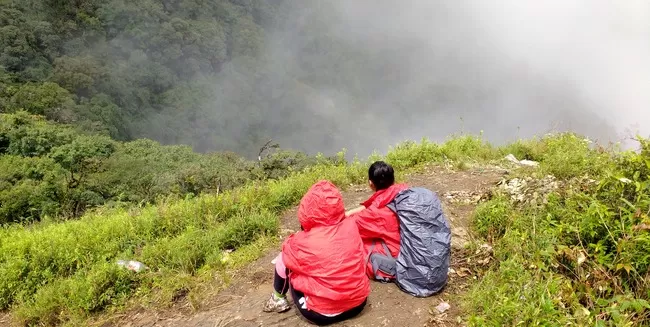
Accommodation
Accommodations is pretty much sorted in Dzukou Valley and trust me you are in there for some real adventure and true travelling, so be ready to stay in dormitories with 30 or 40 more people. After climbing for 6 hours via the Zakhama Road, I reached the top and from there was an easy descent and straight trail cut between the grasses and seeing the guest house from far after 7 hours trek was absolute delight. There are VIP rooms which mean you get beds but usually it is booked but you will definitely get a place to crash with two large dormitories. The Guest House management provides foam mattress, blanket, and utensils on rent and also serves dinner but you do have the option to cook food by purchasing firewood but the raw materials needs to be carried by you.
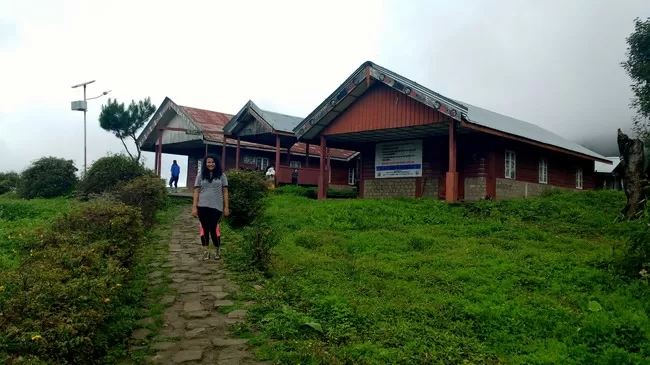
For complete adventure and nature experience, you can climb down from the GUEST HOUSE towards the valley and stay inside the natural caves . But make sure you carry sleeping bags and enough warm clothes to shield against the cold nights.
Why Dzukou Valley?
Dzukou Valley is a place unadulterated by the modern architect of technology and is definitely going to take you back in time where nature left us awe inspired in every step. The place is in itself screams out whimsical satisfaction and the idyllic view is something one cannot get over with. If you are in this magical place, don’t miss the sunrise because it is profoundly beautiful.
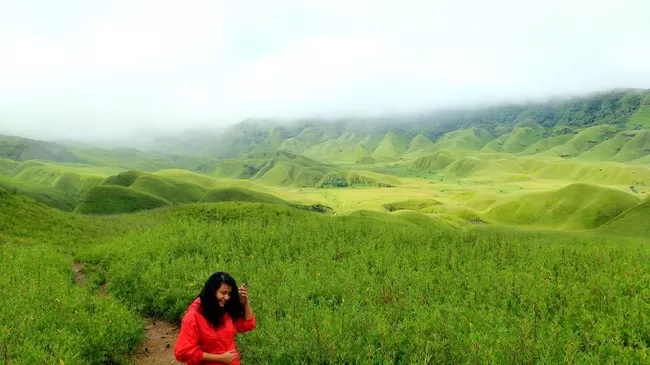
Wake up early at around 5am, grab your cup of tea and stare at the prolific valleys waiting to embrace you in its arms. The clouds dance and flirt with the valley every second something hiding it and sometimes leaving it alone. The essence of black burnt wood around the place, the trails made between towering grasses and ice cold stream flowing amidst valley with crystal clear water is a charm to be tricked with. After grabbing some tits bits for breakfast, walk down the grass laid natural alleys to explore the complete valley.
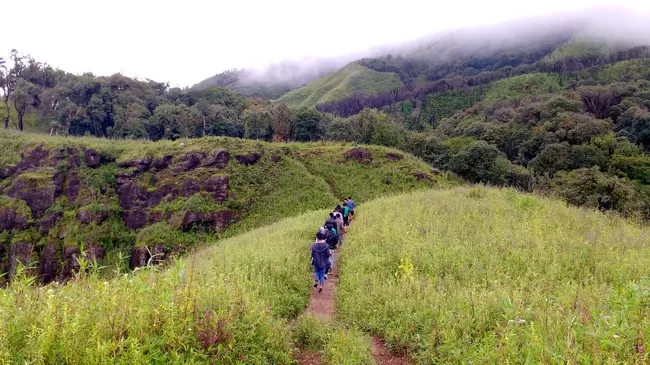
The valley can be explored by ascending down from the guest house area as it is located on top of hillock. The view of the complete valley is breathtaking and I could not resist myself from drooling and falling for it over again and again. The trail from guest house and valley with ice cold stream flowing and natural caves is pretty straight and you will not find any difficult as it is single path. The magical of the place still triggers me to get up and walk the hill, explore the rainforests and indulge in a relationship with the valley.
Make sure you plan the Dzukou Valley trip for 3 days if you want to explore the place properly. This will give you chance to explore both start points – Zakhama and Visvema. Climb towards Dzukou Valley using any of the routes on Day 1 and relax the surreal surrounding from Guest House. Keep Day 2 for exploring the place and climb down from the valley on Day3.
If you are not a Nagaland resident or aren’t working there, make sure you grab INNER LINE PERMIT for entry into Naga Hills. It can be obtained from DC court in Dimapur or from Nagaland Houses.
Have a cab booked to pick you up from the trek start point while climbing down as the frequency of cabs to Kohima reduces. The frequency of cabs from Kohima to Dimapur reduces on Sunday, so plan accordingly.
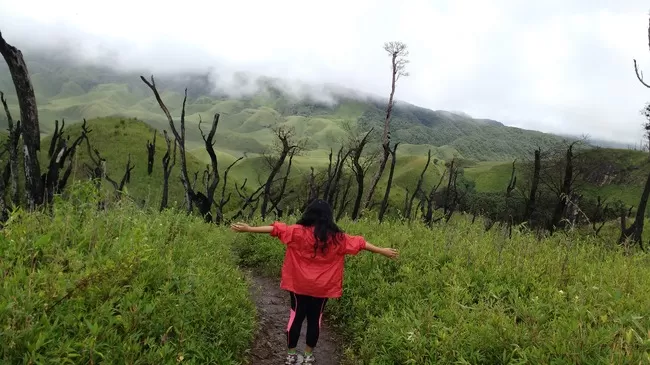
Frequent searches leading to this page:-
dzukou valley nagaland, dzukou valley trek, how to reach dzukou valley, kohima to dzukou valley distance, dzukou valley trip
Search Destination

Dzukou Valley Tour Packages
Located at an altitude of 2450mts above sea level , Dzukou Valley also known as the Valley of Flowers is one of the prominent tourist attractions in Nagaland. Very close to Kohima just 30kms far away, Dzukou receives a large number of tourists from all over the world. For adventure seekers, this valley is a wonderful option for trekking. The valley is located just behind the Japfurange, so there are many trekking points for adventure thrillers.
From the Viswema village to Dzukouit takes nearly 5 to 6 hours for trekking. While trekking to the valley, you can capture the best sights of nature and the surroundings of the valley. If you want to trek more, you can also trek to the Japfu range for more fun and adventure.
In Kohima, many shops offer various souvenirs, textiles, handicrafts, and many things to shop for your loved ones.
Also never forget to taste local cuisines like steam bamboo fish, dried pork, etc. Simply, Dzukou valley is a lovely and adventurous place to explore in Nagaland.
The best time to visit is between June and September because that is the blooming season. So you can catch the wonderful views of the valley full of flowers.
Nagaland Tours & Itineraries
Here is a collection of tour itineraries for your next Nagaland trip.
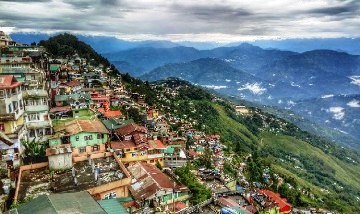
7 Days - Darjeeling and Gangtok Tour Package
- 9 Nights / 10 Days
Darjeeling - Mirik - Gangtok
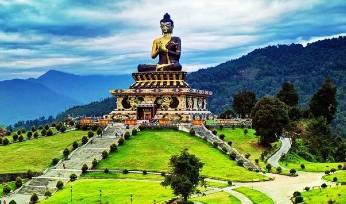
7 Days - North East Tour Itinerary
Bagdogra - Kalimpong - Gangtok - Darjeeling
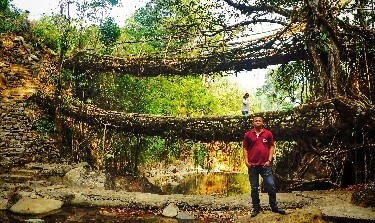
4 Days - Meghalaya Tour
Guwahati - Shillong - Cherrapunjee - Shillong - Guwahati
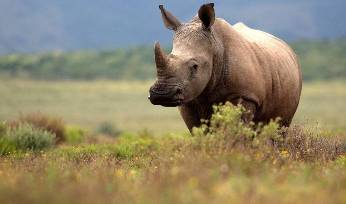
6 Days - North East Tour Itinerary
Dibrugarh - Sivasagar - Jorhat – Majuli - Kaziranga - Guwahati
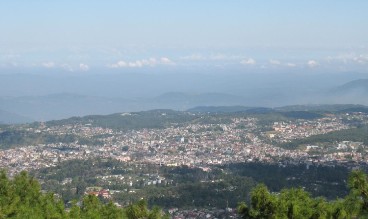
4 Days - North East Tour
Guwahati - Shillong - Cherrapunji – Shillong - Guwahati
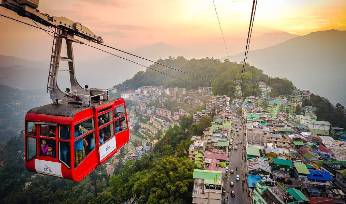
4 Days - Gangtok Tour Itinerary
Bagdogra - Gangtok - Tsomgo Lake – Gangtok – Bagdogra
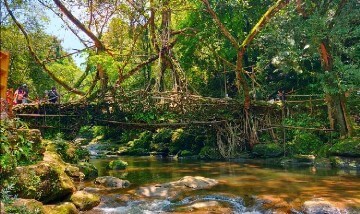
5 Days - Guwahati Shillong Tour
Guwahati - Shillong - Cherrapunjee - Mawlynong - Shillong - Guwahati
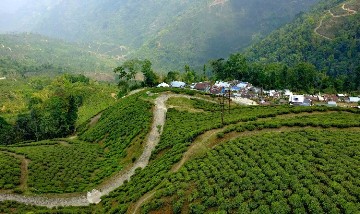
5 Days - Darjeeling Tour Itinerary
Bagdogra – Kalimpong - Darjeeling - Bagdogra
Nagaland Packages By Destinations
Here, you can check out other most popular Nagaland Destinations
- Dzukou Valley
- Khonoma Green Village
Other North East Destinations
Here, you can check out other most popular North East tour packages by destination.
- Arunachal Pradesh
- We assure the privacy of your contact data.
- This data will only be used by our team to contact you and no other purposes.

IMAGES
VIDEO
COMMENTS
The Dzukou valley is Nagaland's most famous and spellbinding trekking destination. This is a comprehensive guide covering every aspect of visiting the Dzukou valley. Click through to learn the ecology of the valley, the best time to visit to see wildflowers, how to trek to the valley, where to stay once you arrive, what camping gear you need to bring, how to find firewood, things to do in the ...
Standing at ~8000 ft (2438 mts), Dzukou valley is situated beside the Japfu peak on the border between Nagaland and Manipur. However, being close to Kohima, the state capital of Nagaland, more tourists trek the valley from Nagaland side rather than Manipur side. Dzukou Valley is an absolute delight, a treat to the eyes and soul.
The rare Dzukou Lily in full bloom Ecosystem of Dzukou Valley . The ecosystem of the Dzukou Valley favors the growth of the rare Dzukou Lily (Lilium Chitrangadae) from April to August.The endemic flower is a distant cousin of the lighter pinkish shade Shirui Lily (Lilium Mackliniae), a rare species of the Shirui Hills of Manipur.The Dzukou Lily was first identified in 1991 by Late Dr. Hijam ...
Dzukou valley, is an easy level trek near Kisama and Kohima, the venue for annual Hornbill Festival of Nagaland. Dzukou valley is known for the unusual shapes of its verdant hills, surreal sunsets and the rare Dzukou valley lily. Located near Kohima and Kisama, people can trek to Dzukou valley from both Nagaland and the neighbouring North East ...
Cost of visiting Dzukou Valley. Entrance to the valley costs 20 Rs per person for people from surrounding villages, 50 Rs per person for other Indians, and 100 Rs per person for foreigners. Entrance fees are paid at the rest house, and you only need to pay once, not per day. Price list for the Dzukou Valley rest house.
Dzükou Valley Trek via Viswema. From Viswema, one can walk 8 kilometers (5 miles) along drivable road or hire a taxi outside the village gate for about 1000-1500 INR (~$14-$20 USD). While walking can save you money, it also expends quite a lot of energy and adds about 2-3 hours to your hiking time.
7 Day Travel Itinerary for Dzukou Valley Trek. Day 1 - Arrive in Guwahati. Day 2 - Fly/train it to Dimapur; Transfer from Dimapur to Kohima. Day 3 - Explore Kohima. Day 4 - Start your trek to Dzukou Valley; spend the day at Dzukou Valley. Day 5 - Descend down and stay at Zakhama/Viswema.
So, here is a list of prices of various items atop Dzukou Valley. Entry Fee: INR 100 per head. Camera Fee: INR 200. Stay Fee at the Dormitory: INR 50 (Do note that at 50 you are just allowed to stay, blankets etc cost extra) Stay Fee at Individual Room: INR 1500 (Yes, I haven't added an extra 0 by mistake!)
TOURS. The best way to experience Dzukou Valley is to let a professional adventure travel company like India Trail organise everything for you, including tents, guide, porters, permits, and all meals. (INR5,540 for three nights and four days per head for a couple, and INR10,867 per head for a four-person group). DISCOVER.
The Dzukou valley trek is a unique opportunity to explore the untouched valleys of Nagaland along with getting immersed in their culture. With spectacular green valley views, this trek is the best for any beginner looking to enter the world of trekking. ... The nearby cities of Dimapur and Kohima are the popular attractions from Khonoman. The ...
Situated on the border of Manipur and Nagaland, Dzukou Valley is one of the best tourist attractions in Northeast India. Set at the staggering height of 2452 meters above sea level Dzukou valley is famous for its picturesque landscape, rolling hills and multicolored blooming flowers especially the Dzukou lily which is found only in this valley.
Location: Dzukou Valley is situated at the border of the Indian states of Nagaland and Manipur, about 30 kilometers south of the state capital, Kohima. It lies at an altitude of around 2,438 meters above sea level. Duration: The trek typically takes around 2-3 days to complete, depending on the pace of the trekker and the chosen route.
Dzukou Valley. Just behind the Japfu Peak is the serene and scenic Dzuko Valley or the valley of flowers. Offering one of the most spectacular landscapes in the country, the valley is more popular with trekkers for its interesting and challenging trekking circuits. It prides itself for being one of the most-visited tourist sites in not only ...
The entry fee for Dzukou Valley is 50 rupees, but there is no ticket counter to levy the entry fee. The caretaker at the guest house charges this fee with other charges related to the food and the accommodation. Accommodation in Dzukou Valley. During the tourist season, guest house facility is available in the valley for the night stay.
3. Utilize the golden hours: The soft golden light during sunrise and sunset creates a magical atmosphere in Dzükou Valley. Make sure to wake up early and stay out late to capture the beautiful play of light and shadows on the landscape. The golden hours provide a warm and stunning ambiance to your photographs. 4.
The Dzukou Valley in Nagaland and Manipur is a beautiful and tranquil place that is popular among tourists. The valley is located at an altitude of 2452m above sea level and is surrounded by dense ...
Kohima. Also known as the Valley of Flowers, the Dzukou Valley is one of the most visited tourist attractions in the North East. Located at an altitude of 2450 meters, it is considered to be one of the most famous adventure spots in Kohima, Nagaland. It is located behind the Japfu range, another important travel destination for tourists in the ...
Apart from all the Dzukou Valley sightseeing, you can also include these activities to do on your Dzukou Valley tour. Trek through the steep terrain of the valley region. The trek to Dzukou Valley itself is a 17KM long walk and takes around 5-6 hours from Viswema village. From Zakhama village, it is about a 15KM trek and takes 3-4 hours.
This Dzukou Valley Nagaland Trek trail, adorned with rhododendron forests and gentle streams, offers a mesmerizing journey. As you reach the summit, be rewarded with panoramic vistas of rolling hills, lush greenery, and a sea of vibrant wildflowers. Camping amidst Nature. Experience the joy of camping amidst nature's embrace in Dzukou Valley.
The Dzukou Valley in Nagaland is one of the most memorable attractions in North East India as it holds an outstanding offbeat destination for adventure seekers. You are virtually guaranteed to find peace and solitude in this blissful serene, even if you don't visit the valley at the best time to visit Dzukou Valley.
Make sure you plan the Dzukou Valley trip for 3 days if you want to explore the place properly. This will give you chance to explore both start points - Zakhama and Visvema. Climb towards Dzukou Valley using any of the routes on Day 1 and relax the surreal surrounding from Guest House. Keep Day 2 for exploring the place and climb down from ...
Dzukou Valley Tour Packages. Located at an altitude of 2450mts above sea level, Dzukou Valley also known as the Valley of Flowers is one of the prominent tourist attractions in Nagaland. Very close to Kohima just 30kms far away, Dzukou receives a large number of tourists from all over the world. For adventure seekers, this valley is a wonderful ...
Etymology. The term "Dzukou" is originated from a word common to both Angami and Mao languages, which can be translated as "cold water", with reference to the cold stream flowing throughout the valley area.. Ecology. The valley borders a region of old-growth forest, and is home to several rare and endangered species of flora and fauna, including the Dzükou Lily [page needed] and the Blyth's ...